

Lake Kawaguchiko
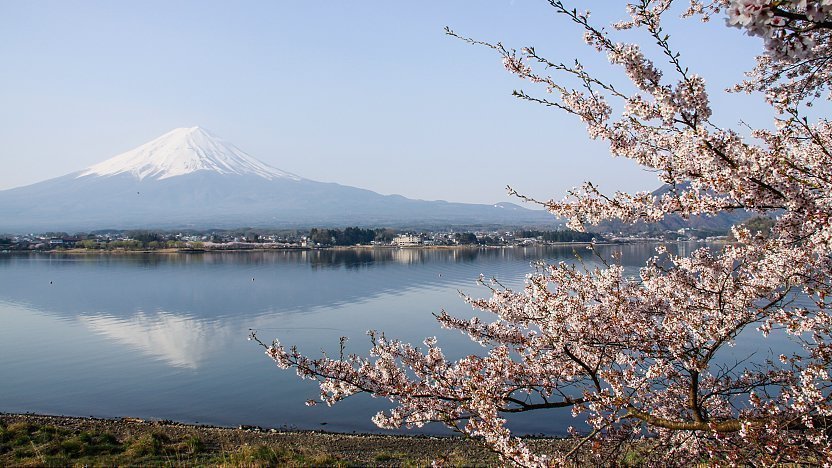
Lake Kawaguchiko (�͌���) is the most easily accessible of the Fuji Five Lakes with train and direct bus connections to Tokyo . A hot spring resort town with various tourist attractions and views of Mount Fuji is located around the lake's eastern end, while the northern and western shores are mostly undeveloped.
The best views of Mount Fuji can be enjoyed from the lake's northern shores and are particularly breathtaking during the cherry blossom season around mid April and the autumn colors around the first half of November. One of the nicest spots for cherry blossoms is the seaside promenade near the Kawaguchiko Music Forest , while photographers will enjoy the "Momiji Tunnel" for autumn colors, a maple tree-covered road section further west.
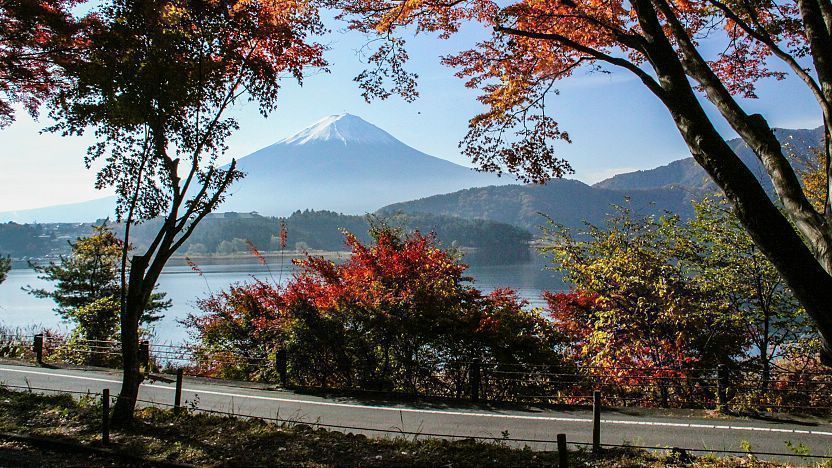
Be warned that even though Kawaguchiko is located right at the base of Mount Fuji , the mountain is not always visible because of clouds. Visibility tends to be best in the early mornings (usually before 9am) and in the late afternoons, while clouds often obstruct the view during daytime even on days with fair weather, and especially during the hazy summer.
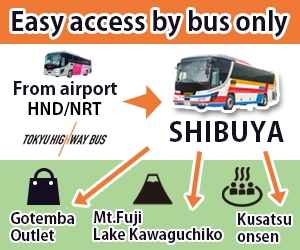
Among the wide range of tourist attractions available around Lake Kawaguchiko are hot spring baths , museums , the Fuji Q amusement park , boat tours and a ropeway leading up a small mountain. Kawaguchiko is also a good base for climbing Mount Fuji , although most people start their ascent from Fuji Subaru Line 5th Station halfway up the mountain these days.
Below is a list of some of the tourist attractions around Lake Kawaguchiko:
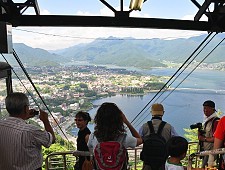
Mount Fuji Panoramic Ropeway

Kubota Itchiku Museum
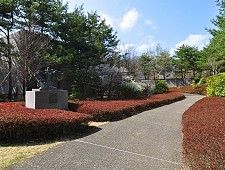
Kawaguchiko Museum of Art
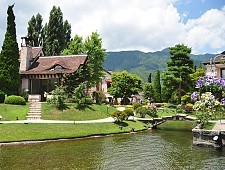
Kawaguchiko Music Forest
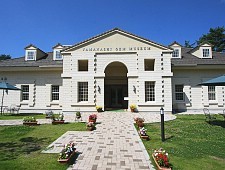
Yamanashi Gem Museum
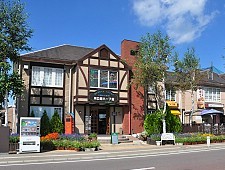
Hot spring baths
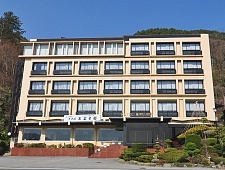
Hotel Mifujien
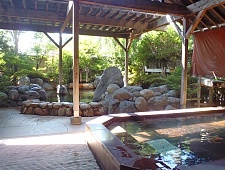
Kaiun no Yu
Getting there and around.
Kawaguchiko Station is the terminal station of the Fujikyu Railway from Otsuki. The bus terminal for local buses and highway buses to/from Tokyo , Kofu , Gotemba and other destinations is located just in front of the station.
From Kawaguchiko Station, the Omni Bus lines provide tourists with local transportation around Lake Kawaguchiko and neighboring Lake Saiko : the Red Line (or Kawaguchiko Line) operates along Lake Kawaguchi's eastern and northern shores, while the Green Line (or Saiko Line) operates along Lake Kawaguchiko's southern shore before continuing to Lake Saiko .
How to get to and around the Fuji Five Lakes
Questions? Ask in our forum .
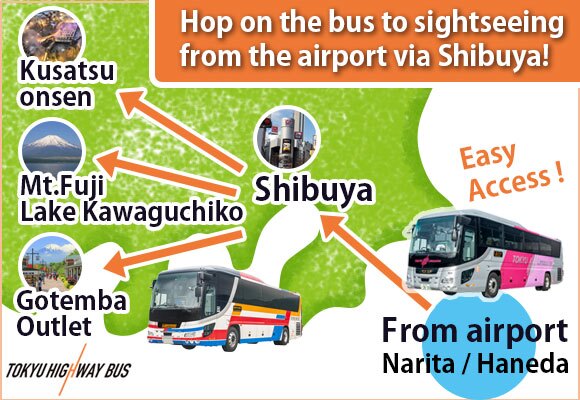
Links and Resources
Kawaguchiko herb hall, hotels around fuji five lakes.
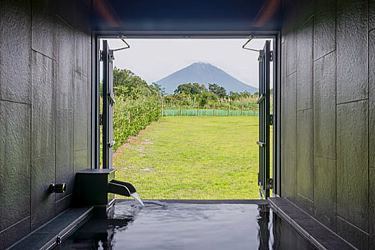
Experiences around Fuji Five Lakes
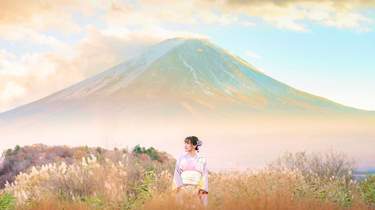

Kawaguchiko: Full Guide, Sample Itineraries & Things to Do
Our family frequents the surrounding areas of Mt. Fuji, especially Kawaguchiko — our favorite day trip with our daughter. I just can’t get over how lucky the locals in this area are… snow-capped Fuji-san, beautiful breathtaking views, great food ( houtou noodles is our absolute favorite!), and the people are always nice.
In fact, they’re so nice, I’ve actually lost count of how often the locals have given our daughter gifts just because they find her adorable. All of these things combine to make an ideal location, and one we hope to call home someday in the future. Because of how often we visit the areas around Mt. Fuji, we keep this as sort of a living article, which we update as we find something new and interesting in the area.
Understanding Mt. Fuji and Fuji Five Lakes
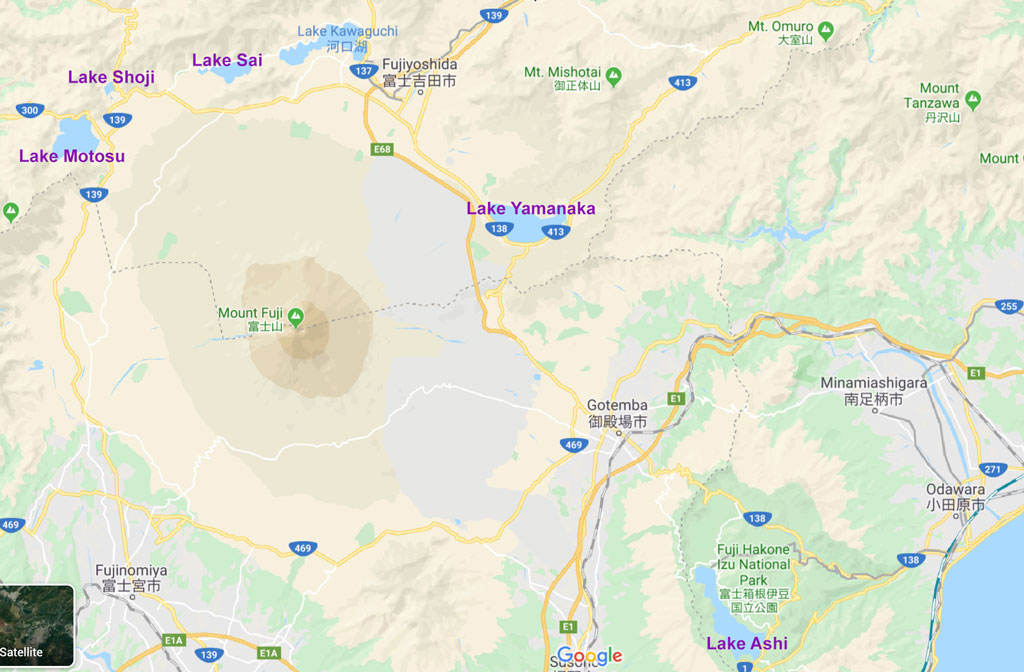
The main sightseeing attractions and in this itinerary guide are in the town of Fujikawaguchiko –the nearest town to Mt. Fuji that is easy to access on a day trip. The TOP tourist attraction here is Kawaguchiko or Lake Kawaguchi, the second-largest lake of the Fuji Five Lakes (or Fujigoko as the Japanese call it).
Fuji Five Lakes (Fujigoko)
The lakes of the Fuji Five Lakes are as follows:
- Lake Kawaguchi (Kawaguchiko)
- Lake Sai (Saiko)
- Lake Shoji (Shojiko)
- Lake Motosu (read our Lake Motosu camping guide ) Lake Yamanaka (read our Lake Yamanaka itinerary and things to do)
‘ko’ means lake in Japanese.
Lake Motosu and Lake Yamanaka, however, are not part of Fujikawaguchiko town. The Fuji Five Lakes were formed when Mt. Fuji erupted during the ancient times. From the (literal) ashes of such an awesome destructive force, these lakes have all become fantastic tourist attractions, an inspiration for artists , poets, and philosophers alike, and some top-notch fishing spots.
Kawaguchiko and Saiko
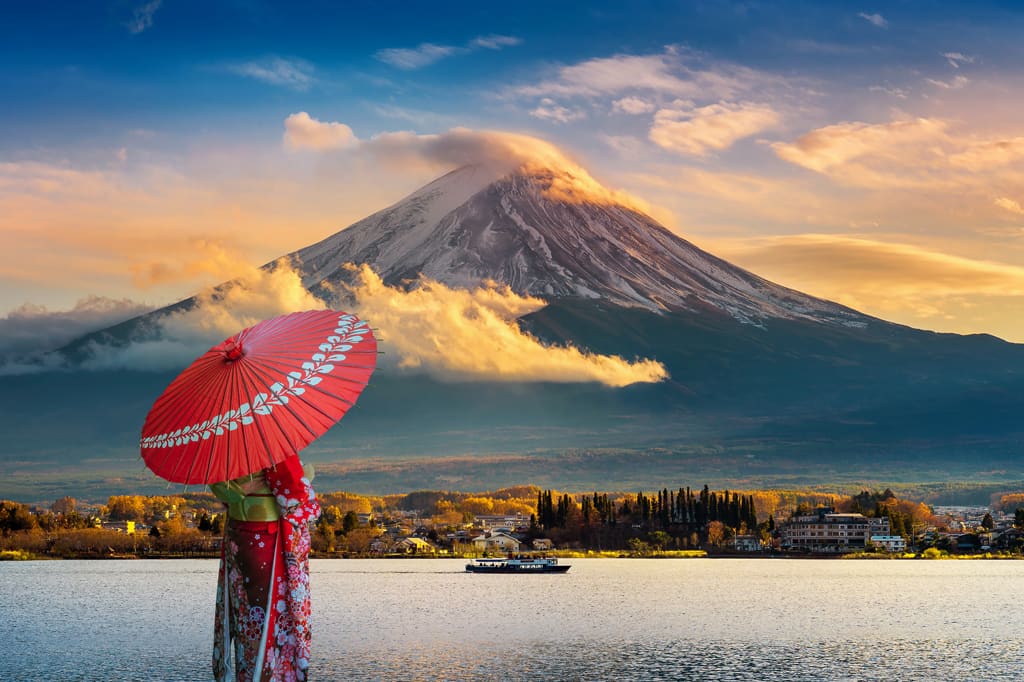
Of these lakes — Kawaguchi and Sai — are the most easily accessible by bus due to the bus frequency from Kawaguchiko Station.
Of the two lakes, Kawaguchiko is the most popular due to the area being better developed, as well as offering many experiences for tourists. Motosuko, Shojiko, and Yamanakako can also be accessed, but buses only run to each lake once every 1-3 hours!
Of course, there are more attractions and things to do around the area such as camping in Lake Motosu , fishing in Lake Shoji, kayaking, visiting the Shiraito Falls, Oshino Hakkai, the peaceful Kitaguchi-Hongu Fuji Sengen Shrine, and others.
But those merit separate posts as they are complicated to access. So in this guide, we will concentrate ONLY on the two popular and easy to access lakes– Kawaguchiko and Saiko .
Kawaguchiko or Hakone: Which is worth visiting?
Kawaguchiko is the BETTER option of the two because of the view of Mt. Fuji is EVERYWHERE in the area. And in terms of great Mt. Fuji views, Kawaguchiko is the very first place that should spring to mind, not Hakone, as the visibility of Mt. Fuji from Hakone is often poor because it’s a fog-prone area.
The food in Kawaguchiko is also much better (and cheaper), not to mention having the amazing hoto noodles ! Some of the best tempura I’ve ever had in my life is also in Kawaguchiko (more on that later), and there are many local restaurants and shops there that can only be found there.
This isn’t to say Hakone is bad, it’s actually a very nice town with many unique attractions and has many popular ryokans with private onsens. Hakone, as we’ve found, is loved by locals as an onsen getaway, but not really for sightseeing Mt. Fuji.
How to get to Kawaguchiko from Tokyo
The highway bus is the CHEAPEST and FASTEST option to get to Kawaguchiko from Tokyo. And if you have a JR Pass , the highway bus is still the cheapest and fastest option for you.
From Shinjuku Expressway Bus Terminal to Kawaguchiko Station it costs around ¥2,000 per adult, with a travel time of about 1.5 hours, depending on traffic. I recommend that you take the earliest bus from Shinjuku, at 6:05 a.m., as the chances of seeing Mt. Fuji in the early morning light is highly likely.
Here are other options to get to Kawaguchiko Station from Tokyo .
Ways to get around Kawaguchiko
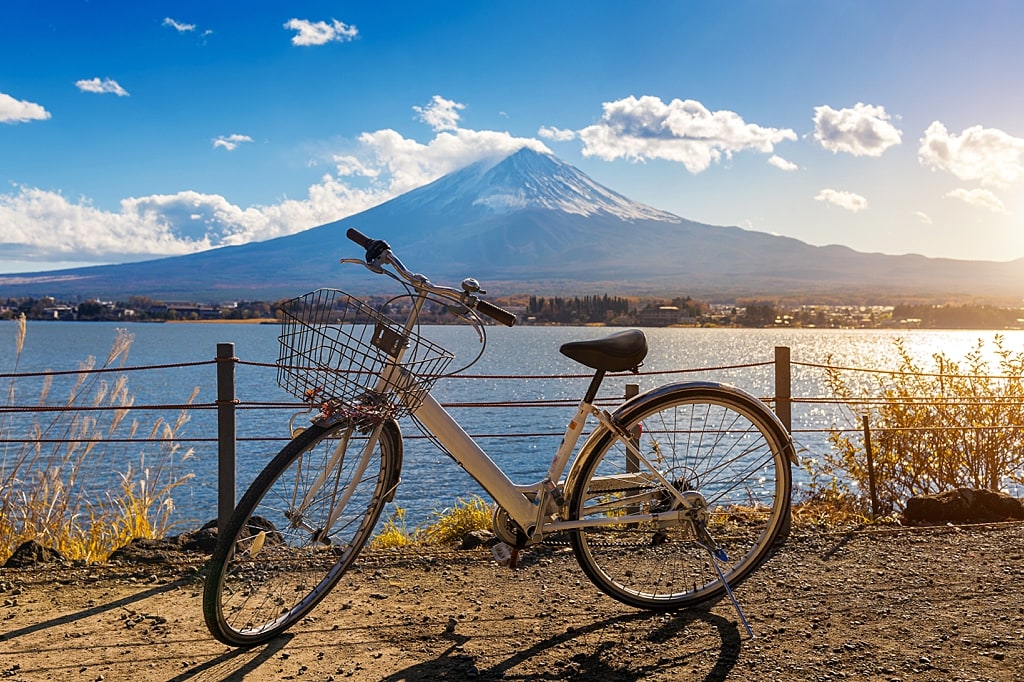
Biking is the best way to explore the entirety of Lake Kawaguchiko as the sightseeing buses always get caught in traffic.
In fact, biking is actually the faster approach if only have a day in Kawaguchiko, since you won’t need to wait at bus stops.
You can rent a bike for a whole day, with prices starting at ¥1,800-¥2,000, and there are many bike rental shops outside the Kawaguchiko Station.
2. By Sightseeing Bus
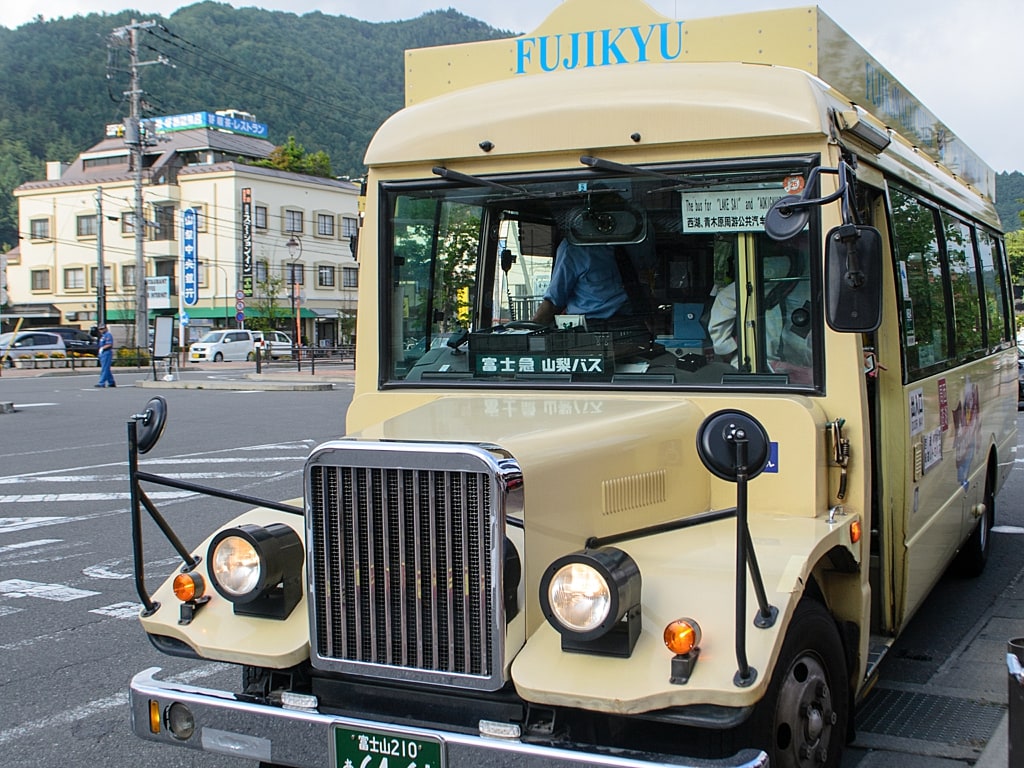
The Sightseeing Bus bound for Lake Kawaguchi and attractions nearby runs every 15 minutes, while the Sightseeing Bus bound for Lake Sai runs every 30 minutes.
These sightseeing buses are also known as Sightseeing Retro Buses because of their, you guessed it, retro design .
Be aware that during peak season (autumn and spring), you’ll experience MASSIVE delays in the bus schedule because of traffic, which can really SLOW DOWN your itinerary.
If you choose to do this option, I highly recommend that you make your trip overnight (2 days) and get the Unlimited 2-Day Ride Pass . You can get the Unlimited Ride Pass at the visitor’s center of Kawaguchiko Station. Check out our recommended accommodations in Kawaguchiko .
Which is better, join a day tour or on your own?
I get this question a lot from my friends who visit me in Japan and want to see Mt Fuji up-close. This is my answer to them:
Join a charter day trip tour if you want to save time and money, and aren’t looking to stay overnight.
It is also the perfect option for solo travelers, families, or large groups. Another advantage of joining a day trip tour is that you also get to visit other areas near Mt. Fuji but are outside of the Kawaguchiko and other Fuji Five Lakes.
Heck, you might not even need to read this article since you are accompanied by a professional tour guide! If you’re in a large group, say, 6-8 people, it’ll definitely be cheaper to just → book a Private Mt. Fuji tour and divide the costs among you.
Some private tour guides can also act as your personal photographer! You can also customize your tour and even go to tucked-away destinations around Mt. Fuji that are not easily accessible by public transport.
LOOKING FOR AN ORGANIZED MT.FUJI TOUR? → Click for best bus tours to Mt. Fuji → Click for private chartered tours to Mt. Fuji (recommended for groups of 6-8 people!)
What about self-driving?
If you can, driving around the areas of Mt. Fuji is the best way to explore as you can explore at your own pace. In fact, this is what we do every time we visit.
If you’re looking to rent a vehicle, then we recommend → Web-Rentacar by White Bear Family Co., Ltd . (Japan-based). We’ve used them a number of times before, and their prices are pretty hard to beat!
If you do decide to drive, we’ll have suggested itineraries for you later. It should go without saying, but there’s no need to buy the Unlimited Ride Pass with this option.
The main advantage of driving in these areas is that parking is free everywhere in the Fujikawaguchiko area, and you don’t need to worry about relying on the buses. We have prepared an itinerary for you below to make the most out of your Mt. Fuji experience!
If you plan to rent a car and you’re not comfortable driving from Tokyo to Kawaguchiko , we recommend that you take a bus and rent the car in Kawaguchiko. You have to make sure that you book in advance online. We have not experienced walking into rental car agencies in Japan, but we’ve never had any trouble reserving a car online.
Please note that unlike the American rental companies, the Japanese tend to be strict on the pick-up and drop off times, and will absolutely charge you.
Know before you go
1. Weather. Mt. Fuji is very dependent on the weather. Cloudy days, obviously, completely obscure your view. And if there’s one thing I’ve learned about climbing Fuji-san , it’s that the skies always seem to be clear and beautiful…on the days you’re not climbing. So the good news is, if you visit outside of the climbing season, you should have many splendid views of the mountain. Unless you visit during the rainy season.
2. Best time to see Mt. Fuji. After years of living in Japan and living in a house that actually had a view of Mt. Fuji, we’ve found that November to February offers the best visibility of Mt. Fuji (and its famous snow cap!) You can still definitely visit year-round, it’s just that you have to time your visit on the sunniest and clearest weather forecast possible.
3. Carry cash . Unlike the cities in Tokyo, most of the small shops and restaurants you’re likely to encounter around Kawaguchiko and Saiko don’t accept credit cards. So make sure you have enough yen before you go sightseeing.
Our Suggested Mount Fuji & Kawaguchiko Itineraries
So you want to do it on your own? Awesome! First off, remember to check the weather forecast for the days you’ll be visiting (if possible).
We admit that it’s a huge DOWNER when Mt. Fuji is not visible. But don’t let that discourage you from visiting! The chances it will be like that if you stay multiple days are slim. Make sure to BOOK your accommodation in Kawaguchiko well in advance.
→ Click to see our recommended accommodations in Kawaguchiko with great views of Mount Fuji .
Here are our Mt. Fuji & Kawaguchiko itineraries that you can copy from Tokyo:
2-Day Kawaguchiko & Saiko
Day 1: Take the early morning bus from Tokyo to Kawaguchiko Station . Upon arrival in Kawaguchiko Station, get the Unlimited 2-Day Ride Pass at the visitor’s center, then hop on the Red-Line (Kawaguchiko Sightseeing Bus).
Your first stop is the Natural Living Center . Explore the Natural Living Center, the Oishi Park is just outside and offers one of the best panoramic views of Mt. Fuji with Lake Kawaguchi.
Next, hop on the Red-Line bound for Kawaguchiko Station as your next stop will be the Itchiku Kubota Art Museum . Pay the entrance fee of ¥1,300 and explore the museum’s entirety!
Once done, why not have some lunch? Try houtou noodles , a popular delicious regional dish from Yamanashi! From Itchiku Kubota Art Museum, walk to Momiji-tei Restaurant and order their beef houtou . You’ll not be disappointed.
After the big lunch, you have the option of exploring this area. Kawaguchiko Music Forest Museum and Konohana Museum are just around the corner. Just choose one or just keep exploring.
Mt. Fuji is actually very visible from this area. The best spot to take photos here is the North Coast trail , which is just behind the Konohana Museum . Admire Mt. Fuji there, and why not have a cup of coffee?
After that, go to the nearest Red-Line bus stop and, if you still have time, go to the Sightseeing Boat/Ropeway Ent. bus stop for the Kachi Kachi Ropeway and ride the cable car going up to Tenjoyama Park , which offers not just another beautiful view of Mt. Fuji, but the town and surrounding mountains as well.
Afterward, depending on where you booked your hotel (which should be just around Kawaguchiko Station), check-in.
Day 2: Eat your breakfast and check out of your hotel. Take the Green-Line Saiko Sightseeing Bus. Your first stop should be the Saiko Iyashi-no-Sato .
Take your time exploring Iyashi-no-Sato, you could easily spend half the day here relaxing while viewing Mt. Fuji. They have samurai costumes to rent during your time here as well.
Next, go back to the bus stop and take the Green-Line again for Kawaguchiko Station. Your next stop is Yagisaki Park , which, depending on the time of year you visit, can be filled with flowers and herbs.
During peak season, you’ll find many food stalls here serving ice cream, dango, and other sweet Japanese street food. Small coffee shops are also scattered around the area. We personally love Milky Way and Cisco Coffee !
After relaxing, hop on the Green-Line bus and head back to Kawaguchiko Station, then back to Tokyo.
2-Day Kawaguchiko & Aokigahara
Pre-booking requirements:
- 2-hour Explore Aokigahara Forest with a Nature guide , book the earliest time if possible. ( This tour must be booked 2 days in advance!
Day 1: Do Day 1 of Itinerary #1.
Day 2: Breakfast and check out. Hop the Green-Line bus and go to Fugaku Fuketsu bus stop to meet up with your nature guide for the beautiful Aokigahara forest exploration.
Afterward, you are free to go explore the rest of your day, you can either visit the Iyashi-no-Sato healing village or head straight to Yagisaki park (see Day 2 of Itinerary #1 for ideas). Head back to Tokyo.
2-Day Kawaguchiko & Fuji-Q Highlands
Day 1: No need to buy the 2-Day Unlimited Pass! Explore Lake Kawaguchi by bike! There are many bike rental shops around Kawaguchiko Station.
Rent a bike for the whole day (usually ¥1,500-2,000 per day) and follow the Day 1 of Itinerary #1.
Don’t forget to grab a map from the shop for the dedicated bike route to the attractions mentioned on the Itinerary 1.
Day 2: From Kawaguchiko Station, take a bus to Fuji-Q Highlands and spend the day riding some of the world’s top roller coasters! There’s plenty more to see and do between rides, so be sure to explore as you go.
When you’ve gotten your fill, head back to Tokyo.
NOTE: For those of you able to spend the 3rd day here, consider relaxing in the nearby Fujiyama Onsen after your day in the Fuji-Q!
2-Day Kawaguchiko & Arakurayama Sengen Park
Day 1: Do Day 1 of Itinerary #3.
Day 2: Take the train from Kawaguchiko Station to Shimoyoshida Station and walk to Arakurayama Sengen Park .
Do some warm-up stretches as you’ll be climbing nearly 400 steps to see the beautiful Chureito Pagoda on top, which offers a breathtaking view of Mt. Fuji and the entire town of Fujikawaguchiko and Fujiyoshida City.
When you’re ready, head back to Tokyo.
1-Day Kawaguchiko (by bike only)
Just follow the Day 1 of Itinerary #3–explore Lake Kawaguchiko by bike!
Top things to do around Mt. Fuji’s Kawaguchiko & Saiko
1. sightseeing retro bus.
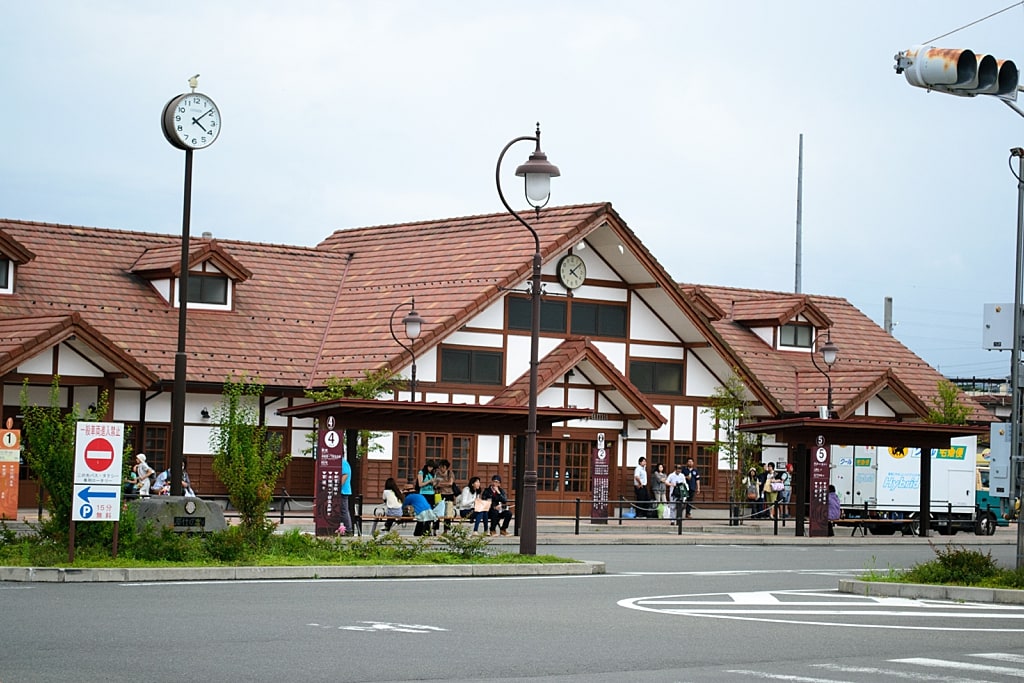
If you’re doing this trip on your own, again, I highly recommend that you stay overnight, ideally near Kawaguchiko Station as the bus starts there.
The Unlimited 2-Day Ride Pass is ¥1,500 . You just have to show the pass to the bus driver when boarding and exiting the Retro Buses. There are two bus lines that take you to the tourist spots around the area.
First is the Kawaguchiko Sightseeing Bus or the “Red-Line” which will bring you to areas around Lake Kawaguchiko. The second one is the Saiko Sightseeing Bus or the “Green-Line” which will bring you to areas around Lake Saiko.
2. Tenjō-Yama Park Mt. Kachi Kachi Ropeway (also known as Mount Fuji Panoramic Ropeway)
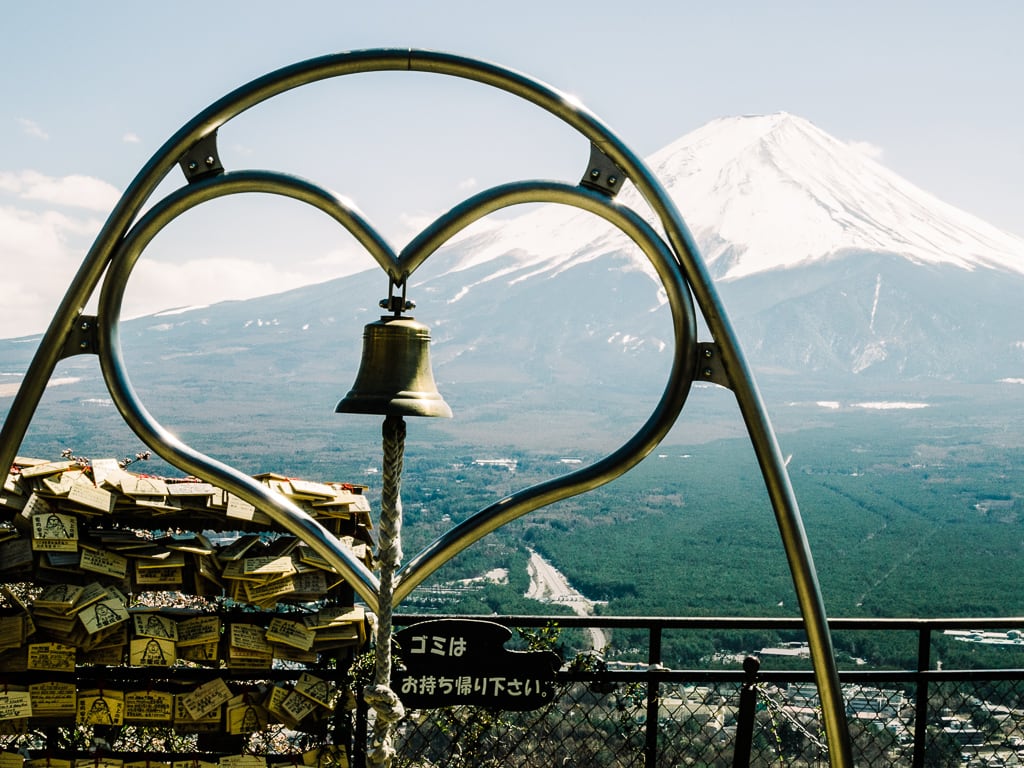
Probably the most popular attraction within this little town, the ropeway provides you with easy access to the top of Mt. Tenjo and gives you a great view overlooking the lake and town with the many mountains surrounding it all.
While you can take the cable car to the top, you also have the option of hiking up the mountain, although it’s a deceptively difficult trail…if you’re carrying a child on your shoulders.
The only real drawback to hiking up is finding the actual entrance to the trail is a bit of a hassle. It honestly took us about an hour to finally find it because, like many hiking trails in Japan, it’s sort of in a weird place, and makes you feel like you’re trespassing at the start.
At the top, there is a small souvenir and snack shop, along with a few trails leading to better views, and other mountains.
We suggest hiking up and riding down the ropeway cable care if you’re feeling up to it, or vice versa. Riding both ways simply robs you of some of the best views of Fuji you’re likely to find, as well as robbing you of an excuse to eat one of the tasty treats found at the top!
3. Kawaguchiko Music Forest Museum
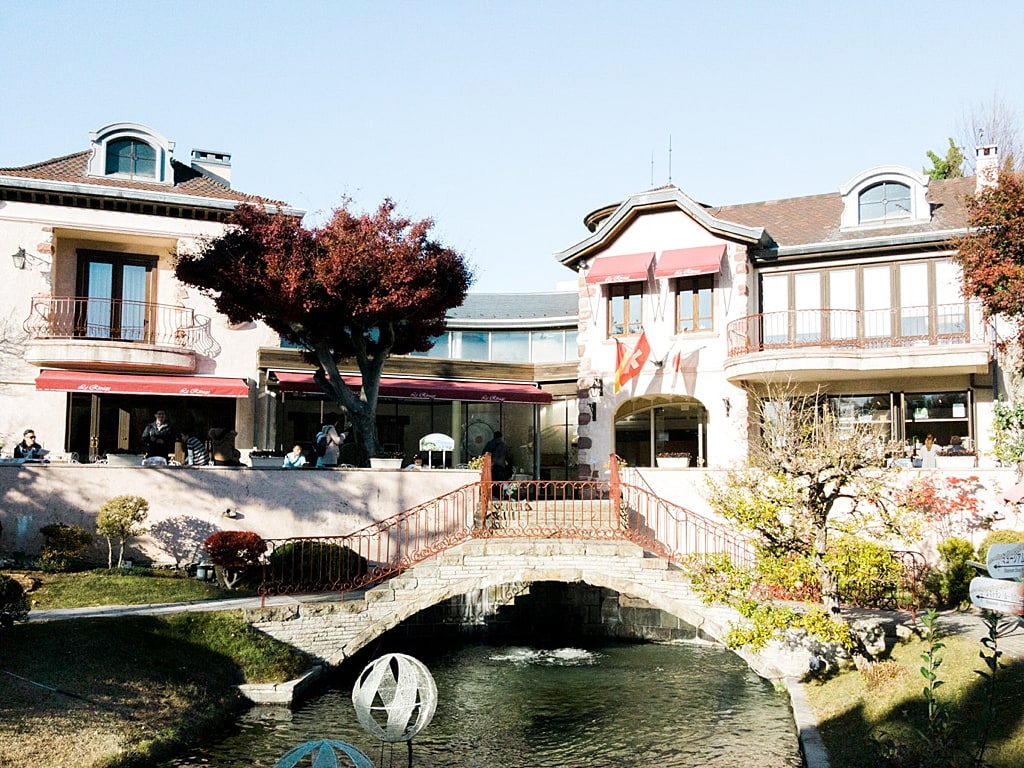
The buildings inside the Music Forest Museum remind me of a European fairy tale setting, with somewhat exaggerated buildings, and lots of pink paint.
The whole “forest” itself is built to resemble a town square of sorts, with a central fountain. So if you’re expecting a walk through a nature trail, it’s not like that. There are two buildings with things to do or see inside, and all the others are some form of a souvenir store. The whole area is handicap and stroller accessible.
The only thing we don’t like about this place is the admission ticket price — ¥1,500 per person. But there are 2 ways to get some discounted tickets for the music forest for about ¥300 off:
- By printing the web coupon screen from their website or;
- By reserving in advance through their website and paying through PayPal.
4. Konohana Museum
Home of Dayan the Cat, the Konohana museum is a fantastical stylized architecture, reminiscent of the Ghibli Museum . Containing the works of Akiko Ikeda, it was built to look like the Tachiel Enit Museum in the fictional Tachiel City, and is as much a part of the artwork as the pieces it houses.
Wachifield is the fictional world created by Ikeda-san, and the love and care that went into making this museum feel as authentic as possible can be felt as you wander its halls. Pictures, sculptures, and dynamic dioramas can all be found inside.
And while the exhibit itself is rather small, that makes it easy to fit into most itineraries!
5. Kawaguchiko North Coast Walking Trail
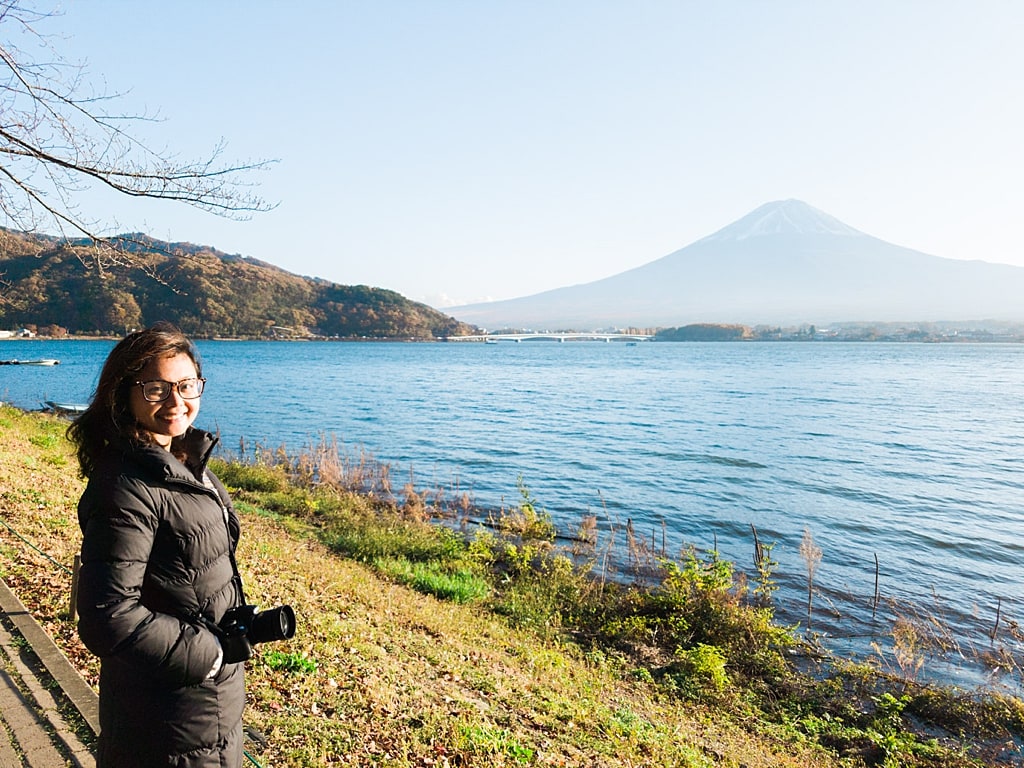
The North Coast Walking Trail is just a 7-minute walk from the Kawaguchiko Music Forest Museum and located behind the Konohana Museum. This short trail offers a 180-degree view of Mt. Fuji and is a place that many tourists are unaware of.
We saw many restaurants as we walked the trail, mostly Italian restaurants (there is a strong European influence here), cafe shops, and dessert shops. But we didn’t dare to try one. They were expensive!
It seemed to me that you are mostly paying for the comfortable seats and view, rather than the quality of the food that you order. So I suggest just enjoying the view and skipping the restaurants, maybe bring a boxed lunch, or just eat at one of the much better options elsewhere.
6. Itchiku Kubota Art Museum
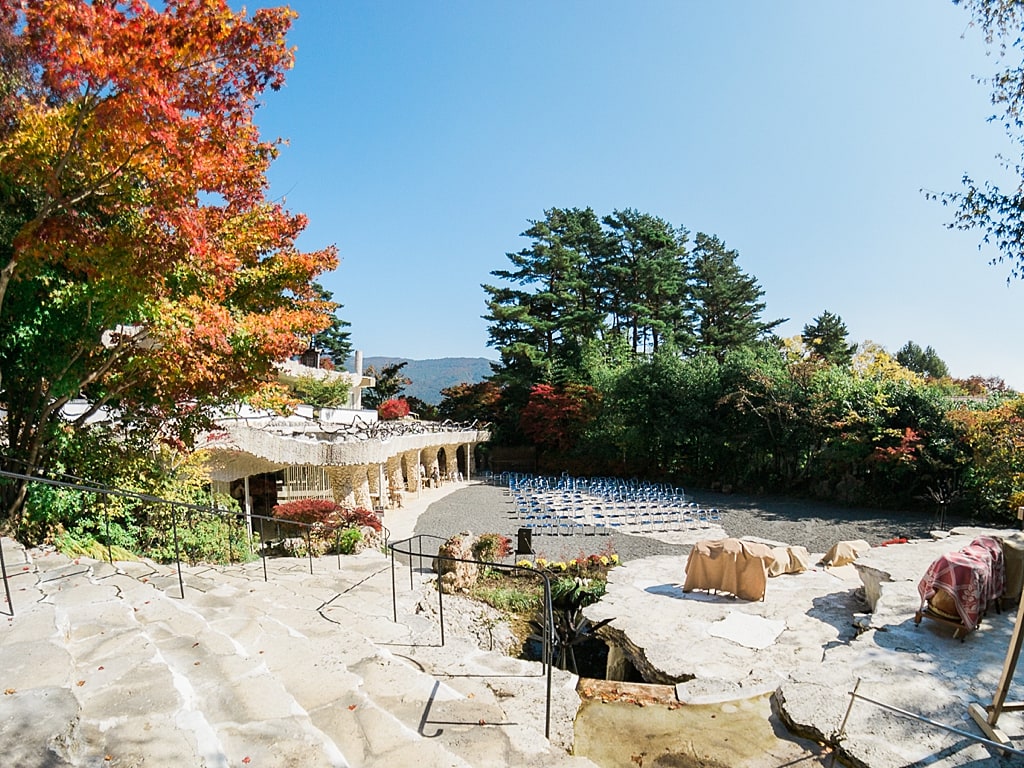
Itchiku Kubota is actually my favorite museum in Kawaguchiko. The museum lies inside a paradise-like forest with breathtaking views of the calm lake of Kawaguchiko and Mt. Fuji. It’s the most fascinating museum I’m ever seen.
It’s because the building is made up of Okinawan corals and limestones, and the foundation of the main gallery building is made from Hiba trees that are more than 1,000 years old. With an entrance fee of ¥1,300 , we were able to learn about the life of Itchiku Kubota and his fascinating artwork “ Tsujigahana. ”
Tsujigahana is a technique of dying kimonos which was prevalent around the period of the 13th to 15th century, or Muromachi Period, and became mostly extinct during the 16th to 17th centuries.
Kubota was 14 when he became a kimono artist. However, when he saw a 350-year old silk fragment, which was a remnant of Tsujigahana in Tokyo National Museum, he became fascinated and devoted his life to reviving it.
Several years after, Kubota was captured by the Soviets and was imprisoned in Siberia during World War II. When he was released, he studied the tsujigahana technique. But, because no instructions survived explaining how to reproduce it, Kubota was forced to experiment on his own for decades. Eventually, Kubota was not only able to reproduce it, but also modernized it.
He had his first exhibition in 1977 at the age of 60, and his works quickly went abroad and received various awards due to their uniqueness and superb quality. I would really recommend visiting this museum when you travel to Kawaguchiko and allow yourself to be inspired by Itchiku Kubota.
When you really want something to happen, the whole world conspires to help you achieve it. ― Paolo Coelho
Seeing his art really left me in awe, and I’m sure it’ll have a similar effect on you.
7. Kawaguchiko Natural Living Center and Oishi Park
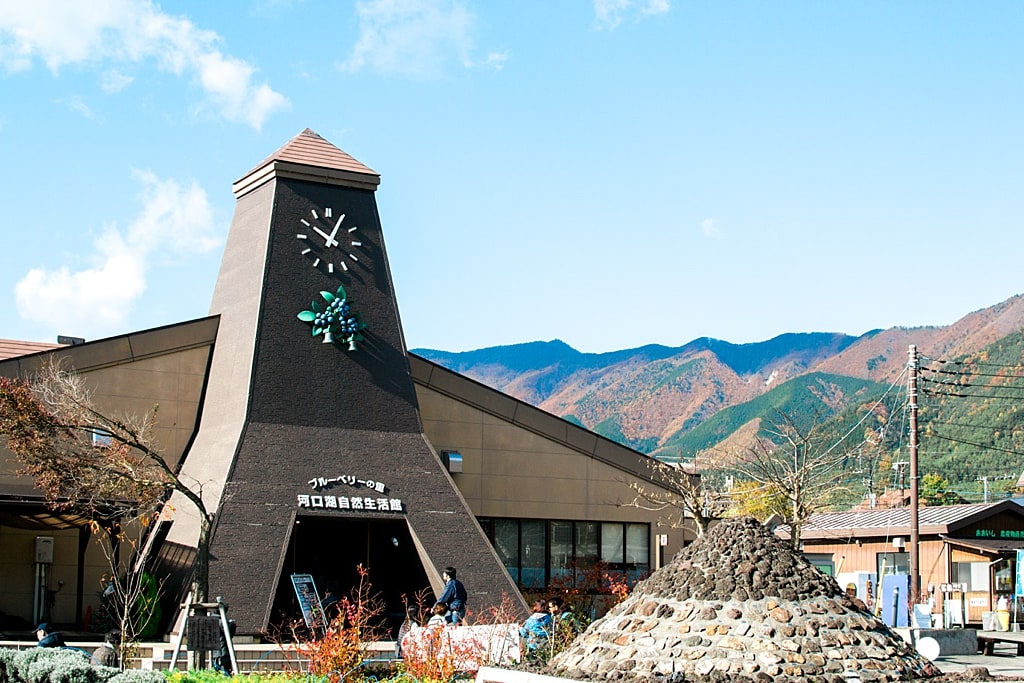
Located on the opposite side of the lake from Yagisaki Park, Oishi Park also takes part in the annual herb festival, and the Natural Living Center acts as a sort of a gift shop for buying herbs and blueberries.
Oishi park is also famous for its Kochia plants, which bloom in early autumn. You really can’t go wrong with either park, so why not just spend some time in both?
8. Yagisaki Park
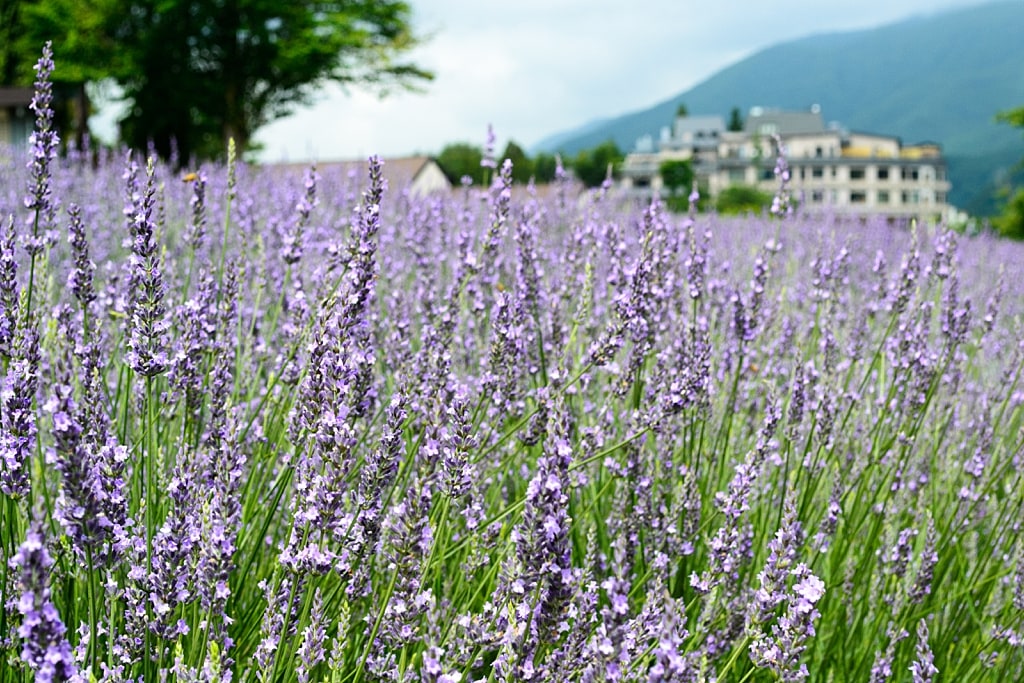
Located along the southern coast of Kawaguchiko, Yagisaki park offers both an incredibly peaceful and relaxing atmosphere, as well as an absolutely gorgeous view of Fuji-san and the surrounding mountains.
I suggest planning your visit to the park between June and July, as the park holds the annual Lake Kawaguchi Herb Festival during that time. The plants will be in full bloom and the entire area will be filled with vendors selling delicious treats and souvenirs.
There is also a popular art museum called Muse-kan (Muse Museum) in the park, which displays the work of Yuki Atae, a famous doll-maker in Japan. There are approximately 90 dolls on display within the museum and are rotated twice a year. There’s also a cafe and gift shop within as well.
9. Saiko Iyashi-No-Sato Nenba (Healing Village)
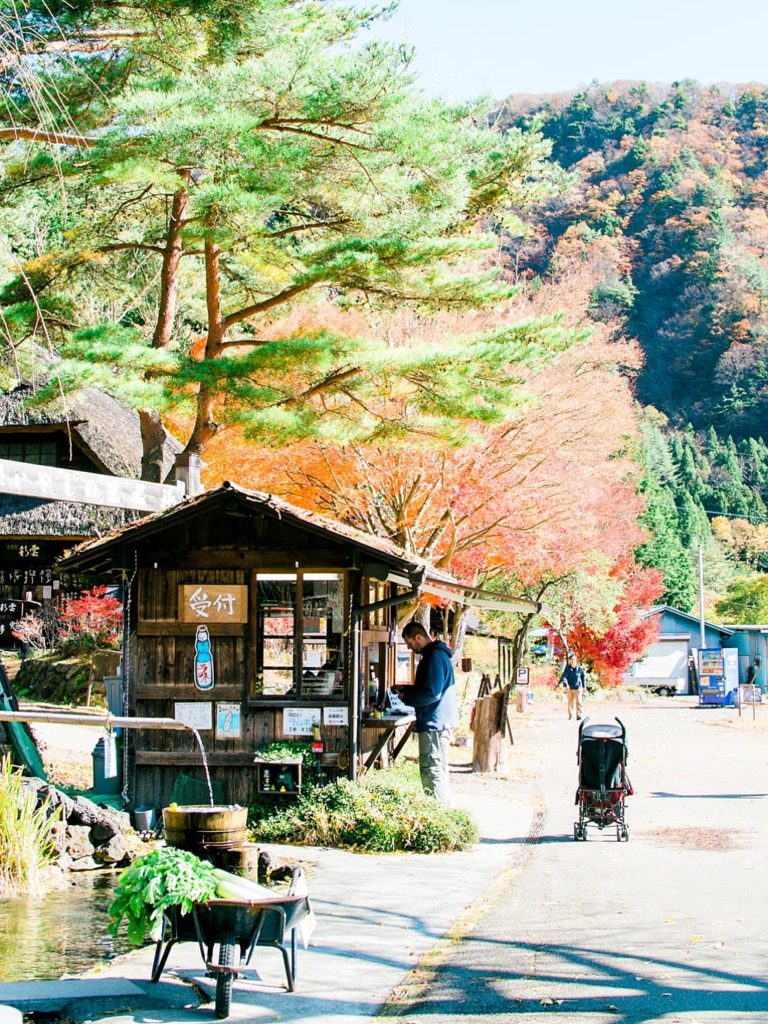
Located near Saiko, Iyashi No Sato Nenba is an open-air museum that features thatched roofed houses that are similar to the historic village of Shirakawa-Go in Gifu Prefecture. These thatch-roof houses were originally built by farmers for raising silkworms back in Showa Period (1926-1989).
A typhoon in 1966 actually destroyed the village, but now, reconstructed 40 years later, there are over 20 thatched houses that were converted into shops offering souvenirs, workshops, or hands-on activities like paper mache, Hina doll making, or weaving.
Each thatched house has its own specialty, including souvenir shops, tea houses, handicraft workshops, and art galleries. This place is beautiful and relaxing and made more beautiful by the surrounding foliage.
This is also one of the best views of Fuji to be found in the five-lakes area. There are also stores near the parking lot with local fruits and vegetables, honey products, and other Japanese street food. In fact, my husband didn’t want to leave because a man was selling huge jars of honey for ¥2,000, which is unthinkably cheap in Japan!
10. Aokigahara Forest (Suicide Forest)
After reading many of the urban legends about this enigmatic forest online, I tended to think it was enough to discourage people from trying to enter this forest.
Exploring the infamous Aokigahara Forest was something I thought would be impossible given the stories surrounding it. But apparently, it’s not. The forest is open to the public and is actually a major attraction for the area.
Upon reaching the entrance to the forest, however, it becomes clear that not all the stories are myths. There are warning signs in Japanese telling you to stay on the hiking trail and avoid going too far from the entrance, as it was believed that people get lost because the GPS doesn’t work in some areas of the forest.
The entrance also has a sign in Japanese talking about suicidal thoughts, as well as listing various help hotlines. It reads:
Life is an important thing we receive from our parents. Think once more about your parents, your siblings, your children. Don’t suffer alone. Please talk to someone.
Aokigahara is both beautiful and creepy , and if you’re interested in seeing it for yourself, you should definitely join a guided nature tour .
Oh, and don’t be a Logan Paul…
11. Arakurayama Sengen Park
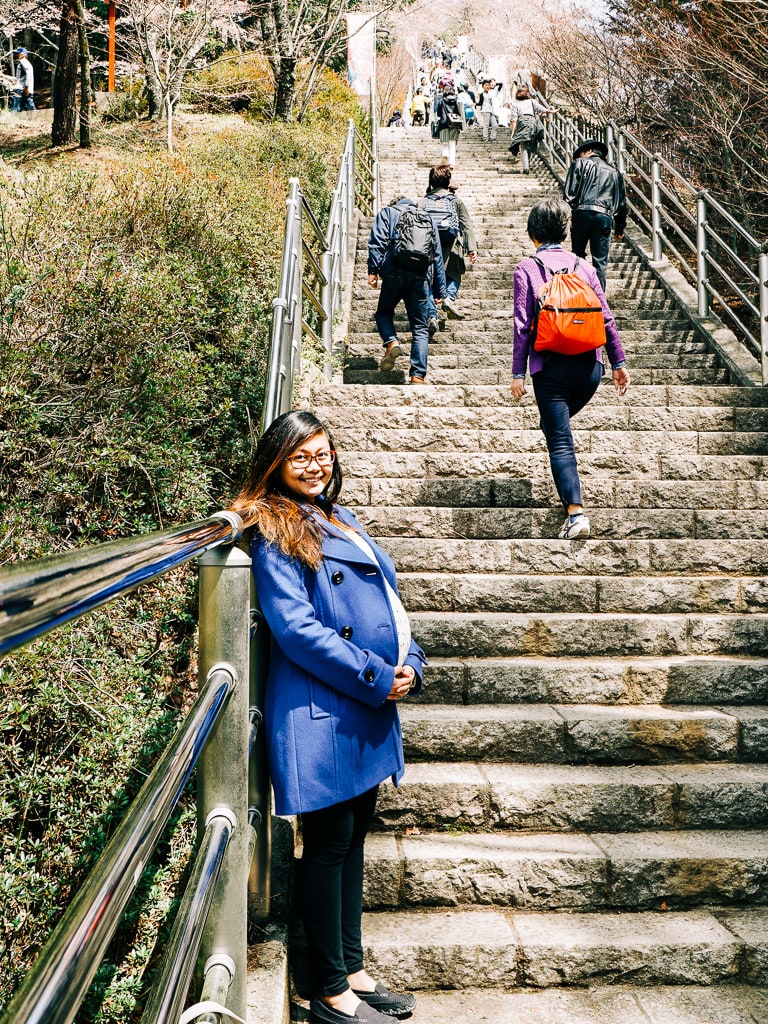
Home to the Chureito Pagoda, this park offers yet another incredible view of Mt. Fuji, while also overlooking Fujiyoshida City. It’s over almost 400 steps to the park, but the way is lined with cherry blossoms, which should take your attention away from your burning thighs.
It’s a hike to the top but you’ll be rewarded by the panoramic views of Mt. Fuji along with the Pagoda, made famous by Japan postcards.
12. Fuji-Q Highland
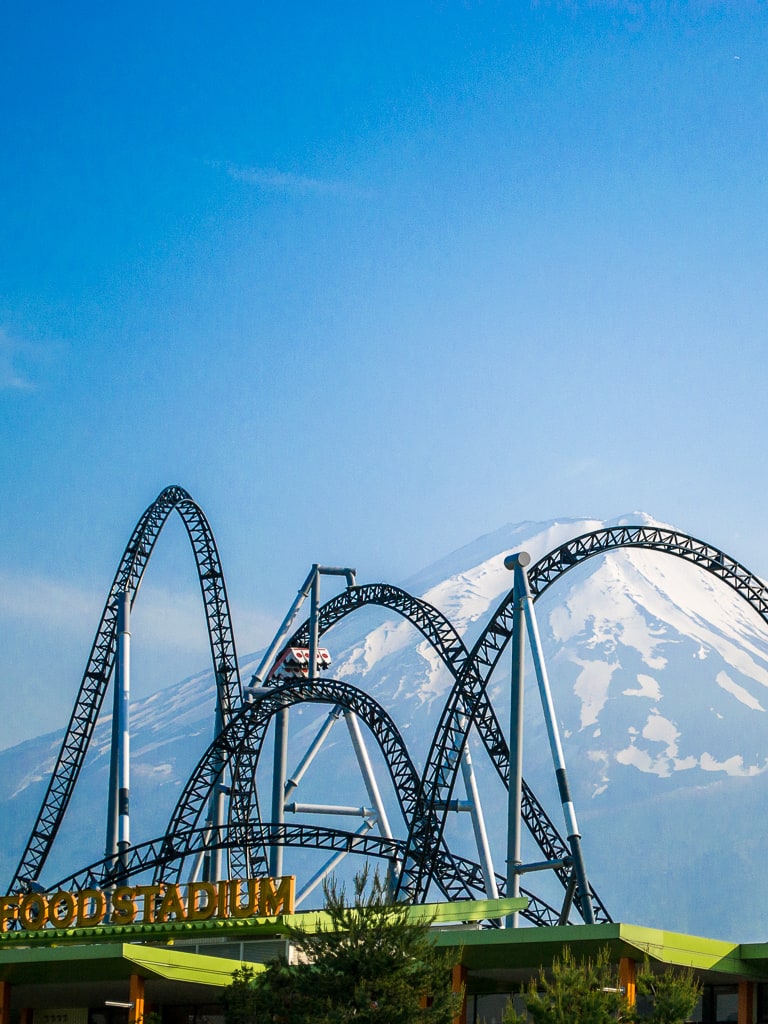
Probably the main attraction for Japanese locals around Mt. Fuji, not named Mt. Fuji, is this amusement park known for its roller coasters and thrill rides. For those less enthusiastic about that sort of thing, the park also offers 3 other areas to explore that don’t focus on rides.
Made up of four separate areas/parks, there is the main park, Fuji-Q, which is where the major rides and attractions are. Thomas Land, based on Thomas the Train, for the kids. La Ville de Gaspard et Lisa, based on the French picture book characters “Risa and Gaspearl.”
As I said before, the area around Fuji has a strong European influence). And it’s the newest area, Fuji Leaf Village, based on the popular manga anime Naruto and Boruto.
I’ve been to the park about 3 or 4 times, but I’ve honestly only been to the main park. Thomas Land was the only other area at that point (and we didn’t have a child at that point), and I haven’t returned since the other areas were built.
This is definitely on our to-do list, and we’ll be sure to get back to you with our thoughts as soon as we do. As for the main park, the roller coasters are incredible and are definitely the main attraction.
Each also affords a great view of Mt. Fuji (except Dododonpa, you’re going too fast), right before you take your first drop. I highly recommend stopping here during your trip if you’re looking for something different than the normal trip to Disneyland or Universal Studios Japan .
After all, you can get those in America as well. But there’s only one Fuji-Q.
Want to See More?
Our 53 Best Places & Things to do around Fuji Five Lakes There are so many things to do around Fuji Five Lakes! Even when you can’t see Mount Fuji, you can still enjoy all the attractions and off-the-beaten spots around the Fuji Five Lakes area.
Read our 53 Best Things to Do in Fuji Five Lakes
Top seasonal attractions in Kawaguchiko
1. Kawaguchiko Herb Festival in summer . Mainly lavender fields in Yagisaki Park and Oishi Park. Lots of Japanese street food, so make sure you try some. Event dates here .
2. Momiji Corridor Festival (Maple Corridor Festival) in autumn. Lots of fiery maple trees lined up with many street foods and souvenir stalls down the road. This is a very popular event in the autumn and is jam-packed with “Leaf-Peepers” (for my Mainers out there). Event dates here .
3. Oishi Park’s Red Kochia in autumn. A great alternative to Hitachi Seaside in Ibaraki, Oishi Park has plenty of Kochia plants that turn a deep red during mid-October . And the best part is it has Mt. Fuji as the backdrop.
4. Oike Park in autumn. Oike Park, a park in front of Kawaguchi Herb Hall, is lined with poplar trees which turn a beautiful yellow in late October to early November . Mt. Fuji isn’t so visible here because it’s partly a residential area, but it’s worth visiting only during autumn.
5. Arakurayama Sengen Park. Although still, very nice year-round, Arakurayama Sengen park is EXCEPTIONALLY beautiful when visited during cherry blossom and autumn season.
Where to Eat in Kawaguchiko
Food is our favorite part of every journey, and Kawaguchiko is perhaps one of our favorite places in Japan as it has really superb food. The Yamanashi area as a whole is most well known for its famous Hoto Noodles, and Kawaguchi has many restaurants specializing in it.
We tend to favor and remember restaurants which offer both great food AND kind staff, so here’s our list:
1. Momijitei restaurant
Momjitei is just a 7-minutes walk from the Itchiku Kubota Art Museum. And it is famous for making the best Houtou noodles in Kawaguchiko, and the best restaurant to go for your lunch.
Just make sure to get there early as it fills up fast! Their homemade miso sauce is aged for two years and is what sets them apart from other houtou noodle restaurants.
We had beef houtou during our visit and it was one of the best meals we’ve ever had! The staff instructed us by pointing to the condiment tray on our table that we could also add some Nanban (miso topping) for an added oomph to the soup flavor.
2. Houtou Fudou restaurant
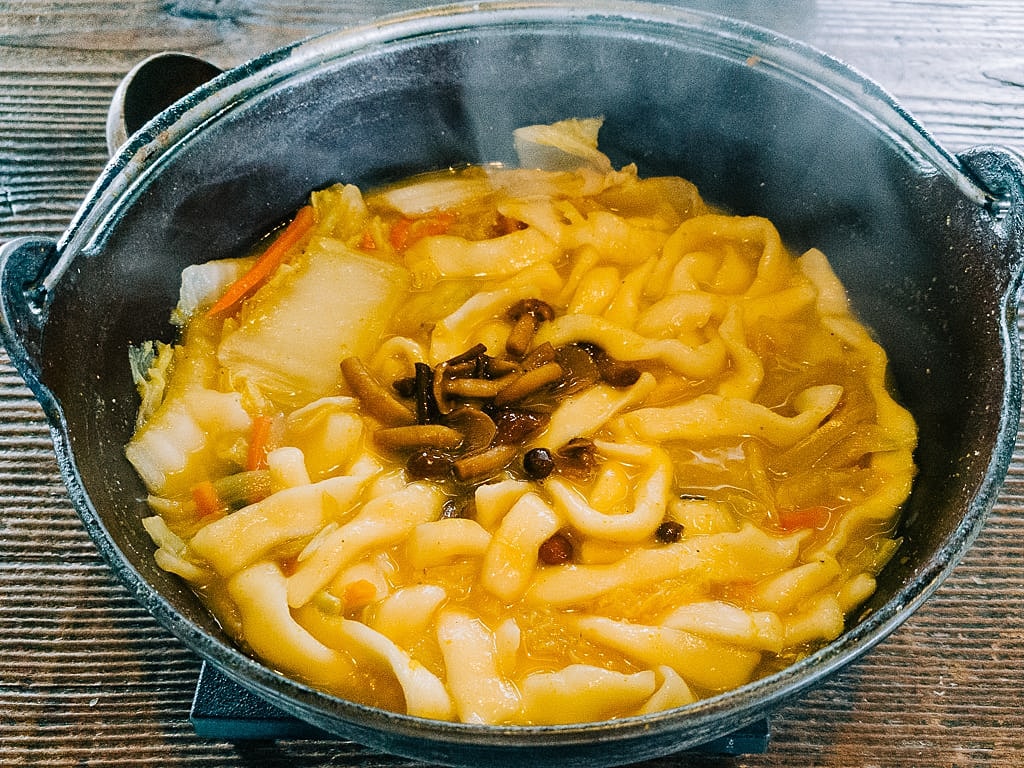
Houtou Fudou has several branches in Kawaguchiko, and we ate at their main branch near the Kawaguchiko Music Forest Museum. All their branches are always extremely busy!
That’s how popular they are. There’s one just in front of Kawaguchiko Station, and of course, due to its location, it’s always jam packed!
Now if you were to ask us which Hoto noodle shop is best, we would personally choose Momijitei Restaurant because the food is great, it comes in a large portion, and the staff was very friendly.
3. Tempura Restaurant Ninja
This restaurant is only a 4 minute walk from Kawaguchiko Station. Now, I don’t usually like tempura because it’s generally greasy, but this is different and has become the only tempura I really like!
Our picky daughter surprisingly ate their tempura as well, which is always a plus. Something about their tempura is unique, I think it might be air fried, but who knows. The staff here are very nice too, and, as usual, our daughter received treats from them.
4. Cisco Coffee
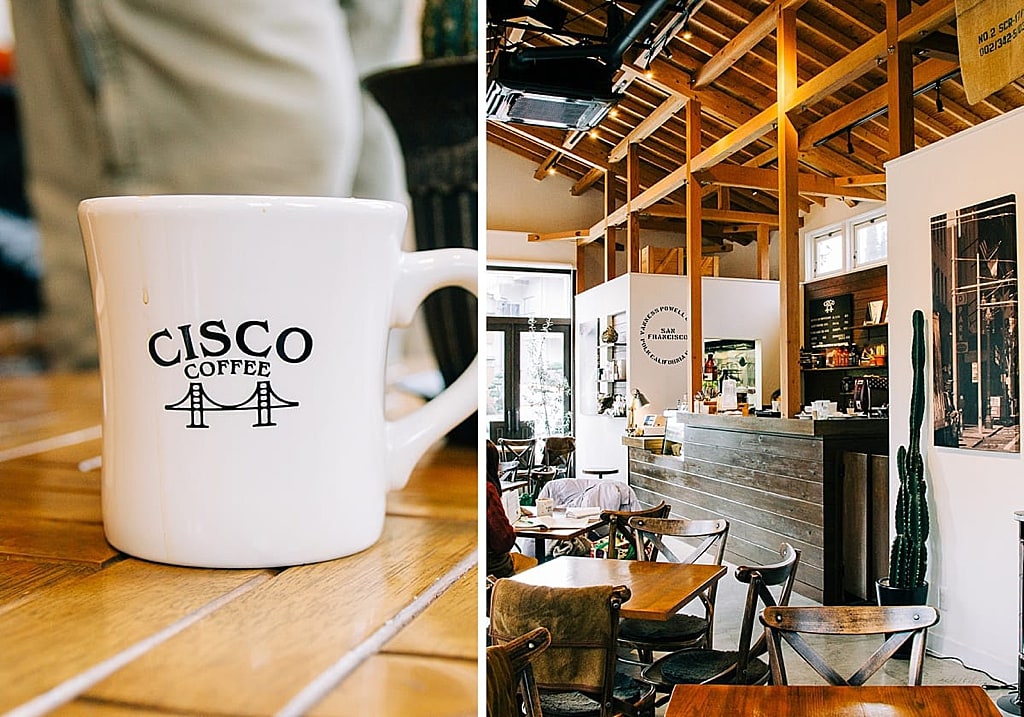
This cozy coffee shop is located near Yagisaki Park is a San Francisco style coffee shop in a relaxing shop to sit and relax with a good book. The menu is pretty simplistic, but the coffee is top notch and really helps warm you up on a chilly morning by the lake.
5. Milky Way
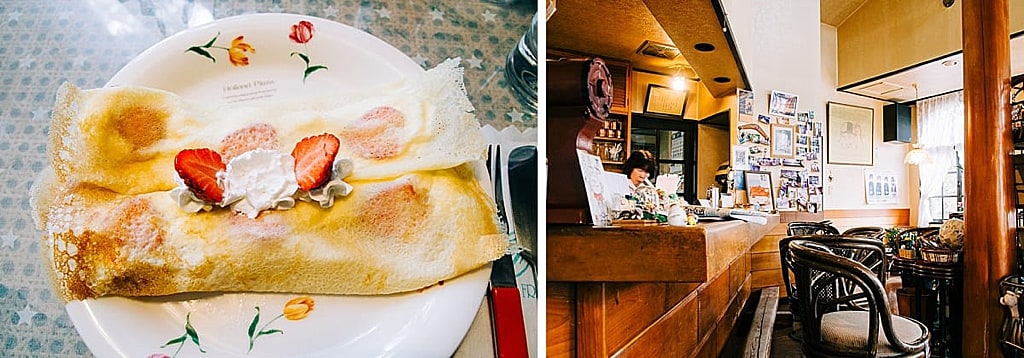
This is a traditional shop that is also located near Yagisaki Park. They have an incredibly cozy atmosphere inside.
Now, I won’t lie, I’m a sucker for Mom & Pop type places, and this shop is clearly a passion project between the joint owners who run it. The desserts here are absolutely incredible, and the owners were super patient with our daughter, who was being rather moody this day.
There are plenty of toys to entertain most kids, but apparently, not enough for ours. I can’t recommend this place highly enough!
6. Troisieme marche
We love this coffee & bakery shop, and we wanted to enjoy it more, but our daughter just wouldn’t sit still. This is located near Kawaguchiko Forest Museum, and is famous for their cake desserts, which were amazing.
And that’s it! Please know that the itineraries presented above are based on our experience, so it’s tried and tested .
If you have any question, please leave you comment below!
11 thoughts on “Kawaguchiko: Full Guide, Sample Itineraries & Things to Do”
Hoping to see your 1 night itinerary for kawaguichiko we are coming from Narita. thank you!
I will be self driving from Narita Airport to Lake Kawa on March 11 . Hopefully we can reach before noon to Lake Kalwant. We will be staying in kawaguchiko Hotel. Can you assist to plan the route for us around the area for the places of interest? We will depart on the 13th. I would also like to know, since we self drive, there is no need for us to buy the bus pass right? Then where do we get the ticket for the cable car and the ferry? Is it still better to get the pass for the Ropeway? Want idea on the cost of the Ropeway and ferry ? Thanks in advance
Hi Ada, I will be travelling from Osaka to Kawaguchiko with my family of 3 by JR pass from 24-25 Apr. We will take the earliest train and hopefully to arrive Kawaguchiko before noon on the 24th of April.
We will be staying in the Hotel New Century. We are planning to rent 2 ordinary bikes & 1 E-bike to cycle around Kawaguchiko & Saiko.
Can you please advise to me where to rent a bike, and should I rent it for 2 days?
Can you also advise to me how to plan my cycling trip to cover all the places below? 1. Natural Living Center. 2. Oishi Park 3. Itchiku Kubota Art Museum. 4. Try houtou noodles 5. Momiji-tei Restaurant and order their beef houtou 6. Kawaguchiko Music Forest Museum 7. Konohana Museum 8. North Coast trail 9. Maples Corridor 10. Nagasaki Park 11. Oishi Park 12. Kawaguchiko Natural Living Center 13. Momiji Tunnel 14. Saiko Iyashi-no-Sato Nenba 15. Saiko Yacho-no-Mori Park 16. Fugaku Fuketsu (Wind Cave) 17. Narusawa Hyoketsu(Ice cave) 18. Ryugu Doketsu(Lava cave) 19. Fuji Omuro Sengen Shrine 20. Yagisaki Park 21. Kawaguchi Asama shrine 22. Mt. Tenjō Ropeway 23. Arakurayama Sengen Park 24. Fuji Shibazakura Festival
Thank you for visiting!
First of all, WOW, you’ve got a ton of places on your wishlist!
Kawaguchiko and Saiko are two separate areas. And most attractions you listed are seasonal and are closed.
For example, you won’t see any red foliage in Maples Corridor in April.
And if you are going to the museums, you can easily spend 2-3 hrs inside.
I recommend that you pick 3 places per day.
For example: April 24: Arakurayama Sengen Park, Fuji Panoramic Ropeway, & Natural Living Center or Music Forest Museum. April 25: One or two museums.
Hi Ada, I will be coming from Tokyo, and either take the Shinkansen or a bus to Kawaguchiko. Where can I rent a car in Kawaguchiko near the Shikansen Station of bus station?
Hi Louie, you should take the bus as the Shinkansen Station is far from Kawaguchiko. The car rental is just a few minutes’ walk from Kawaguchiko Station, here it is: https://goo.gl/maps/hJdrHkwQ1bbm4hNB9
Hi Ada, I can’t seem to find the “Day 1 Typical Tourist itinerary”. How do i go about it?
Hi Ada, I find your information very useful and interesting. Based on what you have written, I bet 2 nights stay is not enough to see all those attractions. Should I book to stay for 3 nights or it is too long? We( my family- 3 adults) are planning to travel from Kyoto to Kawaguchi in May by bus and will arrive early at 7.30am. I wonder what activities are available at night as I read from other blogs that said Kawaguchi is a very rural town. Is there any travel agent in Kawaguchi that organize short trips around here like fruit picking etc. so that we can join them without having to plan on our own?
Since you are arriving early, 2 nights is enough, but 3 nights would be great too. You’re right Kawaguchiko is a rural town. It’s also hard to tell you some suggestions without knowing where you’re staying, so where are you staying?
“follow the Day 1 Typical Tourist itinerary” < I can't find the Typical Tourist itinerary…
Hi Nat, thanks for pointing that out. I forgot to edit the itinerary when I renamed them. I fix it now for you!
Leave a Comment Cancel reply
Save my name, email, and website in this browser for the next time I comment.
The Partying Traveler
Survival of the littest, the complete kawaguchiko and mount fuji travel guide | japan.
The small town of Kawaguchiko is the main home base for travelers looking to summit the majestic Mount Fuji, but there’s much more to do than just visit Japan’s tallest peak. Kawaguchiko centers around the lake of the same name, with plenty of hiking and biking trails, and beautiful places to visit. My time here felt like one of those Ghibli films set in small-town Japan. I spent most of it cycling around the quiet village and immersing myself in the serene nature of Japan. It was a much-needed respite from the crowds and ultra-modern cityscapes of Tokyo, and really showed me how much more there was to Japan than its futuristic urban jungles.
I ended up spending four days in Kawaguchiko, despite many travelers staying no more than a day or two. It goes without saying that Mount Fuji is the main highlight of this town, although for non-trekkers, there is plenty to keep you busy. Here’s everything you need to know before taking on Mount Fuji and Kawaguchiko.

And hey, if this post helps you out, show some love and support for the blog and help keep my adventures going by buying me a beer ! My adventures are entirely self-funded, so any show of support is greatly appreciated. It allows me to keep providing free travel guides and creating travel content to help you all travel the world.
This post contains affiliate links. That means that I may earn a commission if you make a purchase through these links.
Table of Contents
- How To Get to Mount Fuji and Kawaguchiko
- Where To Stay in Mount Fuji
- Getting Around Kawaguchiko and Mount Fuji
- The Best Things To Do in the Mount Fuji Area
- Things to Know Before Going
Buy Me A Beer!
How to get to mount fuji / kawaguchiko.
Japan’s transportation system is well-renowned as one of the best in the world. Getting to Kawaguchiko is a breeze. Whether you plan on traveling by bus or by train, there are plenty of options throughout the day. From Tokyo would be the easiest option, although one can get there from Kyoto or Osaka or elsewhere with minimal connections. I didn’t buy one of the rail passes, so I opted for a bus from Shibuya Station to save some money.
Regardless of where you are leaving from, your ending point should be Kawaguchiko Station. The station services both trains and buses. From here, a walk or short taxi ride should get you to your accommodation.

Staying in Kawaguchiko allows you to enjoy a more tranquil and serene environment compared to the bustling cities, but it’s also possible to take a guided tour from Tokyo. I’d only recommend this option if you are strapped on time. Be sure to look at the tour itineraries to make sure you get to visit the places you want to see.
Where To Stay in Kawaguchiko
Despite being a smaller town, Kawaguchiko had no shortage of places to stay. I stayed at K’s House Fuji View , an incredible hostel with a stunning view of Mount Fuji. During the summer, there will be plenty of hostels and hotels open for the crowds of travelers. I visited in early September, just days before the climbing season for Mount Fuji ended. Only a handful of hostels remained open, but I was more than happy with the one I ended up with. The dorms were pod-style, each with lockers, plugs, curtains, and space for my luggage.

The hostels in Japan really are top-notch, and despite them being pricier than other countries, I feel like you get your money’s worth. I paid $25 a night for a dorm bed in K’s House, although the price jumped up to about $40 on Friday night. You’ll find that hostels and hotels tend to jump in price over the weekends when people are more likely to travel. During peak trekking season, be sure to book well in advance to guarantee that you have a place to stay in Kawaguchiko.
If you simply plan on getting in and out to summit Mount Fuji, I’d recommend picking a place near Kawaguchiko Station. K’s House is about a 20-minute walk, which isn’t bad, but it did feel like an eternity walking back from the station after summiting Fuji. Saving the 40-minute round trip can go a long way once your legs feel heavy from hiking. It also puts you closer to the lake and allows you easy access to public transportation if you plan on visiting other towns in the area.
The other hostel I heard great things about was Hostel Michael’s . It is in Shimoyoshida, though, so you’d have to make the journey to do the things you want to do in Kawaguchiko.
Getting Around Kawaguchiko
I’d recommend renting a bike. It costs about $7 a day and is by far my favorite way to get around Kawaguchiko. Many places in town offer bike rentals, and most likely, your accommodation will, too. I rented mine from my hostel and the rate for the entire day was 1000 yen, as long as I brought it back before 8 PM. Not much goes on in town after dark, so this was totally fine.

There is a bus system, but I don’t think Kawaguchiko is that big that you need to figure out the routes. The only time I would recommend it is if you plan on visiting neighboring Shimoyoshida or one of the further villages along the lake. Aside from that, cycling and walking will be just fine. The views are incredible and there are cycling and walking trails all around the lake.
Here are the bus timetables between Kawaguchiko and Mount Fuji’s Fifth Station during the summer trekking season. If you want to visit Mount Fuji outside of trekking season, here are the bus timetables for the offseason .
Things To Do in Kawaguchiko
Although most people visiting Kawaguchiko have the intentions of visiting Mount Fuji, there is much more to do in the area than just that. The best views of Mount Fuji are from off the mountain, and with plenty of lakes, shrines, temples, and parks all with Mount Fuji serving as the stunning backdrop, Kawaguchiko has no shortage of breathtaking scenery to fill your time.
Cycle around Lake Kawaguchiko
Aside from summiting Mount Fuji, this was my favorite thing I did in Kawaguchiko. I rented a bike from my hostel and cycled around the lake, visiting various points of interest along the way. I basically followed the trail around the lake, pulling up Google Maps every now and then to see if I was nearby any points of interest. There were no shortage of places to rest my legs, from gorgeous parks and gardens to woodland shrines and unique museums.
If you’re up for the long bike ride, it’s worth heading over to Saiko Lake for more lakeside views of Mount Fuji. I wouldn’t say this is essential, as you definitely get your fair share of views cycling around Lake Kawaguchiko alone.
Visit the Gardens at Oishi Park

On a clear day, the views of Mount Fuji from Oishi Park are phenomenal. This small lakeside park is filled with bright, colorful flowers. Along with the lake and Mount Fuji in the background, you couldn’t dream up a more beautiful place to snap some photos.
Chureito Pagoda
Perhaps the most iconic view of Mount Fuji is the one from Chureito Pagoda. To get here, you’ll have to head to the town of Shimoyoshida and then walk here. It’ll also involve a short hike up, but it is worth it for the views.

Hit up an Onsen
What better way to relax after a day of cycling or hiking? Japan is famous for their hot springs, and this area has no shortage of them. Unwind in one of Kawaguchiko’s soothing hot spring baths, known as onsen, which offer relaxation and rejuvenation while enjoying panoramic views of Mount Fuji and the surrounding landscapes.
Fuji-Q Highland
I’m not really one to hit up amusement parks on my travels, but as the bus passed Fuji-Q Highland, I couldn’t help but be intrigued. A roller coaster with a view of Mount Fuji? I never did end up going, but it is free to enter. You simply have to pay for the rides, but I’d reckon it’s worth checking out if you have a few hours to spare.
Visit the Museums Along the Lake
As I cycled along the lake, I couldn’t help but be intrigued by some of the unique museums I passed. There ist he Kawaguchiko Music Forest Museum, featuring a collection of antique music boxes and instruments. Between that and the gardens, you’ll understand why I said my time in Kawaguchiko was very Ghibli-esque. One can also check out the intricate art of kimono dyeing at the Itchiku Kubota Art Museum, showcasing the stunning creations of renowned artist Itchiku Kubota.
Mount Fuji Panoramic Ropeway
For a stunning view of Fuji and Lake Kawaguchiko, there is a cable car that takes you up the mountain. It’s right along the lake so I passed it while I was cycling, although the long lines deterred me from actually going up. I’m sure the views are incredible, though.
Summiting Mount Fuji

I summited Mount Fuji as a day trek, starting from Kawaguchiko Station at 6:40 AM. This was when the first batch of buses departed. I got there about 20 minutes early and already, the queue was long enough that they needed two full buses to transport the even-earlier birds.
After hopping on the bus, you’ll arrive at Mount Fuji Fifth Station, leaving you with about 1,400 meters of elevation gain until you reach the summit. The hike up took me about seven hours total, with four hours needed to go up, an hour-long break at the summit, and two hours needed to go down. The hike isn’t particularly challenging, but it does have steep stretches and some volcanic terrain which might prove tricky. For about ninety percent of the hike, you’ll be on switchbacks of soft dirt and some loose gravel. There are stations to buy snacks and drinks every 20-30 minutes as you work your way up to the summit.
If you’re lucky enough to get good weather, which most people aren’t, you’ll be able to see stunning views of the Japanese countryside. Otherwise, you’ll get a blanket of clouds which is also cool to look at. I wanted to do the hike just to say I summited Mount Fuji, so the cloudy day wasn’t a dealbreaker for me. Just keep in mind that you won’t be guaranteed unobstructed views for your efforts.

Once you’ve finished the hike, catch the bus back to Kawaguchiko from 5th Station and treat yourself to a huge meal as soon as you hit town.
Other Things To Know Before You Go
It’s important to note that the town is more rural, and amenities may be limited compared to larger cities. However, for those looking to appreciate the natural beauty and tranquility of the Mount Fuji region, Kawaguchiko can provide a memorable and peaceful stay. Things close early in Kawaguchiko. I’m a night owl, so late dinners are the norm for me. My first night in Kawaguchiko, I went out for dinner at around 9 PM to find that almost everything was closed. I ended up at this cozy izakaya that was among the only places open, and absolutely loved it. Just keep in mind that your options might be limited if you put off dinner until late.
Be respectful when cycling around the area. Most locals are used to tourists so hordes of cyclists are nothing new to them, but still, it’s important to stick to your lanes and respect traffic laws.
Despite being a small town, Kawaguchiko has no shortage of ATMs. If you can’t find one, just look for a bank or one of the convenience stores. Most convenience stores will have an ATM inside that you can use. Credit cards are widely accepted in Kawaguchiko, but some places will charge more if you pay with card, or have a minimum purchase required to pay with card.
For travelers visiting Japan, Kawaguchiko is an essential stop on any itinerary. Along with Nikko , Kawaguchiko was my favorite small town I visited while traveling Japan. The vibes and views are simply immaculate.

As always, be sure to have good travel insurance handy when you’re off adventuring across the world. I use SafetyWing to keep me covered throughout my travels for as low as $45 a month, and their coverage includes Japan among the 190+ countries that they cover.
If this post helped you out, show some love and support for the blog and help keep my adventures going by buying me a beer ! My adventures are entirely self-funded, so any show of support is greatly appreciated, and allows me to keep writing helpful travel guides and creating travel content to help you all travel the world on a budget.
More on Japan
Guide to Visiting the Bowing Deer of Nara
The Complete Travel Guide to Nikko
Share this:
Niigata's Murakami City: Enjoy Fun Events, Sightseeing, and Local Cuisine!
We use cookies to improve our contents. Check the detail and update your settings here .
We use cookies to improve our services.
For more details, please click here .

- Change setting
- Food & Drink
- Accommodation
- Things To Do
- All the categories
Transportation
- Weather & Seasons
- Long-Term Stay
- Travel Tips
- Event Tickets
- About MATCHA
- Company Profile
- Things To Do in Yamanashi
- Food & Drink in Yamanashi
- MATCHA Special Features
Near Mt. Fuji! 8 Things to Do by Lake Kawaguchiko

Lake Kawaguchiko is located at the foot of Mt. Fuji and can be easily accessed from Tokyo. Read on to find out fun things to do in this area, along with food, hotels, and transportation tips.
Lake Kawaguchiko: A Resort by Mt. Fuji Near Tokyo
The Lake Kawaguchiko area is a resort in Yamanashi Prefecture that is not far from Tokyo. It is located at the foot of Mt. Fuji —the highest mountain in Japan—and sits at the center of the Fuji Five Lakes with beautiful nature, lakes, and various leisure activities to enjoy.
The main highlight of the area is the immense Lake Kawaguchiko and the breathtaking scenery of Mt. Fuji . Many leisure centers, restaurants, and hotels are located around the lake. This area can be reached in only one hour and a half by highway bus from Shinjuku in Tokyo.
Find a hotel room by Lake Kawaguchiko on Booking.com

Lake Kawaguchi / Fujiyoshida
8 Things to Do by Lake Kawaguchiko
1. Viewing Mt. Fuji from Various Angles 2. Mt. Fuji Panorama Ropeway 3. Cruise on Lake Kawaguchiko 4. Music Forest Museum 5. Itchiku Kubota Art Museum 6. Fuji-Q Highland Amusement Park 7. Arakurayama Sengen Park and Chureito Pagoda 8. Narusawa Ice Cave Local Foods to Try at Lake Kawaguchiko Sample Itineraries around Lake Kawaguchiko Seasonal Events at Lake Kawaguchiko How to Access Lake Kawaguchiko and Ticket Deals Hotels in the Lake Kawaguchiko Area

Gotemba / Fuji

1. Viewing Mt. Fuji from Various Angles

Picture courtesy of Yamanashi Tourism Organization
There are a number of viewing spots that give you a clear, stunning view of Mt. Fuji.
The first spot is Kawaguchiko Enkei Hall on the northern bank of Lake Kawaguchiko. You can capture the perfect shot of Kawaguchiko Bridge and Mt. Fuji near this hall.
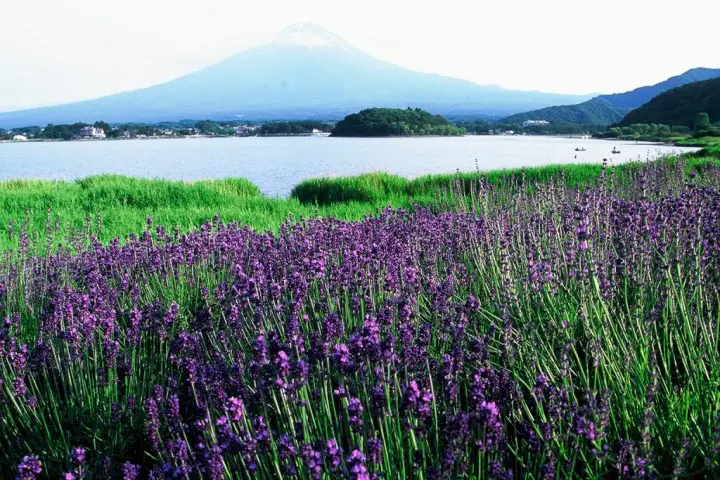
Oishi Park , located a little further towards Lake Saiko, is another popular spot. You can marvel at the view of Mt. Fuji, seen from beyond Lake Kawaguchiko, together with fields of seasonal flowers. The lavenders in particular can be seen going into full bloom (pictured) across the entire field between June to July.
There are many places with great scenery on the northern side of Lake Kawaguchiko. We recommend taking a stroll to find your favorite photo spot.

Kawaguchiko Circular Hall

↑ Return to the top of article.
2. Mt. Fuji Panorama Ropeway
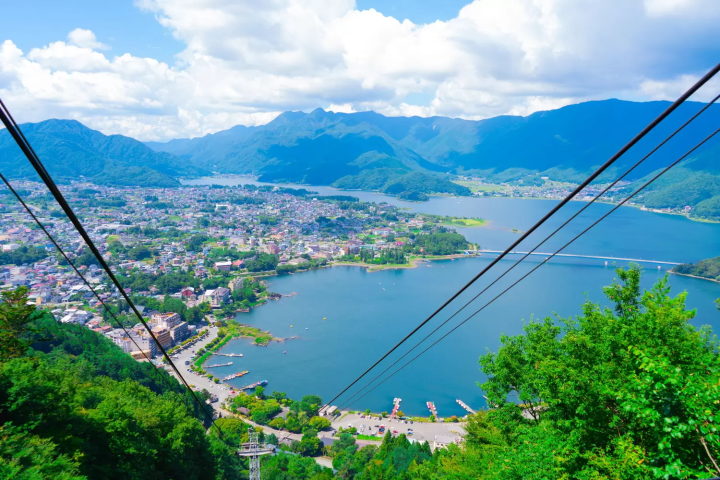
Photo by Pixta
The Mt. Fuji Panorama Ropeway (Japanese) provides a view of Mt. Fuji and Lake Kawaguchiko from a slightly different perspective. The ropeway was previously known as the Kachi Kachi Ropeway. This was because Mt. Tenjo, the mountain peak where the ropeway will take you, is said to be where the Japanese folktale “Kachi Kachi Yama” took place.
Take your time going up the mountain by ropeway, then head to the observation deck on the summit. You can enjoy a large panorama of Mt. Fuji alongside the foot of the mountain. The heart-shaped Bell of Tenjo is another popular photo spot. Feeling tired? We recommend snacking on dango (sweet rice dumplings) or a light meal at Tanuki Chaya Teahouse .

Lake Kawaguchiko Fuji Panorama Ropeway
3. Lake Kawaguchiko Cruise

Picture courtesy of Ensoleille It’s possible to take a cruise boat to enjoy the gorgeous scenery of Mt. Fuji from Lake Kawaguchiko.

Kawaguchiko Pleasure Boat Tensei
4. Music Forest Museum
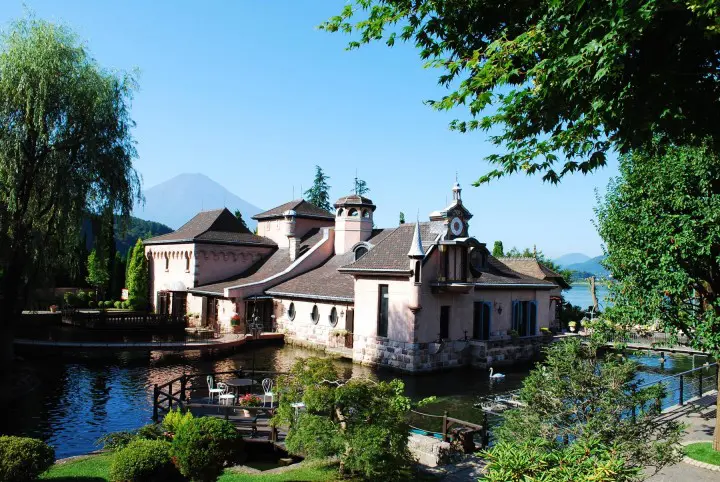
Picture courtesy of Music Forest Museum
The Music Forest Museum is situated in an expansive garden and has eye-catching Western-style architecture.
There are several things to see at this museum. A large music box that supposedly was to be installed on the infamous Titanic is exhibited here. There are also concerts with sand-painting performances , the practice of depicting a story through sand paintings accompanied by music, held three times a day.
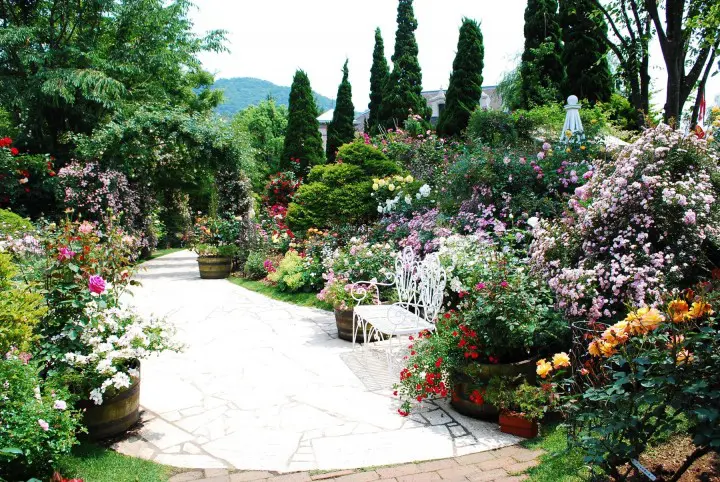
On sunny days, head over to the Rose Garden where you can enjoy roses in a multitude of colors. In June, the best time to see the flowers, you can enjoy up to 720 varieties of roses blooming in profusion.

Kawaguchiko Music Forest Museum
5. Itchiku Kubota Art Museum

Picture courtesy of Itchiku Kubota Art Museum
The Itchiku Kubota Art Museum was awarded three stars in the 2009 Michelin Travel Guide. Artworks and kimonos designed by Itchiku Kubota, a textile-dyeing artist, are exhibited inside splendid Japanese architecture.
Itchiku Kubota is famous for reviving a long-lost dyeing technique called "tsujigahana" with his own unique interpretation and skills. A glass beads gallery, museum shop, and teahouse are also located on the same premises as the museum.

This art museum’s distinct features are not only found inside the museum but also outside where you can enjoy the scenery. The Japanese garden, a collaboration between nature and human ingenuity, changes seasonally in appearance. In particular, autumn mesmerizes those who visit with its magnificent autumn leaves.

Itchiku Kubota Museum

6. Fuji-Q Highland

Fuji-Q Highland is a popular amusement park among youth and young adults from Japan and overseas. Its biggest feature is the array of thrilling attractions! The amusement park is teeming with roller coasters like FUJIYAMA, Takabisha, and Eejanaika—all of which have been recorded in the Guinness World Records for the tallest height, fastest speed, and steepest inclination in no particular order.
Other attractions include a massive maze, a haunted house, and areas like La Ville de Gaspard Et Lisa inspired by a French picture book. Hotels and restaurants are also located near and inside the amusement park. It might be a great idea to make use of these facilities during your visit.
Book the FujiQ Highland Ticket

Fuji-Q Highland

7. Arakurayama Sengen Park and Chureito Pagoda

The Chureito Pagoda in Arakurayama Sengen Park is known as a picturesque view near Lake Kawaguchiko.
Here, you can get a panoramic view of the townscape, five-storied pagoda, and Mt. Fuji’s beautiful figure all from an observation deck located up 398 flights of stairs. The cherry blossom and snowy seasons are immensely popular times to visit.

Arakurayama Sengen Park
8. Narusawa Ice Cave

Narusawa Ice Cave is a cavern that was formed by oozing lava from a volcano that erupted near Mt. Fuji in 864. The average temperature in the cave is 3℃ (37.4°F) and is covered in ice all year round.
The ice pillars inside the cave are especially famous. Depending on the year, the pillars will sometimes reach 50 centimeters in diameter and 3 meters in height.
Narusawa Ice Cave
Local Foods to Try at Lake Kawaguchiko

If you'd like to try food that’s unique to Lake Kawaguchiko, we recommend hoto noodles.
Hoto is a local dish from Yamanashi that consists of wide wheat noodles, pumpkin, and other vegetables simmered in miso (soybean paste) soup. The savoriness of the dashi broth and the sweetness of the vegetables go well together. It has a delicious flavor that will especially hit the spot during the chilly seasons. Restaurants like Houtou Fudou and Koshu Hoto Kosaku are popular options in the Kawaguchiko Station area.
Aside from hoto, there are several other unique foods that are local to the region like Fujizakura Heights Beer. This beer uses spring water sourced from the area surrounding Mt. Fuji.

Suggested Itineraries around Lake Kawaguchiko
Next, we’ll recommend itineraries that include the spots we just introduced. You can hit all the major spots in Lake Kawaguchiko in only one or two days . But if you have the extra time, you should be able to leisurely experience the charms in the area in two nights.
After you’ve arrived at Kawaguchiko Station by highway bus or railway, the first place you should head to is the Mt. Fuji Panorama Ropeway . Gaze at the spectacular scenery, then travel by route bus to have hoto , a Yamanashi specialty, or udon for lunch.
In the afternoon, take it slow by visiting the art museums . Check in early if you’re staying at a hotel with a hot spring or ryokan (traditional Japanese inn) and take your time unwinding from the day.
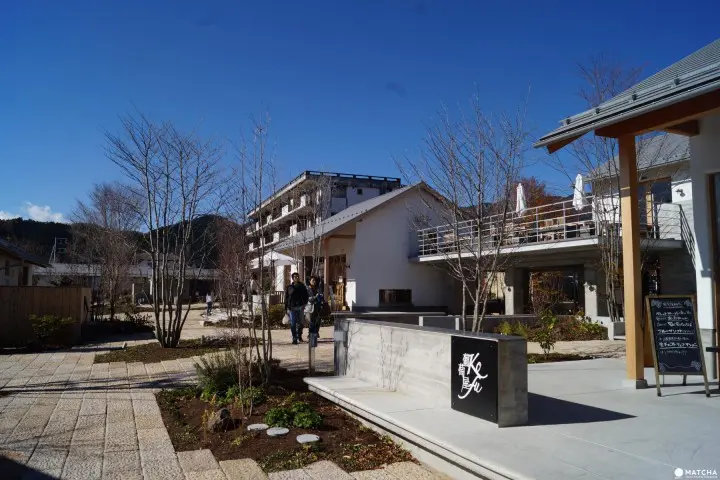
Hana Terrace is a complex with an open view of Mt. Fuji from the lakeside of Lake Kawaguchiko
On the second day, take a walk around Oishi Park . If you’re feeling tired, then take a break at a cafe or enjoy some shopping at Hana Terrace . There are several shops that sell items like trendy Japanese goods and desserts made with Yamanashi fruits. If that doesn’t sound appealing, then another great option is to play hard from the morning at Fuji-Q Highland .
If you’re looking to buy souvenirs, then we recommend the souvenir shops adjacent to Kawaguchiko Station, Fujisan Station, and the Fuji-Q Highland bus stop.
If you’re staying for another night, then how about going out a little further to Lake Saiko to the west of Lake Kawaguchiko or Fujiyoshida ?
Jukai is a nature-rich forest in the Lake Saiko area. Routes and guided tours are available for visitors to fully take in the forest while walking.
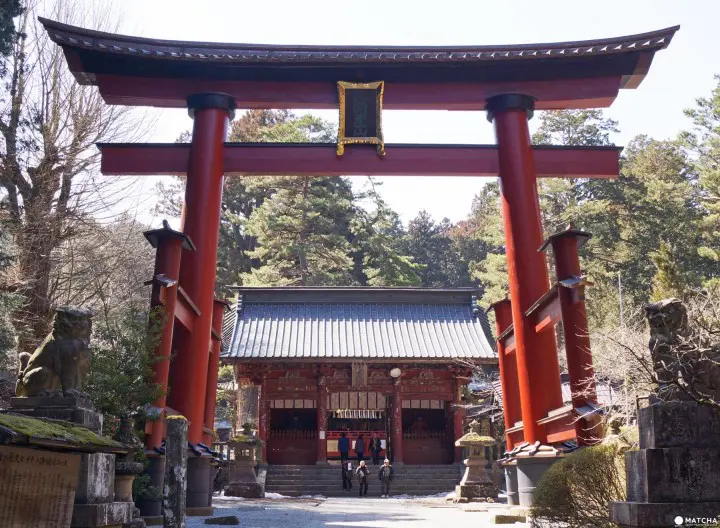
Kitaguchi Hongu Fuji Sengen Shrine doubles as the entrance to the Mt. Fuji trailhead

Seasonal Events at Lake Kawaguchiko
Lastly, we’ll dive into information on events. Various festivities are held in each season during the peak blooms for flowers and autumn leaves.
April: Fuji Kawaguchiko Cherry Blossom Festival

Photo by Pixta The best time to see the cherry blossoms at Lake Kawaguchiko is around mid-April every year.
You’ll find rows of cherry blossom trees along the lakeshore that line the walking trail near Kawaguchiko Enkei Hall. Food stalls are set up along the trail during the festivities for visitors to eat and snack on.
April - May: Fuji Shibazakura Festival

June - July: Herb Festival (Yagizaki Park, Oishi Park)

Lavender flowers reach their peak bloom between June to July at Yagizaki Park (Japanese) and Oishi Park. Both parks are known photo spots where you can admire the magnificent view of Mt. Fuji.
November: Fall Foliage Festival - The Maple Corridor

The autumn leaves turn red slightly earlier than in flatland areas like Tokyo between late October to November. During this time, rows of food stalls are set up near the Maple Corridor on Lake Kawaguchiko’s northern bank and it becomes crowded with people.
By the way, the Lake Kawaguchiko area sits at a high elevation so winters get extremely cold. However, it is thanks to these conditions that you are all the more able to see a breathtaking view of Mt. Fuji. The snow on Mt. Fuji melts between June to September in the summer, so we recommend any other season outside of summer if you want to see a snow-capped Mt. Fuji.
How to Access Lake Kawaguchiko and Ticket Deals
If you are traveling from Tokyo to Lake Kawaguchiko, then you can take the highway bus or train.
Highway Bus
You can get to Kawaguchiko Station by highway bus without any transfers from Shinjuku, Narita Airport, Haneda Airport, Tokyo Station, Shinagawa, Shibuya, or Yokohama. This is most recommended for first-time visitors. If there’s no traffic, then you can arrive at your destination within two hours from Shinjuku or Shinagawa.
Book a Highway Bus now! kosokubus
If you plan to walk around the Lake Kawaguchiko area, then it would be very convenient to use the Kawaguchiko Sightseeing Bus. The Mt. Fuji and Fuji Five Lakes Passport (2-Days) (adults 2,600 yen, children 1,300 yen) is a great option if you want access to unlimited rides and is valid for two days. The pass is sold at the Fujikyu Bus ticket counter in Kawaguchiko Station.
Aside from these deals, there are various other discount tickets available. Please check out the official Fujikyu Bus website (Japanese) for details.
If traveling by train, take the JR Chuo Line to Otsuki Station, then transfer to the Fujikyuko Line to get to Kawaguchiko Station. Total travel time is about three hours from Tokyo Station and costs around 2,700 yen.
The FUJI EXCURSION , a service that connects Shinjuku to Lake Kawaguchiko in an hour and 56 minutes, began its daily morning and night departures in 2019. Are you an international visitor? Then take advantage of JR ride passes like the Japan Rail Pass or the JR TOKYO Wide Pass to get on the train (additional fees will apply for reserved seating).
The Japan Rail Pass and JR TOKYO Wide Pass are very valuable passes to have when traveling around Tokyo or other parts of the country, so please do check them out.
Book the Japan Rail Pass
Book the JR TOKYO Wide Pass
A car is also recommended for traveling to Lake Kawaguchiko. By using the expressway, you can get to Lake Kawaguchiko from Tokyo in about an hour and 30 to 40 minutes.
It would be easier to travel around by car as the Lake Kawaguchiko area does have many sights to see. If you plan to travel long distances with a large party, then it would be cheaper in some cases to rent a car rather than taking the bus or train.
MATCHA offers a 10% discount coupon when renting a car from Nippon Rent-A-Car, a major Japanese car rental company, that is exclusive to international visitors. Be sure to check it out if you’re considering renting a car!
Nippon Rent-A-Car 10% Off Coupon

Shinjuku / Yotsuya
Hotels in the Lake Kawaguchiko Area
The next section introduces our recommended hotels and accommodations for admiring the magnificent scenery of Mt. Fuji and the great outdoors.
PICA Fujiyama
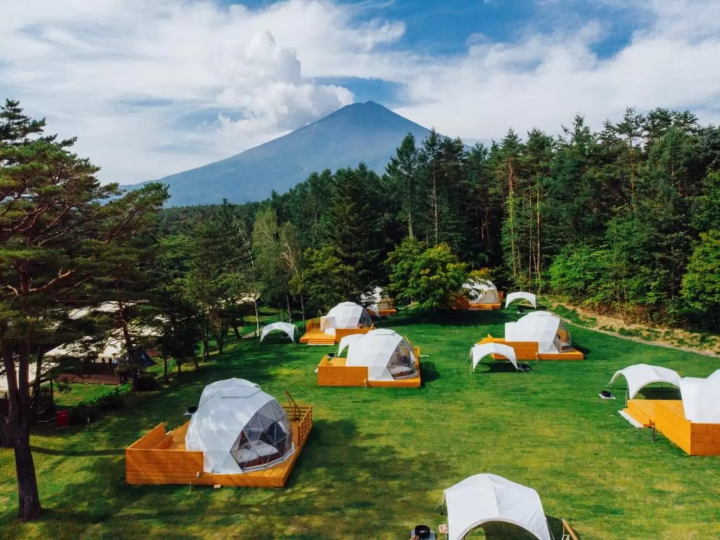
Pictures courtesy of Booking.com PICA Fujiyama is a popular glamping spot near Lake Kawaguchiko. Spend your stay comfortably in a white, elegant half-dome tent that is one with nature.
Book lodging at PICA Fujiyama
Fuji Lake Hotel

Pictures courtesy of Booking.com
Fuji Lake Hotel is an established hotel that opened in 1932. The hotel offers private baths with a view of both Mt. Fuji and Lake Kawaguchiko. There is also a public bath where guests can enjoy a hot spring with water sourced from beneath Mt. Fuji.
Book a room at Fuji Lake Hotel
SUPER HOTEL Fuji Kawaguchiko Natural Hot Spring

If you want to enjoy your stay comfortably at a reasonable price, then we recommend SUPER HOTEL Fuji Kawaguchiko Natural Hot Spring. A stay at the hotel comes with free breakfast and a natural hot spring.
Book a room at SUPER HOTEL Fuji Kawaguchiko Natural Hot Spring
Enjoy Lake Kawaguchiko in Every Season!
This was our list of must-visit spots in Lake Kawaguchiko and how to enjoy them. There are many things to do near Mt. Fuji from appreciating the natural landscapes and fine arts to enjoying the local foods and thrilling attractions, all while being in a convenient to access location from Tokyo.
There are still many more sights and charms to see in the Fuji Five Lakes area, including the nearby Lake Yamanakako and Lake Saiko. Take your time to truly take in the area together with the seasonal scenery.
What's the best way to get to Lake Kawaguchiko from Tokyo?
The most convenient way to travel from Tokyo to Lake Kawaguchiko is by taking a train from Tokyo Station to Otsuki Station via the JR Chuo Line, followed by transferring to the Fujikyu Railway Line to reach Kawaguchiko Station. From there, it's a short walk or bus ride to Lake Kawaguchiko. An alternative option is to consider a direct highway bus from Tokyo to Lake Kawaguchiko, offering a more straightforward journey without transfers.
Is Lake Kawaguchiko worth visiting?
Lake Kawaguchiko is a must-visit destination for its breathtaking views of Mount Fuji and the surrounding scenic beauty, drawing in visitors and photographers alike. This picturesque spot offers a range of outdoor activities such as boat cruises, fishing, cycling, and hiking, allowing guests to immerse themselves in nature's tranquility. The region is also renowned for its hot springs, providing a relaxing retreat, while cultural attractions like museums, art galleries, and temples offer insights into the area's heritage.
Which is better Lake Kawaguchiko or Hakone?
Choosing between Lake Kawaguchiko and Hakone depends on your preferences. Lake Kawaguchiko is ideal for Mount Fuji views, outdoor activities, and relaxation in hot springs, while Hakone is known for its onsens, art spaces like the Hakone Open-Air Museum, and convenient access from Tokyo and Yokohama. Kawaguchiko offers natural beauty and cultural sites, and Hakone focuses on onsens, art, and volcanic landscapes. Choose Kawaguchiko for nature and mountain vistas, or Hakone for a blend of hot springs, art, and cultural exploration in a volcanic setting.
What is Fujikawaguchiko known for?
Fujikawaguchiko near Lake Kawaguchiko is prized for its stunning Mount Fuji vistas, diverse outdoor activities, relaxing hot springs, cultural attractions, and proximity to Mount Fuji, making it an ideal destination for nature lovers, adventurers, and those seeking a rejuvenating retreat with a backdrop of Japan's most iconic peak.
Can you walk around Lake Kawaguchi?
Yes, it is possible to walk around Lake Kawaguchi. The lake has a walking and cycling path that encircles its perimeter, providing visitors with the opportunity to enjoy a leisurely stroll while taking in the scenic views of Mount Fuji and the surrounding landscapes. Walking or cycling around Lake Kawaguchi allows you to appreciate the natural beauty of the area, explore different vantage points, and immerse yourself in the tranquil atmosphere that the lake offers.
Can you use Suica in Kawaguchiko?
Yes, Suica cards are accepted in Kawaguchiko, providing a convenient payment option for travelers using public transportation in the area. This allows visitors to easily access and pay for transportation services using their Suica cards, offering a seamless and efficient way to navigate around Lake Kawaguchi and its surroundings. It's recommended to confirm the current status of Suica card usability in Kawaguchiko before relying on them for transportation payments.

Main image by Pixta
Born in Yamagata Prefecture. I have experience working in community development at the foot of Mt. Fuji and PR for local products across the country, and am currently working in Tokyo to disseminate information about Yamanashi Prefecture. A mother of one who loves local gourmet food and alcohol.
Related topics
Top articles, related article.

Top 45 Cherry Blossom Spots in Japan - 2024 Guide

Tokyo Travel Guide 2024: Top 35 Things to Do

Asakusa Travel Guide: 50 Places to Visit, Dining, Access, and Other Tips

Fuji-Q Highland: The Best Rides, Access From Tokyo, and Tickets

Mt. Fuji Area - 8 Fun Things To See And Do At Lake Yamanakako

Fuji Five Lakes - Enjoy Mt. Fuji, Lake Kawaguchiko, And Lake Yamanakako!

12 Things To Do And See In Yamanashi - Mt. Fuji, Lakes, And Gourmet Dining

From Tokyo Straight To Mt. Fuji! 3 Reasons To Ride The FUJI EXCURSION
Start planning your trip
Special Features

Popular Searches
Latest news.

Showa Kinen Park Flower Festival 2024: Enjoy Nemophila, Tulips, and More!

A Must for Nature Lovers! Win a Free Stay at Unzen Amakusa National Park

A World of Light and Color! Van Gogh Alive in Japan 2024

Cherry Blossom Light-up in Tokyo! Yomiuri Land's Jewellumination

Cherry Blossoms and Sky Lanterns! Aichi Hanami Lights 2024

Japan's Public Holidays and Long Weekends in 2024

Aeon Mall Okinawa Rycom: A Shopping Mall Featuring a Resort Aura

Suica and Pasmo IC Cards: Prepaid Transportation Passes in Japan

Riding Taxis in Japan: The 6 Best Apps to Grab a Cab

How to Travel to Kyoto From Osaka: The Fastest and Cheapest Ways
New articles.

Room Introduction [Maisonette Suite Room with Barrel Sauna]

Nemophila field and yellow train

Golden Week 2024 in Japan: Dates, Events, and Travel Tips

[Yokoze Town, Chichibu District, Saitama Prefecture] Yokoze Carp Streamer Festival 2024 will be held until May 6th

A luxurious tour of Ise-Shima, limited to one group per day
Kawaguchiko Itinerary: Complete 2-Day Itinerary and Must-See Places
快速導覽
Arrange a Kawaguchiko 2-day 1-night itinerary to visit Mount Fuji
I believe that for many people who come to Tokyo to travel, as long as time permits, they will definitely arrange a trip to visit Lake Kawaguchi and Mount Fuji. It may be a trip back and forth to Kawaguchiko Station on the same day, or arrange a two-day one-night itinerary, spend one night staying at the accommodation in Kawaguchiko, so that you have the opportunity to enjoy the sunrise of Mount Fuji and the reflection of Mount Fuji in Kawaguchiko.
However, because there are so many places to visit in the entire Kawaguchiko and Mt. If you plan to arrange a one-day trip to Lake Kawaguchi, or if you want to visit Lake Kawaguchi in depth, and plan to arrange a three-day and two-night itinerary, in Lake Kawaguchi Tourist Information Classification More articles can be found there.
How to arrange the itinerary for Lake Kawaguchi for two days and one night?
If you are starting from Tokyo, Kawaguchiko's itinerary for two days and one night can be very simple. Basically, you only need to buy a round trip to Kawaguchiko Station in Tokyo Fuji tour Tickets, as well as Kawaguchiko tour bus tickets, can solve the transportation budget for the entire Kawaguchiko itinerary.
However, if you plan to combine Lake Kawaguchi, Mt. Fuji, and Hakone into a three-day, two-night itinerary, you may need to purchase the Fuji-Hakone 3-Day Transportation Package , so that you can save more transportation costs in Kawaguchiko and Hakone areas.
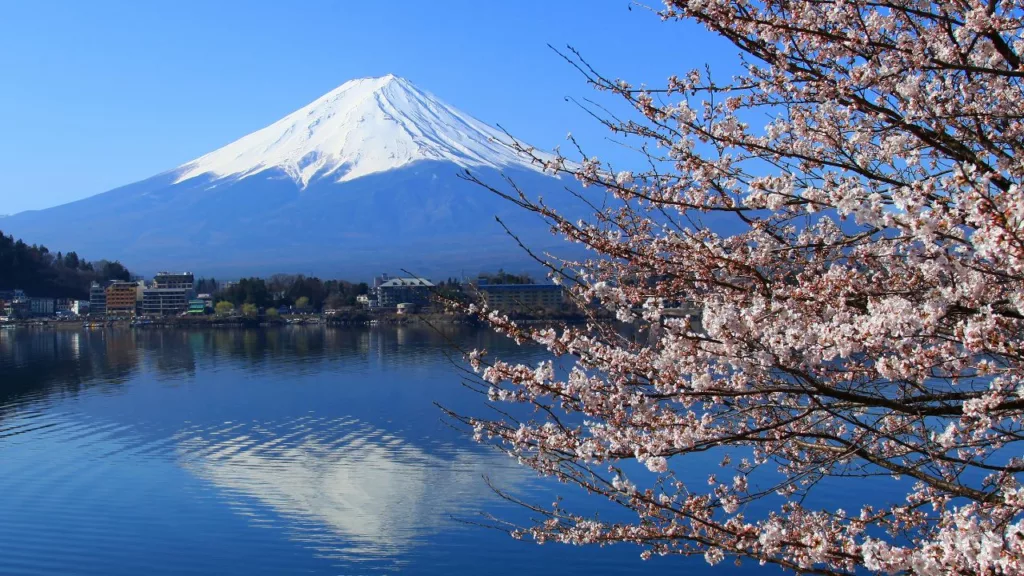
Enjoy the entire Mt. Fuji & Hakone with one set ticket! [Best Offer] Mt. Fuji – Hakone Area 3-Day Tour Pass The best choice to save transportation expenses!
Kawaguchiko two-day one-night itinerary planning from Tokyo
How to store suitcases before departure.
I believe that for many people, one of the most difficult things to deal with in the Kawaguchiko two-day, one-night itinerary is the need to find a place to store suitcases at Kawaguchiko Station and buy time to visit different scenic spots in the Kawaguchiko area.
However, in fact, this problem can also be easily solved. The method is as long as you stay in the same hotel before departure to Kawaguchiko and after returning to Tokyo. In fact, most hotels in Tokyo will provide free luggage storage services. such as Tokyu Stay Shinjuku , APA Hotels in Shinjuku Etc. In this way, it is very easy to start sightseeing in Lake Kawaguchi and Mt. Fuji area, saving extra time and money for handling suitcases.
Itinerary for the first morning
Access to lake kawaguchi.
After you finish checking out of your Tokyo hotel in the morning, you can go to Shinjuku Station and take the limited express train "Fuji Tour", which takes about 2 hours to reach Kawaguchiko Station.
The advantage of choosing to take the Fuji Excursion Limited Express is that you don’t have to worry about traffic jams during the holidays like taking the express bus, which seriously affects the itinerary planning for the whole day in Kawaguchiko. And when you take the limited express train of Fuji Tour, you will have many opportunities to take pictures with Mount Fuji.
Basically, in addition to being a means of transportation connecting Shinjuku Station in Tokyo - Kawaguchiko Station, the limited express train of Fuji Tour is actually one of the attractions of the entire Kawaguchiko itinerary.
However, there are some points that need to be paid attention to when taking the limited express train of Fuji Tour. For example, there are not too many trains departing from Shinjuku Station in Tokyo to Kawaguchiko Station in the morning. On average, there are only 3 sets of trains departing every day. The departure time is about 07:30-09:30, and the journey time also takes 2 hours. If you depart from Shinjuku, Tokyo too late, you may not have enough time to go sightseeing in Lake Kawaguchi.
In addition, the Fuji Excursion Express train is a very popular means of transportation, so if you plan to take the Fuji Excursion Express train to Kawaguchiko Station, you must buy a ticket one day in advance. if you purchased JR Tokyo Wide Area Pass If so, it is also highly recommended to redeem the ticket one day in advance, and buy a ticket for a designated seat if necessary, so as to ensure a smooth departure to Kawaguchiko Station for a two-day, one-night trip.
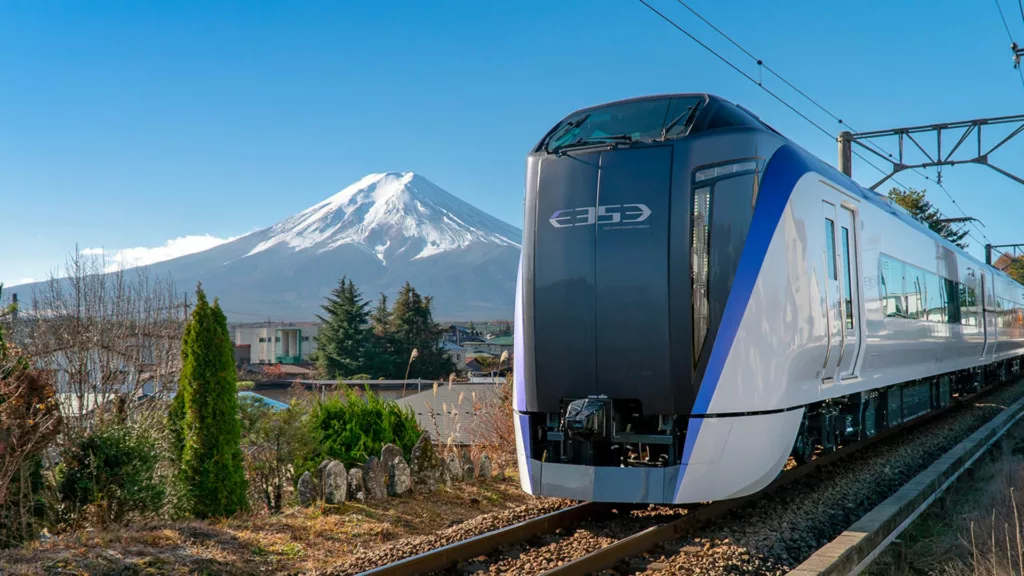
Since it takes 2 hours from Tokyo Shinjuku Station to Kawaguchiko Station, if you depart from Tokyo Shinjuku Station at 07:30, you can arrive at Kawaguchiko Station at about 09:30. If you depart from Tokyo Shinjuku Station at 09:30 , you need to arrive at Kawaguchiko Station at 11:30.
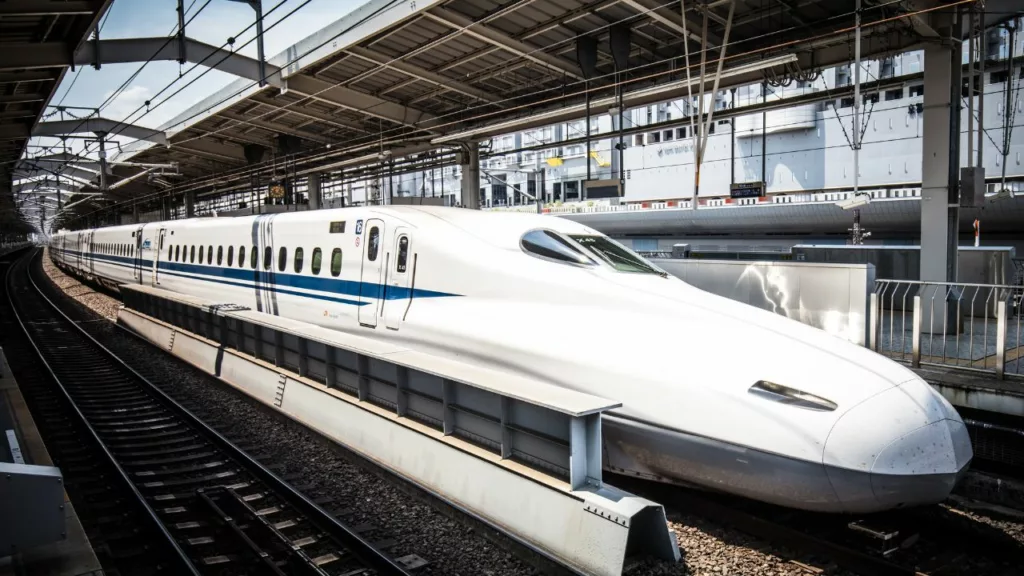
The cheapest way to go sightseeing by Shinkansen? [Best Offer] JR Pass Tokyo Wide Area Pass Unlimited rides on the Shinkansen for 3 days!
Lunch Options in Kawaguchiko
When you arrive at Kawaguchiko Station, you can go to the Fudo Tea House in front of Kawaguchiko Station to have lunch, buy a one-day pass for the Kawaguchiko Tour Bus, and then officially start the two-day, one-night trip to Kawaguchiko.
Itinerary for the afternoon of the first day
When you come to Lake Kawaguchi for a two-day, one-night itinerary, of course you can’t miss the view of Mount Fuji next to Lake Kawaguchi Hot spring hotel , so after lunch, until a few hours before you can check in to the room at the hot spring hotel, you can go to Oishi Park, and Tenjō-Yama Park These two are the most suitable places to take pictures with Mount Fuji.
In addition to setting off to Tianshangshan Park, you can also consider taking Kawaguchiko Excursion Boat Tenharu , starting from Kawaguchiko, passing the Kawaguchiko Bridge, and taking pictures with the reflection of Mount Fuji on the water.
Itinerary for the first night
It is also because one of the key points of the trip to Kawaguchiko is to experience the hot spring hotel next to Kawaguchiko. So at around 16:00 in the afternoon, I left the scenic spot of Kawaguchiko and went to the reserved hot spring hotel room. Get the chance to enjoy hot springs and view Mt. Fuji from your room.
For example, near Lake Kawaguchi Hotel Kaze no Terrace KUKUNA , is a very popular hotel choice that can also enjoy Mount Fuji from the room. Although many people say that the price of this hotel is not cheap, but for some itineraries to celebrate important festivals, being able to face the scenery of Mount Fuji all day is actually the best festival gift .
Itinerary for the next morning
If you plan to enjoy the reflection of Mount Fuji on Lake Kawaguchi, you must grasp the sunrise time of the day. Because only at the moment of sunrise, the reflection of Mount Fuji on Lake Kawaguchi will be the most complete. Generally speaking, the sunrise time of Lake Kawaguchi starts from 04:30 to 06:30, depending on whether you go to Lake Kawaguchi in summer or in winter.
Of course, it will be difficult for many people to get up at 04:30 in the morning, but you can also arrange breakfast at 07:30 in the morning to gain a little more sleep before enjoying breakfast after enjoying the reflection of Mount Fuji.
Around 08:30 in the morning, I believe you have finished the breakfast provided by the hot spring hotel. At this time, you can fight for the last chance to enjoy the hot spring and appreciate Mount Fuji. Then around 10:00 in the morning, it was time to check out.
In the entire Lake Kawaguchi itinerary, being able to slowly appreciate the scenery of Mount Fuji from different angles and at different times is the focus of this two-day, one-night itinerary. So after completing the check-out procedures, you can take pictures with Mount Fuji again before setting off to other Kawaguchiko attractions.
After leaving the hot spring hotel in Kawaguchiko around 11:00 in the morning, you can consider going to Kawaguchiko Music Forest Museum , a scenic spot with a collection of music box exhibitions and Western-style gardens, is also a very suitable place to take pictures and then share them on social media.
However, if you want to go to Mount Fuji for sightseeing, you can return to Kawaguchiko Station first, and then take the bus to the fifth station of Mount Fuji. In this way, you can experience the high-altitude environment at 2400 meters, as well as enjoy the scenery of the entire Kawaguchiko area.
Another option is to visit Fuyue Wind Cave, which is far away from Kawaguchiko Station, but you need to pay attention to the bus schedule connecting Kawaguchiko Station and the opening hours of Fuyue Wind Cave, and try not to leave too late.
Itinerary for the afternoon of the second day
If you choose to go to the Kawaguchiko Music Box Forest Art Museum, you can visit the entire Kawaguchiko Music Box Forest Art Museum in about 2 hours, and then return to Kawaguchiko Station. If you will consider going to Oike Park, Kawaguchiko Herb Museum Over there, you can take pictures with Mt. Fuji again, buy some special products near Kawaguchiko Station, and then take the limited express train Fuji Return to Tokyo.
However, if you choose to visit scenic spots such as Mount Fuji Wumuhe and Fuyue Fengxue, you must pay attention to the timetable of the return bus and calculate when you will return to Tokyo.
Don’t forget that the Fuji Excursion Express train also has a designated departure time, and it takes 2 hours to return to Tokyo by taking the Fuji Excursion Express train from Kawaguchiko. If you return to Kawaguchiko Station too late, you may miss the Fuji Excursion Express train, and You need to take a bus to return to Tokyo, which will also affect your itinerary in Tokyo at night.
Simultaneous departure to Lake Kawaguchi in Hakone two-day one-night itinerary planning
Under normal circumstances, Kawaguchiko's two-day and one-night itinerary will start at Tokyo Shinjuku Station and end at Tokyo Shinjuku Station. However, if you purchase Fuji-Hakone 3-Day Transportation Package If so, this three-day, two-night itinerary can be divided into a two-day, one-night Kawaguchiko itinerary, and a two-day, one-night Hakone itinerary, and experience different hot spring hotels within a few days, as well as from long-distance and close-distance. Enjoy the view of Mount Fuji from different angles.
while using Fuji-Hakone 3-Day Transportation Package The feature is that this package allows you to take unlimited rides on the designated transportation in Kawaguchiko and Hakone, and you can freely choose whether to go to Hakone first or go to Kawaguchiko for sightseeing first, without any restrictions.
To put it simply, you can arrange departure from Shinjuku Station, sightseeing in the Hakone area on the first day, and staying in a hotel in the Hakone area Spa Hotel . Then leave Hakone in the morning and noon of the next day, set off to Kawaguchiko Station and start the trip of Kawaguchiko for two days and one night.
while for the first use Fuji-Hakone 3-Day Transportation Package If you are traveling to Mount Fuji, Lake Kawaguchi, or the Hakone area, you need to pay attention to the fact that it will take a lot of time to travel between Hakone and Lake Kawaguchi. Therefore, when planning the itinerary for the next day, try to avoid arranging to visit too many scenic spots, so that it is easier to manage the schedule of the entire itinerary.
If you are visiting Lake Kawaguchi for the first time, maybe you can consider arranging a trip to visit Lake Kawaguchi and Hakone at the same time. Because compared to simply going to one of Kawaguchiko and Hakone, the itinerary to go to Kawaguchiko and Hakone at the same time can get a better experience in all aspects, and it can also make you remember it many years later. A trip to Mount Fuji and hot springs.
In addition, we are Fuji Hakone Tourist Information Category Here, I have prepared a lot of scenic spot itineraries, accommodation discounts, and ticket discounts for you in Mount Fuji, Lake Kawaguchi, and Hakone. If you are planning to travel to these areas, maybe these articles can help you find some unique experiences. !
More Mt. Fuji and Hakone travel information
Mount Fuji area
Mount Fuji hot spring hotel recommendation: Hotel Room with Hot Spring, Private Bath and Exclusive View on Mount Fuji! Bus Route Guide to Mount Fuji Kawaguchiko Station! JR train from Shinjuku to Kawaguchiko Station? The first choice for railway fans Fuji-Hakone Pass purchase discounts, itinerary planning sharing How to plan the itinerary of Lake Kawaguchi? Attractions, Transportation, Food and Overview The Flower Sea in front of Mt. Fuji Lake Kawaguchi》Annual Lavender Festival ⋯⋯ and MORE
Hakone area
Recommended Hakone Onsen Hotels》A list of high-end hot spring hotels with private baths! How to plan your trip to Hakone? Hakone Attraction Transportation Itinerary Sharing! Fuji-Hakone Pass purchase discounts, itinerary planning sharing Hakone Yumoto Attractions, hot spring hotel selection near the station ⋯⋯ and MORE
More Japan Travel Information: Tokyo | Kyoto | Hokkaido | Climbing Mt.Fuji | Hakone | Lake Kawaguchi Tips for Traveling in Japan | Japan Hotel Deals | Klook Latest Promo Code
Ryu_C@RakuRakuJP
RakuRaku, which is 楽々 in Japanese. This site is committed to providing the most authentic travel information in Japan, bringing you a different Japan travel experience!
Hakone Yumoto Station: Onsen, Shopping Street and Things to Do
Hakone kamakura pass: latest discount and reservation guide, more different travel information, tokyo to kawaguchiko station: complete guide for fuji bus, trains and buying tickets, 10 best ryokan in kawaguchiko with private onsen, kawaguchiko fugaku wind cave & narusawa ice cave" a unique experience of seeing icicles in hot summer, mount kachikachi ropeway in kawaguchiko: best cable car to enjoy mt. fuji, oshino hakkai: reviews, opening hours, transport from kawaguchiko to oshino hakkai, lake kawaguchiko sightseeing boat "appare", kawaguchiko music forest museum: opening hours, review, houtou fudou japanese noodles near kawaguchiko station, kawaguchiko herb festival: enjoy lavender & view of mt. fuji in summer, kawaguchiko herb hall & oike park.
RakuRakuJP , is a website dedicated to sharing articles about in-depth travel experiences in Japan.
I believe that before you travel to Japan every time, you will hope to get the most comprehensive travel information, and then be able to successfully complete the entire travel itinerary.
And our goal is to gather all practical itinerary information, discounted accommodation, and tickets, so that you can plan the entire Japan travel itinerary in the most convenient way.
useful link
- About RakuRakuJP
- RakuRakuJP All Articles
- Privacy Policy
- Website Terms of Use
- Agoda booking offers
- Klook Booking Offer
Editor's Picks
Latest useful travel articles.
©2017- 2024 RakuRakuJP. All Right Reserved.
- Contact us to advertise
- Meet the Team
- Work with Us
- Czech Republic
- Netherlands
- Switzerland
- Scandinavia
- Philippines
- South Korea
- New Zealand
- South Africa
- Budget Travel
- Work & Travel
- The Broke Backpacker Manifesto
- Travel Resources
- How to Travel on $10/day
Home » Asia » Japan » INSIDER Lake Kawaguchiko Itinerary (2024)
INSIDER Lake Kawaguchiko Itinerary (2024)
Hey there, fellow travelers! Today, we’re going to talk about a truly amazing and peaceful place in Japan – Lake Kawaguchiko , where you can enjoy a stunning view of the famous Mount Fuji.
After spending some time in the bustling city of Tokyo, which has a whopping 37.5 million people, I needed a break. So, I decided to head over to Lake Kawaguchiko, and let me tell you, the moment I got off the bus and took in the fresh air and the cool breeze from the lake, I knew I had made the right choice.
During my time here, I had a blast biking around the lake while listening to some tunes and trying not to crash my bike while dancing. I spent days trying to find the absolute BEST view of Mount Fuji and exploring the old traditional towns near the lake.
I can honestly say that my days in Kawaguchiko were incredibly peaceful and some of my favourite whilst backpacking Japan.
There is so much more things to do near Mount Fuji than meets the eye, and I’ve come up with the perfect Lake Kawaguchiko itinerary to guide you upon your visit!
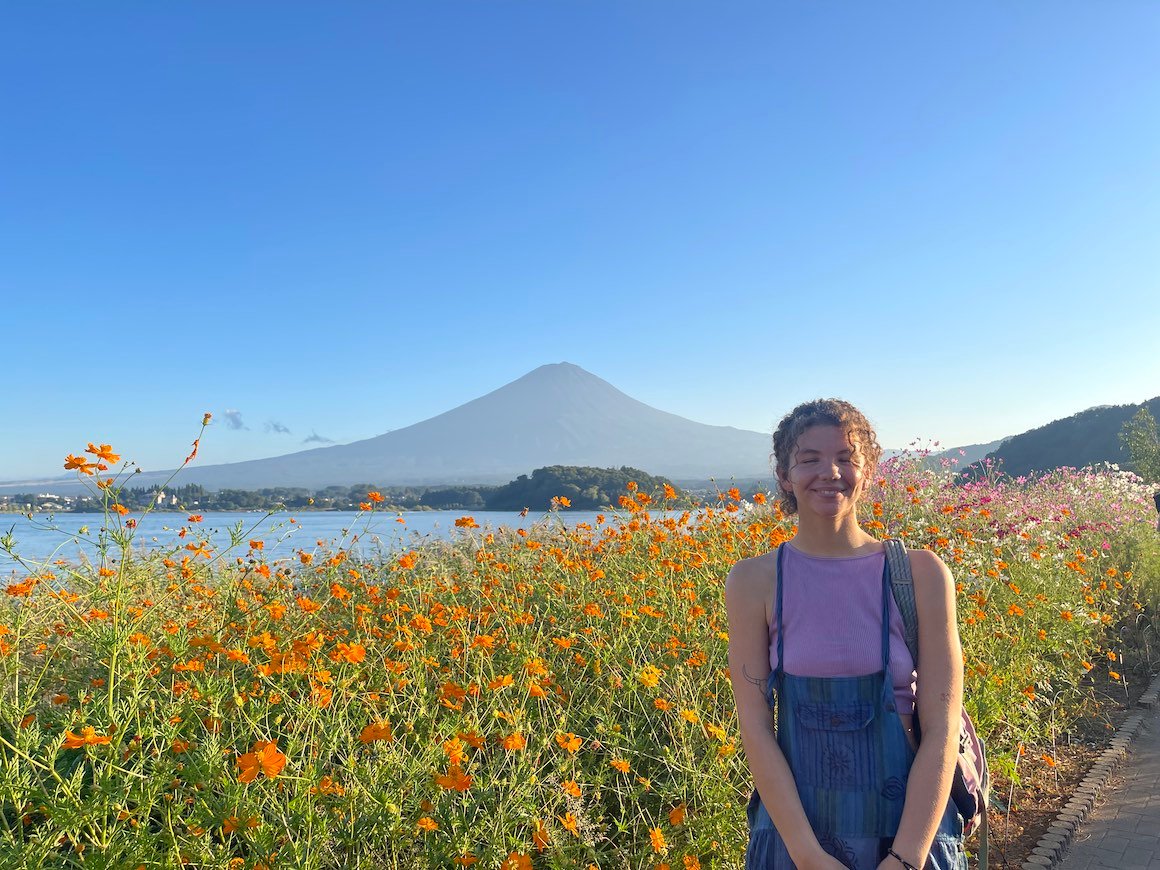
Insights into our Lake Kawaguchiko Itinerary
Getting to lake kawaguchiko, where to stay in lake kawaguchiko, getting around in lake kawaguchiko, lake kawaguchiko day trip itinerary, things to do near mount fuji, best time to visit lake kawaguchiko, what to prepare before visiting lake kawaguchiko, faqs about lake kawaguchiko itinerary, final thoughts on lake kawaguchiko itinerary.
During your backpacking Japan adventure, you’ll find numerous places where you can truly connect with Japanese history and culture. Kawaguchiko was one of my absolute favourites.
Sometimes, you may stumble upon exciting discoveries without even realizing it! Back in the 12th century, Mount Fuji was a hub for Buddhism and Shintoism, meaning there were plenty of temples and shrines around Lake Kawaguchiko. There’s an unmistakable sense of the sacred drifting through the air.
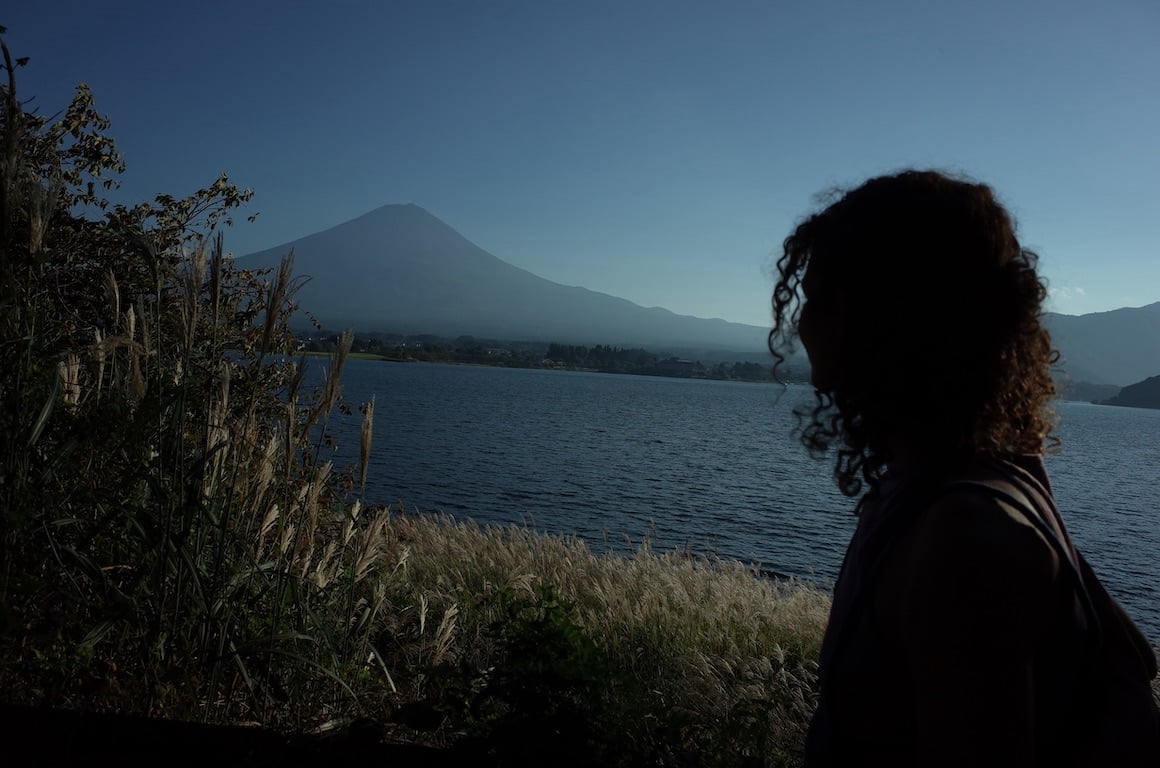
When you gaze at Mount Fuji, it’s hard not to be moved, inspired, and enveloped in tranquility. The mountain stands there so grandly, that it’s impossible not to be impressed. It truly is one of the most beautiful places in Japan .
While there are plenty of incredible spots around Lake Kawaguchiko, there are also hidden gems that let you soak in the town’s energy and Japan’s rich history.
In this article, I’ve put together an EPIC KAWAGUCHIKO DAY TRIP ITINERARY, but think of it as a starting point. Feel free to add your own favorite spots, mix things up, or skip some places if you’re just taking a day trip from Tokyo. There’s a little something in this article for everyone.

Unlock Our GREATEST Travel Secrets!
Sign up for our newsletter and get the best travel tips delivered right to your inbox.
Many people head to Kawaguchiko as a day trip while backpacking in Tokyo , it is a very common route and relatively easy. But it does involve at least 4 hours of travel in a single day.
You can take a bus from Tokyo Station or Shinjuku Station to Kawaguchiko Station. Reservations can be made online at WILLER or Japan Bus Online. This takes about 2-2.5 hours and costs about $13,30 one way.
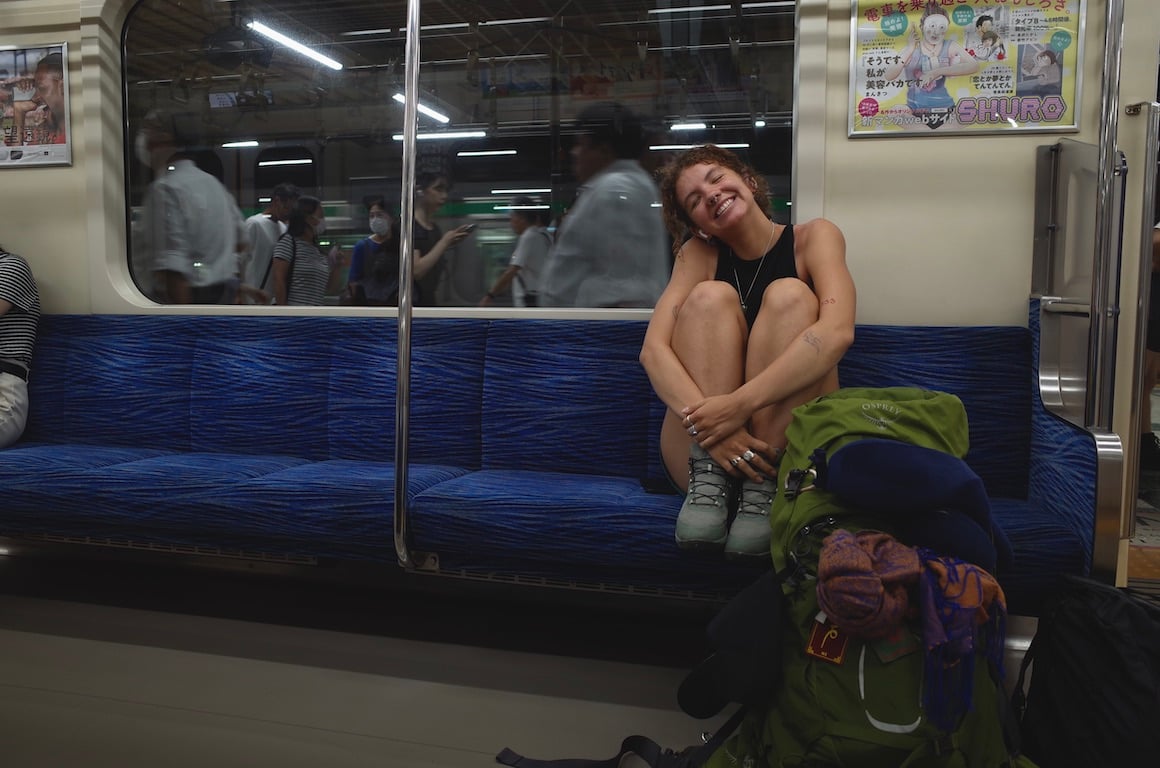
You can reach Lake Kawaguchiko from Tokyo’s Shinjuku Station by taking the JR Chuo Line. There are two main options:
- Direct Limited Express Train : This is the fastest option. The direct limited express train takes approximately 70 minutes to reach Otsuki Station and costs $15.61 for a one-way ticket.
- Local Trains with One Transfer : If you choose local trains, it will take longer, around 100 minutes, and involve one transfer along the way. The cost for this route is approximately $8.86 for a one-way ticket.
Once you arrive at Otsuki Station, you’ll transfer to the Fujikyu Railway Line, which will take you to Kawaguchiko Station. This leg of the journey takes approximately 55 minutes and costs $7.74 for a one-way ticket.
This trip can be done as a day trip from Tokyo, but if you don’t want the extra stress of traveling, stay a night or two and take it easy!
When thinking of where to stay on Mt. Fuji, you’ve got some cool areas to choose from. First up, there’s the Kawaguchiko Onsen area , where you can kick back in traditional Japanese inns, Ryokans, with hot springs (onsens) to soak in while gazing at Mount Fuji – ultimate zen vibes. Japanese Ryokans are always a good bet when you’re thinking of where to stay in Japan.
Then, there’s the Kawaguchiko Station area , perfect if you want to be in the thick of things with easy access to transportation, food spots, and shops.
If you’re more into peaceful lakeside moments, check out Oishi Park up north; people flock here for stunning lake views, chill vibes, and the best ice cream shops in town.
And if you’re the outdoorsy type, Saiko’s got your back, a bit further away, but with campgrounds and guesthouses nestled in nature (I heard great things about Cyokiya Lake Saiko ).
So, whatever your jam, there’s a spot in Lake Kawaguchiko that’ll suit your style. Check out these accommodations and find your next sweet spot!
Best Hotel – Kawaguchiko Hotel
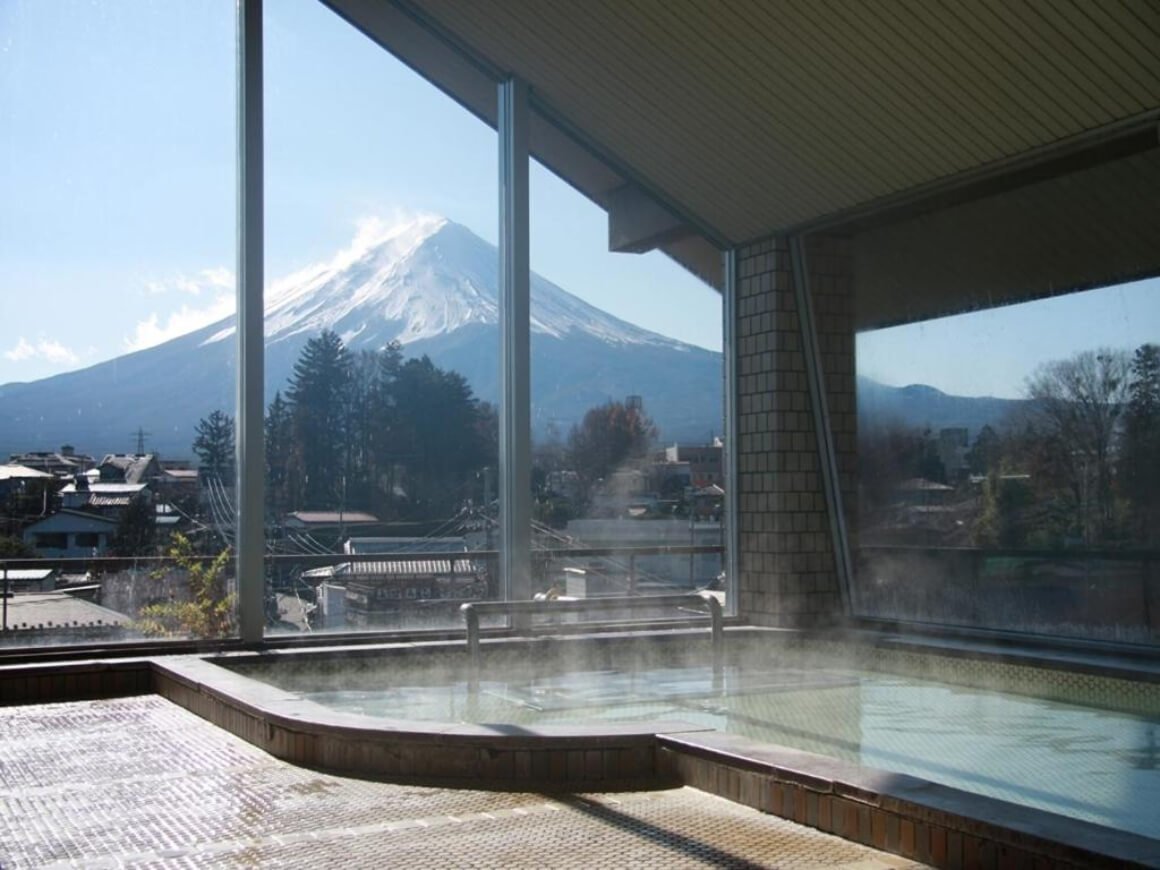
This accommodation is in an ideal location, right next to Lake Kawaguchiko, with modern accommodations in a historic building.
They have free onsens, which are so relaxing after a long day of walking or biking around the lake! You can also choose between Japanese or Western-style rooms!
Best Glamping – Fuji Farm Glamping
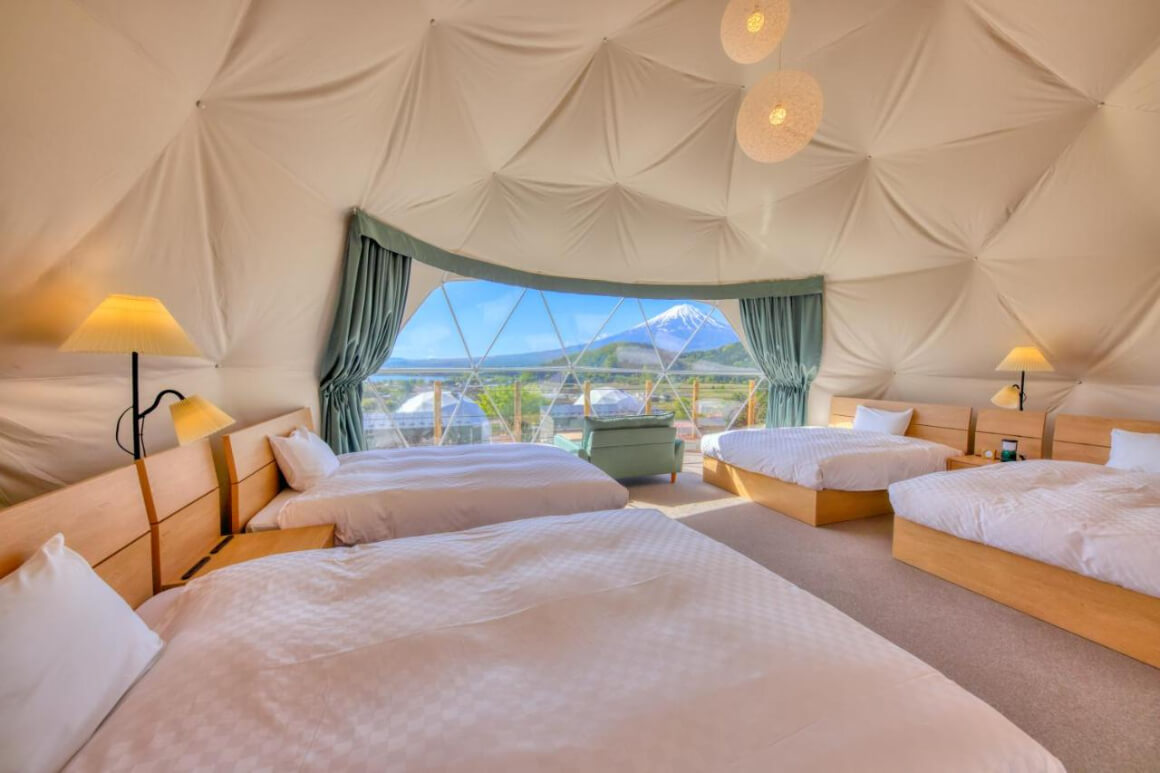
This is a luxurious glamping option if you want to feel the natural vibe while still enjoying the comforts of a normal hotel.
They have mountain-view terraces, free WiFi, and bikes.
Best Guesthouse – Cyokiya Lake Saiko Guesthouse
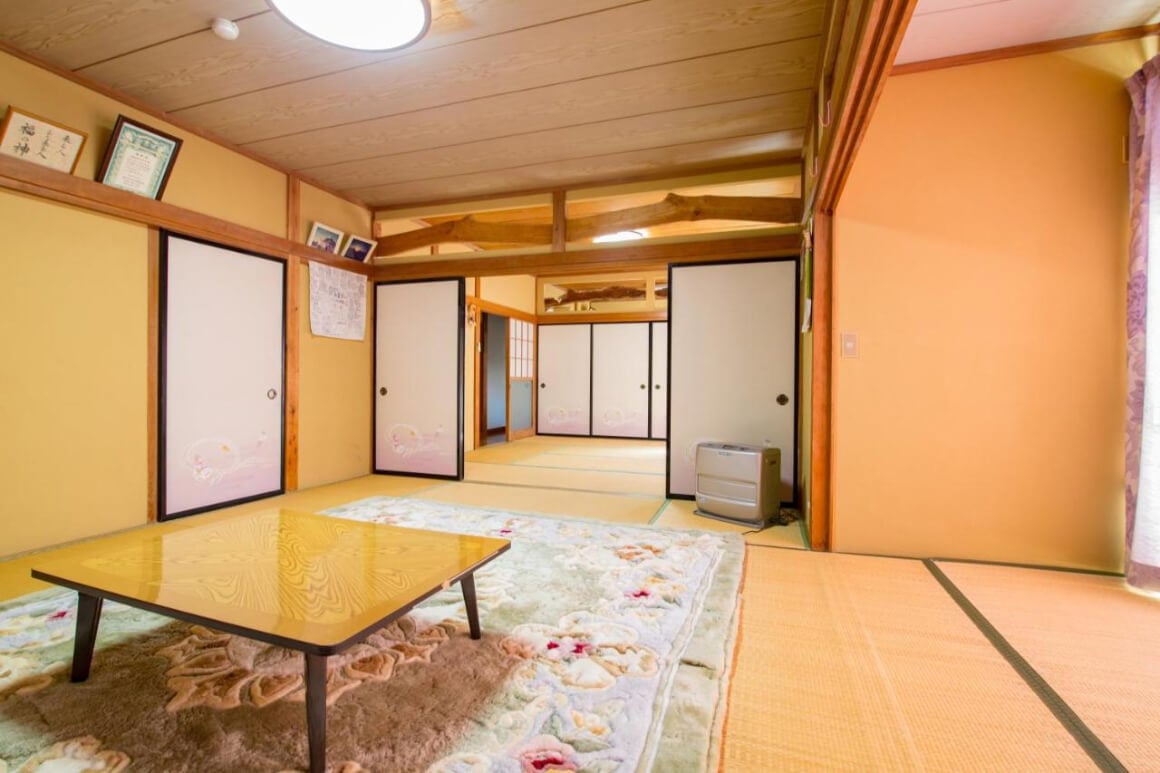
This is a traditional Japanese-style home, where you can have an authentic experience at a good price.
It’s close to the healing village as well as Lake Saiko and Lake Kawaguchiko.
Friendly hosts who make breakfast for you in the morning and help you understand the surrounding areas.
Best Hostel – K’s House Fuji view
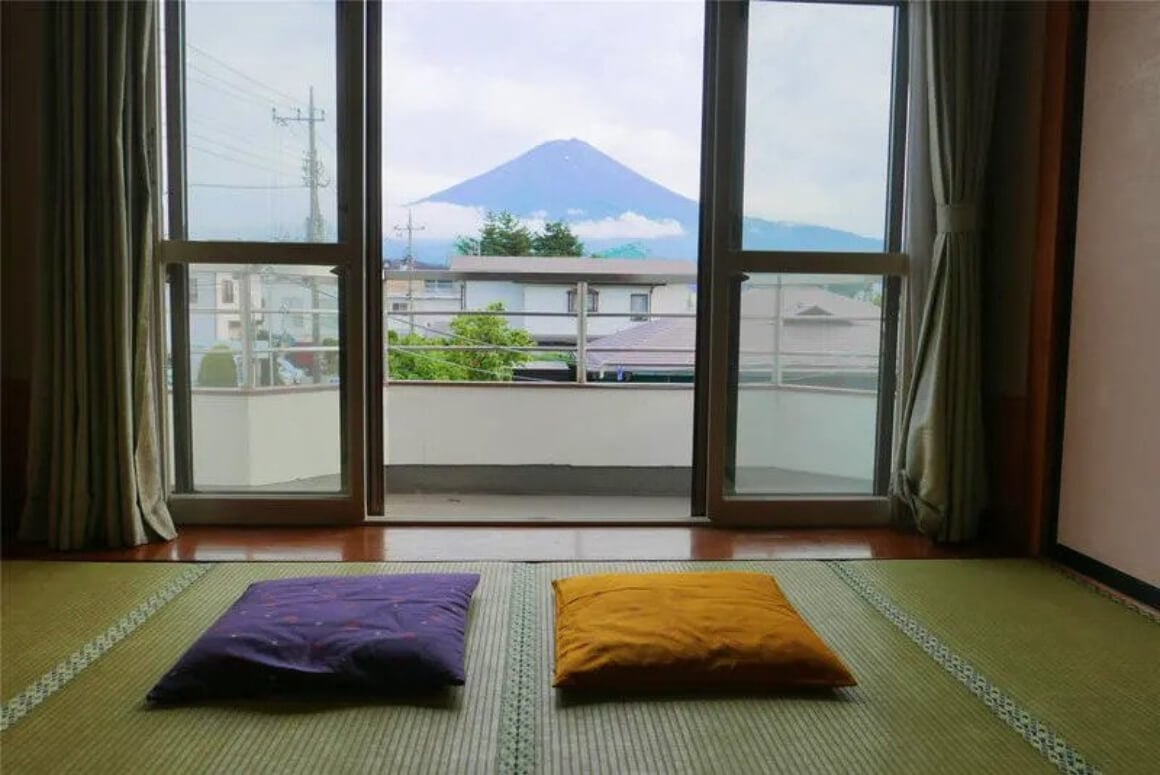
This is one of many K’s House hostels around Japan. It’s an ideal place for solo travelers and backpackers as it has a very friendly and social vibe.
They offer bike rentals by the day and have great hangout spaces.
When it comes to getting around Lake Kawaguchiko, you’ve got a bunch of options to explore this peaceful paradise, and they won’t break the bank.
Renting regular bikes typically costs around 6,61 to $9,92 per day, while electric bikes might set you back around 9,92 to $16,53 per day. It totally depends on the type and duration of rental. Biking around the lake takes about 3 hours, more or less.
K’s House Hostel rented me a bike for $7,94 per day, and I could use it overnight as well. A midnight bike ride under the full moonlight was simply magical. It’s a fantastic way to soak in the sights at your own pace without emptying your wallet.
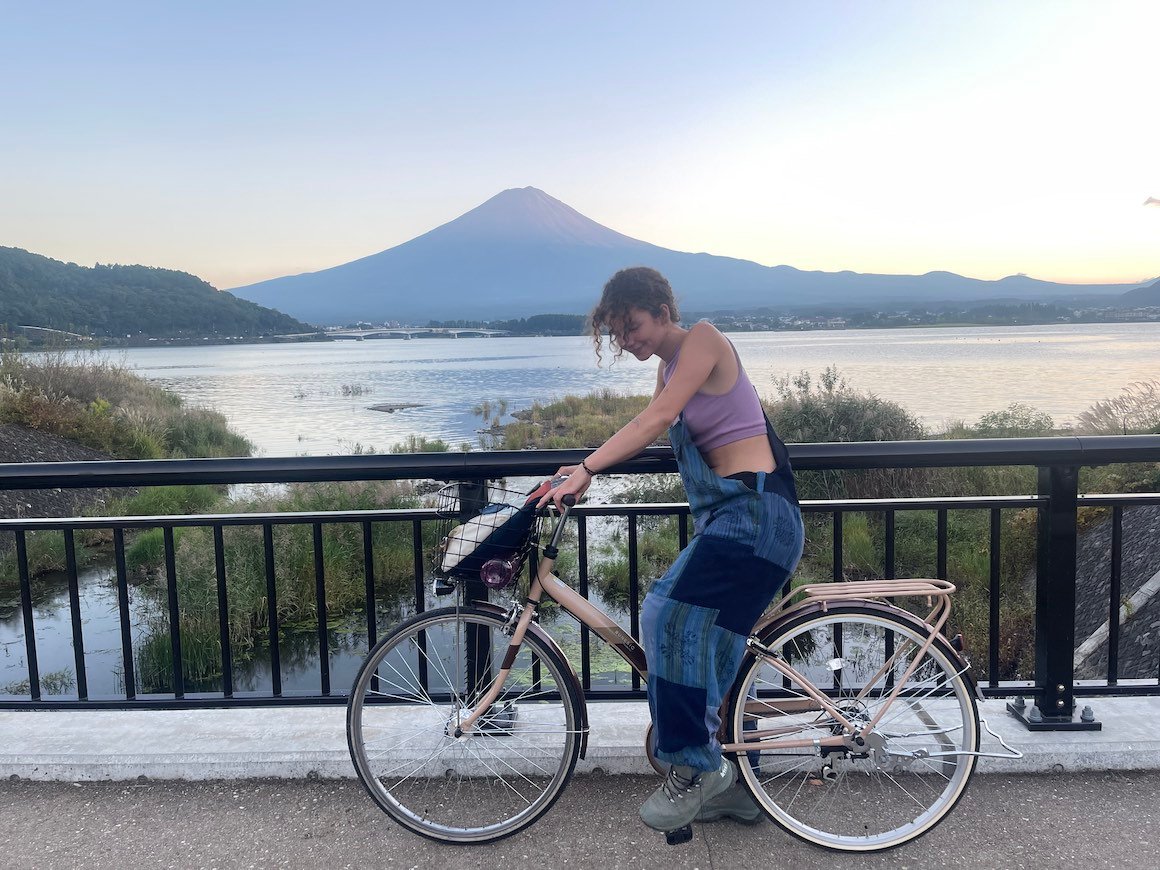
If you prefer a more laid-back approach, hop on the sightseeing bus, usually priced at around 6,61 to 9,92 USD for a day pass.
This convenient option takes you to all the hotspots, including those Insta-worthy Fuji views. The downside of this, though is that you don’t have as much freedom to get lost on a bike on the town’s many backroads and forest paths.
And for those seeking a deeper immersion in the serene beauty of this place, you always have the option to explore on foot. The most budget-friendly way to go, of course!
If you want to do the loop around the entire lake, this is doable on foot, but it’s about 19 km, so pace yourself accordingly!
Start Off the Day on the Panoramic Ropeway
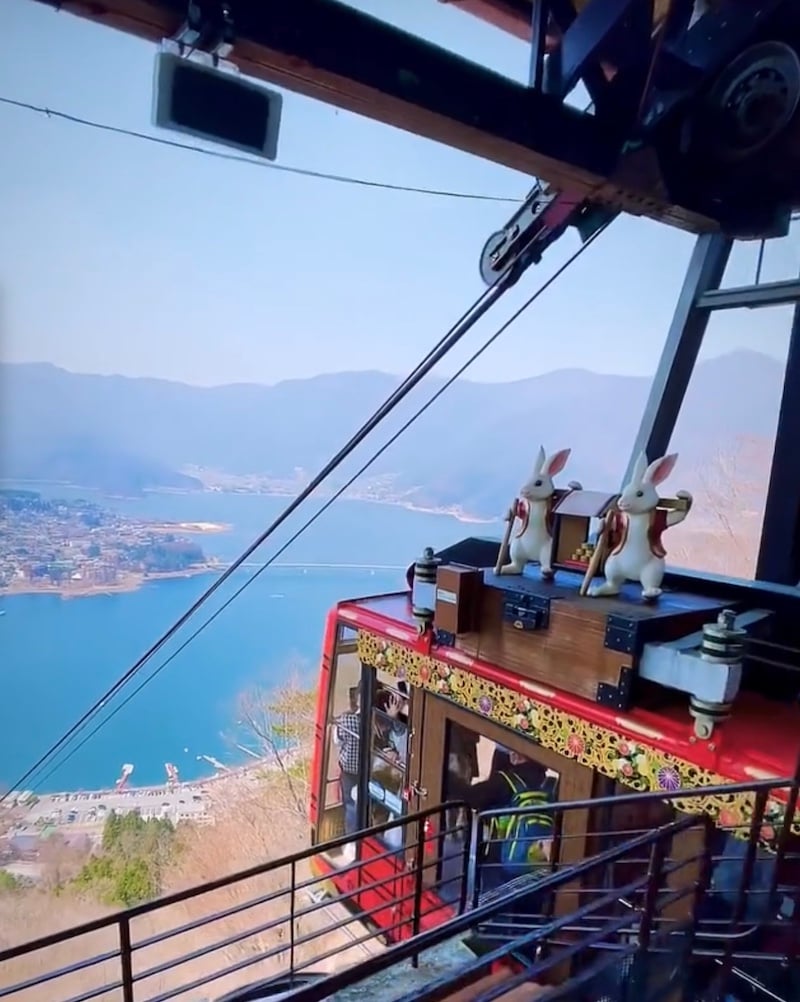
Kick off your Kawaguchiko day trip by by taking a cable car ride to the summit of a 1075-meter-high mountain .
The journey to the mountain’s peak lasts about 3 minutes, but the view from the observation deck is freakin’ amazing.
From up here, you can not only gaze upon the serene beauty of Lake Kawaguchi but also savor incredible vistas of Mount Fuji and the Southern Alps.
Adding to the feeling of being a kid again, this cable car ride also has a touch of literary charm. It was the setting for the Japanese writer Dazai Osamu’s masterpiece, “Kachi Kachi Mountain”.
Decorating the cable cars, you’ll encounter cute (cute = Kawa-ii in Japanese, you’ll hear this a lot!) raccoon, dog, and rabbit decorations. Felt a little like Japanese Disneyland.
Insider Tip: Make sure you go early, as a line forms down the road to get onto the cable car. You don’t want to get stuck waiting in this line, especially in the summer heat or winter cold.
- Cost – $3,31
- How long should you stay – about 30 minutes
Head to the Kawaguchiko Music Forest Museum
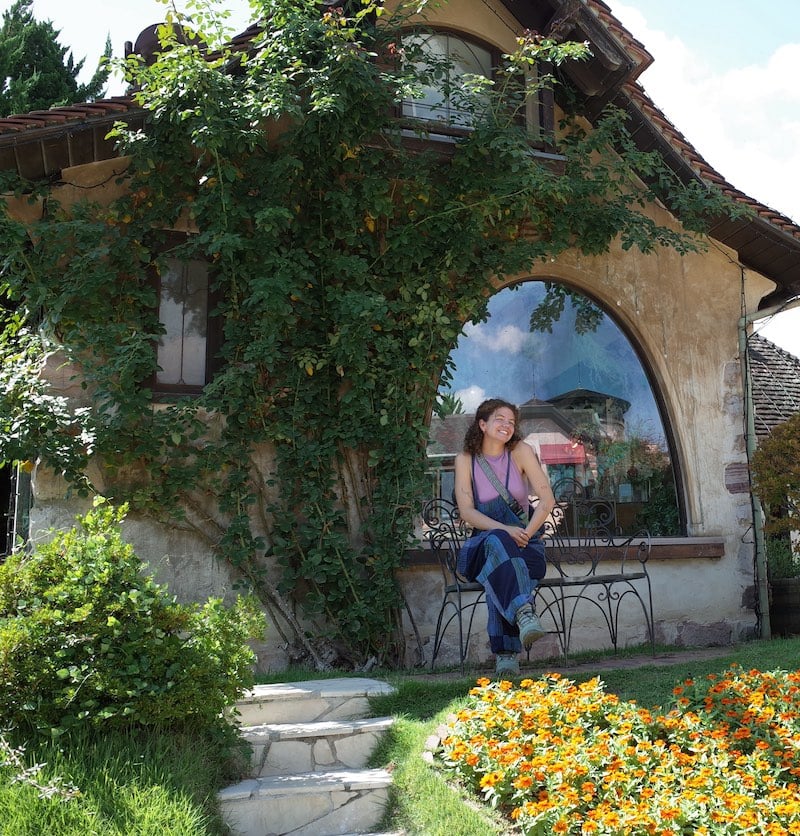
Welcome to the Music Box Forest, a very random gem nestled on the shores of Lake Kawaguchi with the magical Mount Fuji standing proud in the distance.
This place is a cultural fusion! It’s like being in medieval Europe, but with a Japanese tranquility that will make you scratch your head in delightful confusion.
Within the park, you can stroll through a beautiful rose garden, and there’s an opportunity to create your own music box in an on-site workshop!
The Kawaguchiko Music Forest Museum is more than just a museum. It’s a journey through time and sound, a place where music and nature come together to transport you to another world.
Oh, and did I mention the grape juice? Seriously, it’s like nectar from the heavens.
Picture yourself sipping away while the saxophone serenades you and Mount Fuji stands tall in the background. It’s the kind of moment that makes you appreciate the sheer randomness and beauty of travel.
Don’t miss this enchanting and slightly surreal musical escape.
- Cost: $11.92 for adults and $8.61 for students
- How long should you stay – 60-90min
Grab Some Food and Some Photos at Oishi Park
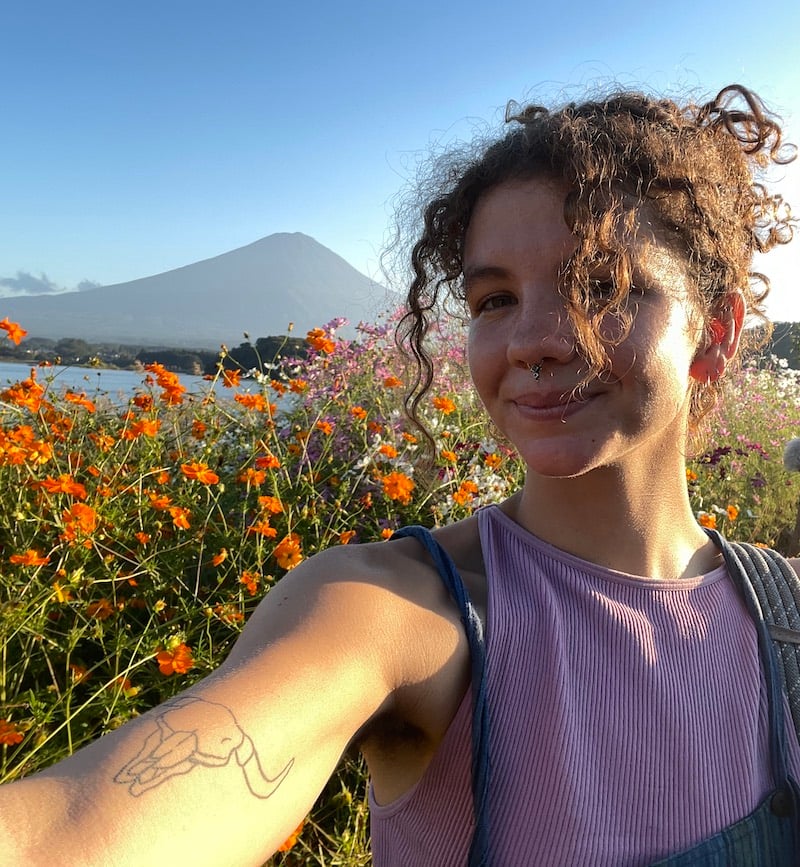
Located on Lake Kawaguchiko’s north side, Oishi Park has some pretty jaw-dropping views of Mount Fuji – it’s like the mountain’s personal portrait studio.
Depending on when you visit, you’ll either catch cherry blossoms in spring, lush greens in summer, fiery foliage in autumn, or a snowy wonderland in winter.
You can take a nice walk along the pathways, chill on benches with perfect views, and witness a massive flower garden in full bloom.
If you’re feeling hungry (which I definitely was after all that bike riding), you can find cute cafes and restaurants with local treats and cool views.
There are also some ice cream shops with local- flavors. Fuji-apple ice cream anyone?
Personally, I grabbed one of the locally grown peaches and some grapes, sat on a bench, and watched some pretty comical influencer photoshoots. So, whether you’re here for a peaceful escape, some killer photos, or just want to hang out with Fuji-san, Oishi Park is where it’s at.
- Cost – It’s Free eee!
- How long should you stay – 1-2 hrs or grab a book and stay the day!

Wanna know how to pack like a pro? Well for a start you need the right gear….
These are packing cubes for the globetrotters and compression sacks for the real adventurers – these babies are a traveller’s best kept secret. They organise yo’ packing and minimise volume too so you can pack MORE.
Or, y’know… you can stick to just chucking it all in your backpack…
Explore the Kubota Itchiku Art Museum
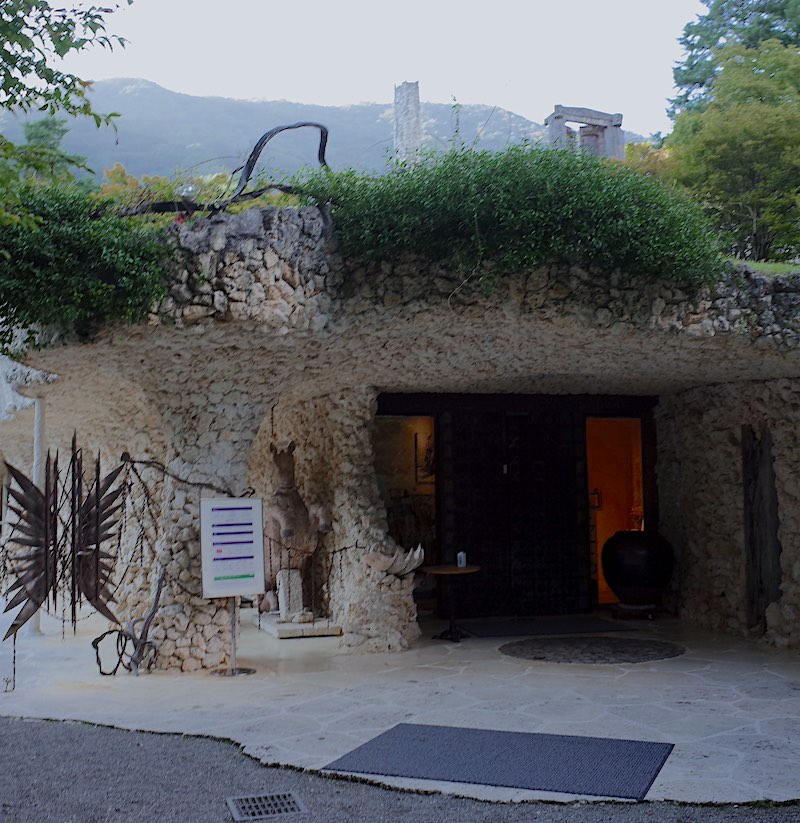
The Kubota Itchiku Art Museum is a tribute to the artistry of Kimono master Itchiku Kubota (1917-2003). This museum showcases Kubota’s creations, where kimonos transcend clothing to become mesmerizing works of art.
His signature “ Itchiku Tsujigahana ” dyeing technique blends tie-dye and ink drawing to craft intricate designs, often inspired by nature and Mount Fuji.
I personally grew up loving to tie-dye, and watching his techniques simply blew me away, and gave me some inspiration to pick up the T-shirts again!
Upon entering, you’ll be taken to a room where you’ll watch a video about his life, his experiences as a war prisoner, and the stories behind his pieces. Make sure you watch the video, as it adds a new layer of depth to the already jaw-dropping pieces.
Besides the stunning kimonos, the museum is an architectural wonder, designed to flow with the earth. You really can’t tell where the garden and forest end and the museum begin.
There is also a gift shop where you can buy handmade silk scarves, glass beads, paintings, and artistry of all sorts. If you’re feeling thirsty, grab a cup of tea in the traditional Japanese tea house.
- Cost – $8.61 for adults and $5.96 for students.
- How long should you stay – 1-2 hrs
Take some photos at the Kawaguchi Asama Shrine
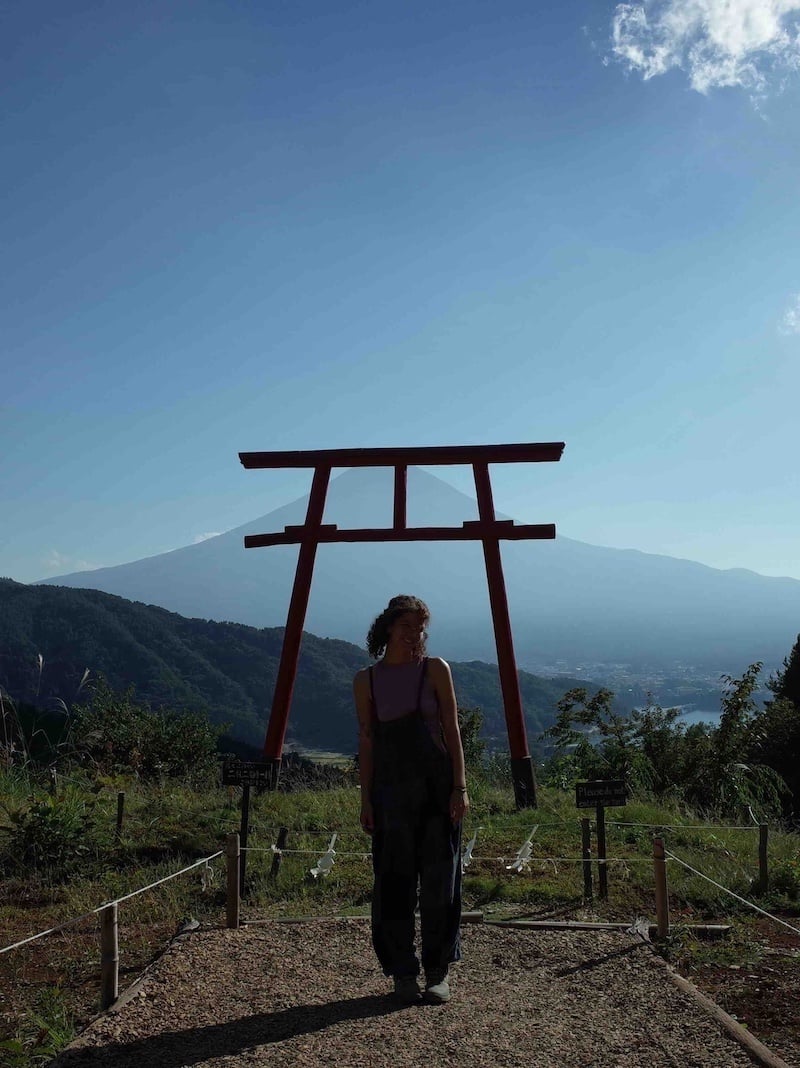
You need a good travel camera for this one. TRUST ME!
Kawaguchi Asama Shrine is a beautiful place to see Mt. Fuji, but it also has a wonderful history.
Across Japan, you’ll find around 1,300 shrines with the name “Asama,” meaning they’re dedicated to the worship of volcanoes.
These shrines pay homage to the Shinto goddess who oversees volcanoes, and Mount Fuji herself. Kawaguchi Asama Shrine is one of these.
Dating all the way back to 865, when it was built to calm the fiery temper of Mount Fuji, this was the year Fuji erupted and created the Five Fuji Lakes.
Now, this shrine is a UNESCO World Heritage Site. Make sure you learn more about Shintoism before you head out on your adventure!
Near the main shrine, you’ll spot seven ancient Japanese cedars, each with a unique name and an insane lifespan of over 1,200 years. I enjoyed meditating here, as you could really feel the energy of this ancient place.
Two of these trees, standing side by side, are famous for being matchmakers. You can grab some good luck charms representing these trees and give them to your friend who’s always swipin’ left & right 😉
You can then hike from the shrine to the Torii gate on top of the mountain (about 20 minutes walking) to take an amazing photo and grab some souvenirs. I loved this photo spot because you had a great view of Fuji without the crowds of other more touristy spots.
There is also a waterfall in the area that you can trek to and take a dip in on a hot summer day.
- Cost – $0.66 to take a photo at the gate
Rent a Lake Kawaguchiko Sunset Swan Paddle Boat
Renting a swan paddle boat is a must-do experience in Kawaguchiko !
Grab a couple of friends from the hostel and challenge them to a paddle across the lake… I promise you’ll have an amazing time. Prices start at around $9.98 for half an hour, making it super affordable.
There are many places offering swan boat rentals along the lake’s coast. The best time to do this is to paddle out at sunset and take in the view as the sky turns vibrant colors and Mt. Fuji turns a beautiful dusk-orange.
If you’re here at the right time, the seasons change the game, from cherry blossoms in spring to fiery foliage in fall. 30 minutes on the boat is more than enough time, as your legs get tired, and you may get a little wet!
- Cost – $9.98 for 30 mins
- How long should you stay – 0.5-1 hrs
Grab some of the famous Hoko Noodles
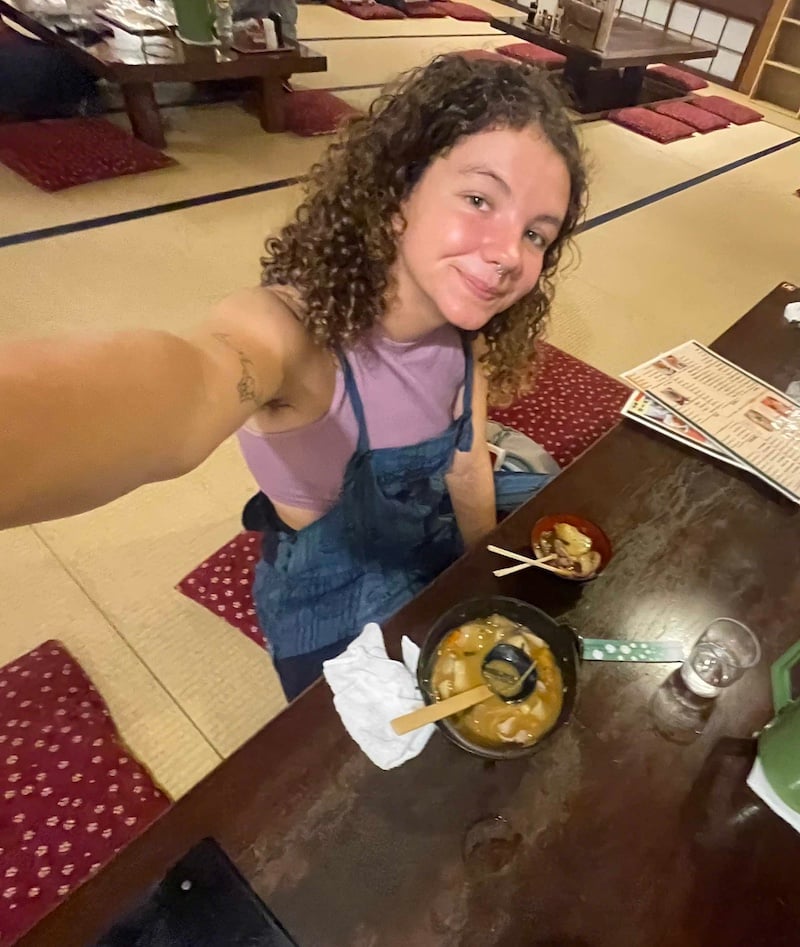
Hoto noodles are a famous dish from this region of Japan. These flat wheat noodles are combined with a thick and flavorful miso-based soup, making it the ultimate comfort food.
What sets hoto noodles apart is their unique shape and texture. Unlike traditional round noodles, hoto noodles are wide and flat, resembling thick strips or dumpling wrappers.
This wide surface area allows them to soak up the rich broth, creating a chewy texture.
When I spoke with the local chef, she said the miso-based broth is the heart and soul of hoto noodles.
It’s typically made with a combination of local miso paste, dashi (fish stock), and seasonal vegetables.
Common ingredients found in this dish include pumpkin, carrots, mushrooms, and some greens. You can choose which meat to add, duck, beef, pork, and sometimes also horse meat.
- Cost – $7.95 on average
- How long should you stay – 1 hr – check out the gift shop!
Spend a Day at One of Japan’s Oldest Villages: Iyashi No Sato
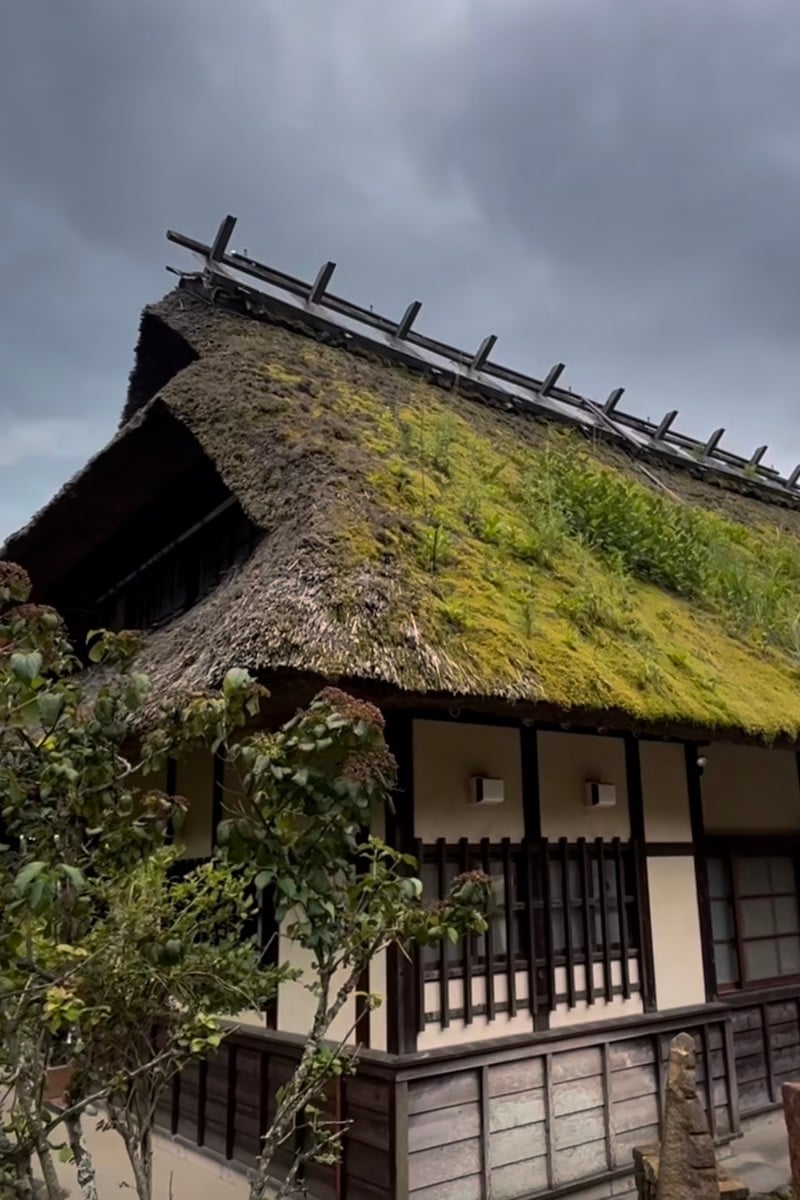
Nestled near Lake Saiko, Iyashi no Sato (which translates to “the healing village”) is literally a trip back in time.
After coming from bustling Tokyo, I desperately wanted to experience traditional Japan and get a taste of what it used to be like. This was the place!
Some of the houses are turned into museums and others offer classes like pottery workshops, making handmade paper, and seeing how they make hand-woven cloth. For an artsy craft lover like me, this was heaven.
And if you’ve ever dreamed of wearing a kimono, you can rent them for $3.31 per day.
When hunger calls, there are three charming local restaurants that serve up authentic dishes like soba noodles, udon, or dumplings.
The backdrop of the surrounding mountains adds an extra layer of serenity to the experience.
- Cost – $2.32 but extra cost varies depending on what you decide to do
- How long should you stay – 2-4 hours
Hike Mt. Fuji
Tackling Mount Fuji, Japan’s iconic volcano, is on every Japanese backpacker’s bucket list. It’s also home to one of Japan’s wonderful national parks . It is no small feat, but with the right planning and a sprinkle of determination, it can be an AMAZING adventure.
First things first, pick the right season. The official climbing season is from July to September when the snow has melted and the trails are accessible.
Start your trek during the afternoon or early evening to time your summit for sunrise. Most hikers take the Yoshida Trail from the 5th Station, which is the most accessible starting point.
As you ascend, be prepared for a variety of terrain – gravel, rocky paths, and even wooden boardwalks in some sections.
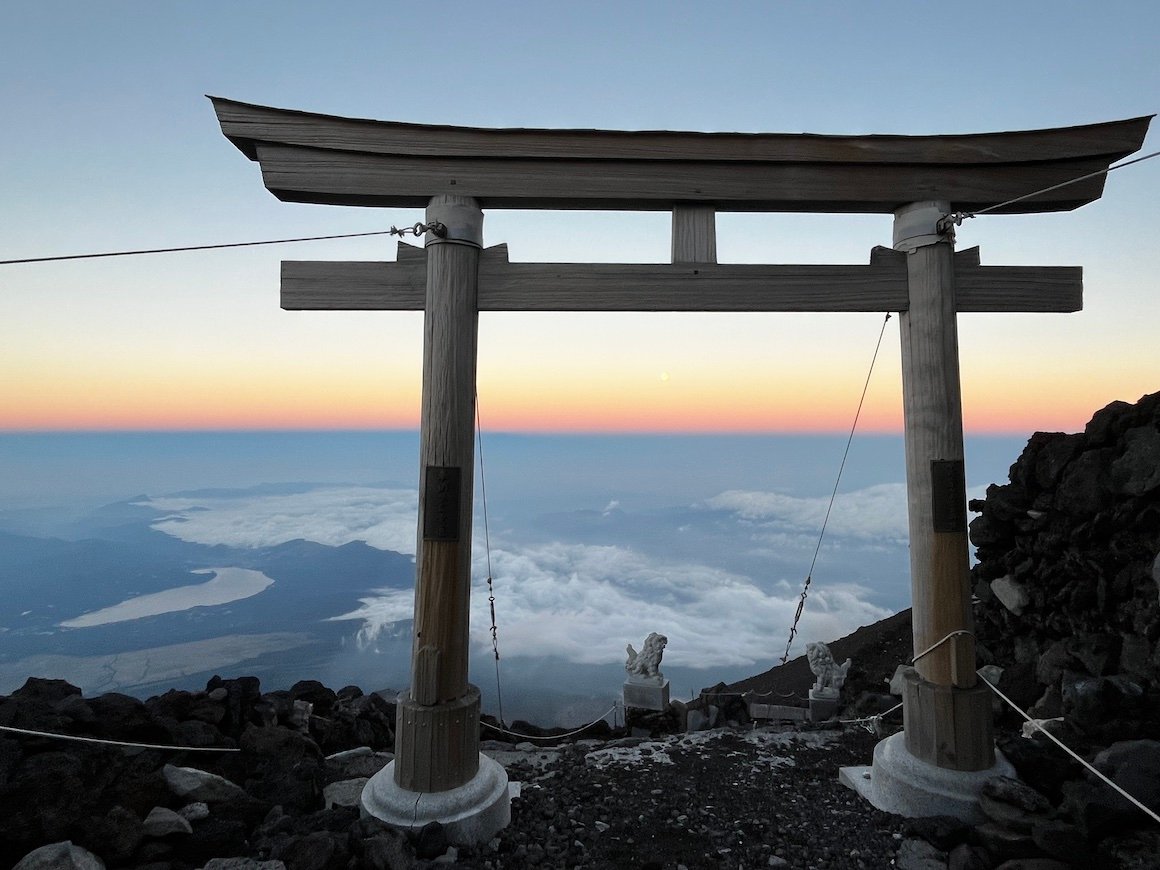
There are ten mountain huts along the way where you can rest, refuel, and even catch some z’s if needed. These huts provide simple meals, hot drinks, and a place to rest, but don’t expect luxury accommodations – it’s all part of the experience.
You can book your Mt. Fuji accommodation and find out more practical info on climbing Fuji-san.
As you inch closer to the summit, the air gets thinner, and you might start feeling the effects of altitude. Take it slow and steady, and don’t be afraid to take breaks. The sight of a breathtaking sunrise from the summit makes every step worth it.
Once you’ve savored the view and snapped a few pictures, it’s time to head back down. Be cautious during the descent, as it can be just as challenging as the ascent. Take your time, especially on the loose scree. Watch your knees and bring a hiking stick if possible!

Stash your cash safely with this money belt. It will keep your valuables safely concealed, no matter where you go.
It looks exactly like a normal belt except for a SECRET interior pocket perfectly designed to hide a wad of cash, a passport photocopy or anything else you may wish to hide. Never get caught with your pants down again! (Unless you want to…)
Fuji-Q Highlands
One of the best things to do near Mount Fuji is to visit Fuji-Q Highland. It’s a renowned amusement park located at the base of Mount Fuji. It is known for its thrilling rides and stunning views of the iconic Mount Fuji.
The park is home to some of the most famous and intense roller coasters in Japan. It features “ Eejanaika ,” a 4D roller coaster that flips riders head over heels, and “ Fujiyama ,” once the tallest and fastest coaster in the world.
In addition to the rides, there are also more family-friendly attractions such as carousels, Ferris wheels, and water rides. It also has dining options, souvenir shops, and entertainment shows.
The best time to visit Lake Kawaguchiko in Japan largely depends on your preferences and what you hope to experience.
Each time of year has its unique appeal , so choose the one that aligns with your interests and expectations for your visit to Lake Kawaguchiko. Just make sure you pack accordingly for each season. Check out our What to Pack for Japan guide for more tips!
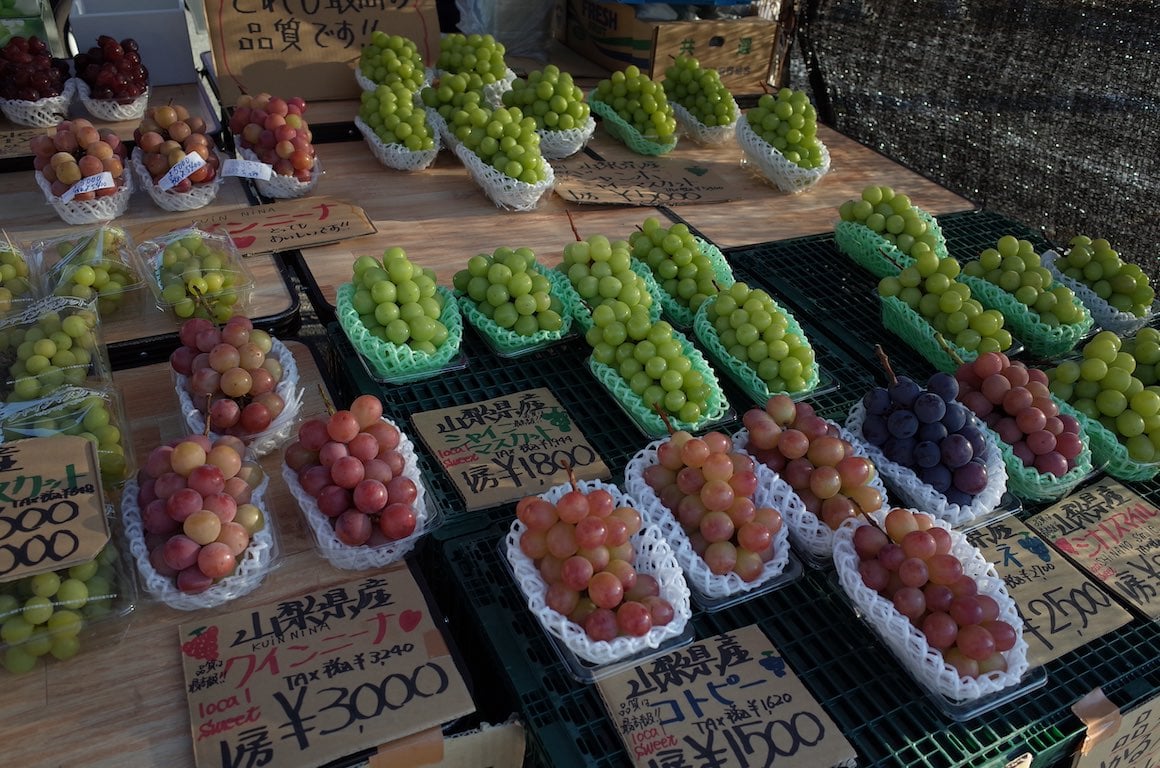
- Spring , from late April to early June, is a fantastic time for cherry blossoms in the area, creating a beautiful scene. The weather is generally mild and pleasant during this season.
- Summer , from June to August, is great for hiking and outdoor activities, with warmer temperatures and lush green surroundings.
- If you want to capture the iconic reflection of Mount Fuji on the lake, early morning and late autumn , from September to November, are your best bets. The crisp autumn air and fewer crowds make it an ideal time for peaceful contemplation.
- Winter , from December to February, offers a unique charm with snowy landscapes and even opportunities for ice skating, but keep in mind that some attractions may be closed during this season.
Coming prepared is one of the most important parts of traveling, no matter where you want to go.
- Bringing good hiking boots is always a must for Kawaguchiko and anywhere in Japan, for that matter, as you’ll be walking A LOT.
- Layer up! It can be scorching in the day and chilly and breezy in the evenings, so make sure you layer up and pack smart.
- Stay safe and sound . Japan is known to be an extremely safe country. However, it’s a good idea to follow some tried-and-true safety tips. As you are likely traveling in a foreign country, ensure you have access to emergency numbers in case of an accident or problem. It’s also always a good idea to have travel insurance in the event of a problem.
To enjoy your Kawaguchiko itinerary to the fullest, keep these Japan travel tips in mind and enjoy safe travels!
Is one day enough at Lake Kawaguchiko?
One day in Kawaguchiko is enough to explore its main attractions and catch a glimpse of Mt. Fuji.
Is Hakone or Lake Kawaguchiko better?
Kawaguchiko hands down, has the BEST Mount Fuji views. On the other hand, Hakone is more convenient to get to Tokyo in regard to transportation.
Can you swim in Lake Kawaguchiko?
No. It’s prohibited to swim in Fuji’s five lakes due to safety .
How long does it take to walk around Kawaguchiko?
It takes around 4 hours and 12 min to walk around the entire lake path.
Don’t Forget Travel Insurance!
Japan is a safe country to visit. But, besides, you can’t plan for everything. Believe me, if things don’t go according to the plan, solid Japan insurance is invaluable.
ALWAYS sort out your backpacker insurance before your trip. There’s plenty to choose from in that department, but a good place to start is Safety Wing .
They offer month-to-month payments, no lock-in contracts, and require absolutely no itineraries: that’s the exact kind of insurance long-term travellers and digital nomads need.

SafetyWing is cheap, easy, and admin-free: just sign up lickety-split so you can get back to it!
Click the button below to learn more about SafetyWing’s setup or read our insider review for the full tasty scoop.
Chances are, when you think of Japan, Mount Fuji pops into your mind – the majestic, snow-capped, and iconic symbol of the land of the rising sun.
Lake Kawaguchiko is a hidden gem in Japan that offers a serene and refreshing escape from the bustling city life of Tokyo. It has the MOST stunning views of Mount Fuji in all of Japan.
You truly can never get bored here, biking, exploring traditional towns, eating apple ice cream, and wandering through intriguing museums.
My time at Lake Kawaguchiko was filled with peace and unforgettable moments, making it one of my favorite experiences during my backpacking journey through Japan.
So, if you’re looking for a place to unwind and connect with nature, don’t miss out on the beauty and serenity that this magical place has to offer.
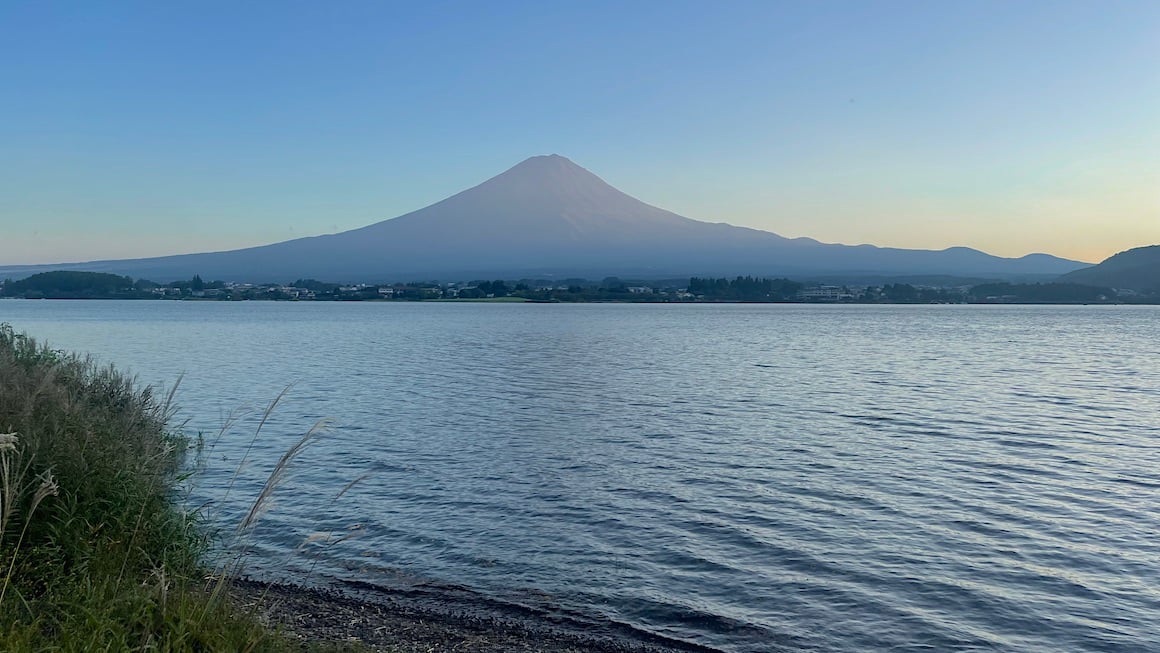
And for transparency’s sake, please know that some of the links in our content are affiliate links . That means that if you book your accommodation, buy your gear, or sort your insurance through our link, we earn a small commission (at no extra cost to you). That said, we only link to the gear we trust and never recommend services we don’t believe are up to scratch. Again, thank you!
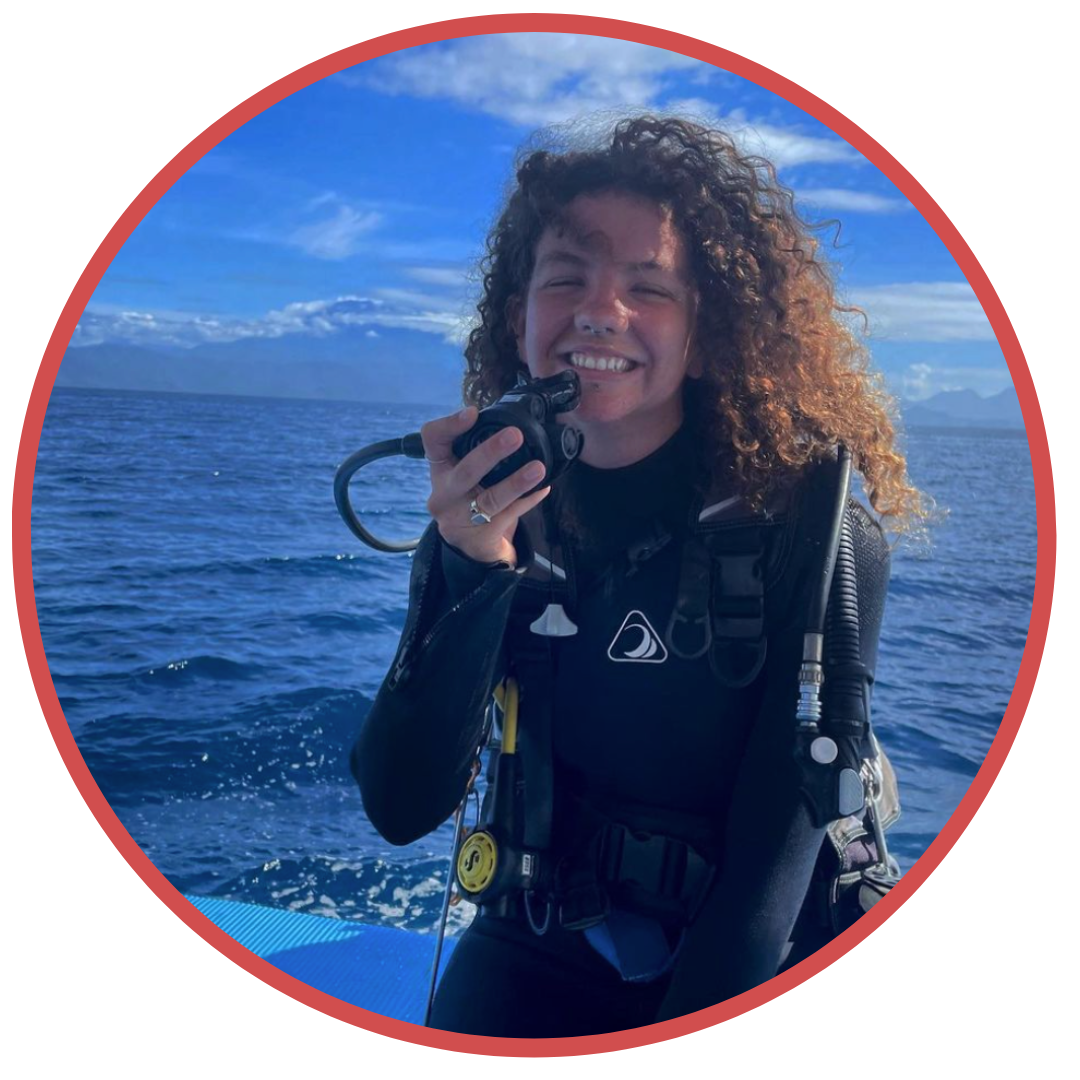
Share or save this post

Leave a Reply Cancel reply
Your email address will not be published. Required fields are marked *
Save my name, email, and website in this browser for the next time I comment.
Notify me of followup comments via e-mail.

19 Best Things to Do in Kawaguchiko | Ultimate Travel Guide
- August 23, 2023
There’s a magical quality to Kawaguchiko that’s hard to put into words.
For me, Kawaguchiko is a place where memories are made and hearts are touched. Where one can witness nature’s masterpieces, this charming town offers experiences that stay with you long after you’ve returned home.
One of the reasons why people visit Kawaguchiko is to see Mt. Fuji in various stunning backdrops so be forewarned that you’ll be seeing a lot the old majestic mountain throughout this post.
In this guide to Kawaguchiko, I want to share with you not just a list of activities but also the emotions and sensations that you too can experience.
From the changing season that paint the region in different hues to the simple joy of a lakeside walk, these are the moments that define a trip to Kawaguchiko.
So what are you waiting for?
Table of Contents
What to Know About Kawaguchiko
Kawaguchiko, or Lake Kawaguchi, is part of the scenic Fuji Five Lakes region, located at the base of Mt. Fuji , Japan’s iconic and highest peak. The lake’s origin is geological, formed by the lava flow from Mt. Fuji’s multiple eruptions over the millennia.
The area around Kawaguchiko has been a place of inspiration for centuries. Early historical records depict pilgrims making their way to Mt. Fuji, often stopping at Kawaguchiko to admire the breathtaking reflection of the mountain in the lake’s calm waters. Which is quite similar to the scenery found in Sayama and Hakone !
The landscape around Kawaguchiko was also a favored subject for ukiyo-e artists, like Hokusai and Hiroshige, who captured the beauty of Mt. Fuji from various viewpoints.
Best Places to Visit in Kawaguchiko
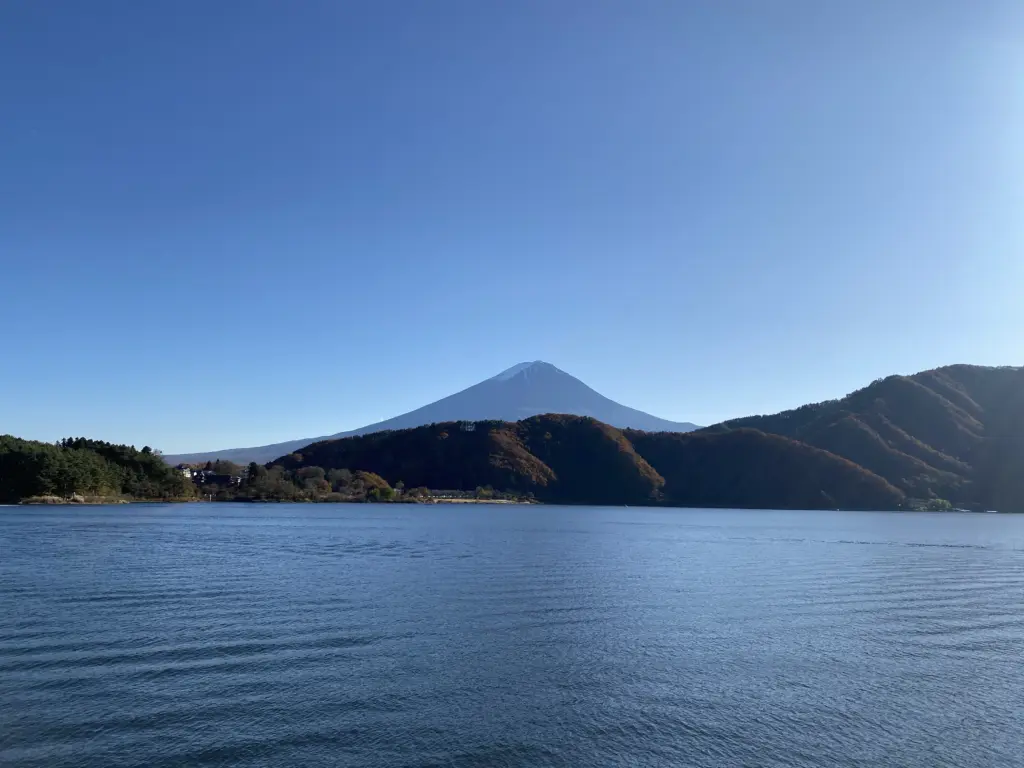
1. Lake Kawaguchi
Lake Kawaguchi is the largest and arguably the most famous of the Fuji Five Lakes.
With a surface area of approximately 15.8 square km (6.1 sq m) and a depth reaching up to 44 m (144 ft), it offers one of the best views of Mt. Fuji. People flock to its shores to capture photographs of Mt. Fuji’s reflection in the water.
The surroundings of Lake Kawaguchi are marked by beauty and seasonal changes. In the spring, cherry blossoms bloom along the lake’s shores, while autumn sees the area enveloped in rich, fiery colors.
It’s a scene that constantly evolves, offering something new with each passing season.
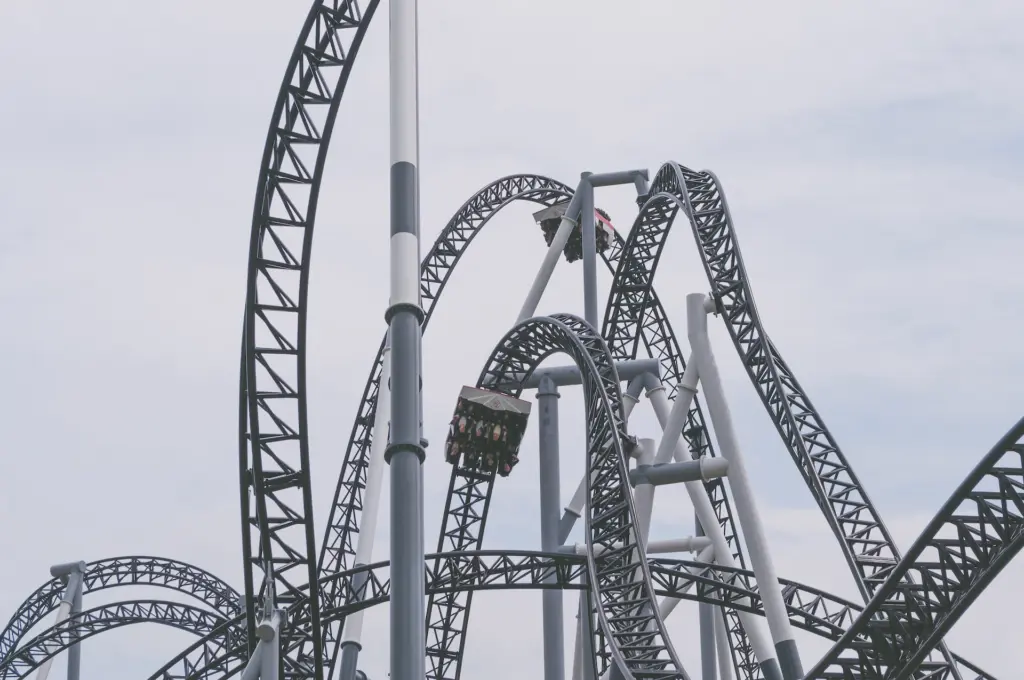
2. Fuji-Q Highland
In for a thrill? Fuji-Q Highland is an exhilarating amusement park that hosts four major roller coasters that will definitely put your bravery to the test.
Fujiyama, once the world’s tallest roller coaster, offers an impressive 79-meter height and reaches speeds of 130 km/h.
Dodonpa is known for its intense acceleration, going from 0 to 180 km/h in just 1.56 seconds.
Eejanaika is a unique 4D coaster that rotates riders a full 360 degrees, while Takabisha holds the record for the steepest drop in the world at 121 degrees!
In addition to its thrill rides, Fuji-Q Highland caters to fans of popular anime, including “Evangelion” and “Attack on Titan,” with themed attractions and interactive exhibits. There are also gentle rides kids so there’s something for everyone!
Click the link to get your 1-Day Pass Ticket for Fuji-Q Highland if you’re keen on trying out the monster rides.
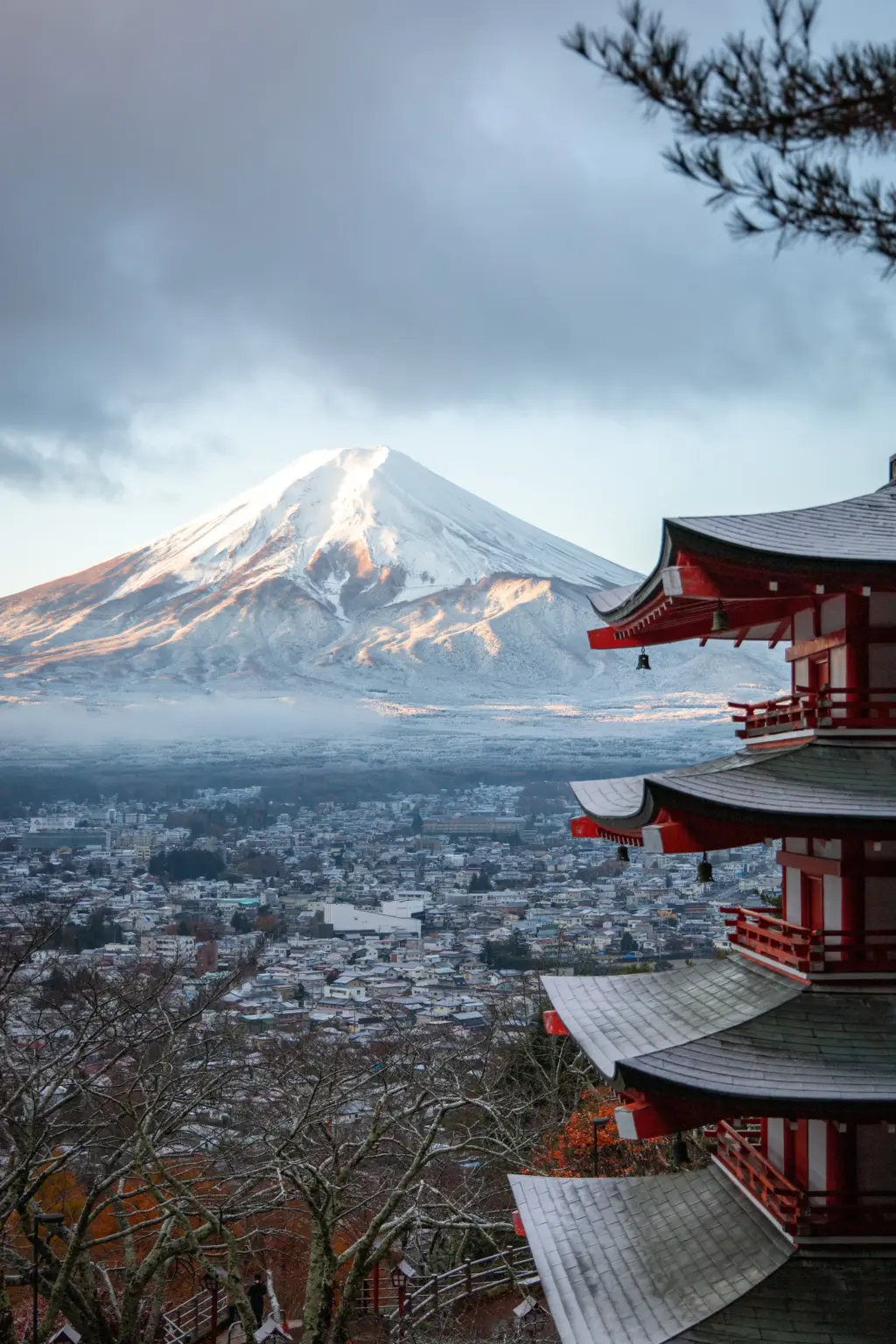
3. Arakurayama Sengen Park
Arakurayama Sengen Park is home to the Chureito Pagoda, a five-storied pagoda that was built as a peace memorial in 1963.
It is part of the Arakura Sengen Shrine complex, a Shinto shrine dedicated to the worship of Mt. Fuji, and it offers one of the most iconic views of Mt. Fuji, particularly during the cherry blossom season when over 600 cherry trees bloom around the pagoda, or during the autumn when the leaves change colors.
It has become one of the most photographed spots in Japan , and I’m sure everyone has seen that shot at one point whether it’s on a post-card or a cover of a magazine.
Reaching the Chureito Pagoda requires a climb of 398 steep steps, but the reward is a view that captures the essence of Japan.
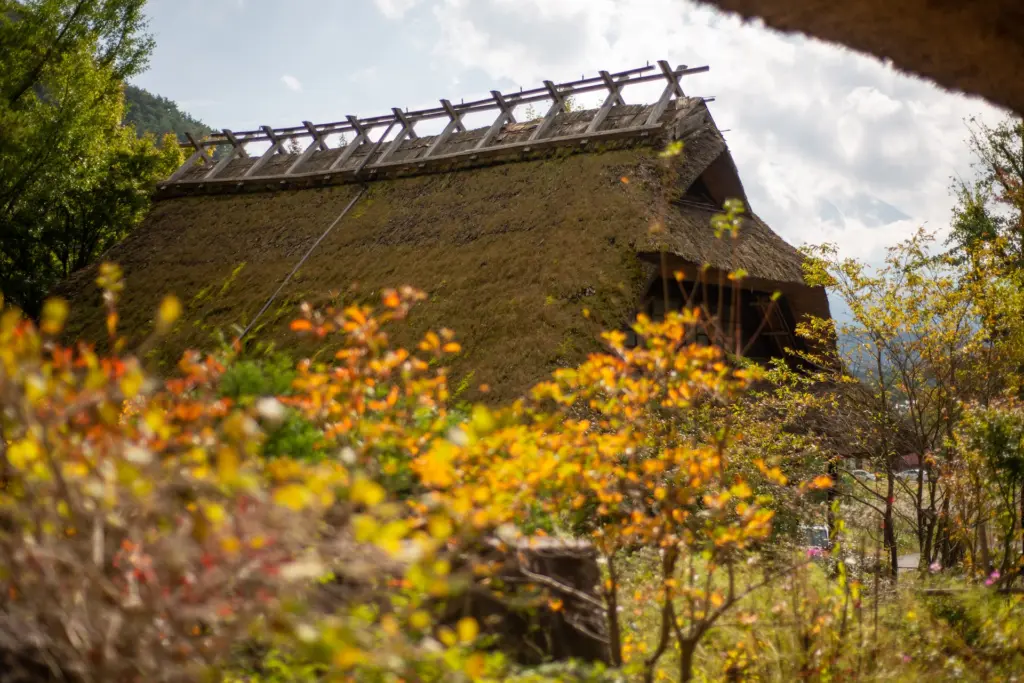
4. Saiko Iyashi-no-Sato Nenba
Saiko Iyashi-no-Sato Nenba is a picturesque open-air museum located on the banks of Lake Saiko, another one of the Fuji Five Lakes.
This charming village offers an incredible insight into traditional Japanese culture, as well as the stunning natural beauty of the area.
Originally, Saiko Iyashi-no-Sato Nenba was a farming village until it was destroyed by a typhoon in 1966.
In an effort to preserve the cultural heritage, it was reconstructed into a museum that showcases over 20 traditional thatched-roof houses.
Within these historical structures, various workshops are conducted, allowing you to dive into the world of traditional Japanese arts and crafts. From pottery and indigo dyeing to weaving and papermaking, you have the opportunity to learn and create with the guidance of expert artisans.
Furthermore, the village itself is designed as a living exhibit, as you’ll find gardens with native plants, koi ponds, and stone pathways that add to the calming atmosphere.
A walk through the village can feel like stepping back in time, allowing you to appreciate the slow and careful life that once dominated this region.
Cost: 500 JPY
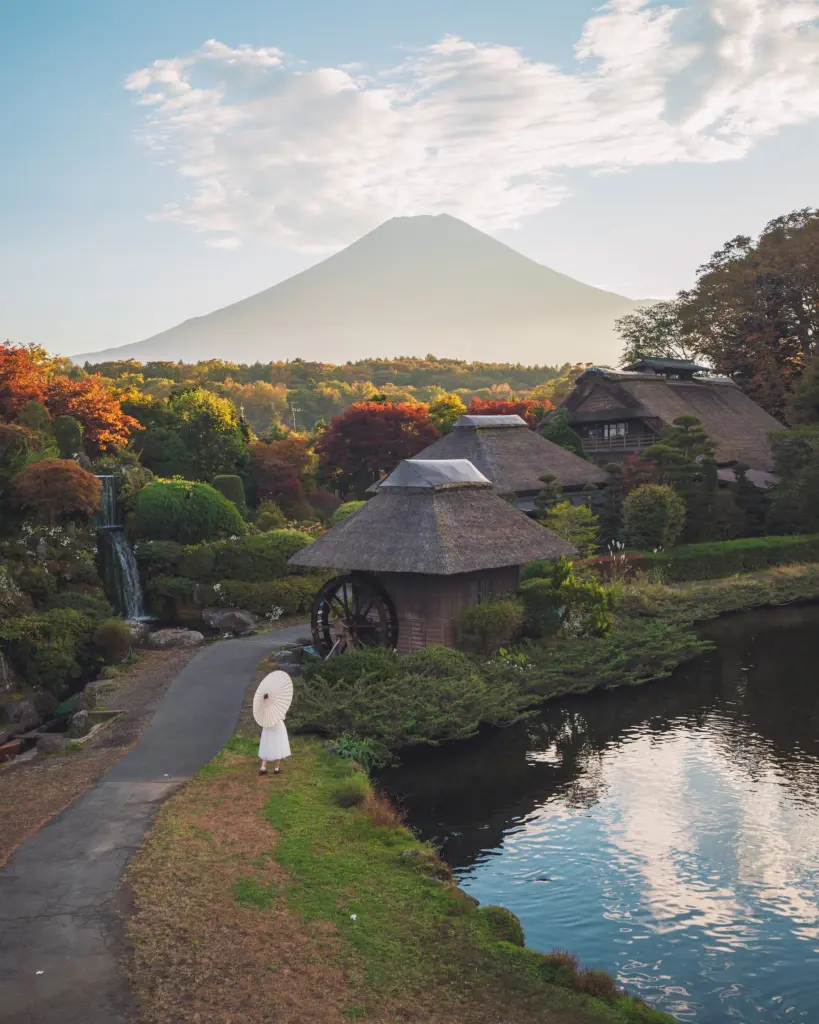
5. Oshino Hakkai
Oshino Hakkai is another tranquil village, renowned for its eight natural springs.
These springs are fed by the melting snow of Mt. Fuji, and the water that filters through the volcanic rock over decades emerges in Oshino Hakkai as crystal-clear ponds, filled with unique aquatic plants and fish.
The water is so pure that it’s considered one of the 100 Best Springs of Japan!
Each of the eight ponds has a distinct character, with different depths and clarity, and they are all connected through a network of gentle streams. Walking paths meander through the village, allowing you to explore these natural wonders at a leisurely pace.
The largest pond, Wakuike, is particularly famous for its exceptional clarity and amazing aesthetic with the traditional houses as a backdrop.
The village itself, framed by traditional thatched-roof houses, offers a snapshot of rural Japanese life, preserving the customs and architecture of a bygone era.
Many of the old farmhouses are now shops or restaurants, and you can sample local specialties, like the fresh-water delicacies cooked to perfection or the renowned “yokan,” a sweet bean jelly.
You can join Mt. Fuji tours that include Oshino Hakkai through here .
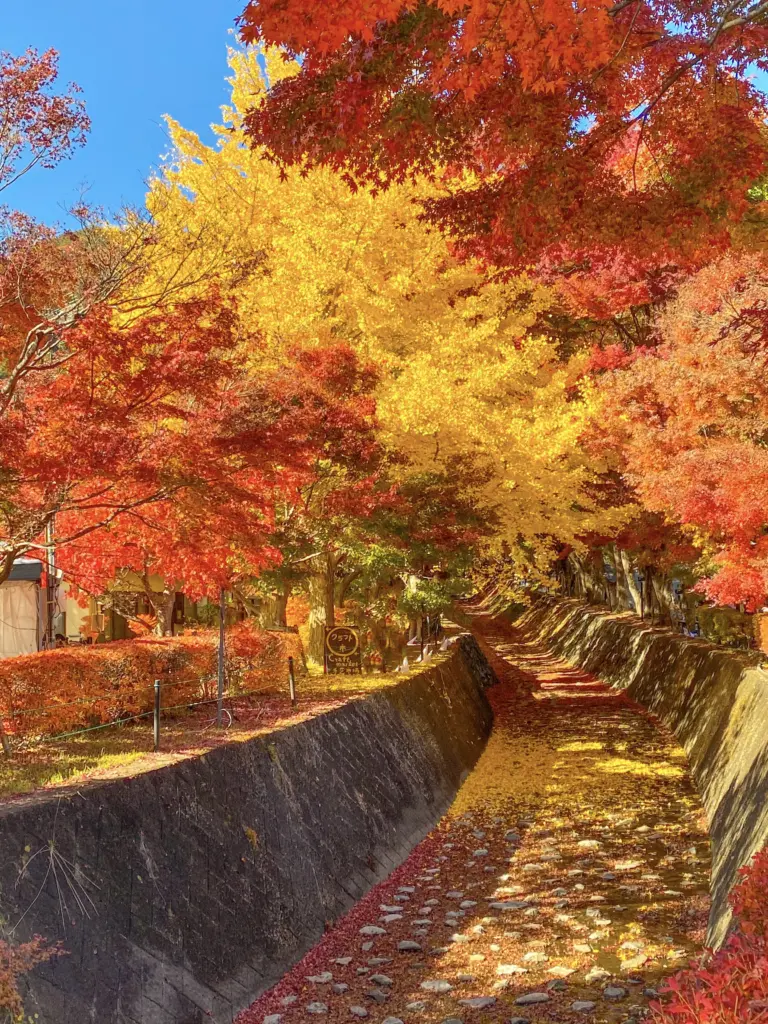
6. Momiji Corridor
If you’re planning on visiting in autumn, then the Momiji Corridor is where you have to go.
It’s actually the place that drew me in the first place.
The Momiji Corridor, Momiji meaning Maple, is a picturesque pathway lined with brilliant maple trees on both sides. Though the crowds can be quite daunting, going through this fiery canopy of red, orange, and yellow is a beautiful experience. The trees arch over the pathway, forming a natural tunnel that’s a feast for the eyes.
During fall, the corridor hosts the Kawaguchiko Momiji Festival, an event celebrating the autumn colors. Stalls selling local food and crafts line the streets, and the area is illuminated at night, creating a magical ambiance that extends into the evening.
7. Kitaguchi Hongu Fuji Sengen Shrine
Tucked away in the dense forest at the base of the Mt. Fuji, this Shinto shrine is a place steeped in a mystical aura that seems to permeate the entire complex.
Originally established over 1900 years ago, the Kitaguchi Hongu Fuji Sengen Shrine is one of the starting points for the Yoshida Trail, the route that countless pilgrims and hikers have taken over the centuries to reach the summit of the sacred mountain.
The shrine’s architecture is stunning, with its intricately carved wooden gates, moss-covered stone lanterns, and timeless buildings that wear the patina of history with grace. The main hall, built in the traditional Nagarezukuri style, is designated as a cultural property.
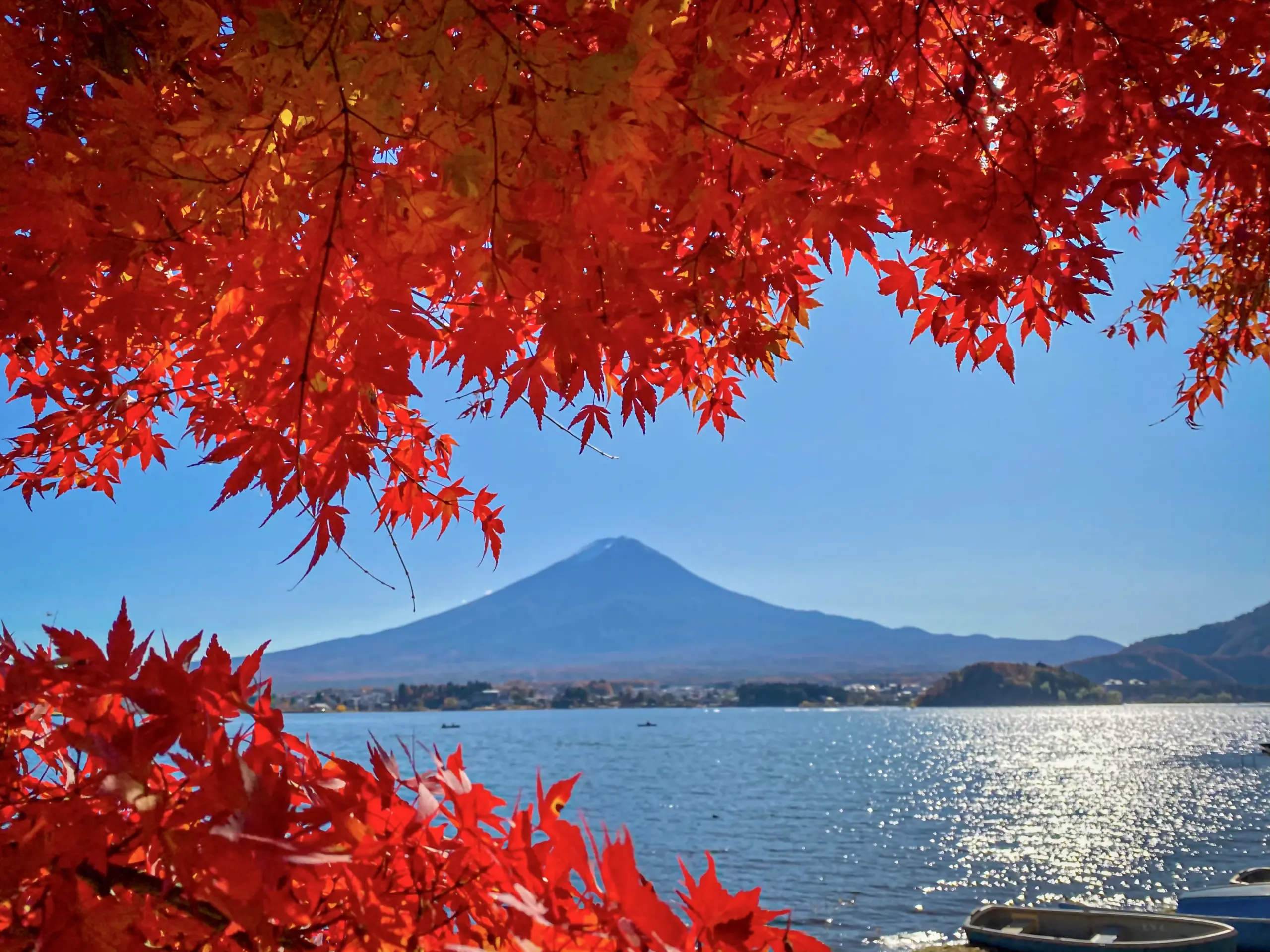
8. Oishi Park
Nestled on the northern shores of Lake Kawaguchi, Oishi Park offers a panoramic spectacle that’s forever etched in many hearts.
Oishi Park is a sensory delight that changes with the seasons. During spring, the area blooms with colorful tulips, while summer brings on the fragrant lavender fields.
Autumn transforms the park into a kaleidoscope of reds from the kochia and in winter, you can see the snow-capped summit of Mt. Fuji in all its glory.
No matter what draws you to Oishi Park, whether it’s the seasonal blooms, the striking landscape, or simply the calm that comes from being in a beautiful natural setting, it always seems to offers an enriching experience.
It’s also one of the few places where I found a restaurant while cycling around Lake Kawaguchi.
Where to Stay in Kawaguchiko
Kawaguchiko is home to some of the most home-y and not to mention tranquil establishments, most of them offer unparalleled views of Mt. Fuji with Lake Kawaguchi just right in front of your window.
During the summer, when it’s the peak time to climb Mt. Fuji, Kawaguchiko’s prices tend to sky-rocket so it would be best to book accomodations at a less busy season.
Nevertheless, here are some of my curated recommendations if you’re staying in the area:
Best Hotels in Kawaguchiko :
- Fujikawaguchiko Resort Hotel – offers a range of amenities including a garden, free private parking, and an on-site restaurant. You can benefit from free shuttle services, luggage storage, and complimentary WiFi throughout the property. The hotel’s air-conditioned rooms come equipped with practical amenities like a desk, electric tea pot, fridge, safety deposit box, flat-screen TV, and a private bathroom with a bidet. The multilingual staff, speaking English, Japanese, and Chinese, are readily available to assist.
- Fuji Osenji Yumedono – this luxurious ryokan offers an exclusive experience with features such as in-room hot springs, traditional Japanese cuisine in the dining area, and a beautiful garden. The ryokan’s well-appointed suites boast private outdoor hot-spring baths (onsen), flat-screen cable TV, DVD player, and essential amenities like a bathtub and hairdryer in the private bathroom.
- Hananoyado Yumefuji – offers a unique accommodation experience with each room featuring a private garden with a terrace.This villa ensures you’ll have modern conveniences, with air-conditioned rooms that include a wardrobe, flat-screen TV, private bathroom with free amenities, and a kitchenette complete with a fridge. Breakfast is thoughtfully provided daily as a morning basket (bento).
Best Hostels in Kawaguchiko :
- Hostel Michikusa-ya – enjoy the convenience of free private parking and the relaxation of a shared lounge and garden. The air-conditioned rooms, equipped with shared bathrooms, come with complimentary WiFi access. The property features a shared kitchen, along with free shuttle service and luggage storage.
- Kagelow Mt. Fuji Hostel – designed to cater to travelers from across the globe. Once an old hotel, it has been rebuilt into a hostel that embraces a modern Japanese-style concept, infusing it with a touch of traditional Japan. The renovation of the hostel involved using wood from a 150-year-old Japanese house, retaining the charm of old Japanese materials and traditional items, such as Tatami mats, which add a relaxed feel to the rooms.
- Dot Hostel & Bar – this hostel is built on the concept of encouraging everyone to meet new people, explore new cultures, and have new experiences, the property offers a lively and inviting atmosphere. The wide lobby space, filled with many board games and a big screen, serves as a common area to socialize. There is also a bar on-site where guests can indulge in local beer and Japanese sake.
Hidden Gems in Kawaguchiko
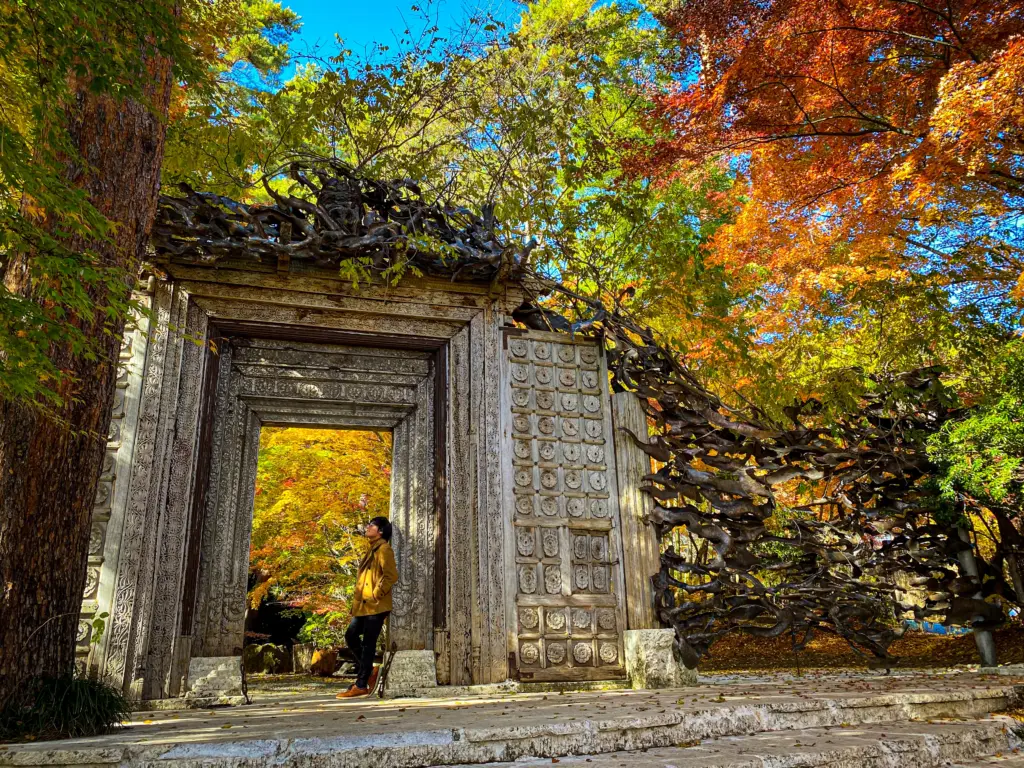
9. Kubota Itchiku Art Museum
The Kubota Itchiku Art Museum stands as a showcase for the works of Itchiku Kubota, an extraordinary textile artist who revived and transformed the ancient kimono-dyeing technique known as “Tsujigahana.”
The museum itself is a piece of art, from the decidous main gate to the elegant wooden architecture that blends seamlessly with the surrounding natural beauty.
Inside, the main exhibition hall holds an awe-inspiring collection of Kubota’s masterpieces. His most famous work, the “Symphony of Light,” is a series of kimonos that together form a stunning panorama of Mount Fuji across different seasons.
Cost: 1,300 JPY
10. Lawson At Kawaguchiko Station
A Lawson might seem like an odd recommendation, as it’s essentially a convenience store located near the Kawaguchiko train station.
Yet, it has become something of a local landmark and its aesthetics.
What sets this particular Lawson apart from others is its strategic location and spectacular view of Mt. Fuji. Positioned just right above the store stands an unobstructed, picture-perfect view of Japan’s iconic peak.
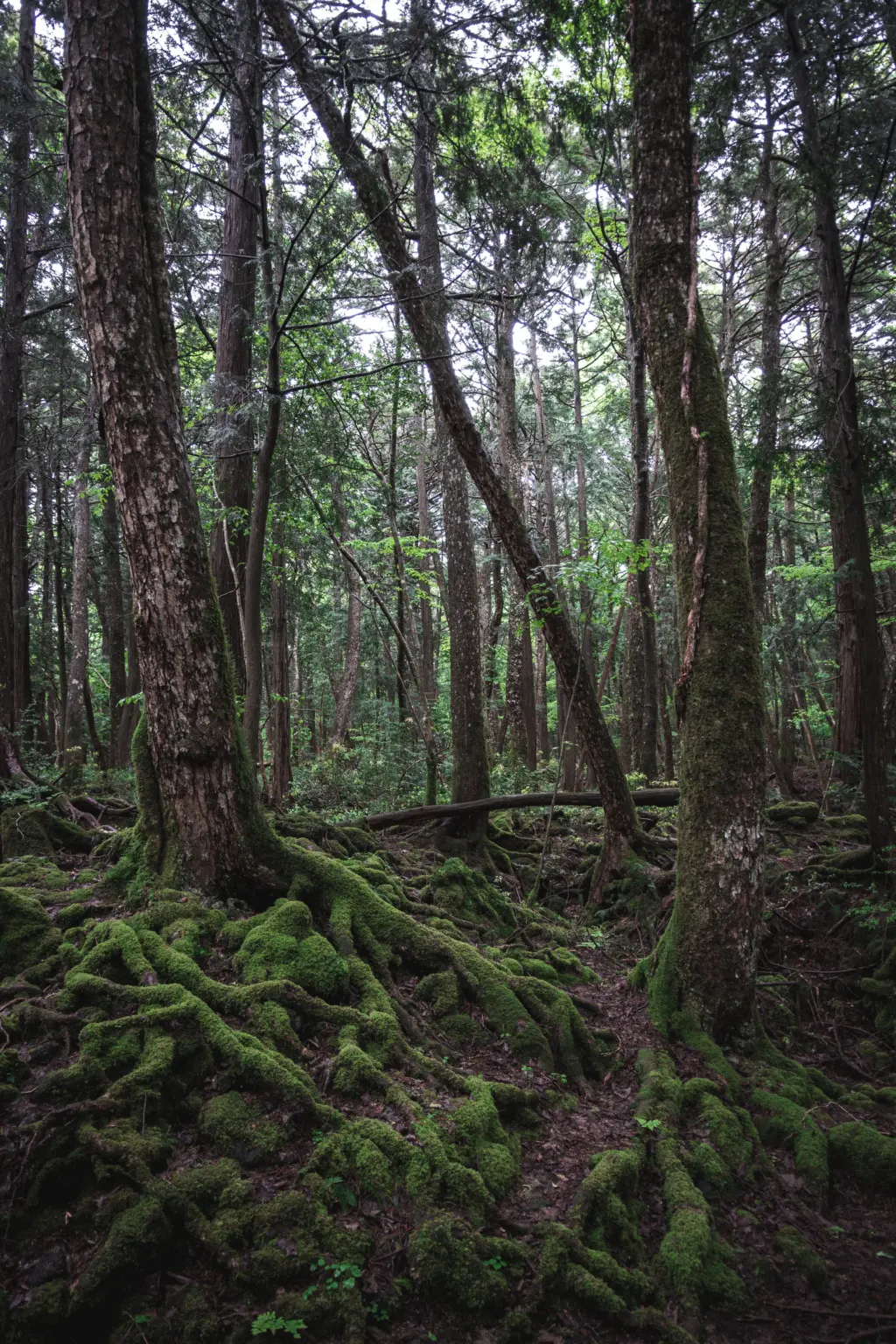
11. Aokigahara Forest
Aokigahara Forest is lovingly known as the “Sea of Trees”. It’s a vast forest that sprawls at the base of Mt. Fuji.
Covering an area of around 35 sq km (14 sq mi), Aokigahara Forest is unique in its terrain. The ground is uneven and filled with caverns and crevices since it formed on top of hardened lava following an eruption of Mt. Fuji over a millennium ago.
The forest is so dense that it can become nearly dark in broad daylight, and the absence of wildlife creates an uncanny silence.
As many might know, this beautiful forest has a darker side. Aokigahara has become known as a place where people go to end their lives, and this reputation deeply overshadows the forest’s natural beauty.
Nevertheless, there are plenty of trails that are safe for public use, you can also join guided tours as well if you’re afraid of getting lost.
12. Narusawa Ice Cave
The Narusawa Ice Cave was formed over 1,150 years ago following an eruption of Mt. Fuji. Legend has it that it’s connected to the Iwaya Caves of Enoshima , all the way in Kamakura !
As you descend into the depths of the cave, the temperature drops significantly, and the walls become adorned with these striking icicles even during the summer months.
The cave maintains a constant temperature of around 3°C (37°F), preserving its icy features year-round. The passage through the cave leads you through narrow and twisting paths, and the glistening ice contrasts beautifully with the dark, rocky surroundings.
In the past, the ice from the cave was considered sacred and used in various ceremonies at the Imperial Court. It was also utilized to store silkworm eggs, as the constant cold temperature provided the ideal conditions for preservation.
Though the walk is not particularly long (10 minutes), the cave’s low ceilings and narrow passages can still make it a very memorable experience.
Cost: 350 JPY
Top Things to Do in Kawaguchiko
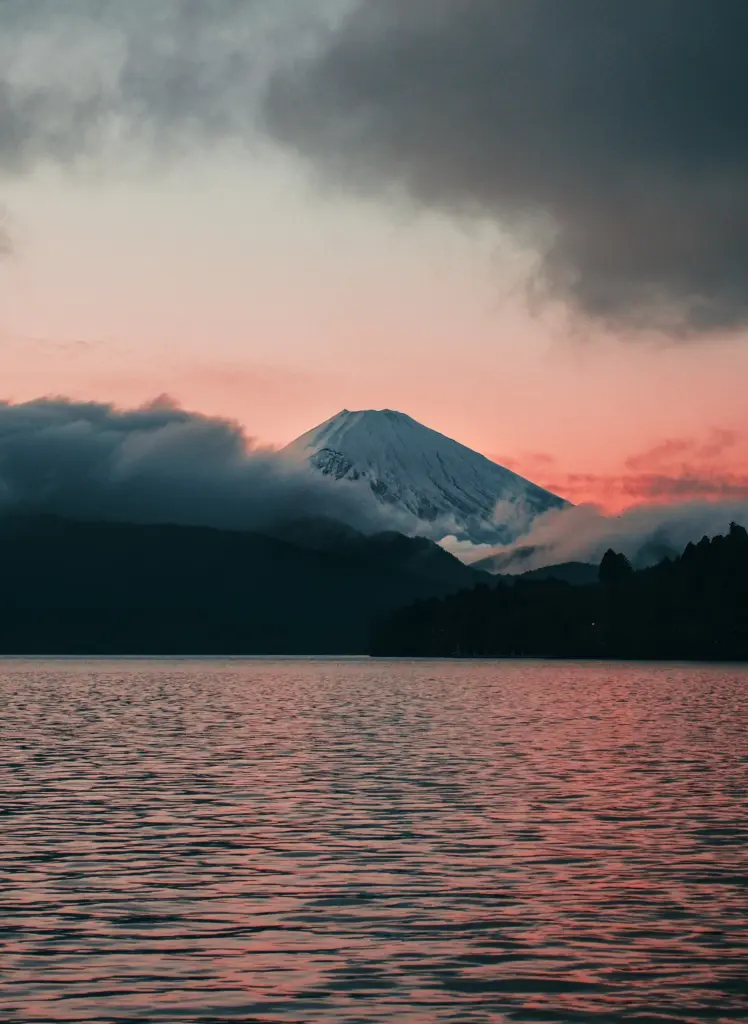
13. Take Beautiful Photos of Mt. Fuji
Capturing the grandeur of Mt. Fuji is an experience that many travelers to Kawaguchiko yearn for, and it’s easy to see why.
As Japan’s highest peak and an iconic symbol of the country, Mt. Fuji presents a majestic sight that inspires anyone who catches a glimpse of it. I can never get tired of Mt. Fuji, no matter how many times I’ve already seen it.
The region around Lake Kawaguchi provides numerous vantage points to frame Mt. Fuji in all its glory. Depending on the season and weather conditions, the mountain’s appearance can change dramatically, offering unique opportunities to practice your photography composition .
During the early morning, when the air is crisp, you might capture Mt. Fuji with a perfect reflection in the calm waters of Lake Kawaguchi. In the autumn months, the colorful foliage of the nearby forests adds a vibrant contrast to the snow-capped peak.
Winter brings clear skies and a stark, monochromatic beauty, while spring offers a chance to photograph the mountain with cherry blossoms in the foreground.
14. Shred Some Powder at Fujiten Snow Resort
If you’re visiting Kawaguchiko in the winter and have a love for snow sports, Fujiten Snow Resort is a destination that should not be missed. It’s one of the few snow resorts that can be easily done as a day trip from Tokyo.
Fujiten Snow Resort boasts well-maintained slopes that cater to various skill levels, its got gentle trails and some challenging runs. It’s here that I first tried to ride a snowboard, only to fail miserably. I later tried my hand at it again at Niseko , where I was finally able to thrive !
The resort’s elevation ensures good snow quality throughout the season, and the modern snowmaking equipment supplements the natural snowfall, keeping the trails in excellent condition.
There’s also an indoor “Kids Land” where little ones can play with sleds and other snow toys.
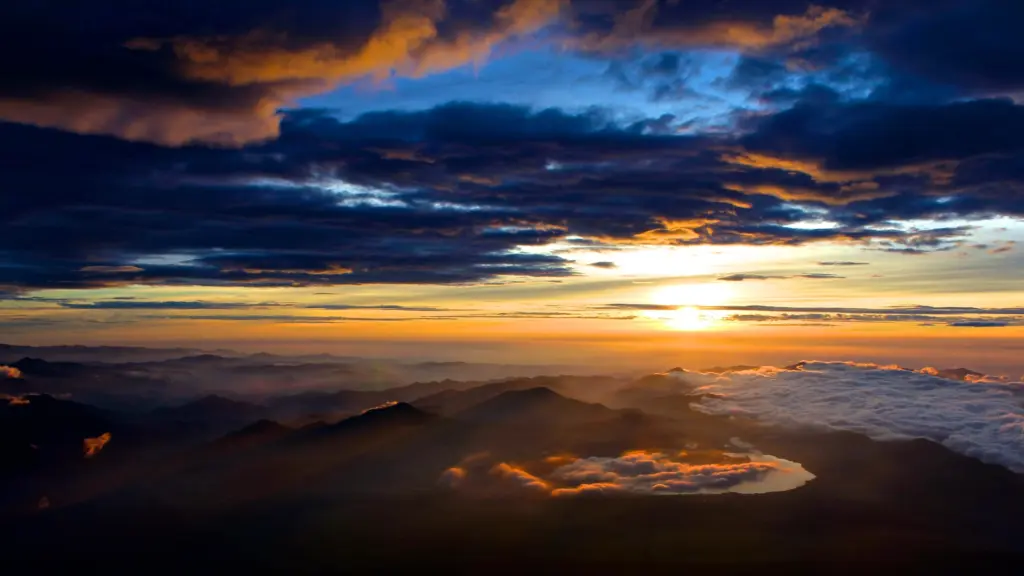

15. Paraglide Around Mt. Fuji
The Asagiri Kogen Paragliding School provides the unique opportunity to soar through the skies, with Mt. Fuji as the awe-inspiring backdrop.
Located on the Asagiri Plateau, this school offers paragliding experiences for both beginners and seasoned fliers. The professional and highly experienced instructors guide will guide you through the entire process, ensuring safety and comfort at all times.
For those new to paragliding, tandem flights with an instructor are available. These allow you to enjoy the thrill of flight without the need for prior experience. Strapped securely to a qualified instructor, you’ll launch from the gentle slopes of the plateau and rise into the air, carried by the wind and thermal currents.
As you ascend, the view of Mt. Fuji becomes increasingly breathtaking, appearing almost surreal as it dominates the horizon.
16. Relax in an Onsen with a View
Relaxing in an onsen while enjoying the majestic view of Mt. Fuji is one of the quintessential experiences you can have in Kawaguchiko. Here’s a look at some onsens where you can indulge:
Fuji Yurari Onsen: Enjoy breathtaking views of Mount Fuji from the outdoor baths at this location. The unique setting offers exceptional vistas, particularly during sunset.
Benifuji no Yu: Bathe with a spectacular view of both Mount Fuji and Lake Yamanaka. This onsen allows you to connect with nature and enjoy the tranquility of the surroundings, all while indulging in soothing hot spring water.
Ishiwari no Yu: Known for its rocky interior, this onsen is surrounded by the beautiful forests of the Yamanaka area. It’s an ideal place to unwind and take in nature.
Koraku Onyado Fujiginkei: For an authentic ryokan experience, this traditional onsen ryokan offers beautiful garden views. The outdoor baths are set within a tranquil garden, adding to the charm.
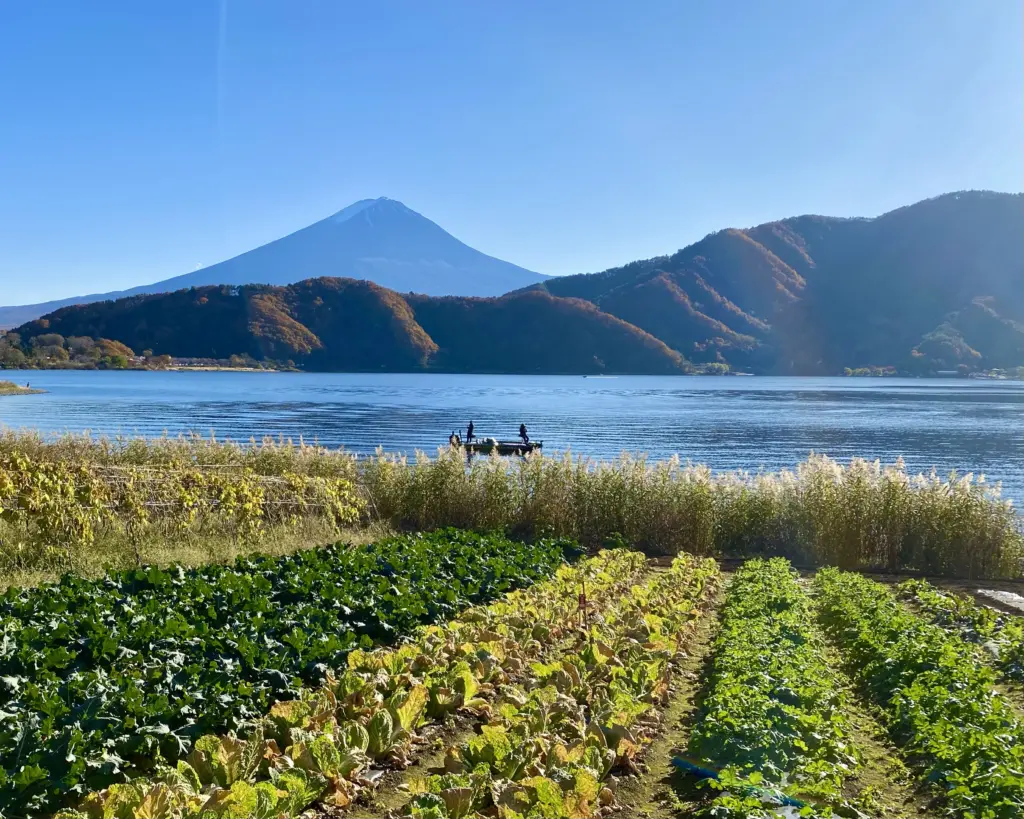
17. Cycle Around Lake Kawaguchi
The natural beauty of Kawaguchiko is something that not only can be seen but also felt as you pedal your way around the shimmering lake.
The cycling path around Lake Kawaguchi is approximately 20 km (12 mi) long and offers a pleasant route that’s suitable for riders of all levels. You can take it at a leisurely pace, pausing to take in the landscapes and going down at the various hot spots around the area.
Rental bikes are available near the station, with options ranging from standard bicycles to e-bikes. You might have to call to make a reservation or get there earlier to secure yourself a bike.
I did the cycling trip around autumn which is one of the best times to do it, in my opinion. You can read more at my post on Cycling Around Lake Kawaguchiko .
18. Ride the Mt. Fuji Panoramic Ropeway
Starting from the eastern shore of Lake Kawaguchi, the Mt. Fuji Panoramic Ropeway lifts you up to an elevation of about 1,075 m (3,525 ft), leading to the observatory at the summit of Mt. Tenjo.
The ascent itself is an exciting part of the experience, as you find yourself smoothly gliding over lush forests and terrains that gradually reveal a panoramic view of the area.
Once you reach the summit, the view is nothing short of breathtaking. The majestic Mt. Fuji stands tall in the distance, framed by Lake Kawaguchi’s sparkling waters and the vibrant hues of the land.
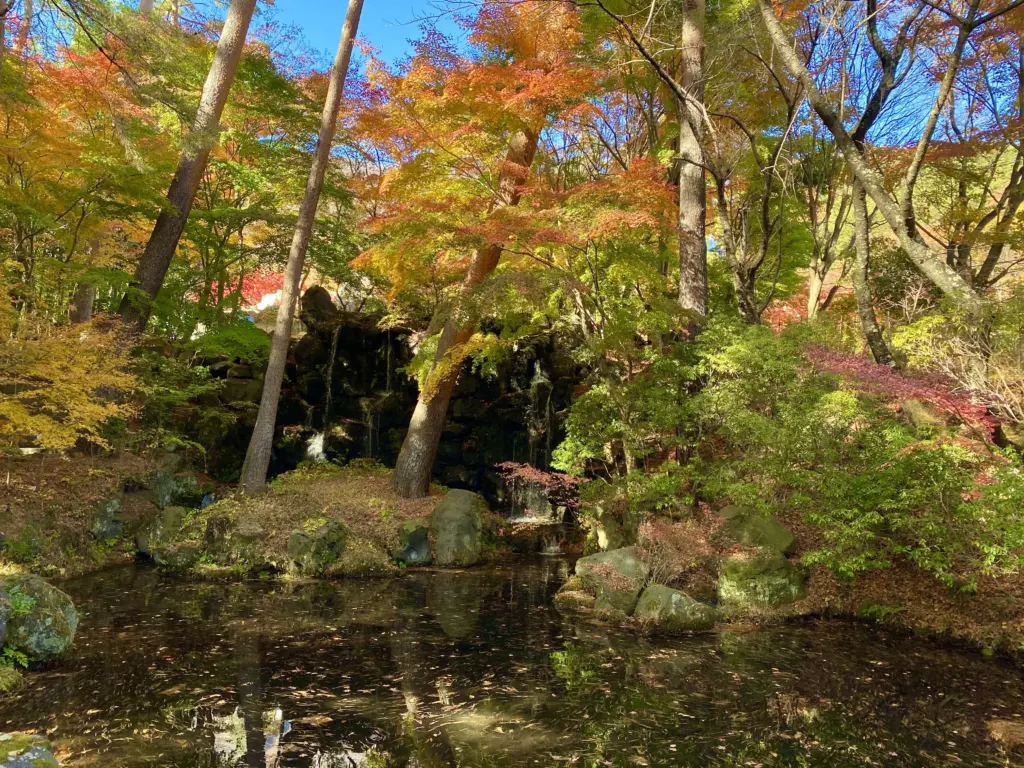
19. Go Museum-Hopping
From classic art to innovative displays, Kawaguchiko is packed with museums. Here’s a look at some of the top museums you can explore:
Yamanashi Gem Museum : If you’re fascinated by gemstones, this museum hosts an extensive collection of rare and beautiful gems from around the world.
Kawaguchiko Museum of Art : Showcasing contemporary Japanese and Asian art, this museum highlights local talents and offers changing exhibitions that keep the experience fresh.
Music Forest Museum : An enchanting museum that feels like stepping into a fairytale, it’s dedicated to automatic musical instruments and features beautiful gardens, live music performances, and more.
Yamanashi Prefectural Museum : This museum offers an insight into the history and cultural heritage of Yamanashi Prefecture, featuring archaeological artifacts, folklore, and more.
How to Get Around Kawaguchiko
- Bus: There are local and sightseeing buses, including the Omni, Fujikko, Mt. Fuji World Heritage Loop, and regular buses.
- Rental Car: Car rental services are recommended if you’re someone who prefers to drive and explore at the area at your own pace.
- Bicycle: As mentioned before, bikes are a great way to explore the lakeside.
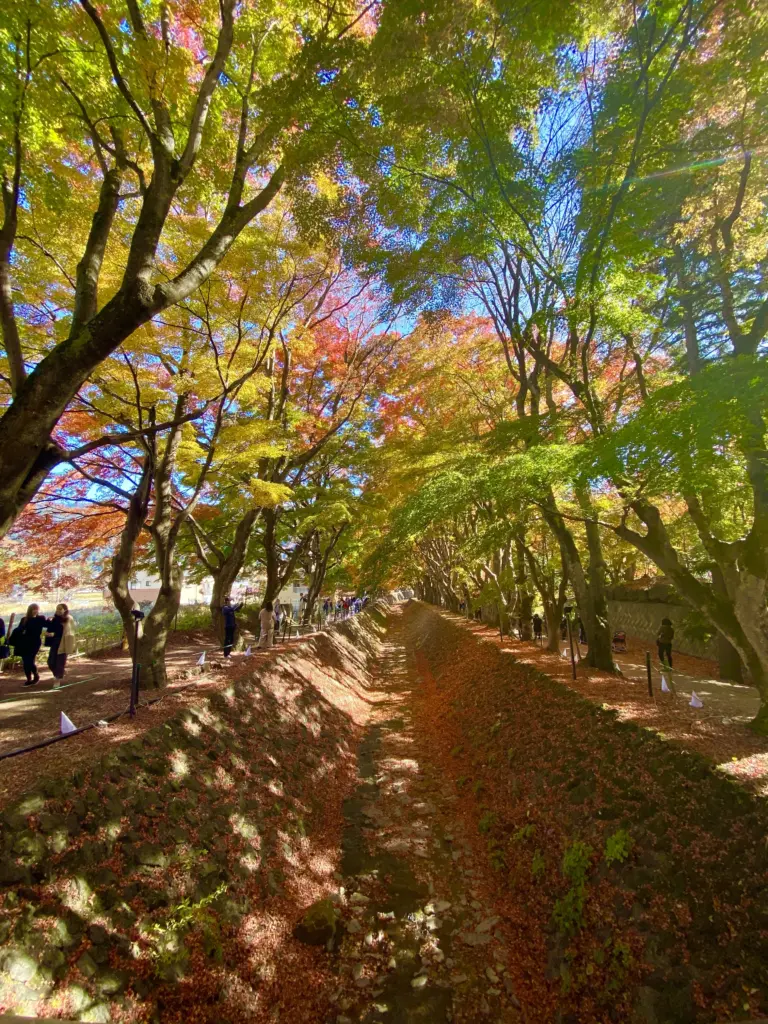
Best Time to Visit Kawaguchiko
- Spring (March to May): With cherry blossoms blooming, spring offers stunning views of Mt. Fuji paired with the colorful scenery. The temperatures are mild, and the weather is generally pleasant.
- Summer (June to August): Summer is famous for being Mt. Fuji climbing season. Plus, the area around Kawaguchiko tends to be not too hot nor humid so it’s still a good time to visit.
- Autumn (September to November): Autumn brings vibrant fall foliage, and is arguably one of the best times to visit though that just may be my biased opinion.
- Winter (December to February): Winters are cold but clear, often providing the best views of Mt. Fuji.
When planning your trip to Kawaguchiko, consider securing your journey with SafetyWing Insurance . SafetyWing offers comprehensive travel insurance that covers medical emergencies, trip cancellations, and other unexpected events. Click the link to explore their packages and ensure a safe and worry-free travel experience.
How to Get to Kawaguchiko
From Shinjuku Station: Fujikyu and Keio Bus run about two direct buses per hour from Shinjuku Bus Terminal to Kawaguchiko Station. The trip takes slightly under 2 hours and costs 2000 yen. Buses may also continue to Lake Yamanakako.
From Tokyo Station: Buses operated by Fujikyu and JR Kanto Bus connect Tokyo Station (Yaesu South Exit) with Kawaguchiko Station, about 1 to 2 times per hour. The journey is 2 hours long and costs 2000 yen.
From Shibuya Station: Fujikyu offers a service every two hours from Shibuya (Mark City) to Kawaguchiko Station, Fuji Q Highland, and Fujisan Station. Expect a 2 to 2.5-hour trip, costing 2000 yen.
From Shinjuku Station: Start by taking the JR Chuo Line to Otsuki Station (70 minutes, 2360 yen for direct limited express; 100 minutes, 1340 yen for local trains). Then transfer to the Fujikyu Railway Line to reach Kawaguchiko Station (55 minutes, 1170 yen).
Direct Limited Express Trains: A few direct limited express trains operate daily between Shinjuku and Kawaguchiko. These take about 2 hours, costing around 4000 yen, and seat reservations are mandatory.
Alternatively, you can also join tours departing from Tokyo that will take you to Mt. Fuji and Kawaguchiko such as this 1-Day Scenic Bus Tour .
- There is also a Private Tour available for a more intimate experience.
Plan Your Trip to Japan | Best Travel Resources
Book Your Accommodations
- Booking.com – the world’s leading online booking platform for accomodations around the world, they have an extensive amount of available listings with zero booking fees and best price guarantees.
- Hostelworld – a backpacker’s best friend, Hostelworld has the largest collection of hostels and guesthouses for affordable prices.
Don’t Forget Insurance
- SafetyWing – from Nomad Insurance, an insurance by nomads for nomads. They understand our lifestyle well and have really comprehensive and flexible plans that cater to any traveler.
Find Cheap Flights
- Kiwi.com – my go-to for booking and finding the cheapest flights and it’s helped me save tons of money. They do virtual interlining which is connecting flights from airlines that do not codeshare, so you can find routes that you wouldn’t be able to find normally.
Join Tours & Activities
- GetYourGuide – is one of the best places to find unique tours and activities. I found that it’s an excellent way to meet fellow travelers and create fond memories. They are not only limited to tours as they also offer niche services such as skip-the-line tickets or private transfers.
Catch a Ride
- Rentalcars.com – nothing beats the freedom of the road, Rentalcars.com is the world’s largest online car rental service. They operate across 160 countries so they’re the perfect partner to work with if you find yourself wanting a ride.
SHARE THIS POST
Read this next.
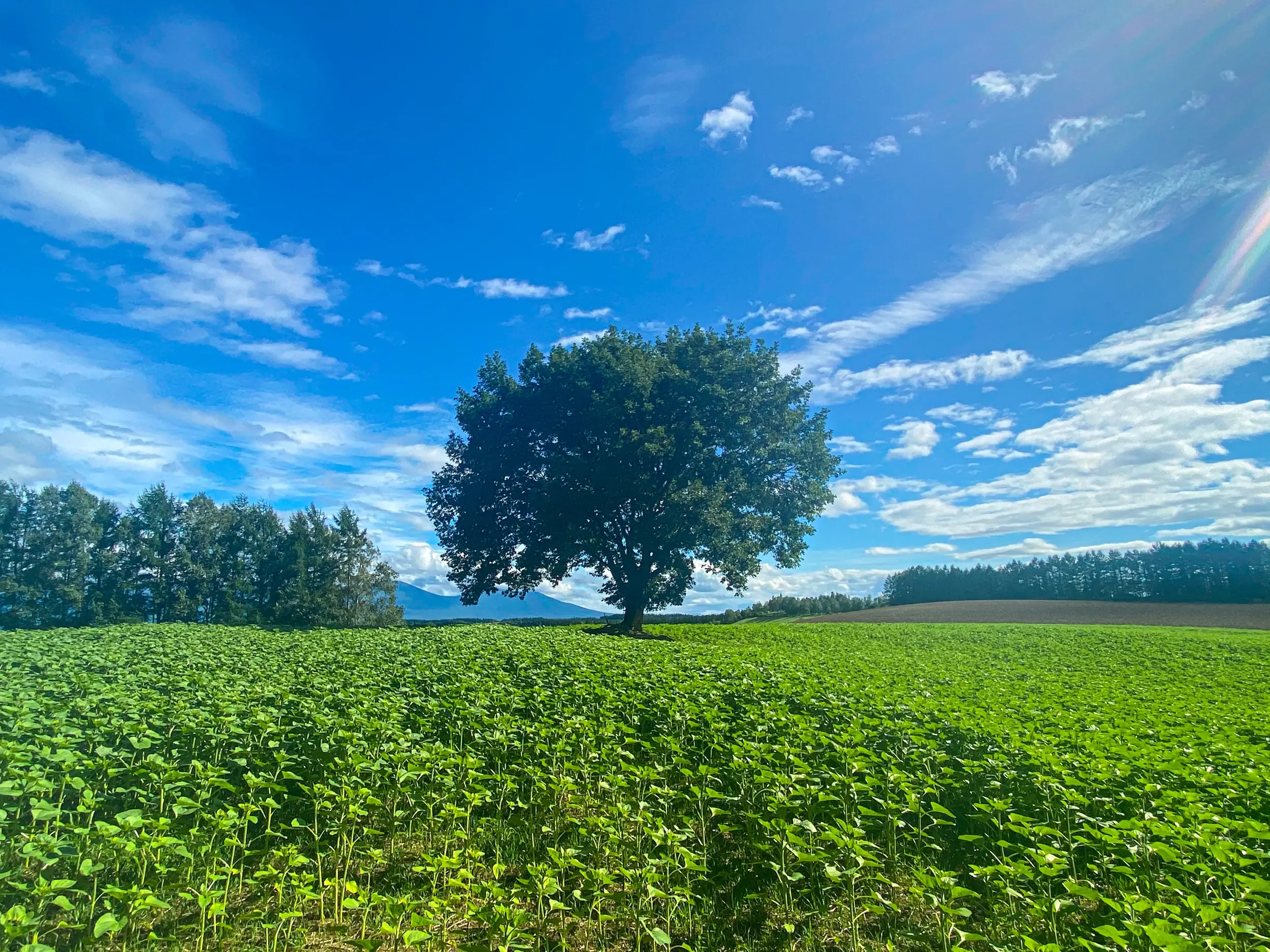
Tree of Life | Symbolism Across Cultures (Sacred Geometry)
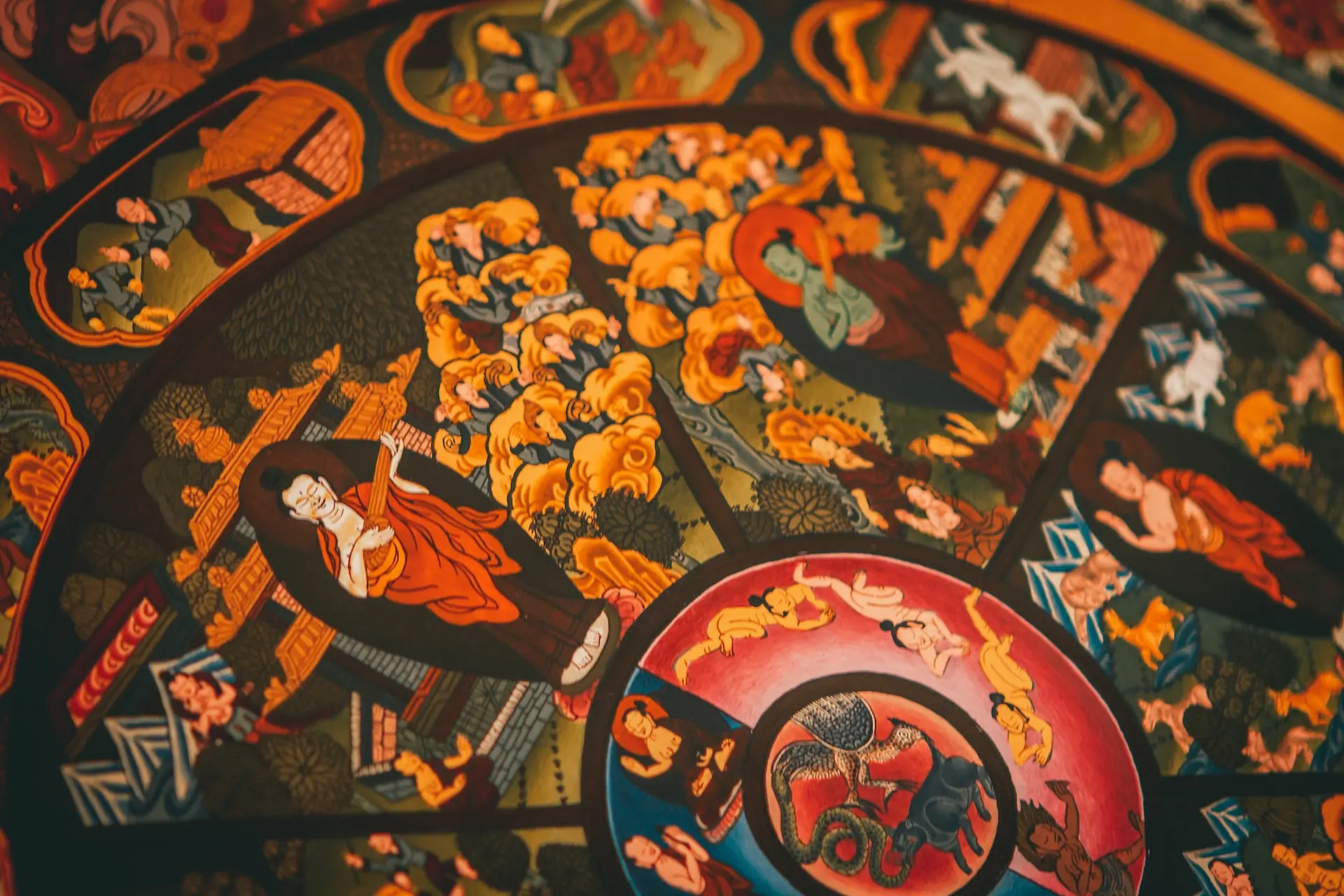
Moksha vs Nirvana | Understanding the Paths to Liberation
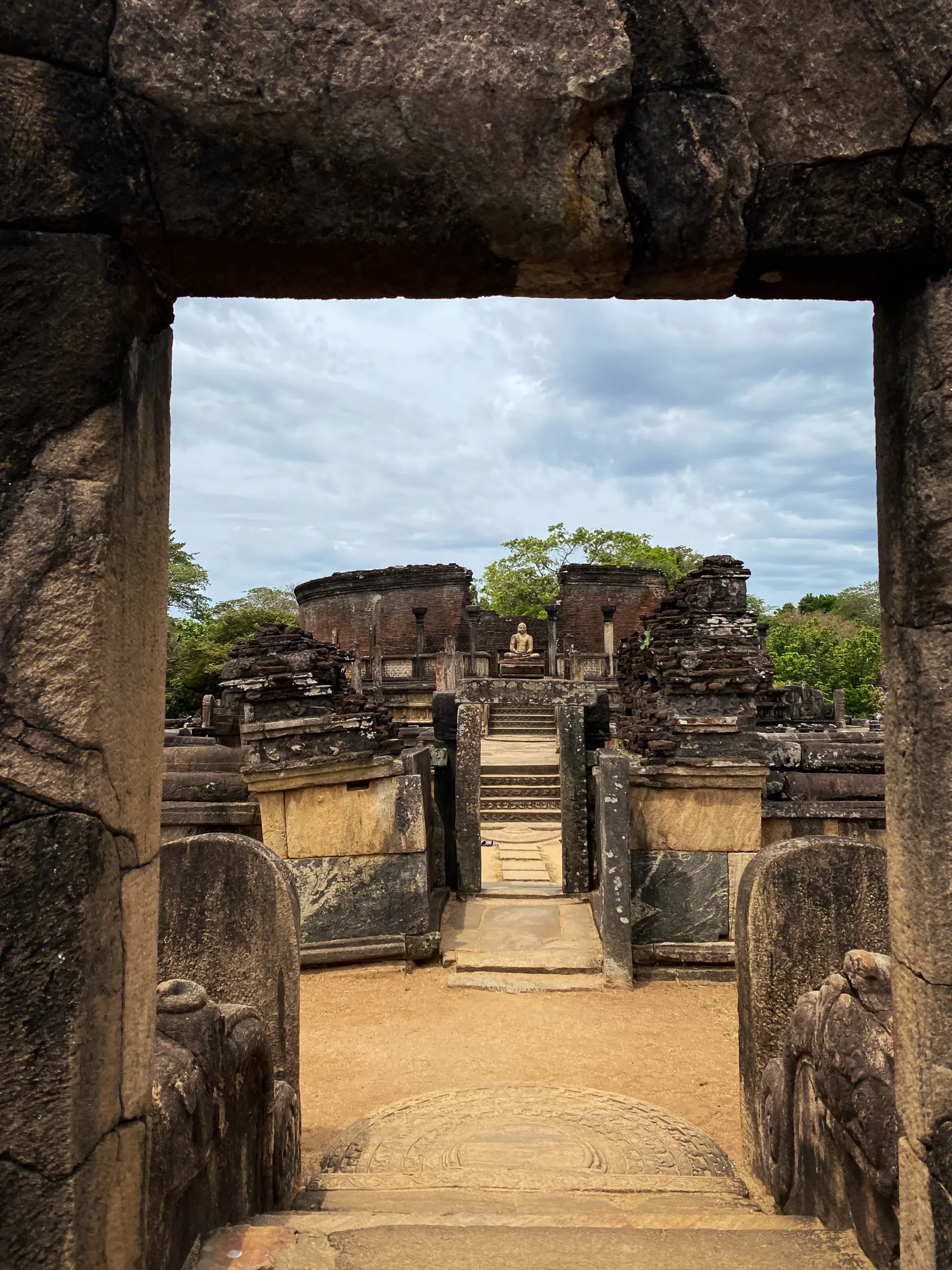
Cycling Guide for Polonnaruwa (with Route & Map)

Leave a Reply Cancel reply
Your email address will not be published. Required fields are marked *

Hi, I’m Brandon
A conscious globe-trotter and an avid dreamer, I created this blog to inspire you to walk the Earth.
Through tales of travel, cultural appreciation, and spiritual insights, let’s dive into the Human Experience.
RECENT ARTICLES

The Spiritual Meaning of Stacking Stones & Why People Do It

12 Awesome Things to Do in Casco Viejo, Panama

5 Easy Steps to Create a Meaningful Sankalpa
Popular articles.
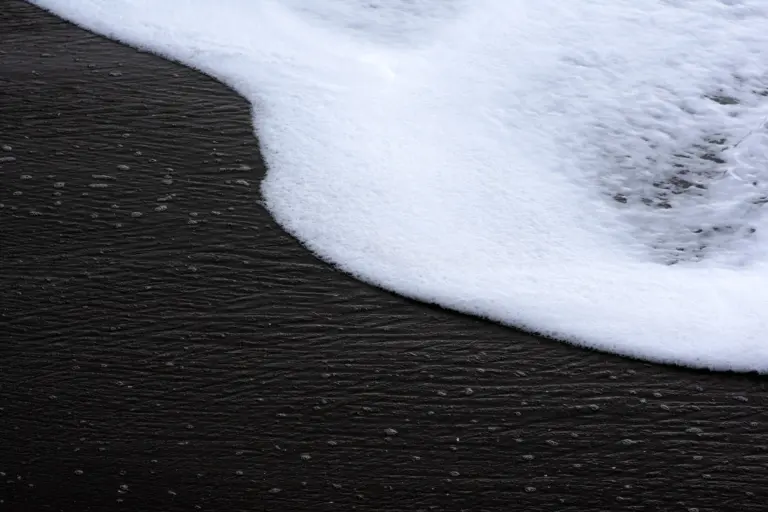
The Paradox of Yin and Yang: A Symbol of Duality or Holism?
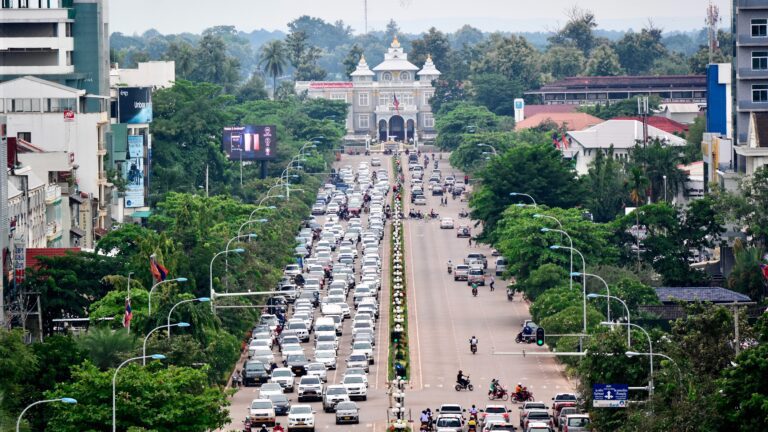
18 Amazing Things to Do in Vientiane | Ultimate Travel Guide
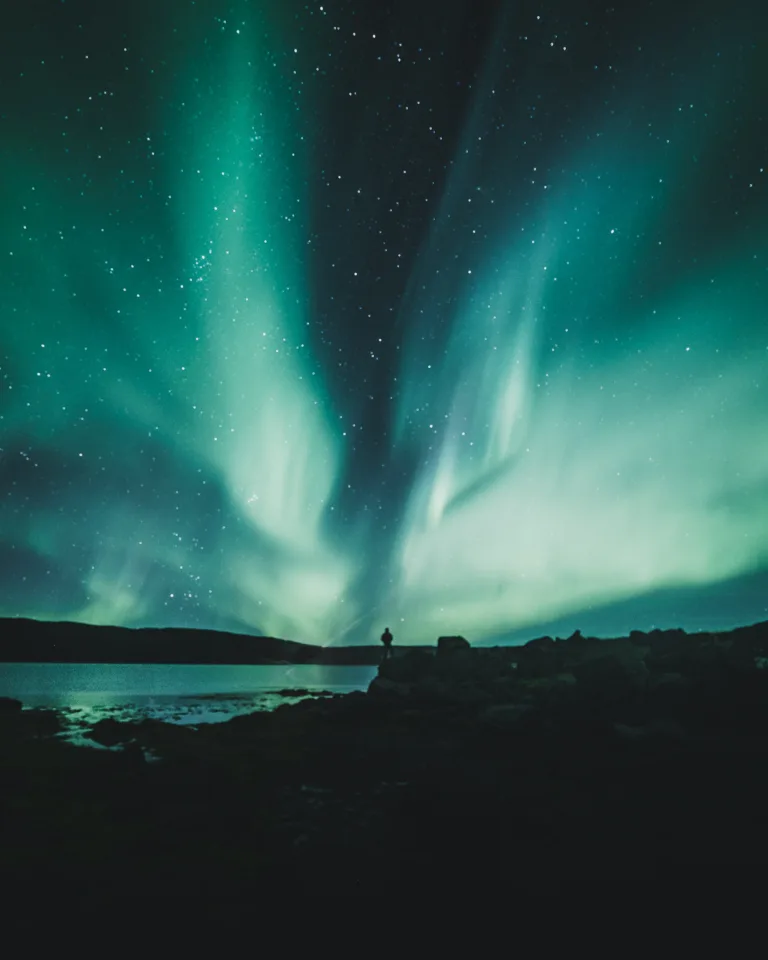
The 7 Planes of Existence | A Deep Dive
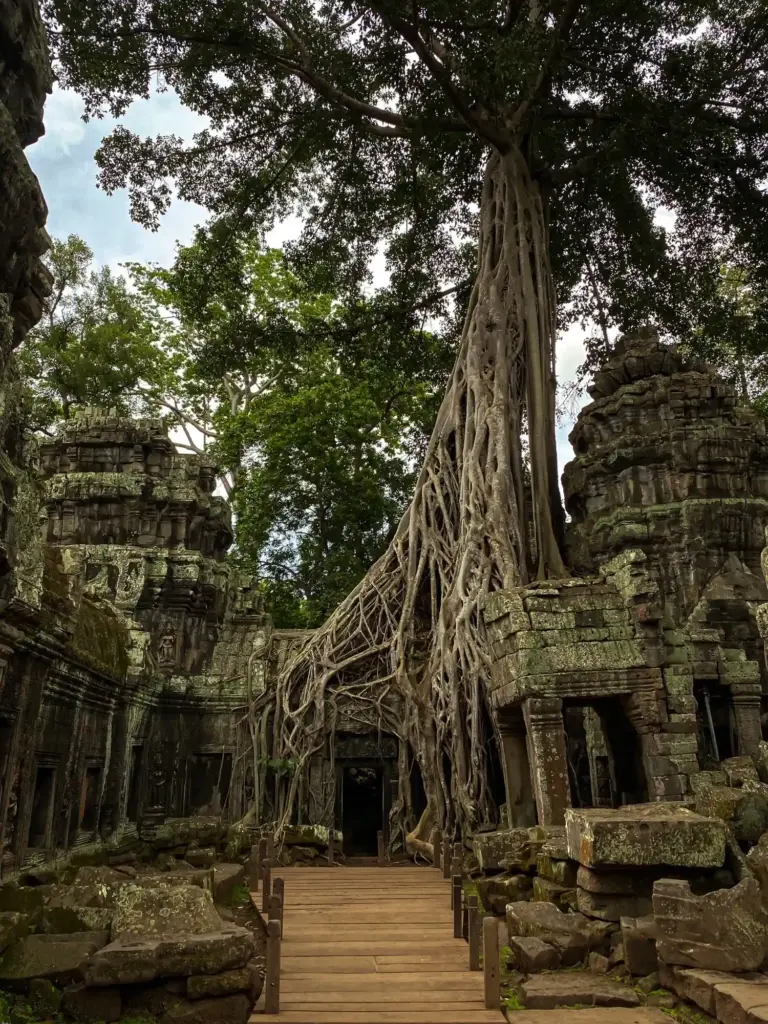
13 Must-See Angkor Temples You Can NOT Miss in Siem Reap
Subscribe for the latest blog drops, photography tips, and curious insights about the world.

© 2023 ALL RIGHTS RESERVED.
- Destinations
- Privacy Policy
Want to get in touch? Feel free to fill in the form below or drop me an e-mail at [email protected]

Exploring Fuji Five Lakes: 3 Days in Kawaguchiko Guide
A short journey from Tokyo will lead you to the foothills of Mount Fuji, where the captivating Fuji Five Lakes region awaits. Exploring the five stunning lakes and their breathtaking views of Mount Fuji during our 3 days in Kawaguchiko was one of the highlights of my most recent Japan trip.
In this guide, I cover all you need to know about exploring Fuji Five Lakes, including the ultimate Fuji Five Lakes itinerary. From all you need to know to get around, to an optimised 3 day itinerary to cover the best of the region (plus some lesser-known gems!). This travel guide has all you need to know to plan your own unforgettable adventure in this remarkable corner of Japan.
Table of Contents
About the Fuji Five Lakes Area
Fuji Five Lakes is arguably the best place to view Mt Fuji from – it felt like every corner I turned, Fujisan was there standing tall in all it’s glory.
Unsurprisingly, the Fuji Five Lakes area is made up of, yep you guessed it – five lakes!
The area comprises five lakes: Lake Kawaguchiko, Saiko, Yamanakako, Shojiko, and Motosuko. These lakes all offer stunning views of Mount Fuji.
Most visitors to the area stay in Kawaguchiko, as it is the most developed and accessible for tourists. Lake Yamanakako is the largest of the five Fuji lakes and has a small number of accommodation lodgings.

How Long to Spend in Fuji Five Lakes
I’d recommend spending at least 2 nights in Kawaguchiko.
In April 2023, I stayed 3 nights which was a decent amount of time, though we still left with a few activities and sights we didn’t quite manage to fit in!
It’s also possible to explore Fuji Five Lakes on a day trip from Tokyo.
Some popular tour options are included below which explore the main sights near Kawaguchiko. However, if you have the time, I highly recommend spending at least a couple of nights in Kawaguchiko.
Day Tours from Tokyo
These are the most popular day tours from Tokyo to Kawaguchi
- Scenic 1 Day Tour: Chureito Pagoda, Oishi Park & Lake Saiko Traditional Village
- Mt Fuji Sightseeing Trip: Oishi Park, Chureito Pagoda, Fuji Fifth Station & Oshino Hakkai
- Private Customisable Day Trip from Tokyo (up to 5 People)
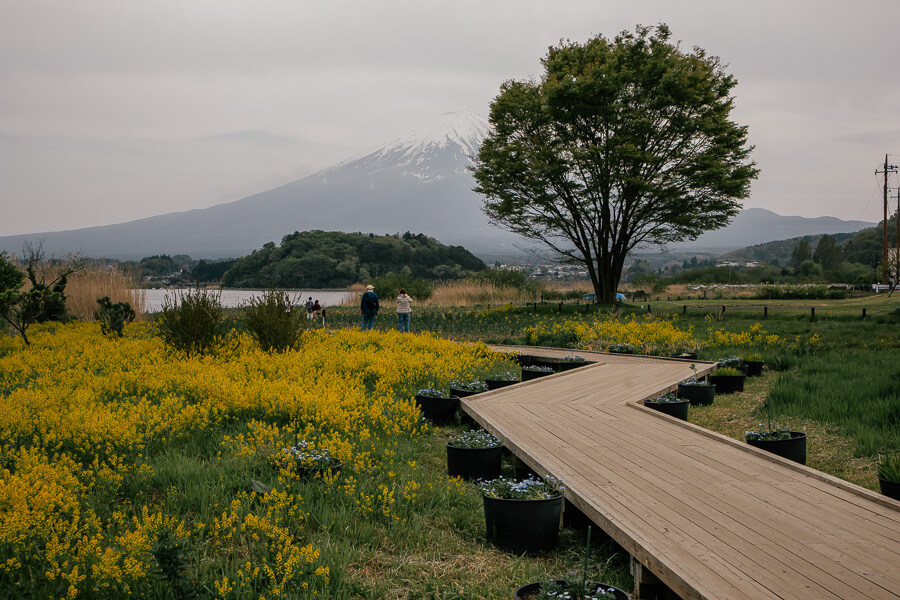
Best Time to Visit
You can visit the Fuji Five Lakes area all year round, however, the best time to visit for clear views of Mount Fuji is between November to April.
As Japan has a hot and humid summer, there are more often clouds to obstruct the view. This is why I’d recommend spending at least a few days in Kawaguchiko, to give you the best chance of seeing Mount Fuji on a clear morning.
During our 3 night, 4 day stay in Fuji Five Lakes in April, we had clear views for three of those. One morning we woke up and we couldn’t even see Mount Fuji as it was heavily obscured by clouds!
Cherry blossom season in early-mid April is a very popular time to visit – while it’s beautiful to see Mount Fuji framed by cherry blossoms , it’s also extremely busy.
Read my dedicated guide for the best viewpoints of Mount Fuji .

Where to Stay
Following my itinerary, you’ll base yourself around Kawaguchiko. For stays longer than three nights, you could consider spending a night or two at Yamanakako.
- Budget – Hostel Michikusa : this small, family-run guest house was wonderful. We booked the private tatami mat triple room with a Mount Fuji view. It was incredible waking up to see Mount Fuji each morning. There is a small common area and modern, clean shared bathrooms.
- Mid-Range – Fuji View Hotel : Overlooking Lake Kawaguchi, this hotel is surrounded by Japanese gardens and has a public onsen (hot spring bath).
- Luxury – La Vista : A short walk from the lake, this hotel offers rooms with clear views across to Mount Fuji plus a sauna, hot tub and onsen hot spring bath.
Explore all accommodation options in Kawaguchiko
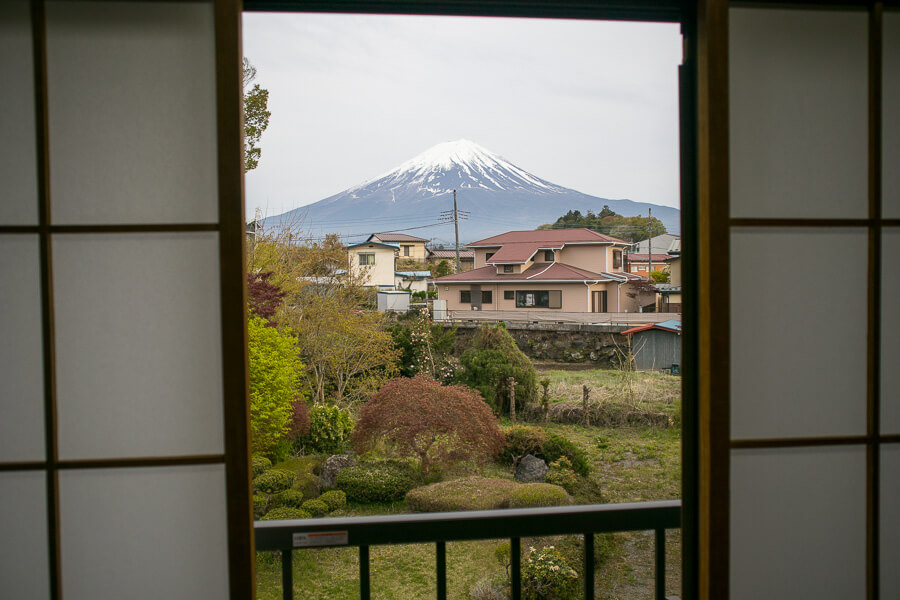
Where to Eat
Below are my tried and tested recommendations from our trip:
- Tanpopo : Unique family-run izakaya where the wife speaks to you via a hand-held translator. There are no menus and they serve you fresh seasonal local cuisine! Bookings required.
- Kosaku : A busy restaurant serving the regional specialty, Houtou noodles. Word of warning, the seating is traditional tatami mat style so wear stretchy clothes!
- FabCafe Fuji : A great coffee spot after a visit to the nearby Chureito Pagoda
- Ramen Kaneyuki : One of the few ramen restaurants in the middle of town. Meals are served in this casual, open-air restaurant out of a food truck.

After a few long days exploring and eating lunch out, we had some quick, easy and tasty grab-and-go dinner meals from the Ogino supermarket in town which we ate at our guesthouse.
How to Get to Fuji Five Lakes from Tokyo
Getting to Fuji Five Lakes from Tokyo is straightforward. I found it easiest (and cheapest!) to get the direct highway coach bus, but you can also catch the train.
I booked the highway bus from Tokyo Station to Kawaguchiko Station (buses also depart from Shinjuku Station). The bus travels directly between the two stations, with no transfers required and takes around 2 hours.
I purchased our tickets with Fujikyu Bus from Japan Bus Online and simply showed the driver our electronic tickets when boarding. This cost ¥2,060 per adult (2023 pricing).
By Train
Catching the train to Kawaguchiko will usually require at least one transfer .
Catch the JR Chuo Line from Shinjuku Station to Otsuki Station, and transfer to the Fujikyu Line to Kawaguchiko Station. This takes around 2 – 2.5 hours and costs ¥3,530 on the Limited Express train from Shinjuku.
There are also limited departures a day on a direct train which varies in length, depending on whether it is a Limited Express. It’s pretty easy to work out the best option, as both bus and train times and routes are synced into Google Maps.
In summary, getting the highway bus is often the cheapest and quickest route . Book your tickets a few days in advance, especially if travelling during peak periods.
How to Get Around Kawaguchiko and Fuji Five Lakes
The easiest way to get around the Fuji Five Lakes area is by rental car, especially if you’re planning to visit the other lakes or other attractions.
It’s also possible to get around by bus, but as we wanted to visit some attractions early in the morning and visit the other lakes, we decided for the convenience it was worth the cost to hire a car for our 3 days in Kawaguchiko.
Renting a Car in Kawaguchiko
We hired a car from Toyota Rent a Car near Kawaguchiko Station, however, the booking form was in Japanese which was quite challenging and a bit convulated to navigate. Step by step instructions are available here if you’d like to give it a go.
For an easier option, you can book a rental using Rental Cars with pick up from Mt Fuji Station / Fujiyoshida Station (as shown in the image below), which is only one stop further from Kawaguchiko Station.

Getting Around by Bus
Getting around Kawaguchiko by bus is another option. The tourist bus Omni Bus has three lines (red, green and blue) that run around Lake Kawaguchiko, Lake Shojiko and Lake Motosuko.
There is also the Free retro bus Fujikyu Loop Shuttle Bus (brown line).
You can purchase an Unlimited Ride Pass for 1,700 JPY per adult which covers 2 days of unlimited rides in all areas, or most buses accept Suica or Pasmo.
Click here for an easy-to-follow Omni Bus route map. For more information, timetables and all bus routes, you can find them here .
3 Day Kawaguchiko Fuji Five Lakes Itinerary

Day 1 of your Kawaguchiko itinerary will be spent exploring the northern side of Lake Kawaguchi .
Assuming you’ve come from Tokyo today, this might only be a half day, so if you run out of time you could always spend your last morning before departing Fuji Five Lakes to squeeze in any attractions you don’t get time for today.
Mt Fuji Panoramic Ropeway
I recommend visiting this panoramic lookout of Lake Kawaguchi and Mt Fuji early in the morning.
When visiting around midday, the lines were pretty long! This popular attraction involves catching a short cable car ride up the mountain to take in the incredible views from the Observation Area.
You can either hike or catch the cable car down. The hike down Mount Tenko is called the “Hydrangea Route,” due to the blooms of hydrangeas from mid-July to August. The trail is a great way to soak in extra views of Mt Fuji, without the crowds!
Open: Daily 9 am – 4 pm Entrance: ¥900 return cable-car trip, purchase at the counter or online
Continue around the edge of the lake to reach Oishi Park .
This spot has some spectacular views of Mount Fuji across the lake and is a lovely spot to go for a stroll and admire the gardens and seasonal flower fields. You’ll find a couple of cafes here and the Kawaguchiko Natural Living Centre, with a large range of Fuji-themed souvenirs and ice cream.

Kawaguchiko Music Forest Museum
We skipped this one, but one of the highly-rated museums and unique attractions in Kawaguchiko is the Kawaguchiko Music Forest Museum .
You might feel like you’ve stepped into a fairytale, the mediaeval-style buildings, a large collection of music boxes playing and an art garden on the shore of Lake Kawaguchiko.
Open: Friday – Monday, 10 am – 6 pm Entrance: From ¥1,800 on weekdays, ¥2,100 on weekends
Kawaguchi Asama Shrine & Tenku no Torii
In need of a coffee stop, we set out for the nearby Nagasaki Coffee Roasters . This was one of the best hand-drip coffees we had during our one month in Japan ! You’ll find this spot in a small hut near the entrance of the Kawaguchi Asama Shrine .

This shrine is impressive for its towering giant cedar trees that line the path to the shrine, and was a very serene and peaceful sanctuary to wander through after our coffee.
You can hike through the forest from the shrine to reach the Tenku no Torii viewpoint, which has become a popular Instagram photo spot, and costs ¥100 to enter with a timed stay of 3 minutes to reduce the length of the line of people queueing for a photo.
We’re not a big fan of queuing or over-commercialised attractions, so decided to skip this one (but the photos are pretty impressive).
I was SO excited to begin our second day in Kawaguchiko by seeing the famous Chureito Pagoda – this iconic spot has become a photo on postcards and tourism brochures worldwide, synonymous with Japan.
Luckily, we awoke to clear skies and views of Mount Fuji, so we quickly hurried to get to the pagoda before it got too busy.
Chureito Pagoda
Chureito Pagoda is located within Arakurayama Sengen Park and is reached via a steep 398-step climb part-way up the hill. It’s worth it though for the views that await – it felt like a dream come true to finally capture this iconic view through my own camera lens.
I recommend visiting as early as possible to get the best photos, as it’s a popular spot – for good reason!
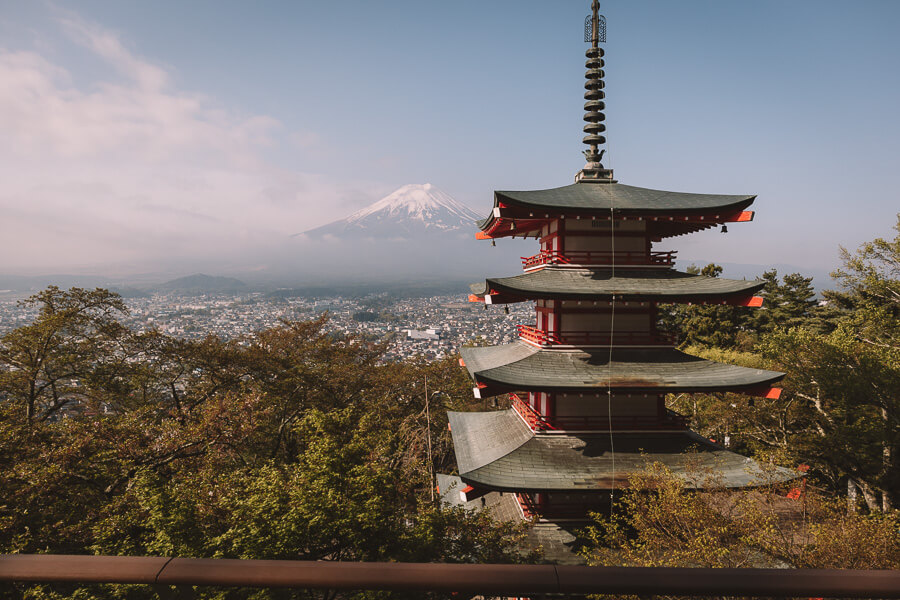
When visiting in late April, parking was free, however during peak periods like Cherry Blossom season, there is limited parking and a fee payable. After visiting the observation deck with the viewpoint of the pagoda and Mount Fuji, we walked for a further 10 minutes up the hill for another great viewpoint of Fujisan – and we had it ourselves!

At the base of the hill, there is a small shrine and an orange torii gate, and some food trucks were beginning to set up as we left around 9 am.
Shimoyoshida Street
In need of caffeine after our early start, we drove over to FabCafe Fuji for coffee and breakfast.
Outside the cafe, there were signs and even a traffic controller to stop people from walking out into the middle of the busy road to take photos of the picturesque street with views of Mount Fuji in the background.
I was excited to see this scenic street for myself after having seen some beautiful photos online, but it was pretty disappointing to see a lot of people jumping out onto the road to take photos in front of cars, and the obvious impact it was having on local businesses and residents with signs up everywhere encouraging people not to do this.
Kitaguchi Hongu Fuji Sengen Shrine
A short 5-minute drive took us to Kitaguchi Hongu Fuji Sengen Shrine.

My favourite part about this shrine was walking up the path through the forest to reach the shrine, surrounded by towering ancient cedar trees. Hikers seeking to scale Mount Fuji visit here before beginning the trail for a prayer for safety.

Open: Daily, 8.30 am – 5 pm Entrance: Free
Onshirin Garden
After spending some time wandering the shrine complex, we set off in search of a potential hidden gem near the shrine. Onshirin Garden wasn’t a spot listed on any tourist maps, and looking at the Google reviews it seemed more to be a popular playground for families.
What intrigued me though was a few photos of an incredible viewpoint of Mount Fuji, with fields of blue nemophila . This beautiful spring flower is most notably seen at the Hitachi Seaside Park near Tokyo, but I hadn’t heard of it in Fuji Five Lakes.
Our hunting paid off, and we came across this spectacular, quiet and free photo spot just near the entrance to Onshirin Garden.

Fujisan World Heritage Center
On the way back to Kawaguchiko, consider stopping in at Fujisan World Heritage Center.
This free visitor centre is a must-see if you are interested in learning more about Mount Fuji. Facilities include a 4D Theater, a 15-metre wide model of Mount Fuji, interactive exhibits and an observation viewing deck.
Ide Sake Brewery
In the centre of Kawaguchiko, you’ll find Ide Sake Brewery tucked away down a side street.
As big sake lovers (pretty much the reason we visited Takayama on this same trip!), we loved it.
This small family-run brewery produces both sake and whisky. You can do a self-pour tasting for ¥550 and sample a few different varieties of their products. There is also a small shop, where we picked up our own sake set to take home with us!
Ide Sake Brewery also runs guided tours in both English and Japanese – unfortunately, they were already fully booked on the day of our visit, but we would have loved to do this.
You can enquire online here .

On your third and final day of exploring Fuji Five Lakes, we’ll be exploring attractions outside of Lake Kawaguchi.
Fuji Shibazakura Festival
During my visit in the spring of 2023, the Fuji Shibazakura Festival was being held near Lake Motosu to the west of Kawaguchiko.

Typically held from mid-April to late May, this festival is popular for the incredible fields of bright pink moss phlox that cover the landscape, with breathtaking views of Mount Fuji in the background.

Even if you aren’t visiting during the festival period, the rest of the itinerary is still relevant as there are some unique things to see in this area to the west of Lake Kawaguchi.
Read my detailed guide on all you need to know about visiting the festival .
Lake Motosuko
After spending a few hours walking the grounds, taking many photos and having morning tea at the cafe onsite, we headed off to our next stop, Lake Motosuko.
Lake Motosu is featured on the 1000 yen bill. It’s also known as the mirror lake , due to the stunning mirrored reflection of Fuji – this is what we set off in search of.
Driving around the lake, there were camping grounds and campers set up right on the lake’s edge. Coming to Motosukotenbo Park , we pulled over and took these incredible photos of Mount Fuji and the lake. If you have a car, it’s well worth the short detour to visit this viewpoint.

Fugaku Wind Cave and Narusawa Ice Cave
On the highway driving towards Kawaguchiko, you’ll pass two ice caves, the Fugaku Wind Cave and Narusawa Ice Cave. There are thought to be over 100 caves at the base of Mount Fuji, as a result of volcanic eruptions creating lava caves.
We decided to stop and explore the Fugaku Wind Cave . Descending into the cave, you instantly feel the point that the temperature drops – it stays consistently around 0 degrees Celsius throughout the year in the cave. Due to this, the cave was used as a natural refrigerator and used to store silkworms.

It takes around 15 minutes to explore the cave, with the highlight being the impressive ice stalactites illuminated in the depth of the cave.
When you resurface, there is a 30-minute forest trail that connects the two caves.
We followed this trail, going for a walk in the serene Aokigahara Forest in favour of visiting the second ice cave.
There’s also a third cave a short drive away, the Bat Cave, which is also the largest of the three caves open to the public in the Fuji Five Lakes area.
Onsen with a View of Mount Fuji
As you head back to Kawaguchiko, you can stop at the Fuji Yurari Onsen for a blissful afternoon of relaxation.
With 16 hot springs including 2 outdoors with views of Mount Fuji, this is a great way to unwind after a busy few days exploring Fuji Five Lakes. Plus for an extra fee, you can also book a private onsen. Just note that no tattoos are allowed.
Alternative Day 3
An alternative option for a day trip from Kawaguchiko is visiting Oshino Hakkai .
Also a popular day trip from Tokyo, visitors can explore the small traditional village reconstruction surrounded by eight ponds, fed by spring water from the snow on the slopes of Mount Fuji.
As we had just visited the similar Hida Folk Village open-air museum in Takayama , we decided to skip this one, but it is an enjoyable (if somewhat touristy) alternative.
Another option for thrill-seekers is to spend the day riding the gravity-defying roller coasters at Fuji-Q Highland . This park is best known for its four giant roller coasters and anime-themed rides.
Buy your tickets online in advance for a discounted admission price.

Final Thoughts – Mount Fuji Itinerary
That wraps up this complete guide to Mt Fuji Lake Kawaguchi and the Fuji Five Lakes region. With this itinerary, you’ll uncover the highlights of the region plus a few unique things to do that aren’t possible on a day trip.
Let me know in the comments below if you have any questions about this Kawaguchiko guide, and check out my other articles to help you plan your Japan trip.
More Japan Guides:
- How to Easily Visit the Chureito Pagoda from Tokyo
- 10 Most Mesmerising Views of Mt Fuji from Kawaguchuiko
- An Exciting 4 Days in Osaka Itinerary for First-Timers
- Koyasan Temple Stay: Essential Travel Guide & Tips
- A Fun 7 Day Tokyo Itinerary: Complete 1 Week in Tokyo Guide
- A Perfect 4 Weeks in Japan Itinerary: Ultimate Travel Guide
- Takayama Itinerary: 2 Days Discovering Traditional Japan
TRAVEL PLANNING RESOURCES My tried and tested recommendations to make your next trip easier
🛡️ Travel Insurance: For my fellow Aussies, I use CoverMore for domestic and overseas travel insurance and they've been great to deal with. Travel with peace of mind knowing you're covered for unexpected events, ensuring a worry-free journey.
🌐 Stay Connected: After trying an eSim for the first time when travelling Japan & Europe for over 4 months in 2023, I'm officially converted! Thanks to Airalo , gone are the days of needing to physically swap plastic sim cards every time you enter a new country. Stay connected wherever you go by easily and affordably purchasing an eSim for all your travel destinations.
🚗 Easy Car Rental : Enjoy hassle-free car rentals on DiscoverCars with a wide range of options, competitive prices, and excellent customer service. I often find it's cheaper than booking direct, and I can compare a large range of suppliers to make sure I'm getting the best price.
💱 Access Local Currency: I've been using Wise in my business and on my travels to save on currency exchange and it's been a game changer! Wise provide a transparent and cost-effective way to access and manage local currency, with minimal fees and the best exchange rates compared to the traditional travel cards which sneakily charge extra fees and usually give you a poor exchange rate. Find out more here .
🏨 Accommodation: I book all my accommodation through booking.com . Discover their vast selection of accommodations worldwide, with great deals and flexible booking options. Plus, if you join their Genius Loyalty program, you get special benefits and discounts on selected stays.
🌟 Attractions & Tours: GetYourGuide is my preferred platform as they make it super easy to compare different tours, book experiences and get the best prices for tours across the world. I've downloaded their mobile app to have all my bookings in one place to easily pull up details when I've got multiple tours booked.
📸If you're wondering what I've used to capture the photos in this article, you can see what's in my camera bag here .
☕ Finally, if you found this free guide useful, you can buy me a coffee to say thanks :)
Just a quick note to let you know this post may contain affiliate links . At no extra cost to you, I receive a small commission on purchases made through these links. By doing so, you are supporting this blog and allowing me to continue providing you with free high-quality travel guides. Thank you!
2 thoughts on “Exploring Fuji Five Lakes: 3 Days in Kawaguchiko Guide”
Thank you. The link to book bus ticket from Tokoyo to fuji doesn’t show up kawaguchiko in the locations
Hmm, that’s strange I can see it when I look. Here’s the direct link (to/from Tokyo Station): https://japanbusonline.com/en/CourseSearch/11500410001?AreaCd=313
Leave a Comment Cancel reply
Save my name, email, and website in this browser for the next time I comment.
Truly Tokyo
A Tokyo Travel Guide
A Day Trip to the Mt. Fuji Area: Lake Kawaguchiko
There are a number of places to enjoy stunning views of Mt. Fuji, and one of the most accessible from Tokyo is Lake Kawaguchiko. Make the most of a day trip out to the area with this one-day itinerary.

There are many places to enjoy stunning views of Mt. Fuji, but few are as picturesque an area as Lake Kawaguchiko. Not only is it remarkably beautiful, there’s plenty to do in the area too. Active folks will want to cycle, hike, or go fishing; while those who prefer more leisurely activities might like to explore the many museums surrounding the lake.

Our itinerary takes you on a leisurely exploration of some great sights in the Lake Kawaguchiko area - with plenty of opportunities to enjoy the view of Mt. Fuji.

Notes Before You Go
- One of the most economical ways to travel to and from the Mt Fuji area is by highway bus from Shinjuku Station to Kawaguchiko Station. A single journey is JPY1750 and takes approximately 1 hour 45 minutes from the Shinjuku Bus Terminal. Return or one-way tickets can be booked online on the Highway Buses Japan site. You can also buy your ticket back to Shinjuku at Kawaguchiko Station once you’re there, though you may have fewer options on the day itself.
- We suggest taking an early morning bus - departing around 7:30am or so - to arrive at around 9:30am. This will give you a full day in the area.
- Bear in mind that the bus journey returning to Tokyo in the evening can coincide with rush hour, depending on your timing. Traffic conditions can slow down the journey considerably and take up to 3 hours. If you’d rather get back to Tokyo faster and don’t mind paying a little extra, consider taking the train.

- For getting around the Lake Kawaguchiko Area, we recommend purchasing a bus pass that gives you unlimited rides on the “Retro Bus” sightseeing bus lines. (A PDF version of the bus map can be found here and saved to your phone for easy access.) The stop numbers in this itinerary refer to the map of the Red Line in this PDF. Buses along the line operate at 15-minute intervals, so you’re never left waiting long before the next one comes along.
- The pass costs just JPY1500 and is valid for two days. It’s fantastic value even if you’re not staying overnight in the area. A one-way ride from the first stop to the last stop on the Red Line, for instance, costs JPY480. On a day trip, it’s entirely possible to recoup the cost if you use it frequently enough. Just show this pass to your driver every time you alight.

- An alternative if you’d rather have a more active day is to rent bicycles from the shop near Kawaguchiko Station. A non-electric bicycle costs JPY1500 to rent for the day, and you could easily do this itinerary on a bike rather than taking the bus. On a clear, cool day, this might be a good choice for the more athletic traveler. There aren’t dedicated cycle paths, however, so you’ll either be on normal roads or the pavements.
- Itinerary timings are approximate. Adjust them to suit your schedule. Add or subtract places from this itinerary as you prefer, but it’s generally better to enjoy a few places properly than to sprint through many places. The most important thing is to ensure that you’re back at Kawaguchiko Station in good time to catch your bus back to Shinjuku.

7:45am Shinjuku Bus Terminal
The easiest way is to find the Shinjuku Bus Terminal is to take the South Exit 南口 from JR Shinjuku Station. Once you’re outside the ticket gates, walk outside to street level.

You’ll see a building opposite the South Exit that looks like this. Cross the road and take the elevator up to the 4th floor as indicated in the photo (or the escalators).

Once you emerge from the escalator, there’ll be a map a little to your left showing you where the various bus stops are. Buses to the Mt. Fuji area typically depart from stops B5 or B6.
Sometimes it won’t be entirely clear which bus stop it is, but just bring your ticket to the bus station attendant and check with them. For this reason, it’s best to arrive at least half an hour before your bus is due to leave to give yourself extra time for the last minute things - like an extra cup of coffee from Family Mart.

9:30am Arrive Kawaguchiko Station
Once you alight at Kawaguchiko Station, the first thing you should do is to pick up a bus pass. You’ll want the 2-day sightseeing pass that’s valid across all lines - whether it’s the red, green, or blue lines.

While optional, you could pick up a copy of this tourist booklet. There are short guides to sights and restaurants in the area, and an overall map of the area at the back of the booklet. You’ll find this at the tourist information counter.

10:00am Mt. Kachikachi Ropeway to Tenjoyama Park
The cable car up to Tenjoyama Park, from where you’ll see a super view of Mt. Fuji, is actually about a 15-minute walk from Kawaguchiko Station. Since it’s the 11th stop on the line, riding the bus will take you on a more circuitous route. Both the bus ride and the walk are about 15 minutes. Alight at Stop 11.

On busier days, there might be a long queue snaking up the staircase. Have someone else in your group wait in line while you head upstairs to buy cable car tickets at the machine - it’s a JPY800 return journey. Cable cars run every 5-10 minutes, so you shouldn’t have to wait too long. It’s a 3-minute ride to the top of Mt. Tenjoyama.

On a clear day, the view from the observatory deck is pretty impressive - even if the top of Mt. Fuji happens to be obscured by a passing cloud.

Take a few minutes to poke around the kitschy rabbit and tanuki-themed shrines and souvenir shop before heading back down. For the energetic, there’s a gentle 40-minute hiking trail leading down from the top of the mountain, which is particularly pleasant in cooler weather.

11:30am Lunch at Hōtō Fudō
Once you’re done with the pretty views, take the cable car back down and return to Stop 11. Take the bus to Stop 17, which is outside the Music Forest Museum.

Cross the road and head towards the nearest intersection as pictured above. Cross the road and take the small path running parallel to the main road. You’ll pass through some fields and a few standalone houses. Hōtō Fudō is the large restaurant across the road at the end of the path.

You’ll be eating Hōtō noodles here. There's almost nothing else on the menu, save for some decent simmered intestines, inarizushi (rice in tofu pockets), and Japanese pickles. These noodles are a local Yamanashi specialty, consisting of thick, chewy wheat noodles (texturally rather like rustic dumplings, or knife-cut Chinese noodles) and simmered seasonal vegetables in a rich miso-based broth. Don’t forget to stir in some shichimi chili powder.

Diners have the option of tatami mat or table seating. We suggest asking for seats by the window - the cool breeze blowing in makes the hot noodles go down a treat.
If you’re not keen on wheat noodles for lunch, skip this and head straight to the next stop. There’s a cafe at the Kawaguchiko Natural Living Center with curry rice options.

12:45pm Kawaguchiko Natural Living Center
Walk back to Stop 17. It’s a short 10-minute ride to the end of the line - the Kawaguchiko Natural Living Center.

Skip the souvenir shop and walk around the flower gardens - you’ll see all kinds of blooms across the seasons, from lavender and hydrangeas to bellflowers and roses.

It’s a heavily manicured garden, with plants in overly-neat, fussy rows. Still, it’s quite picturesque if you enjoy this style of garden. Plus, there's a magnificent view of Mt. Fuji with the lake in the foreground. Have an ice cream. Take some time to enjoy the surroundings.
During the summer, you can also sign up for a fruit picking session. This will vary with the weeks, but options might include cherries, blueberries, and cherry tomatoes. While the fruit farms aren’t located on the grounds of the center, the staff provide free transport to and from the farms after you sign up for a session (approximately 40 minutes of picking and eating). If you decide to include this in your itinerary, budget around an hour to an hour and a half spent at the center.

2:15pm Itchiku Kubota Art Museum
Hop back on the bus, this time heading back towards Kawaguchiko Station. Alight at Stop 19 for the Itchiku Kubota Art Museum.
Even if you’re not a huge fan of art museums, this one is worth visiting for the natural space it's in. The doorway to the museum looks like the entrance to hidden ancient ruins of some kind. Walk through and you'll find a gorgeous little waterfall with benches at the side. It's a wonderful place to lie down on a bench and nap - or stare at the shifting sunlight in the maple boughs above.

Entrance to the museum proper is JPY1,300 per person. The buildings are made of Okinawan corals and limestones, and they're almost more interesting than the objects they house - an eclectic collection of primitive art and Itchiku Kubota's beautiful tie-dyed painted silk kimono. With one exception, photography inside the museum is not allowed.

The tea room on the second floor of the main museum building is worth spending some time in. This looks out into a small waterfall and pond in an overgrown grove. The view is even prettier in the autumn when the fall colours are out. It's a lovely place to enjoy a cup of tea and some sweets; and photography is allowed here. When there are few visitors around, the staff won't mind if you take a seat to enjoy the view.

Don’t forget to explore the north side of the main building. Turn right as you exit and follow the path up into the forest. It’ll lead you to a mildly eerie, dimly-lit cave with a few statues inside - the source of the ice cold water streaming down the mountainside.

3:15pm Maple Corridor
After you’re finished with the museum, walk back to the main road, and through the Maple Corridor. It’s a short path flanked by maple trees on either side. It's best visited in autumn for the fall foliage.

3:30pm Ubuyagasaki Cape and Crossing Kawaguchiko-ohashi Bridge
Make your way back out to the main road and back to the same bus stop from before (Stop 19). Alight at Stop 15. Cross the road, heading to the lakeside walking path. The views of the lake and Mt. Fuji are fabulous.

Follow the path, all the while skirting the edges of the lake. Turn into the canopied walking path.

Further along, you’ll encounter a set of stone steps. Climb up.

You're now on Ubuyagasaki Cape, where you’ll see another view of Mt. Fuji.

Go back down and find your way onto the bridge. Walk across to the other side of the lake. It's a leisurely stroll that shouldn't take more than 15 - 20 minutes. If it's hot and sunny, we recommend parasols and plenty of water.

We recommend walking down to the lake shore after you reach the other side. Spend some time enjoying the waters - and the fabulous views.

4:15pm Tea time
It's time for a mid-afternoon pick-me-up. Find your way back to the main road from the lake shore. Turn left and walk up the road. The nearest stop is Stop 8, further up the road opposite the Yamanashi Gem Museum.
Ride the bus to Stop 10. Directly outside this bus stop opposite the road is a charming cafe with a frontal view of the lake - coffee and sweets.

Alternatively, ride the bus to Stop 11. Walk back the direction the bus came in until you see Cheesecake Garden on your left across the road. As the name suggests, it’s all about the cheesecake. There are around a dozen different kinds of cheesecake available, and every slice comes with a free cup of coffee.
5:30pm Kawaguchiko Station
Head back to Kawaguchiko Station in time for your bus back to Shinjuku Station. Generally it's best to time your arrival a little earlier than your intended departure time. Things can get a little chaotic around the bus stops, since traffic along the highway can cause bus delays. If that happens, it's best to show the bus attendants your ticket every time a bus to Shinjuku appears.
Mt. Fuji Area - Lake Kawaguchiko Day Trip Map
View the full size version of our Lake Kawaguchiko map which has each of the places discussed above marked on it.
Climbing or Visiting Mount Fuji from Tokyo
For more information about climbing Mount Fuji or other ways to enjoy the area, read our Climbing Or Visiting Mount Fuji guide here.
Check Hotel Availability
Destination, check-in date, check-out date.

Tokyo Vacation Checklist
- For all the essentials in a brief overview, see my First Time In Tokyo guide
- Check Tokyo accommodation availability and pricing on Booking.com and Agoda.com - often you can book with no upfront payment and free cancellation
- Need tips on where to stay? See my one page guide Where To Stay In Tokyo
- You can buy shinkansen (bullet train) tickets online from Klook - popular routes include Tokyo to Kyoto , Tokyo to Osaka and Tokyo to Hiroshima
- You can buy a Japan SIM card online for collection on arrival at Tokyo Narita or Haneda airports. Or rent an unlimited data pocket wifi router
- See my comprehensive Packing List For Japan
- Compare airline flight prices and timings for the best Japan flight deals . Check my guides to arriving at Narita Airport and at Haneda Airport .
- If you're visiting more than one city, you might save money with a Japan Rail Pass – see if it's worth it for you
- A prepaid Welcome Suica card makes travelling around Tokyo much easier - here's how
- World Nomads offers simple and flexible travel insurance. Buy at home or while traveling and claim online from anywhere in the world
Tokyo District Map

- Imperial Palace Area
- Tokyo Station
- Shimbashi Shiodome Hamamatsucho Shinagawa
- Akihabara Kanda
- Roppongi Akasaka
- Harajuku Aoyama
- Ebisu Daikanyama Meguro
Disclosure: trulytokyo.com is a participant in the Amazon Services LLC Associates Program, an affiliate advertising program designed to provide a means for sites to earn advertising fees by advertising and linking to amazon.com and amazon.co.uk. World Nomads provides travel insurance for travellers in over 100 countries. As an affiliate, we receive a fee when you get a quote from World Nomads using this link. We do not represent World Nomads. This is information only and not a recommendation to buy travel insurance.
- Things to Do
- Tourist Spots & Attractions
10 Places to Visit in Lake Kawaguchiko for a Fun Time Near Mt. Fuji

- Jen Laforteza
- Steve Csorgo
The tranquil beauty of Lake Kawaguchiko has been inspiring people in Japan for hundreds of years. Nowadays, Lake Kawaguchiko is no longer just a pretty view – the area also boasts a wide variety of attractions, from stunning Mt. Fuji panoramas to thrilling rides at Fuji-Q Highland. In this article, we’ll introduce 10 of the best places to visit in Lake Kawaguchiko, plus some recommended activities, foods, accommodation, and more!

This post may contain affiliate links. If you buy through them, we may earn a commission at no additional cost to you.
What Sort of Place Is Lake Kawaguchiko?
Lake Kawaguchiko is located in Yamanashi Prefecture, less than a two-hour train ride from Tokyo. It is the second largest of the Fuji Five Lakes, which is the collective name for the group of lakes found at the base of Mt. Fuji. The Fuji Five Lakes were formed from lava that flowed out of Mt. Fuji to the foot of the Misaka Mountains, creating multiple spots with sunken ground that became giant lakes and rivers. These were further shaped and dammed up by continued eruptions over the following millennia, crafting the landscape we see today. Lake Kawaguchiko is also a part of Fuji-Hakone-Izu National Park and the Mt. Fuji World Heritage Site, making it one of the most notable spots in Japan.
Kawaguchiko Station, the area’s main transport hub, can be reached directly from Tokyo, and offers easy access to many of the main interest points via train or bus. The wealth of attractions, hotels, restaurants, hot springs, shops, and activities that surround Lake Kawaguchiko mean you don’t have to go far to find fun and relaxation. From the fleeting beauty of spring and fall to the dusting of snow in winter and bustling Mt. Fuji climbing period in summer, Lake Kawaguchiko’s stark seasonal transformations ensure there’s always something fresh and exciting, making it worth visiting again and again.
10 Places to Visit in Lake Kawaguchiko
Mt. fuji panoramic ropeway: superb views of lake kawaguchiko.
The Mt. Fuji Panoramic Ropeway is one of the easiest and most fun ways to enjoy 360-degree, unobstructed panoramas over Lake Kawaguchiko.
The cable car ride lasts about 3 minutes and ascends to Kawaguchiko Tenjozan Park, which also has a 1,075-meter-high observation deck with splendid Mt. Fuji vistas. Also in the park is a swing set, where you can take photos that appear as if you’re leaping into Mt. Fuji, along with a mini-shrine themed around rabbits, a monument to the acclaimed author Osamu Dazai, and plenty of other highlights to check out, plus trails for those hiking.
The Mt. Fuji Panoramic Ropeway is also one of the many stops on the Mt. Fuji Flower Festival Tour. The tour wraps up here for a picturesque end to the day after all-you-can-eat seasonal fruit-picking, tours of local flower and herb festivals, a lunch of hoto noodles at Mt. Fuji’s 5th Station, and more.
Kawaguchiko Music Forest Museum: Get Lost in the Sounds of Automatic Musical Instruments
Music-lovers will no doubt have the Kawaguchiko Music Forest Museum high on their “Kawaguchiko things to do” list! The museum’s quaint European-style building features a collection of magnificent automatic musical instruments dating back to the early 1900s, including an orchestrion originally designed for the Titanic!
Performances of these automatic instruments take place daily when open, in addition to weekly live operas, lunchtime musical festivities, and other entertaining productions, usually concentrated on weekends. The museum shop stocks a selection of delightful music boxes, including those with Studio Ghibli and Edo Period designs. This Kawaguchiko tourist spot is also adored for its colorful gardens, which include one of Japan’s best rose gardens, and were painstakingly designed to have flowers blooming all year round. During the winter months, a glittering garden illumination takes over the scene once the sun goes down.
Chureito Pagoda: The Definitive Picture of Japan
Look up photos of Mt. Fuji, and you’re guaranteed to see the Chureito Pagoda. This five-storied pagoda is a timeless Japanese icon and a must-see for travelers seeking the ultimate Japan photo!
Constructed as part of Arakura Sengen Shrine in 1963, the Chureito Pagoda serves as a peace memorial dedicated to war victims of Fujiyoda City. From the shrine grounds, visitors will climb a hefty 398 steps to reach the pagoda - all worth it once you get to the observation deck! Alongside the dazzling vermillion pagoda, these unparalleled Mt. Fuji views are often framed by seasonal splendor like red maple leaves or cherry blossoms, so try and time your visit with their peak!
The Chureito Pagoda is consistently ranked as one of the best places to visit in Lake Kawaguchiko. Naturally, it’s included as one of the stops on the Mt. Fuji Day Tour, which is perfect for those short on time but who don’t want to miss out on essential spots.
Fuji-Q Highland: A Thrilling Amusement Park Next to Mt. Fuji
Filled with thrills, chills, and splashes, Fuji-Q Highland has all the excitement you could ever need. This beloved amusement park boasts not one, not two, but four rollercoasters – three of which hold world records! The famous Fujiyama rollercoaster gives you an unbeatable view of Mt. Fuji right before it sends you hurtling down a steep drop. There’s also a water ride, pendulum ride, drop tower, haunted house – just to name a few!
It might seem like Fuji-Q Highland is meant solely for thrillseekers, but this Lake Kawaguchiko attraction has plenty of fun family activities, too. You have your classic spinning tea cups, merry-go-rounds, and Ferris wheels, along with Thomas Land, which has Thomas-themed attractions like a mini rollercoaster and playground. Older kids will also love the sections dedicated to popular anime like Naruto.
The handy Fuji-Q One-Day Pass offers unlimited rides in the main Fuji-Q amusement park area and Thomas Land. The pass is a great way to freely explore Fuji-Q Highland and have as much fun as you can handle!
Oshino Hakkai: Crystal Clear Springs From Mt. Fuji’s Snowy Peak
Oshino Hakkai is a set of eight ponds born from the melted snow of Mt. Fuji, which is naturally filtered over decades to reemerge as pristine spring water. These waters are revered by locals for their extraordinary clarity, and visitors can even drink out of one pond to relish the clean, refreshing taste.
Oshino Hakkai is also another charming vantage point to take in Mt. Fuji, complemented by traditional Japanese thatched roof farmhouses and abundant greenery. There are also lots of souvenir shops and stalls selling local produce and products inspired by Mt. Fuji, alongside eateries serving dishes utilizing Yamanashi specialities.
Aokigahara: A Fascinating Forest for Hikers and Cave Explorers
Aokigahara is a lush, spacious forest located north of Mt. Fuji, and is considered a Natural Monument of Japan. It has gained the unfortunate reputation as Japan’s “suicide forest” overseas, but locally, it attracts visitors through nature-rich hiking trails and alluring caves.
Its proximity to Mt. Fuji means that Aokigahara’s floor is mostly made out of volcanic rock, and the forest is blessed with a set of diverse caves. The Fugaku Wind Cave is one of the most popular. The cave’s internal temperature is around 3°C, and if you brave the cold, you’ll find illuminated ice and stalactites deeper inside. Only a 15-minute walk away is the Narusawa Ice Cave , which has an even more impressive collection of illuminated ice pillars visible all year round. These caves are easy to access via car or bus, and even have souvenir shops nearby, so there’s no need for a lengthy expedition.
Oishi Park: Clear Views of Mt. Fuji With Local Fruit
Located on the northern edge of Lake Kawaguchiko, Oishi Park presents a spectacular view of Mt. Fuji. In the early mornings of sunny days, an “inverted Fuji” appears from the mountain being perfectly reflected on the crystal clear surface of Lake Kawaguchiko. Between late April to October, Mt. Fuji is further framed by Oishi Park’s colorful flower fields, which include a lineup of tulips, lavender, and begonias, just to name a few.
In summer, the neighboring Kawaguchiko Natural Living Center opens up to visitors who want to try their hand at picking produce from their farm, the most coveted of which are blueberries between early July and early August. All around is evidence of how proud the locals are of their produce – from the range of blueberry souvenirs at Kawaguchiko Natural Living Center to Oishi Park Café’s one-of-a-kind blueberry ice cream.
Momiji Corridor: Autumn Views Like No Other
Lake Kawaguchiko’s Momiji Corridor (Maple Corridor) is a must-see for those visiting in autumn. During much of the year, this “corridor” is just a small canal covered by lush greenery. But once fall rolls around, it undergoes a complete transformation, becoming one of Japan’s best autumn foliage hotspots.
The maple trees lining the canal burst with dazzling shades of red and orange from late October to early-mid November (depending on the year). If you stay until after sunset, the corridor is illuminated by a romantic light up. For a double dose of autumn radiance, the acclaimed Momiji Tunnel is a 10-minute drive away.
Oike Park: Enjoy Herbs, Gems, and More While Strolling Around
Oike Park is a small park on the southeast edge of Lake Kawaguchiko. While it may not be one of the most popular places for tourists, locals adore it as a spot for blissful strolls and fishing. Every January and February, the Lake Kawaguchiko Fireworks are held here on weekends, and it is often full of spectators.
A few steps away from Oike Park are two other places of interest. Right across the park is Kawaguchiko Herb Hall, which sells an amazing selection of herbs, herb products, and colorful pressed flowers - plus tasty lavender-flavored ice cream! Three minutes away is the Yamanashi Gem Museum, which displays over 3,000 gems from around the world – including a giant quartz crystal all the way from Brazil!
Forest Adventure Fuji: Wholesome Family Fun Up in the Trees
If you want to get some cardio in with the kids, Forest Adventure Fuji offers the perfect balance of exercise, fun, and thrills. Their exciting obstacle courses take you high up into the trees through all sorts of activities – swinging, climbing, crossing rope bridges, tightrope walking, among many others.
Forest Adventure has obstacle courses all over Japan. The Fuji branch, located south of Lake Kawaguchiko, has two courses: the Trek Course with 11 sites and over 90 different activities, and the Excite Course, which costs an additional fee but offers another four activities. Kids from elementary school age and older can experience Forest Adventure Fuji together with adults, turning family bonding time into a daring yet safe adventure not far from Lake Kawaguchiko.
Things to Do in Lake Kawaguchiko
Even without a particular place in mind, you won’t run out of activities to do in Lake Kawaguchiko. Below are some of the most popular things to do in the area!
Lake Kawaguchiko Sightseeing Boats
For several months each year, dazzling sightseeing boats cruise around Lake Kawaguchiko, taking passengers on leisurely journeys circling the lake with Mt. Fuji visible on clear days. Two of the most iconic boats are the “Appare,” modeled on an ancient Japanese warship, and the submarine-shaped “Moguran.” One 20-25 minute round trip on these boats only costs 1,000 yen for adults and 900 yen for kids. You can see their operating periods and other details on the official website.
Cycling Around Lake Kawaguchiko
With most attractions concentrated in a single area, Lake Kawaguchiko is a cyclist’s paradise. Dotting Lake Kawaguchiko are several bike rental shops with a wide selection of bikes, including electric bikes and more. You can choose how long you want to rent the bike for, from as short as 3 hours to overnight. As the bus timetable can be confusing, cycling is a more convenient and healthy way to explore the places to visit in Lake Kawaguchiko introduced in this article.
For cycling in Lake Kawaguchiko, we recommend the Lake Kawaguchiko Tour Course. It starts off at Fujisan Parking Lot, passes through tourist spots like Oishi Park and Momiji Corridor, and circles around the lake before ending back where you started. The course covers approximately 26 kilometers of flat roads, making it very doable for even beginner cyclists.
Hiking in Lake Kawaguchiko
Lake Kawaguchiko is surrounded by trails suiting every level of hiker, making it another of the popular things to do in Lake Kawaguchiko. One of the previously mentioned Lake Kawaguchiko tourist spots, the Mt. Fuji Panoramic Ropeway, has a popular hiking trail leading to the observation deck called the “Mt. Tenjo Hydrangea Hiking Course,” named after the hydrangeas that bloom in summer. The trail takes less than an hour to complete, and is a good choice for beginners.
More experienced hikers can continue past this trail and hike up Mt. Mitsutoge. It takes a total of six hours to do a roundtrip climb, so allow for enough time to get back before dusk. Those experienced enough to take on the trail can expect an amazing view of Mt. Fuji from the summit.
Hoto Noodles: Lake Kawaguchiko’s Most Famous Dish
No trip to Lake Kawaguchiko is complete without trying their famous regional food: hoto noodles. This traditional hotpot uses a unique type of noodle similar to udon, but with a flat shape and chunkier bite. The broth is made from a simple miso base with lots of seasonal vegetables like pumpkin, carrots, and mushrooms. Many restaurants around Lake Kawaguchiko serve hoto noodles, often adding their own spin to the dish. Being highly nutritious and filling, it’s easy to understand why it was apparently eaten by Yamanashi’s famous feudal lord, Takeda Shingen, before facing battle.

Things to Do in Lake Kawaguchiko at Night
The fun doesn’t stop at sundown in Lake Kawaguchiko - there are plenty of things to do at night! The lake bespeckled by lights is utterly entrancing, and can be appreciated from numerous viewpoints. One such lookout is Ubuyagasaki Shrine , which is a 35-minute walk from Kawaguchiko Station (Fujikyuko buses don’t run after 7:00 pm, but there are hotels nearby.) The shrine itself sits atop a small hill, and around it is an open space made for taking in the view. The area is dark, so be sure to bring a flashlight.
If you’re in the mood to relax, there are several hot springs, or “onsen,” that stay open after dark in Lake Kawaguchiko. These hot springs are the perfect solution for muscles tired from long days of sightseeing. You can also dive into Lake Kawaguchiko’s renowned culinary scene for dinner. There are loads of restaurants to check out, including those specializing in sushi, wagyu steak, teppanyaki, and the aforementioned hoto noodles.
As you can see, the sheer amount of things to do and places to visit in Lake Kawaguchiko makes it worth staying overnight. Thankfully, there are numerous hotels lining the lake suiting all budgets, from luxury resorts to comfy guesthouses. Many accommodations around Lake Kawaguchiko also offer unique Japanese experiences like bathing in hot springs and heartfelt “omotenashi” service.
Hot Spring Hotel in Lake Kawaguchiko: Oike Hotel
Traditional Ryokan Inn in Lake Kawaguchiko: Hotel Asafuji
How to Get to Lake Kawaguchiko From Tokyo
Lake Kawaguchiko is easy to get to if you’re coming from Tokyo. You can take the highway bus from Shinjuku Station, which will take around 1 hour and 45 minutes to reach Kawaguchiko Station. Highway bus tickets can be purchased online or at the Shinjuku Bus Terminal.
By train, the most direct way to get to Lake Kawaguchiko from Tokyo is via the Fuji Excursion Express , which opened in 2019. The line departs from Shinjuku Station, and will take you to Kawaguchiko Station in 1 hour and 50 minutes.
To save on train fees, you can instead purchase the JR TOKYO Wide Pass. For 3 days, you can use it for unlimited rides on JR trains and certain non-JR trains within and around Tokyo. This pass is very useful for a Lake Kawaguchiko trip, since it covers the Fuji Excursion Express and the Fujikyuko Railway Line, the latter of which can be used to move around Lake Kawaguchiko.
Another pass that makes it more convenient to travel around Lake Kawaguchiko is the 3-day JR Mt. Fuji Shizuoka Area Tourist Pass Mini . Some of the Lake Kawaguchiko sights included in this article can be reached via Fujikyuko buses, and this pass grants you unlimited rides on certain routes (some services are not included, plan carefully before purchasing). There are also unlimited ride passes available from Fujikyuko for the Kawaguchiko Sightseeing Bus and more, which can be purchased at the Kawaguchiko Station ticket office.
Lake Kawaguchiko: Paradise by Mt. Fuji Just a Hop Away From Tokyo
With its easy access from Tokyo and so many places to visit, Lake Kawaguchiko is a prime destination for leisurely sightseeing, heart-pounding thrills, and everything in between. There’s no running out of things to do in Lake Kawaguchiko – and every moment will be blessed by the magnificent silhouette of Mt. Fuji in the background. All of this is why Lake Kawaguchiko has earned itself a grand reputation in Japan, with more and more international sightseers starting to recognize its appeal, too!
Top image: PIXTA
If you want to give feedback on any of our articles, you have an idea that you'd really like to see come to life, or you just have a question on Japan, hit us up on our Facebook , Twitter , or Instagram !

The information in this article is accurate at the time of publication.
tsunagu Japan Newsletter
Subscribe to our free newsletter and we'll show you the best Japan has to offer!

- fuji five lakes
- amusement park
- local cuisine
About the author
Related Articles
Related interests.
- Otaru canal
- Umeda sky building
- Rainbow bridge
- Tokyo skytree
- Tokyo tower
- Imperial Palace
- World heritage sites
Restaurant Search
Tsunagu japan sns.
Subscribe to the tsunagu Japan Newsletter
Sign up to our free newsletter to discover the best Japan has to offer.
Connect with Japan through tsunagu Japan
Let us introduce you to the best of Japan through our free newsletter: sightseeing spots, delicious food, deep culture, best places to stay, and more!
- Tokyo Cheapo (繁體中文)
Tokyo to Kawaguchiko: Take a Day Trip to Fuji's Nearest Neighbor
Kawaguchiko has some of the best views of Mount Fuji in Japan — reflected across a lake, or foregrounded by fields of lavender — and there’s no shortage of things to do there, either. Here are a few tips for a day trip from Tokyo to Kawaguchiko.
The second biggest and most accessible of the Fuji Five Lakes, Kawaguchiko has a wealth of natural resources, with stunning autumn leaves, cherry blossoms, and flower festivals galore. With direct transport — a two-hour bus or train — from Tokyo to Kawaguchiko, it’s an unsurprisingly popular spot, and well worth a day trip.
The need to escape city streets can be strong, and there is nowhere better to get in touch with nature, as well as tick off the biggest sight in Japan. If you are planning to size up the beast before you climb , there are buses to Fuji’s 5th station available from Kawaguchiko too. With onsen , art museums, and seasonal delights, there are plenty of things to do throughout the year, so add Kawaguchiko to your bucket list!
Getting from Tokyo to Kawaguchiko
We’ve given a quick overview below but for more information, please see our Tokyo to Mount Fuji transport guide .
Private Driver
If you’re happy to pay a bit more for convenience and flexibility, then this very reasonably priced private driver service costs ¥ 66,000 for 4-7 people and is the smoothest way to enjoy the Mount Fuji area. Having a private driver pick you up from your hotel and not having to figure out schedules/queues for buses makes for a nice hassle-free day!
From JR Shinjuku Station, you have three options. The fastest is the direct Limited Express Fuji Excursion service, which takes 1.5 hours and costs ¥ 4,130 . For a middle option on price and time, you can take a Limited Express Kaiji to Ōtsuki and then hop on the Fujikyū railway to Kawaguchiko — this takes just over two hours and costs ¥ 3,530 . If you want to save your cash, you can catch a local train (possibly changing at Takao, depending on the times) to Ōtsuki instead, which brings your travel time up to about 2.5 hours but costs ¥ 2,510 .
To avoid the inevitable line at Kawaguchiko Station, you could catch a highway bus from stations across Tokyo, including Shinjuku, Shibuya, and Tokyo. Tickets start around ¥ 2,000 and the ride takes about two hours, stopping at Fuji Q Highland on the way. You can book the return trip here .

Tours from Tokyo to Kawaguchiko
If you can’t be bothered to delve into the intricacies of public transport, then it’s worth hopping on a day tour from Tokyo. This highly rated day trip on Viator which includes the famous Chureito Pagoda Mount Fuji view, Kawaguchiko, and a visit to a traditional thatched roof village . Also worth mentioning is this tour where you ride the bus to Mount Fuji 5th Station, then to Hakone and transfer to take the bullet train back to Tokyo (NB there’s no stop at Kawaguchiko). If you need any more ideas, there’s a wide range of Mount Fuji excursions here on Viator .
Getting around Kawaguchiko

The easiest option to access most sights around Kawaguchiko is to make use of the sightseeing buses. There are three main bus lines: Red, Green, and Blue, all departing from Kawaguchiko Station. You can purchase a two-day ticket for ¥ 1,700 . There are also passes that include the ropeway and sightseeing boat for ¥ 2,800 . IC cards also work on trains and local buses. Another option is to rent a bicycle — there are a few stores dotted around the area.
Top things to do in Kawaguchiko
Since everything in Kawaguchiko comes with the bonus of Japan’s most famous mountain in the background, you can’t really go wrong, no matter what you decide to explore. If you decide there’s too much to cram into a single day, then check out the options for spending a night in the shadow of Mount Fuji . There’s plenty to see in the area, but here is a selection of some of the top spots.
Mt. Fuji Panoramic Ropeway
Sightseeing Boat/Ropeway Entrance Stop (No. 9) via the Red Line Bus

The ropeway gives fantastic views of both Mt. Fuji and Lake Kawaguchiko, reaching an altitude of 1075 meters (3527 ft) at its highest point. It runs up to Fujimidai Station on top of Mt. Tenjō within three minutes. The observatory has grown in recent years and has plenty of photo spots and even some games to try out. The ropeway is the setting for a story written by one of Japan’s literary masters, Osamu Dazai, which describes raccoons and rabbits being placed on gondolas and around the observatory to welcome guests.
If you’re looking for more views of Fuji, we have some great alternative hikes with stunning vistas to consider!

Oishi Park and Kawaguchiko Natural Living Center
Kawaguchiko Natural Living Center Stop (No. 20) via the Red Line Bus

To view Mt. Fuji from fields of lavender and blueberries is a pretty awesome experience and one you can get at the Kawaguchiko Natural Living Center and nearby Oishi Park. The lavender is in peak bloom in mid-June, which is also when the nearby herb festivals take place. From July to mid-August, you can pick your own blueberries and other fruit at nearby farms. This can be organized by the center. But no matter when you go, the view will still be spectacular.
Kawaguchiko Natural Living Center
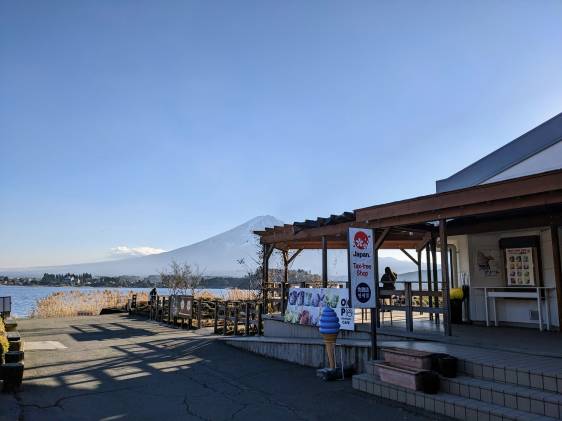
Itchiku Kubota Art Museum and The Maple Corridor
Itchiku Kubota Art Museum Stop (No. 17) via the Red Line Bus

The museum has numerous examples of work by Itchiku Kubota, a world-renowned specialist in the ancient art of fabric dyeing. This includes beautiful kimono, as well as a tearoom with stunning views across the lake of Mt. Fuji. There are gardens surrounding the museum, with mini waterfalls and forests. The museum is also close to the Maple Corridor , one of the best spots in the whole area for autumn leaves — it even has its own festival . The Momiji Tunnel is a little closer to the lake.
If you fancy more day trips for autumn leaves, see our guide to fall day trips from Tokyo for ideas.
Itchiku Kubota Art Museum
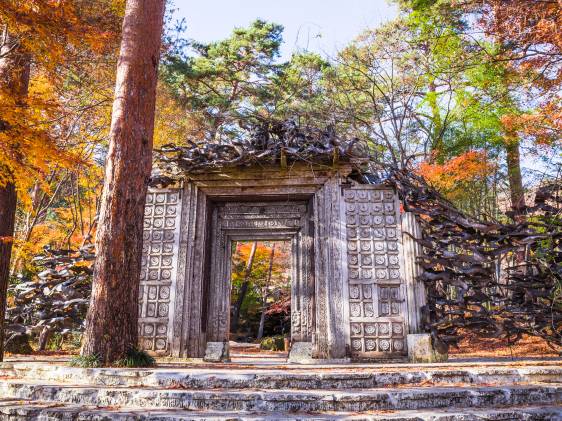
Fuji-Q Highland Amuseument Park
Fuji-Q Highland Stop (No. 105) via the local route bus (included in bus pass) or train to Fujikyu Highland Station

A theme park so dedicated to breaking world records it builds a new rollercoaster every five years just to do so, Fuji-Q Highland is a great place if you want to be scared out of your wits. There are multiple ways to achieve this, of course, from the terrifying drops and knee-buckling speeds of the rides to the horrifying haunted house. With views of Fuji-san as you rocket at speeds of up to 172km/hr, this is a different way to enjoy the greatest sight of Japan. A direct bus from Tokyo is also available.
Pro tip: If you’re keen on Fuji-Q, it’s worth considering a Mt. Fuji Pass — this covers your entrance, plus a bunch of other attractions and transport.
Fuji Q Highland
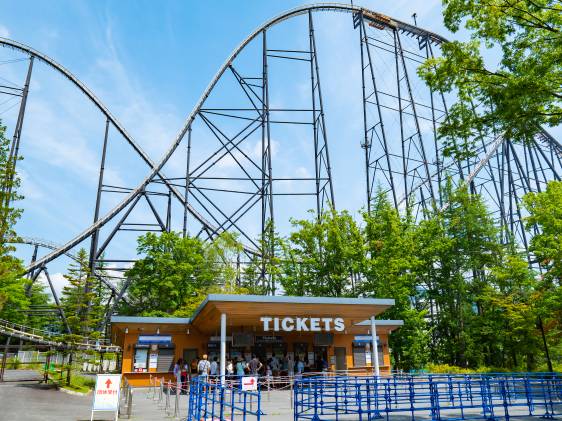
Kawaguchiko Music Forest Museum
Kawaguchiko Music Forest Museum Stop (No. 15) via the Red Line Bus.

A slightly strange attraction but popular nonetheless, the Music Forest Museum is dedicated to a mostly European collection of automatic musical instruments. The biggest attraction is the French fairground organ from 1905 which plays every 30 minutes. There are European-style gardens with views of Mt. Fuji, as well as shops, a chapel, rose garden, and restaurant. The stylized design of the museum and gardens creates quite a surreal setting and it’s very pretty — reminiscent of a fairytale cottage.
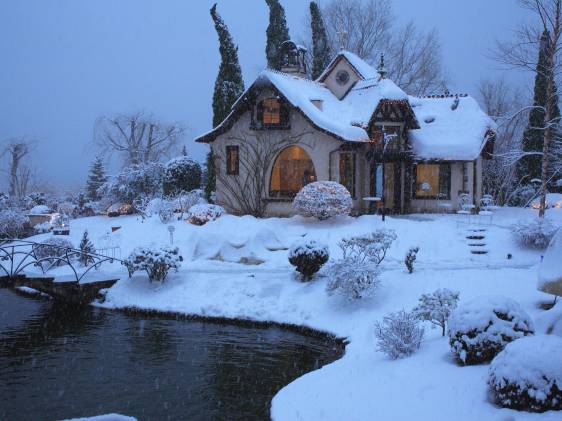
Eat hōtō noodles: the local specialty
Various spots on the Red Line Bus route, including at Kawaguchiko Station

While you’re in Yamanashi Prefecture, you’ll want to try the local noodles to complete your experience. These unusually flat noodles are cooked in a miso soup with vegetables to create a nourishing bowl of hearty goodness, similar to a stew. Despite looking like udon (albeit flatter), the noodles are prepared similarly to dumplings. There are plenty of places to try the dish — just keep your eyes peeled as you pass restaurants. If you want to plan ahead, the restaurant chain Hōtō Fudō has restaurants around the lake and a great reputation for high-quality noodles.
Hōtō Fudō Kawaguchiko Station
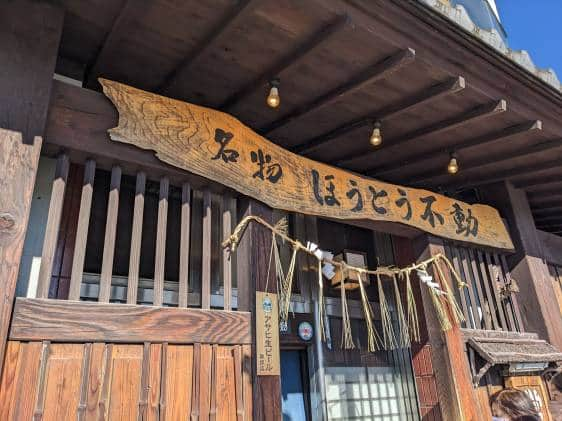
Soak in the sights at a hot spring

There are two primary onsen towns on the Red Line Bus route: Funatsu-Hama and Azagawa, each with plenty of hotels and public onsen which welcome day guests into their relaxing baths. Hotel Mifujien has good views of Mt. Fuji, although it is not the fanciest of onsen. Entry costs ¥ 1,200 . Yurari has great views from the second-floor baths, with a range of bath types and entry from ¥ 1,200 to ¥ 1,700 depending on day and time — they also have private onsen bookable from ¥ 2,500 for one hour, with views of that mountain we keep mentioning. You can also try Yamanakoka Hot Spa-Beni Fuji no Yu , which has good views and a nearby morning market to boot.
Pro tip: You can combine your hot spring experience with shopping and a stop-off at Mt. Fuji's 5th station, on an [affiliate id="viator" text="all-in-one tour from Tokyo" link="https://www.viator.com/Tokyo/d334-ttd/p-2142TYO_BUSS10"].-->
Things to do around Kawaguchiko
Chūreitō pagoda.
Train from Kawaguchiko Station to Shimoyoshida Station

No doubt you’ve seen this photo a thousand times in research for your Japan trip. It’s a photo that can’t be shared widely with fears that people will accuse you of mishandling Photoshop. But you deserve to take it — I mean you did have to climb 400 steps to get there. This spot is so popular that they have recently built a large platform — no more elbowing people out the way — and there’s free Wi-Fi.
Tip: If you board a limited express train to Shimoyoshida, it costs ¥ 400 extra on top of your regular ticket. Alternatively, if coming from Tokyo, you can hop off the train early and put your luggage in the station’s lockers.
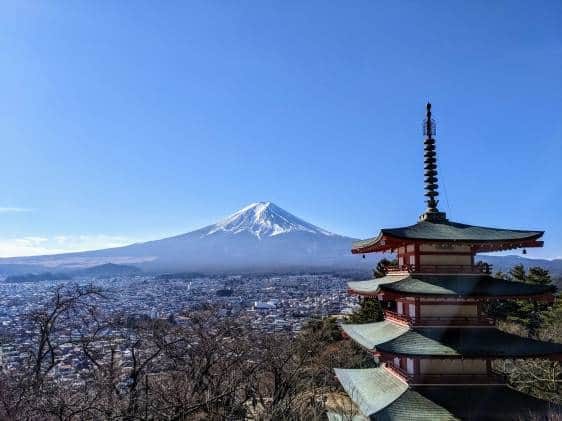
Ice and Wind Cave
Narusawa Hyōketsu Ice Cave Stop (No. 80) via the Blue Line Bus Fugaku Fūketsu Wind Cave Stop (No. 51) via the Green Line and Blue Line Bus.

For an interesting geo-thermal phenomenon check out the Narusawa Hyōketsu Ice Cave and Fugaku Fūketsu Wind Cave. It takes around 30 minutes from Kawaguchiko Station to reach the caves, and they are both within a 10-minute walk away from each other. The ice cave is the more interesting of the two and is cold all year round with icicles sprouting from the ceiling. You’ll need to wear a helmet in both. They are also right next to Aokigahara Forest; you’ll get a glimpse when you walk from one cave to the other.
Narusawa Hyoketsu Ice Cave
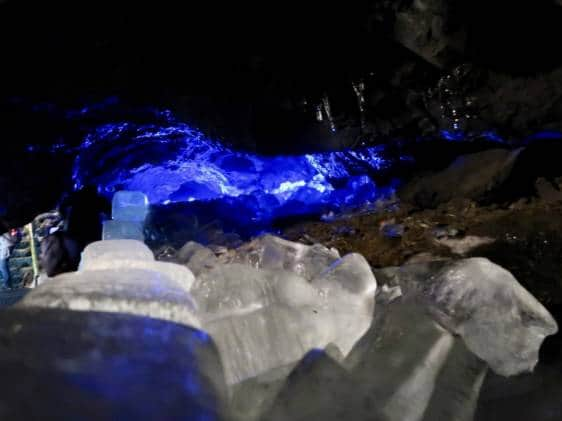
Saiko Iyashi-no-Sato Nenba Healing Village
Saiko Iyashi-no-Sato Nenba Stop (No. 48) via the Green Line Bus

Visit the Saiko Iyashi-no-Sato Nenba Healing Village with thatched buildings, each containing a local craft demonstration. You can wear samurai armor, dress as a geisha, buy some wind chimes, and chow down on local delicacies (wasabi ice-cream, anyone?).
Saiko Iyashi no Sato Nenba (Healing Village)
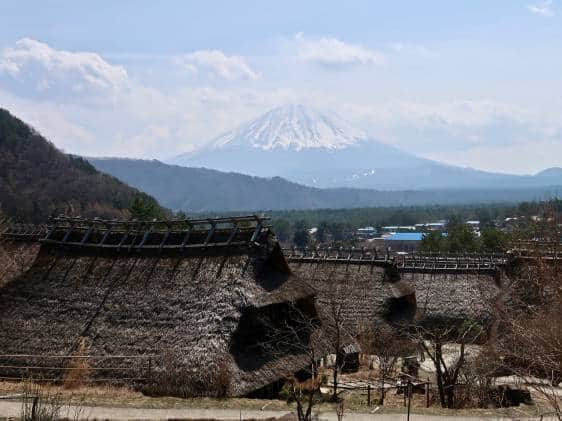
Fuji Moss Phlox Festival
40-minute shuttle bus from Kawaguchiko Station

Carpets of over 800,000 shibazakura cover the ground before Mount Fuji from mid-April to late May, creating stunning views with contrasting colors from flower to mountain to sky. There are good-value, all-in-one tour packages available during the festival period, but if you’re not keen on those you can easily access the site by shuttle bus from Kawaguchiko Station (approximately 40 minutes).
Fuji Shibazakura Festival
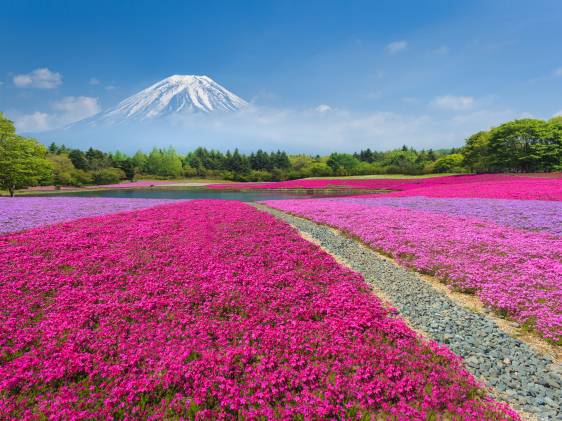
Oshino Hakkai
30-minute local bus from Kawaguchiko Station

Oshino Hakkai is known for its magical eight ponds, quaint windmills, and stunning views of Mount Fuji. In the past, devout individuals would cleanse themselves in these ponds before making their way up Mount Fuji. Nowadays only the Waku Pond holds great significance, with visitors encouraged to bottle up the water and drink.
While it can get quite busy during tourist season, heading there will treat you with a breathtaking vista, especially during the Diamond Fuji phenomenon .
Bonus sights
In case that wasn’t enough for you, there is plenty more to see dotted along the lake shore and in the main town of Kawaguchiko.
- The area is known for its museums, so if you fancy it, visit the Yamanashi Gem Museum , Kawaguchiko Museum of Art , and Kawaguchiko Konohana Museum .
- Head indoors and escape the heat or cold at Fuji-san World Heritage Center .
- For shrines, you could visit the Fuji Omuro Sengen Jinja Shrine on the east side of the lake, a few stops down from the Itchiku Kubota Art Museum listed above.
- And for atmospheric fire-pit cooking ( robotayaki ), we recommend the restaurant Sanrokuen — only a 10-minute walk from Kawaguchiko Station.
Where to stay in Kawaguchiko
If you’ve just realized that 24 hours isn’t enough time to see everything in and around Kawaguchiko, then there are many fabulous places to stay over at — and some come with unforgettable views of Mount Fuji. One such hotel is the Fuji View Hotel , but we have plenty more in our dedicated article.
While we do our best to ensure it’s correct, information is subject to change. Post first published in April 2017 and last updated in January 2024.
- Fuji five lakes
- Kawaguchiko
- Theme parks
- Weekend-getaway
Get our Tokyo Cheapo Hacks direct to your inbox

Tokyo Sumo Guide: When and Where to Experience Sumo Wrestling

Best Budget Sushi Restaurants in Tokyo

Top Japanese Phrases You Need Before Traveling to Japan

Hidden Gems: Tokyo's BEST Underrated Shrines and Gardens

Tokyo's Best Airport: Flying into Narita vs. Haneda

Hakone Day Trip from Tokyo

When to See Cherry Blossoms in Japan

May 2024: 5 Events Not to Miss in Tokyo
May is the official start of festival season in Tokyo. With mega-fests like Sanja Matsuri and the Golden Week holiday, you're spoiled for choice!

Tokyo Events This Week: Wisteria, Gyoza, and Shoe Festivals
Tokyo events for Monday, April 22 to Sunday, April 28, 2024.

7 Things To Do in Harajuku's Hottest New Attraction, Harakado
From rooftop bars to public baths, art spaces, and more — there's lots to keep you busy.

New Video: Hidden Gems — Tokyo's Most Underrated Shrines and Gardens
Tokyo is often described as busy, crowded and futuristic, but there are also traditional shrines and gardens where you can swap the hustle and bustle of the city for peace and quiet.

3 Hidden Sound, Art and Poetry Experiences in Tokyo
A different way to tune into the city.

Where To See Yaezakura: Late-Blooming Cherry Trees in Tokyo
8 perfect picks, from parks to shopping streets.

New Video: Top 20 Things to Do in Shinjuku
You'll need more than a day — there are LOTS of things to try!

International Music Artists and Bands Coming to Japan in 2024 (Updated)
Upcoming names include Baekhyun, the Red Hot Chili Peppers, Iron Maiden — and more.

6 Spectacular Spring Flower Festivals Around Tokyo
Move over, cherry blossoms! These other blooms will take your breath away well into late spring.

English-Speaking Hospitals in Tokyo — And How To Visit Them
Absolutely everything you need to know about seeing a doctor in Japan.

Recommended hotels located nearby

Close without accepting
- Media & Industry
- Meetings & Events
- Select Language 简体中文 繁體中文(香港) 繁體中文(臺灣) India (English) Bahasa Indonesia 한국어 ภาษาไทย Tiếng Việt Singapore (English) Philippines (English) Malaysia (English) Australia/New Zealand (English) Français Deutsch Italiano Español United Kingdom (English) Nordic countries(English) Canada (English) Canada (Français) United States (English) Mexico (español) Português العربية Japan(日本語) Global (English)
- India (English)
- Bahasa Indonesia
- Singapore (English)
- Philippines (English)
- Malaysia (English)
- Australia/New Zealand (English)
- United Kingdom (English)
- Nordic countries(English)
- Canada (English)
- Canada (Français)
- United States (English)
- Mexico (español)
- Global (English)
- Fujiyoshida
- Shimonoseki
- Ishigaki Island
- Miyako Island
- Kerama Island
- Tokyo Island
- Koka & Shigaraki
- Hida Takayama
- Ginza, Nihonbashi
- Beppu & Yufuin (Onsen)
- Ginzan Onsen
- Nagasaki Islands

- Kumano Kodo
- Shikoku Karst
- Amami Oshima
- Hachimantai
- Omihachiman
- Aizuwakamatsu

- Diving in Japan
- Skiing in Japan
- Seasonal Flowers in Japan
- Sustainable Outdoors
- Off the Beaten Track in Japan
- Scenic Spots
- World Heritage
- Home Stays & Farm Stays

- Japanese Gardens
- Japanese Crafts
- Temple Stays
- Heritage Stays
- Festivals and Events
- Theater in Japan
- Japanese Tea Ceremony
- Cultural Experiences in Japan
- Culture in Japan

- Local Cuisine Eastern Japan
- Local Cuisine Western Japan
- Local Street Food
- Japan's Local Ekiben
- Japanese Whisky
- Vegetarian and Vegan Guide
- Sushi in Japan Guide
- Japanese Sake Breweries

- Art Museums
- Architecture
- Performing Arts
- Art Festivals
- Japanese Anime and Comics
- Japanese Ceramics
- Local Crafts

- Scenic Night Views
- Natural Wonders
- Theme Parks
- Samurai & Ninja
- Iconic Architecture

- Wellness Travel in Japan
- Japanese Ryokan Guide
- A Guide to Stargazing in Japan
- Relaxation in Japan
- Forest Bathing (Shinrin-yoku)

- Experiences in Japan
- Enjoy my Japan
- National Parks
- Japan's Local Treasures
- Japan Heritage
- Snow Like No Other
- Wonder Around Japan

- Visa Information
- Getting to Japan
- Airport Access
- COVID-19: Practical Information for Traveling to Japan
- Anime Tourism
- Countryside Stays
- Accessible Tourism
- Hokkaido Great Outdoors
- Scenic World Heritage in Tohoku
- Shikoku’s Nature and Traditions
- Southern Kyushu by Rail

- Traveling by Rail
- How to Travel by Train and Bus
- JR Rail Passes
- Scenic Railways
- Renting a Car
- Sustainable Travel in Japan
- Travel Brochures
- Useful Apps
- Online Reservation Sites
- Eco-friendly Accommodation
- Luxury Accommodations
- Traveling With a Disability
- Hands-free Travel
- How to Book a Certified Tour Guide
- Volunteer Guides
- Tourist Information Center

- Japanese Manners
- Spring in Japan
- Summer in Japan
- Autumn in Japan
- Winter in Japan
- Cherry Blossom Forecast
- Autumn Leaves Forecast

- Japan Visitor Hotline
- Travel Insurance in Japan
- Japan Safe Travel Information
- Accessibility in Japan
- Vegetarian Guide
- Muslim Travelers
- Safety Tips

- JAPAN Monthly Web Magazine
- Arts & Cultures
- Nature & Outdoor
- Festivals & Events
- Insider Blog
- Things to do
- Local Guides
- Food & drink
- Traditional
- Hokuriku Shinetsu

My Favorites
${v.desc | trunc(25)}
Planning a Trip to Japan?
Share your travel photos with us by hashtagging your images with #visitjapanjp
- Fuji Five Lakes Area
- Lake Kawaguchi
Lake Kawaguchi 河口湖
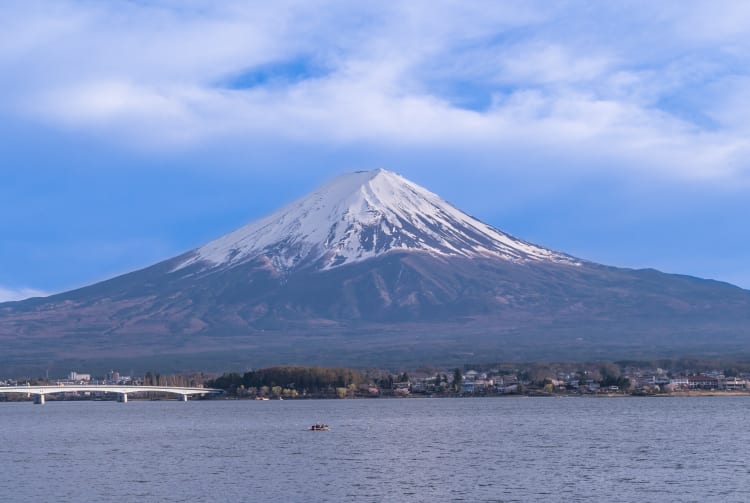
Minamitsuru-gun, Yamanashi-ken
- View on Google Maps
- Get Transit Info
Hot springs, challenging trail runs, offbeat museums and panoramic views
- Renting a bicycle or hopping on the bus to visit the museums and art galleries around the lake
- Taking a cruise around the lake for incredible views of Mt. Fuji
- Riding the ropeway up Mt. Tenjo for sweeping views over the lake and of course of Mt. Fuji
- Viewing Mt. Fuji from the comfort of a steaming bath at one of the area's hot spring hotels
How to Get There
Lake Kawaguchi is in southeastern Yamanashi near the border with Shizuoka. You can take a train or a highway bus from Tokyo.
Take a train from JR Shinjuku Station to JR Otsuki Station on the JR Chuo Line (about an hour). Change to the Fuji Kyuko Line for Kawaguchiko Station (JR Rail Pass not accepted).
You can also get to Kawaguchiko Station by bus from Shinjuku Expressway Bus Terminal in just under 2 hours.
The art of museum hopping
Four seasons of charm.
In spring, the lake is ringed with cherry blossom trees, and the trees on the northern shore are illuminated at night for the Fuji-Kawaguchiko Cherry Blossom Festival in mid-April. In summer, the Kawaguchiko Herb Festival is held, and purple lavender colors secrtions of the shore from late June to the middle of July.
The Fuji-Kawaguchiko Autumn Leaves Festival also held on the northern shore of the lake, takes place from November 1 throughout the month, with classic views of Mt Fuji framed by maple leaves. Winter is the best time to see Mt. Fuji clearly.
Spectacular photo opportunities
Another great photo spot is Tenjoyama Park on the Kachi Kachi Ropeway, located at the southeast corner of the lake.
Fresh air fun
Whether you want to enjoy a casual stroll, ride a bike or challenge yourself to an ultra trail run over two days, the Kawaguchiko area provides ample opportunity to fill your lungs with the clean air around Mt. Fuji. Serious road warriors should try the Ultra Trail Mount Fuji run, which is now part of the trail running World Tour.
* The information on this page may be subject to change due to COVID-19.
- Scenic Spot
Recommended for You

Please Choose Your Language
Browse the JNTO site in one of multiple languages
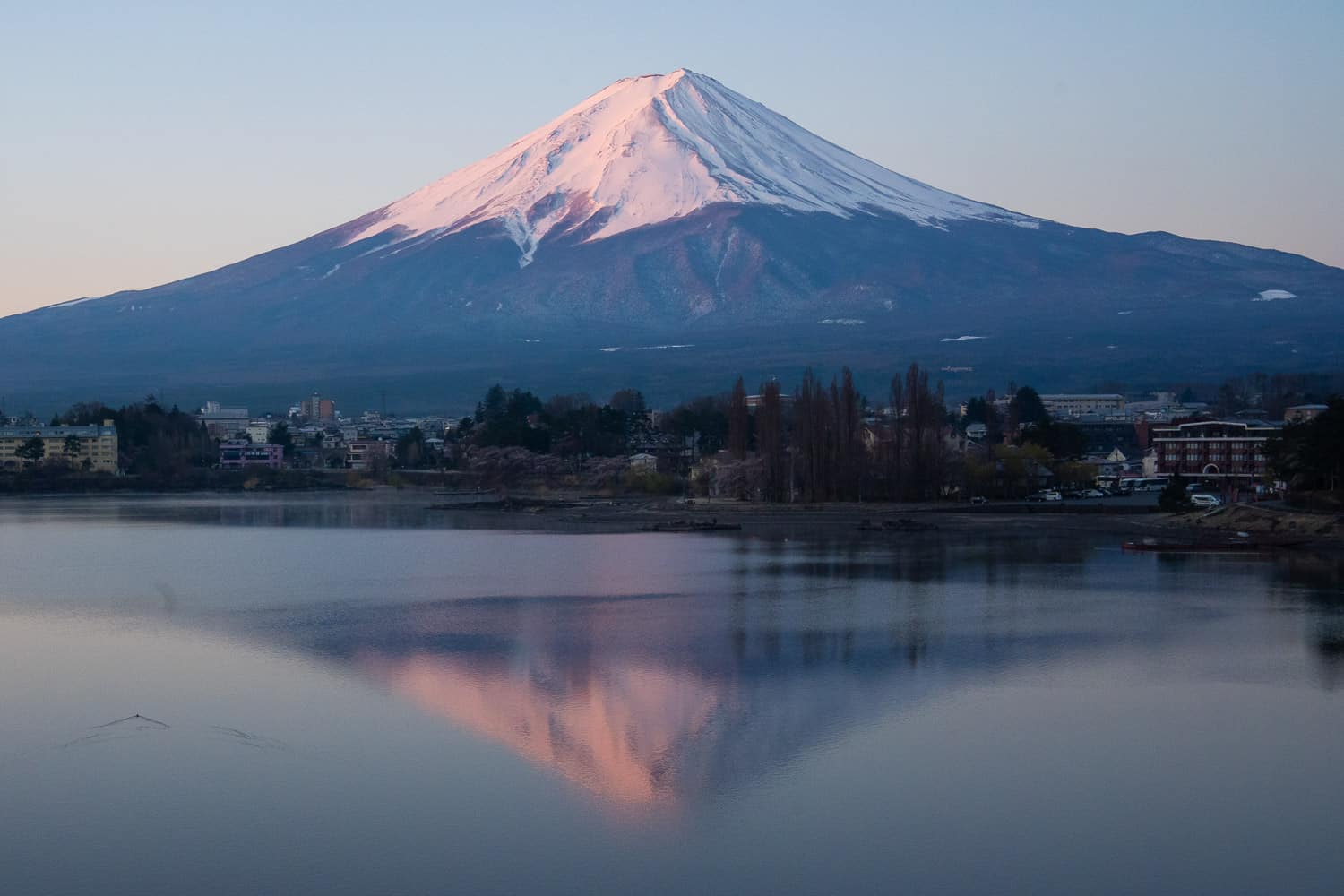
Visiting Lake Kawaguchiko to See Mount Fuji: Everything You Need to Know
This page contains affiliate links. Please read our disclosure for more info.
Lake Kawaguchiko is one of the best places to see the iconic Mount Fuji.
Japan’s highest mountain (at 3776 metres) is a perfectly shaped volcano and looks especially stunning when snow-capped in winter and spring.
Kawaguchiko is a town around the lake of the same name in the Fuji Five Lakes region.
It’s possible to visit on a day trip from Tokyo, but it’s a relaxing place to spend a few days and a longer stay gives you more chances to see the elusive mountain. Unfortunately, the peak is often obscured by cloud.
The views are especially lovely in spring (mid to late April) and autumn (early to mid November) when you can enjoy Mount Fuji views with cherry blossoms or red maple leaves in the foreground.
We visited in mid-April when the blossoms were starting to bloom and we were surprised by how cold it was—we even had some snow and sub-zero temperatures.
We could see Mount Fuji on two out of the three days we were there—on the other day it was hidden in the clouds.
In this post, I share the best things to do in Kawaguchiko including where to see Mount Fuji, plus transport, hotel, and food tips.
I also answer the common question of whether Lake Kawaguchiko or Hakone is the best place to see Mount Fuji. At the end, there is a map with everything mentioned.
5 Best Things to Do in Kawaguchiko
Other kawaguchiko attractions, kawaguchiko hotels, getting around kawaguchiko, how to get to kawaguchiko, vegetarian food in kawaguchiko, kawaguchiko vs hakone: which is the best place to see mount fuji, kawaguchiko map, is kawaguchiko worth visiting , more japan posts.
We explored at a relaxed pace (with one day when we couldn’t see Mt Fuji), so although we had 2.5 days, everything on our Kawaguchiko itinerary could be done in one full day if you start early.
We walked everywhere except for the Chureito Pagoda (which is a short train ride away), but to save time you could take the local buses or rent a bike. There are more transport tips below.
Note that if you were thinking of climbing Mount Fuji, this can only be done in July and August. It’s a very steep climb over one or two days and is likely to be crowded with other hikers.
1) See Mount Fuji from the North Shore of Lake Kawaguchi
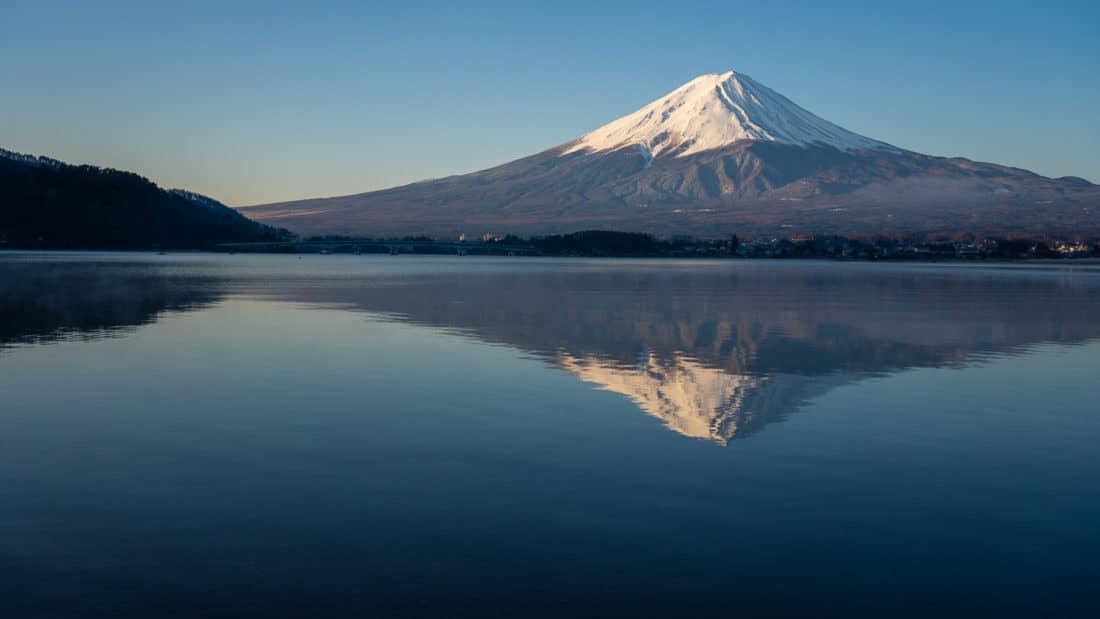
You can see Mount Fuji from many places in Kawaguchiko—just turn a corner and you’ll see it looming over the town—but the best view is from the north shore of the lake.
The mountain is even more beautiful with the lake in the foreground, and at certain times, you can even see it reflected in the water.
We stayed on the south shore of the lake (where the train station and most restaurants are), but it’s a pleasant walk across to the other side and we did this every day.
To get there, walk over the Kawaguchiko Ohashi Bridge , which also has great views of Mt Fuji.
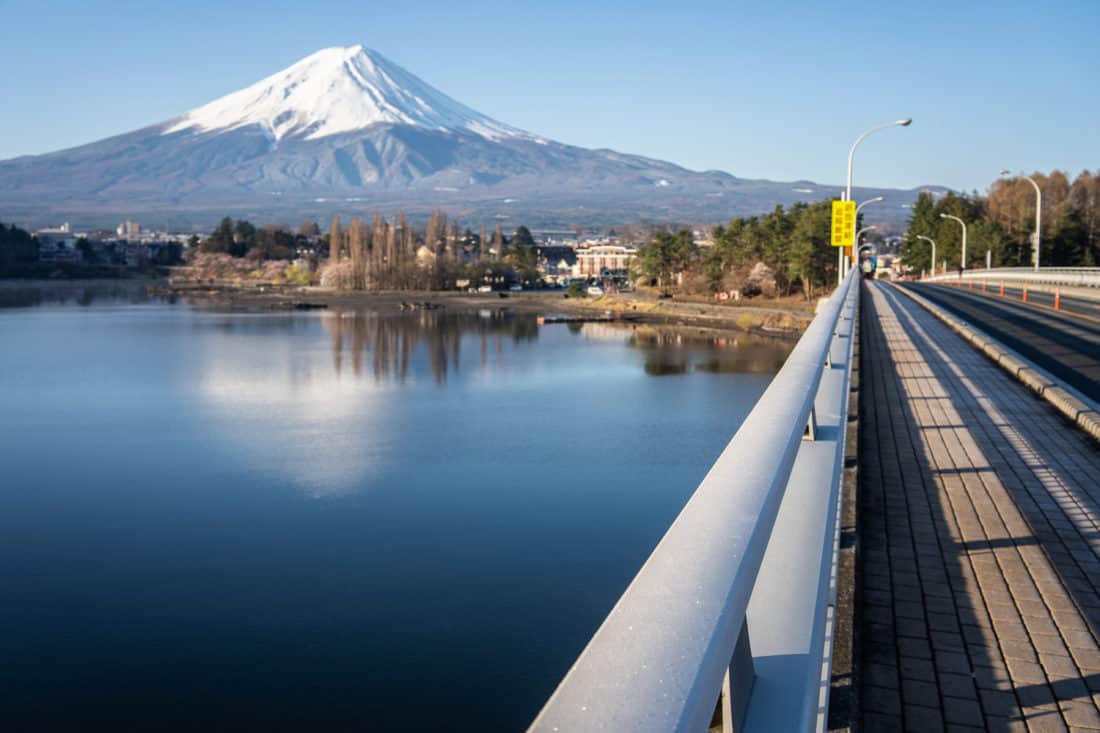
It’s about a 30-minute walk from Kawaguchiko Station to the north side of the bridge.
From here, turn left and continue walking along the lakefront (for 15 minutes or more) for even better Fuji views.
The Kawaguchiko Music Forest Museum is in this area. We didn’t go into the recreation of an Alpine village with music performances, but head in this direction for the best views.
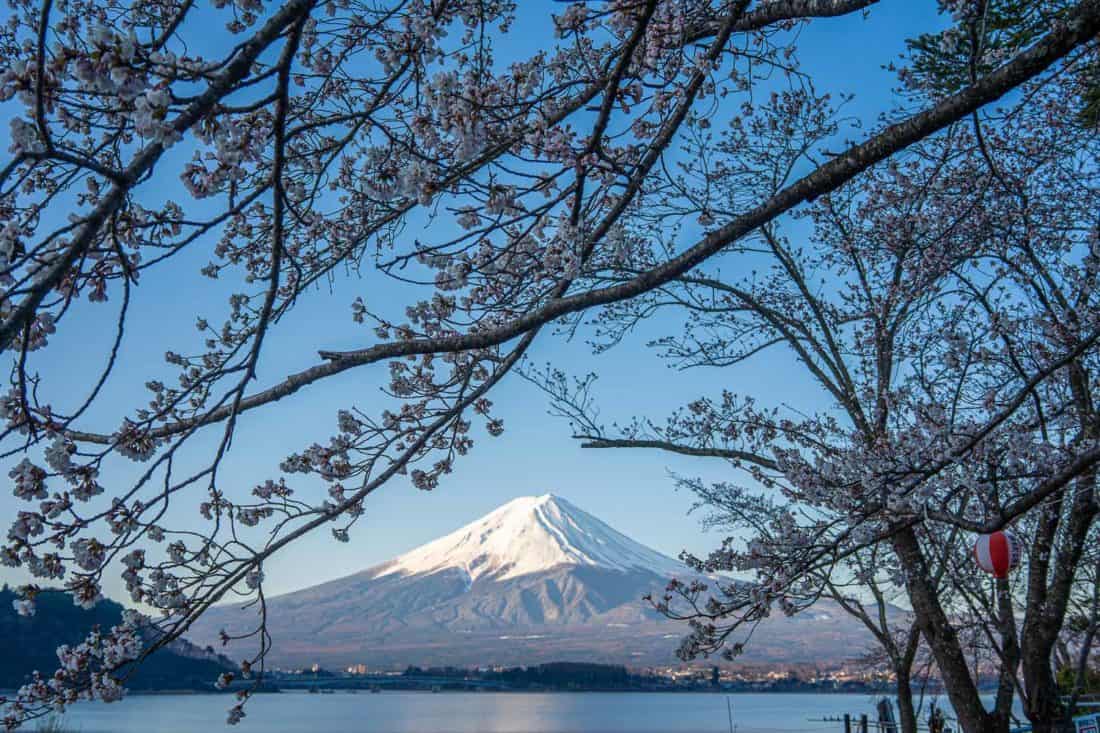
In April, the Sakura Festival is close by with food and craft stalls and plenty of cherry blossoms. In autumn, don’t miss the Maple Corridor .
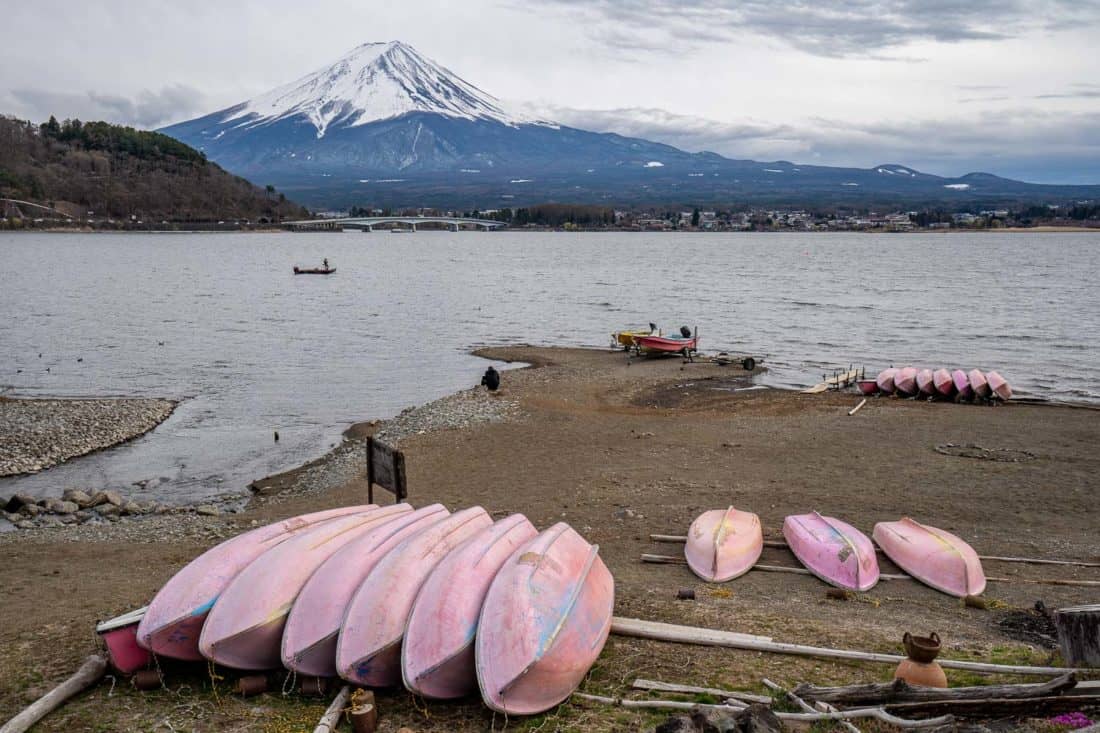
I also ran across to the north shore at sunrise for even better views. You don’t actually see the sun come up, but Mount Fuji looked gorgeous glowing in the early morning light with its snowy peak reflected in the lake.
With steam rising from the water and a few rowing boats out for practice, it was very atmospheric.
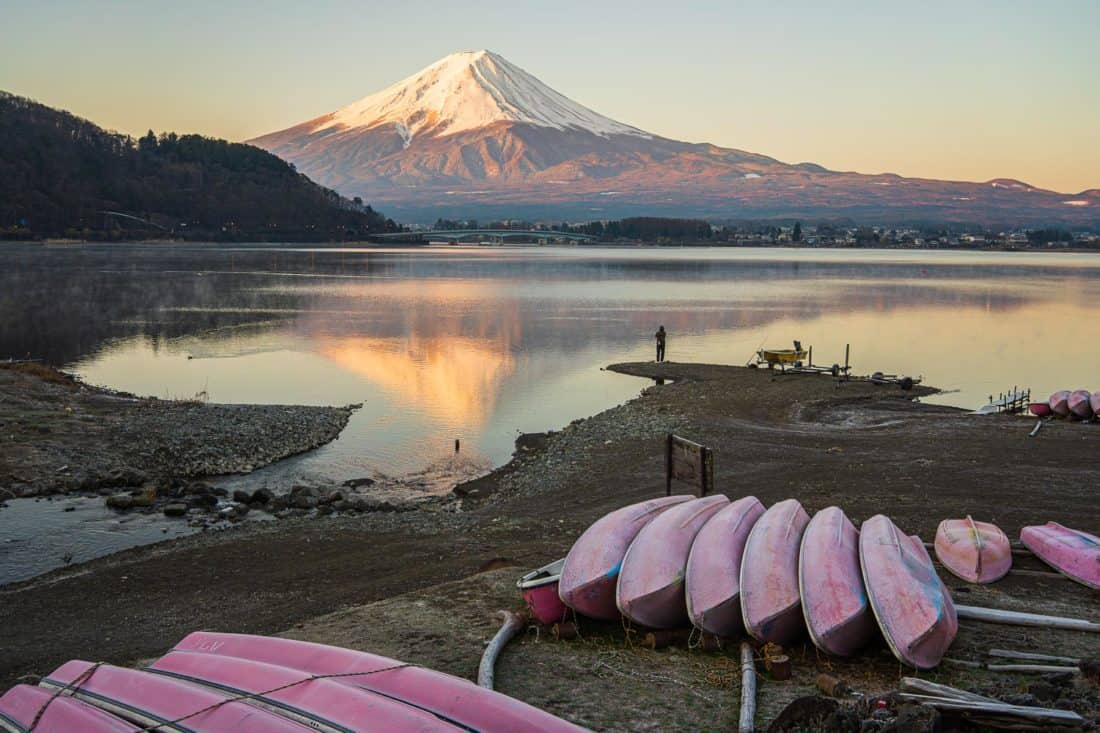
2) Ride the Kawaguchiko Ropeway
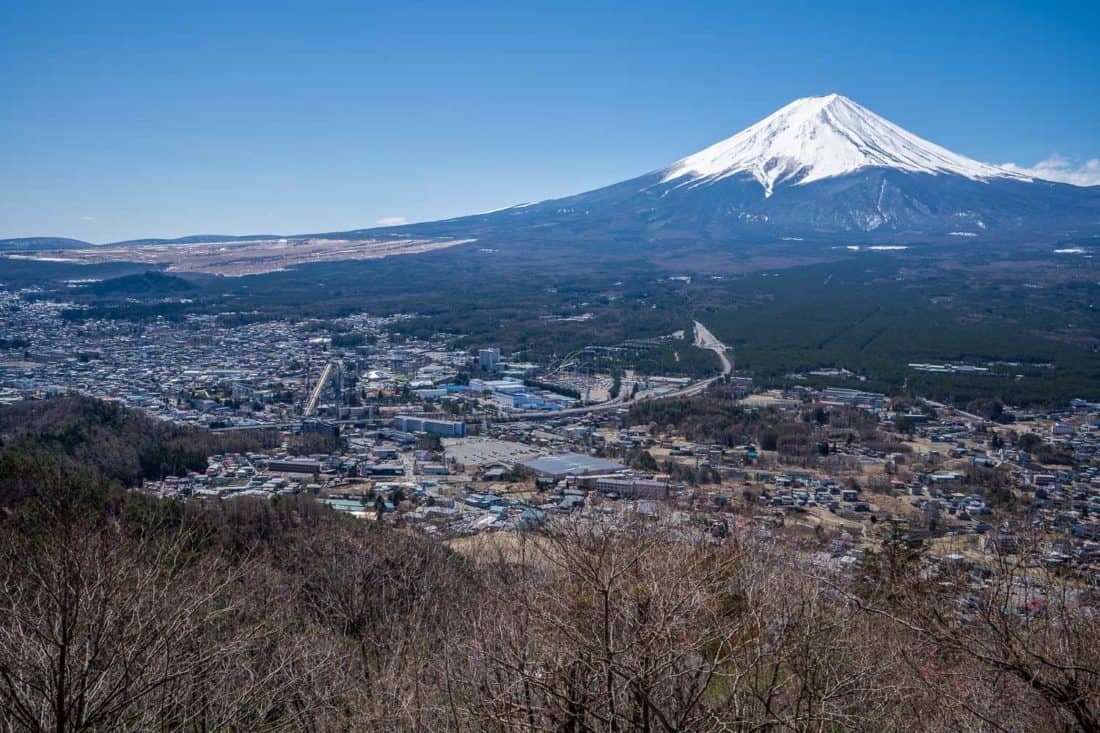
One of the most popular things to do in Lake Kawaguchiko is to take the Mt. Fuji Panoramic Ropeway (cable car) up above the lake for the views.
My feelings about this are mixed—I don’t think it’s a must-do, but it does offer a different perspective of the famous peak.
Our experience was affected by the fact we visited on a sunny Saturday morning in cherry blossom season.
At 10am we had to wait 30 minutes to get on the ropeway and then they cram people into each car so you can’t see much on the way up. By 11am the queue was even longer.
At the top there’s a cafe, gift shop, and a few cartoon animal statues. There are good views of Mount Fuji (on the opposite side from the lake), but it has a sprawling town and Fuji Q Highland theme park in the foreground.
I prefer the view from the north shore with the lake in front.
We likely would have enjoyed it more on a quiet day. As it was, we were glad we’d only bought a one-way ticket on the ropeway so that we could walk down.
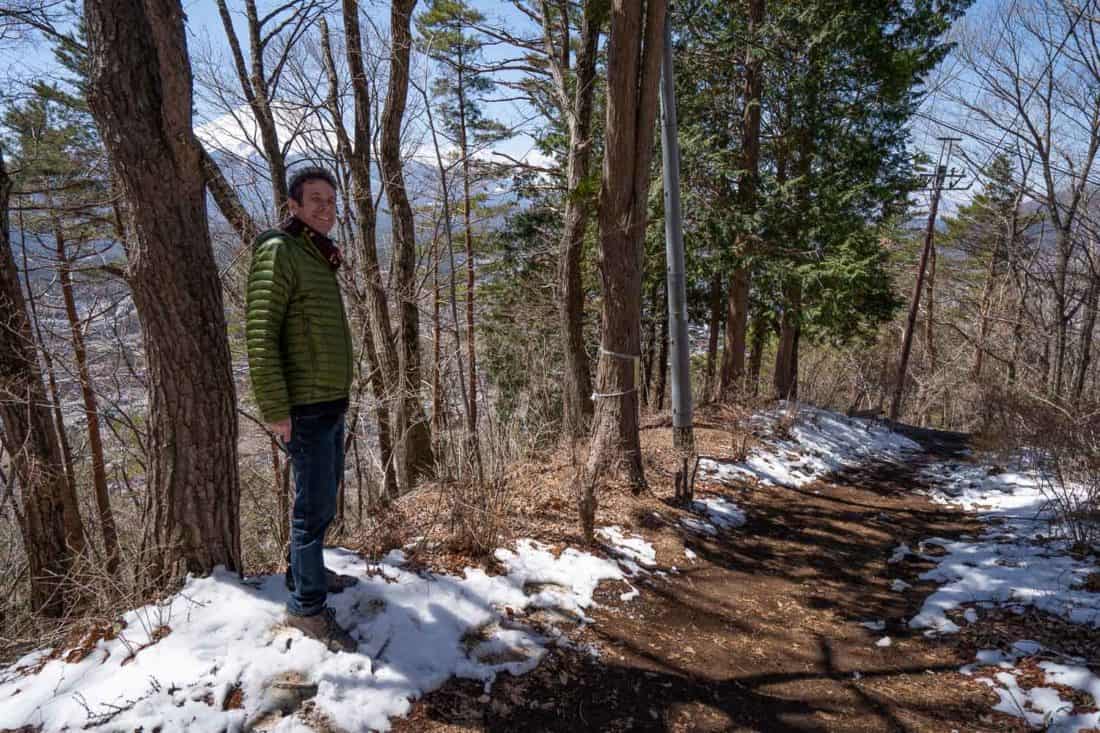
This was our favourite part of the experience—a peaceful 30-minute walk on a forest path with various viewpoints of Mt Fuji on the way down. We only saw a few other people.
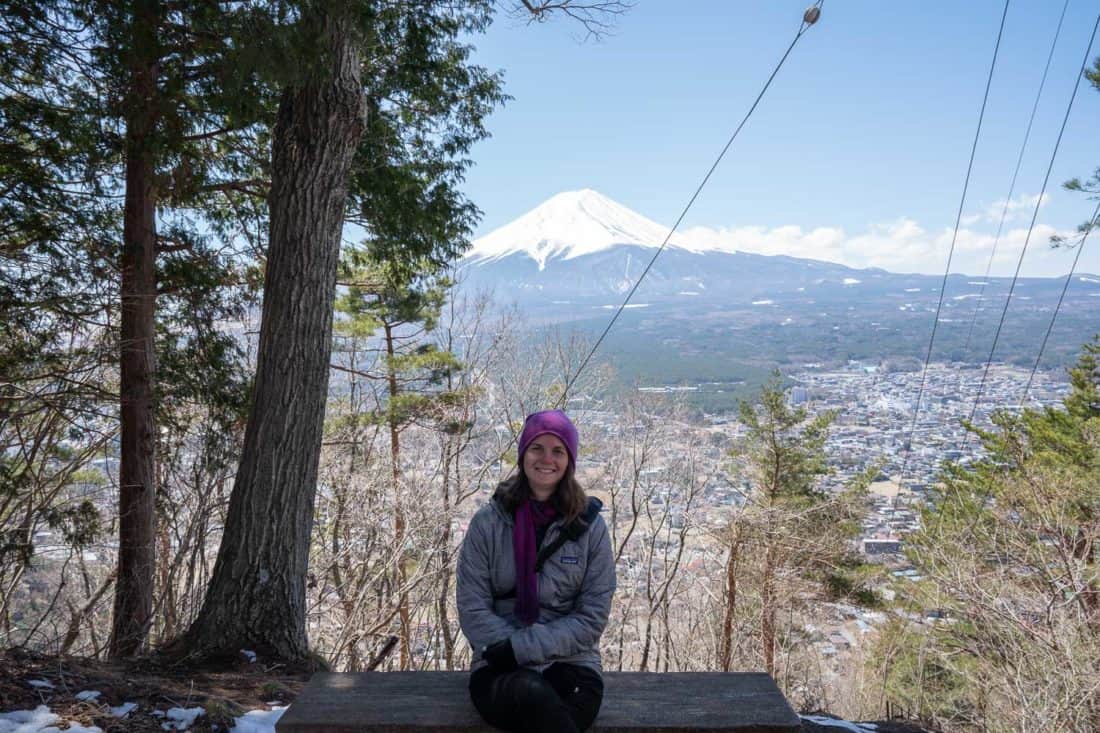
You could also walk up this trail, but obviously, it’s steeper than walking down and the path up isn’t obvious (it starts to the right of the ropeway).
Please note that since our visit, there have been extensive renovations to the site. The observation deck is now larger and more accessible, with an added suspended single deck that juts out over the cliff and even a Scenery Swing to give you a unique perspective of Mt Fuji.
Details: Kawaguchiko Ropeway tickets are 500 yen ($3.50) adult/ 250 yen ($2) child for one way (which I recommend and then walk down) or 900 yen ($6) adult/ 450 yen ($3) child for return. You can also get a combined boat and ropeway ticket for 1600 yen ($11) adult/ 800 yen ($5.50) child, but this works out more expensive if you only take the ropeway one way. The ropeway is on the southeast side of the lake, a 10-minute walk from the train station. It’s open 9am – 4pm week days and 9.30 – 5pm Saturdays. I recommend going during the first or last hour of the day.
More Japan Destinations!
Thank you for subscribing! You should receive an email from us very soon. Click on the link in the email to confirm your subscription.
3) Pedal a Panda Boat on the Lake
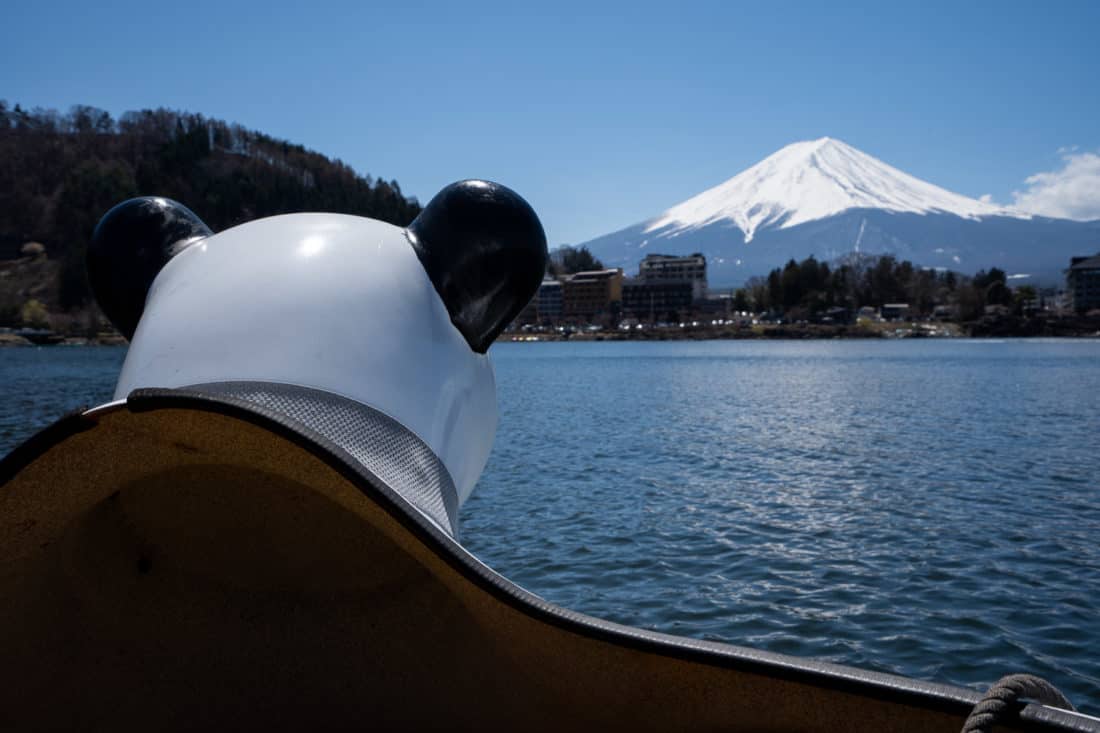
One of the top Kawaguchiko attractions is to take a boat trip on the lake, but after our stressful ropeway trip, we couldn’t face the crowds of the Ensoleille sightseeing boat.
Instead, for the same price for two people, we rented a pedal boat and headed out on the lake by ourselves.
We really wanted the classic swan boat, but the boat guy insisted we take a panda.
It’s not the most comfortable ride, especially if you have long legs, but after about five minutes of pedalling, there are good views of Mount Fuji and you can take a break and enjoy it in peace.
I still prefer the north shore view, but it’s fun to see Mt Fuji from a panda’s perspective!
Details: A pedal boat costs 2000 yen ($13.50) for 30 minutes and fits up to three people. The sightseeing boat trip costs 1000 yen ($7) adult/ 500 yen ($3.50) child, and lasts 20 minutes. The Ensoleille sightseeing boat leaves from near the ropeway station and the pedal boat rentals are nearby. The sightseeing boat runs from 9am – 4.30pm/ 5.30pm depending on the month and the boat rentals have similar hours.
4) Admire Kimonos at the Itchiku Kubota Art Museum
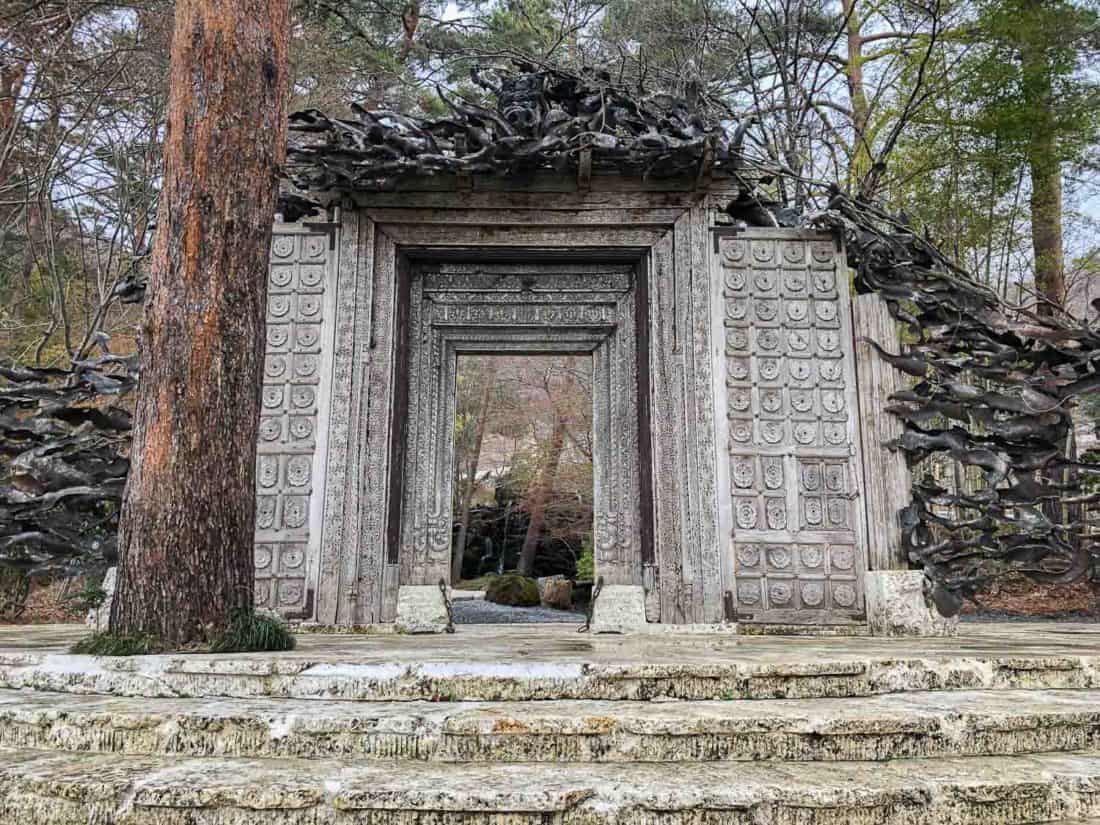
On the north shore of Lake Kawaguchi is the Itchiku Kubota Art Museum .
It’s my favourite museum in Japan (I chose it as one of my top things to do in Japan ) and is a fantastic rainy day activity away from the tourist crowds.
This classy museum within beautiful gardens (especially in autumn) features an exhibition of kimonos created by textile artist Itchiku Kubota.
In the main building, first watch the video about the artist to understand his mission to recreate the 16th-century textile dyeing technique Tsujigahana.
It took him 20 years until he was satisfied with his method, which includes tie-dyeing, ink painting, and embroidery, and the results of the elaborate and time-consuming process are stunning.
The oversized kimonos are so colourful and full of texture. Many of them depict Mount Fuji in the changing seasons and all include nature in some way.
They are just gorgeous and stayed in my mind after we’d left the museum.
I also highly recommend visiting the lovely tea room, Itchiku-an. It was once Kubota’s artist studio and feels like a cave with big windows overlooking a garden of mossy rocks and a waterfall.
It feels so Japanese and is a peaceful place to relax.
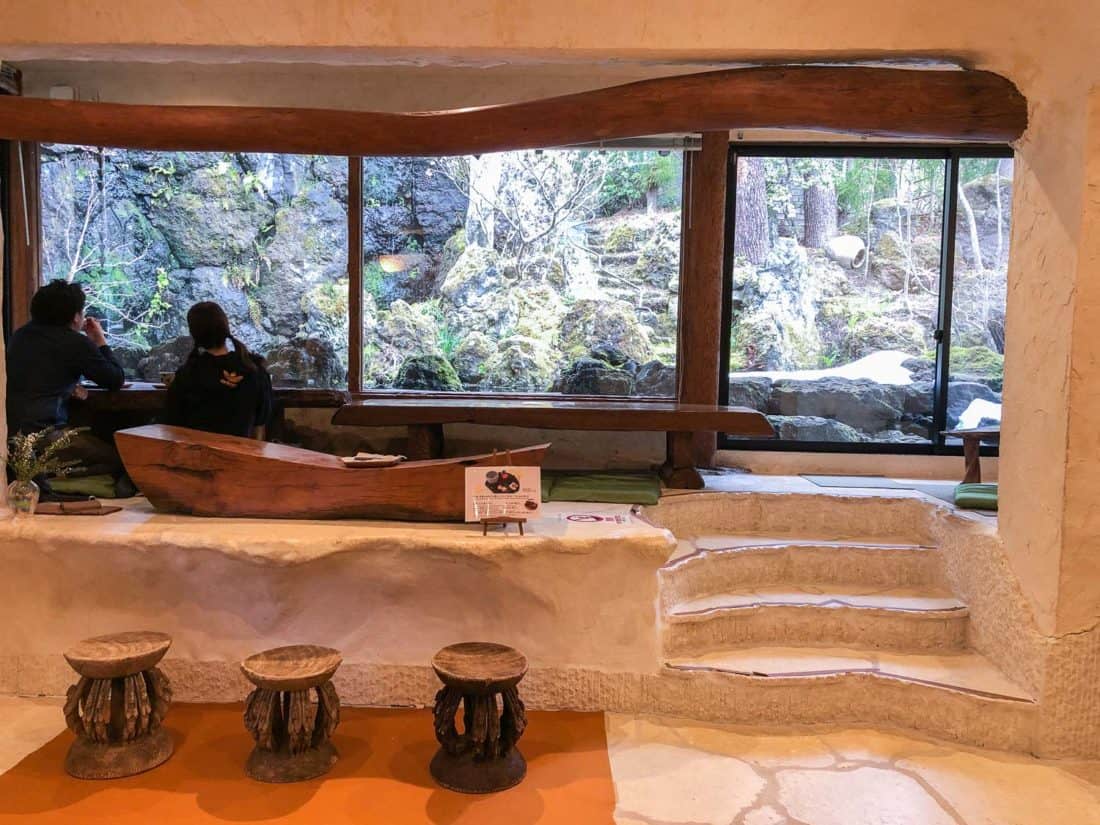
I got the wagashi set (1300 yen/$8.50) which included matcha tea and a soft mochi-style sweet in the shape of Mount Fuji decorated with cherry blossoms.
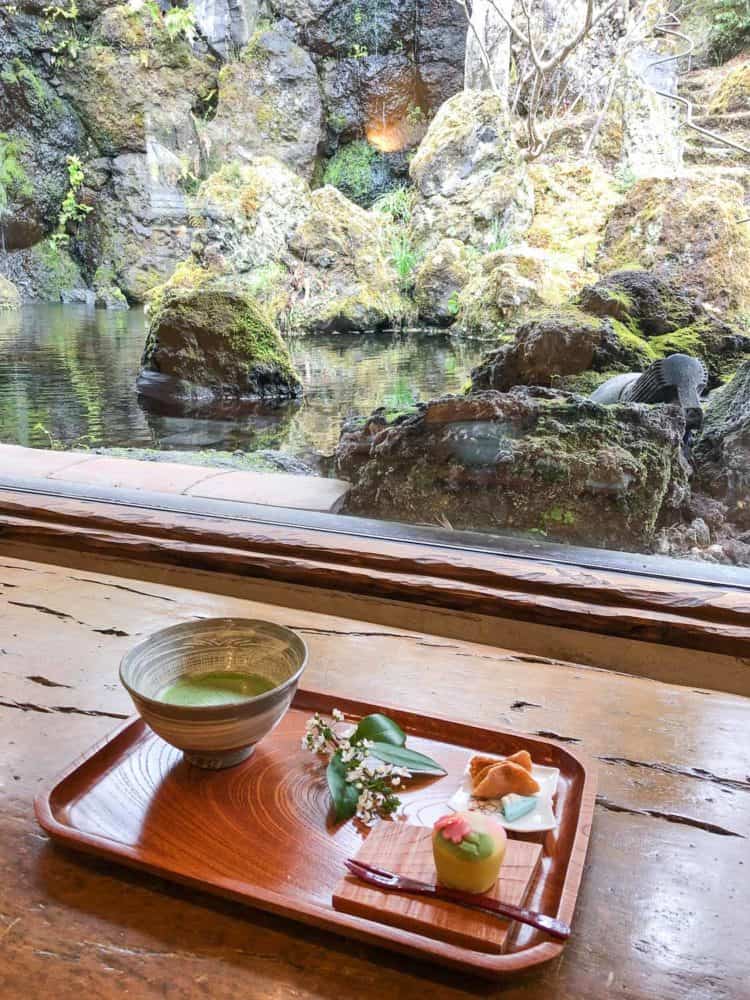
There’s another cafe onsite that contains an ancient glass bead collection, but entry costs an extra 500 yen ($3.50) including a drink. I would stick with the unique tea room instead.
Details: Museum entrance is 1500 yen ($10) adults/ Free – 900 yen ($6) children depending on age. Open 10am – 5pm (10am – 4.30pm in winter). Opening days vary depending on season so please check the Itchiku Kubota Museum website in advance.
5) Visit the Chureito Pagoda for the Classic Mount Fuji View
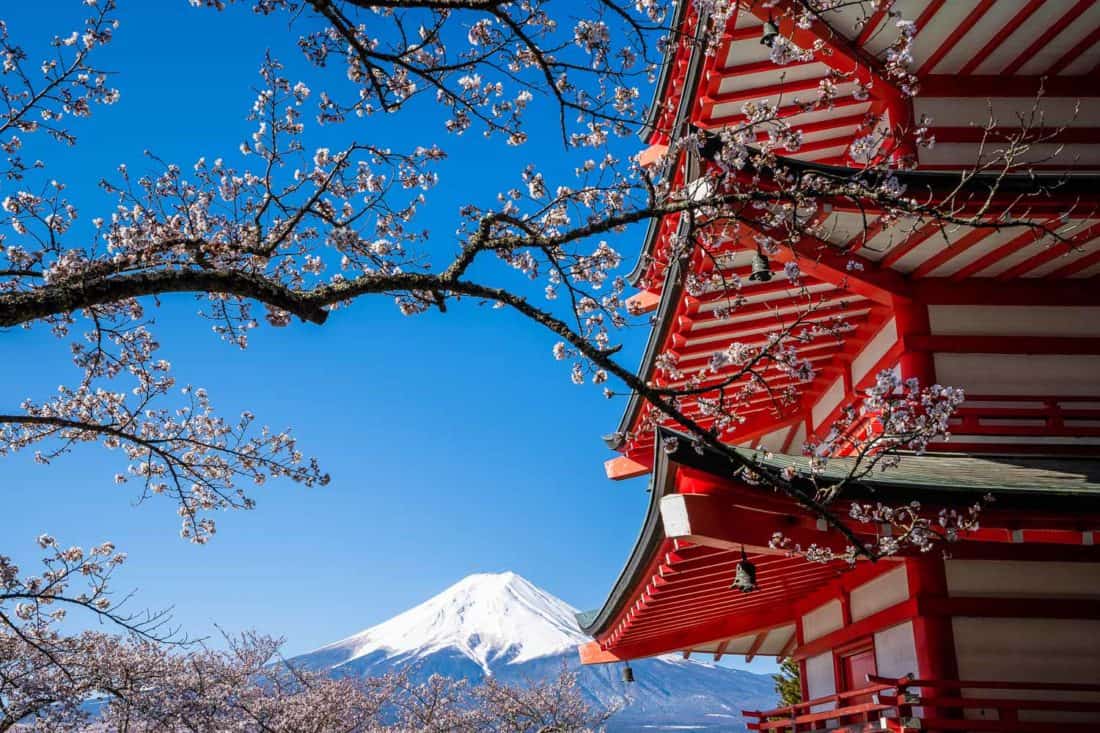
The most famous view of Mount Fuji is from Chureito Pagoda at Arakurayama Sengen Park , a 20-minute train ride from Kawaguchiko.
In cherry blossom season, a visit here is a must for many people. The combination of the vibrant red five-storey pagoda, snow-capped Mt Fuji, and sakura is a classic image of Japan.
The flowers bloom slightly earlier here than on the lakefront—at the pagoda they were in full bloom for us.

What no one tells you is how busy this spot is, though. We arrived before 8am (on a sunny Saturday) and there were already hundreds of people waiting in line to get the iconic photo.
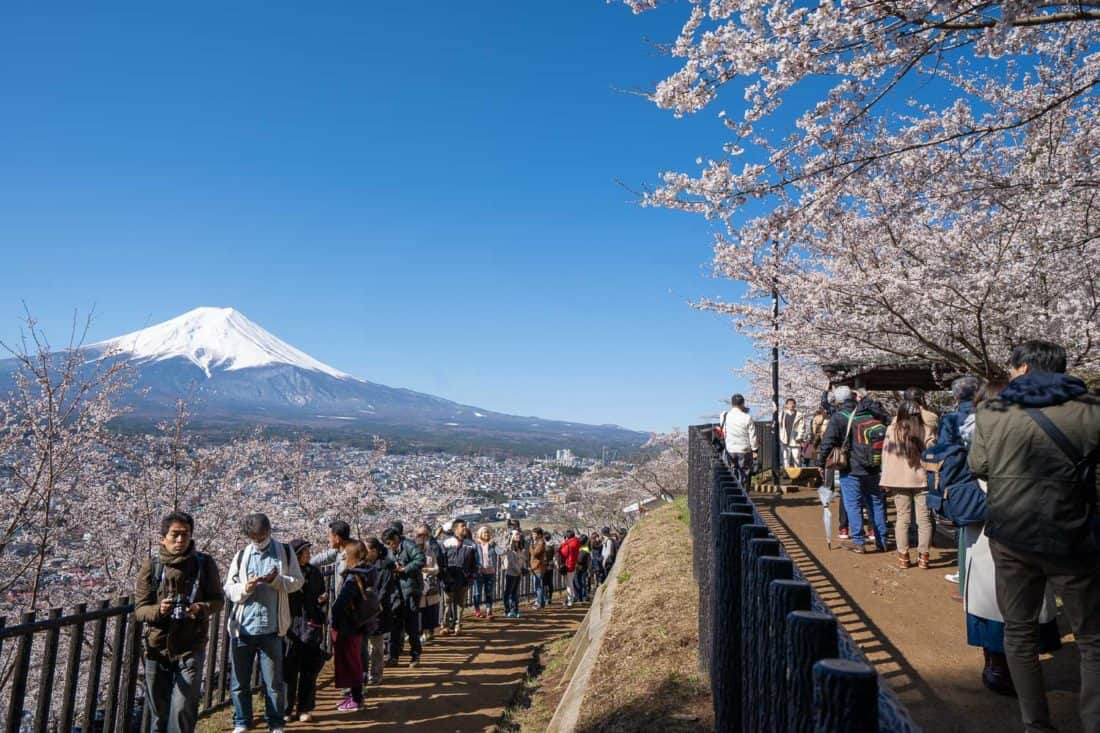
I didn’t have the dedication to wait an hour or more to take the same photo as everyone else, so I made do with the close up view you can get without queuing.
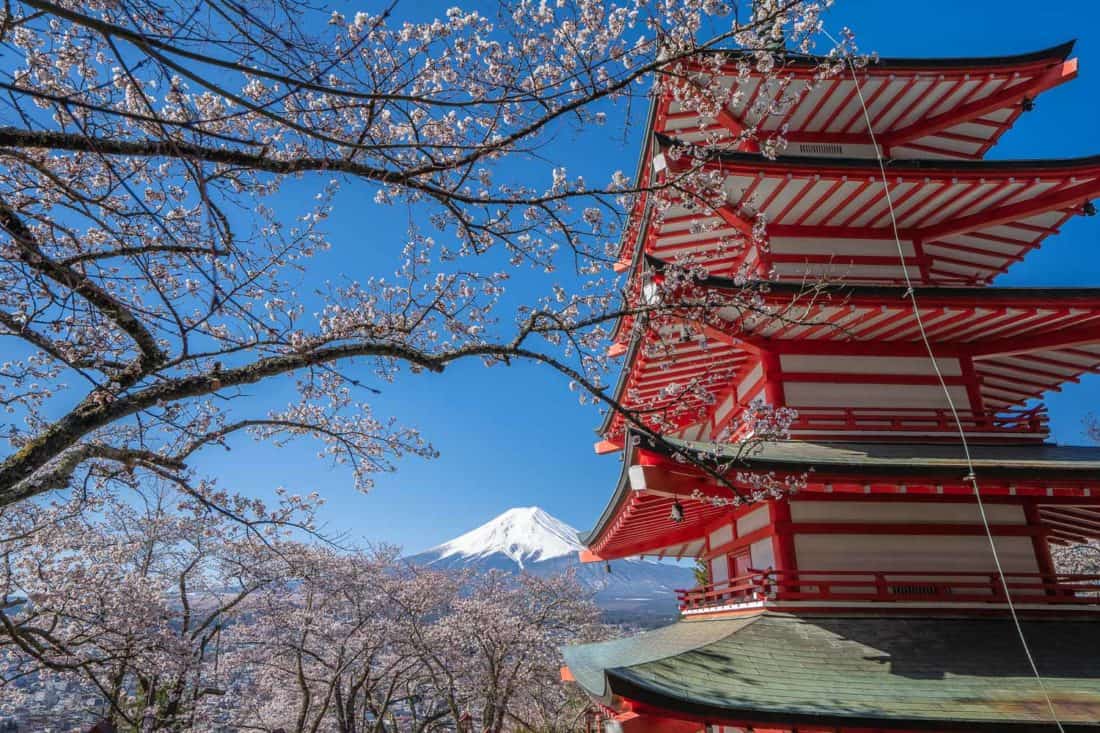
The many sakura and the views of the mountain are wonderful here, but in sakura season the crowds make it a little stressful.
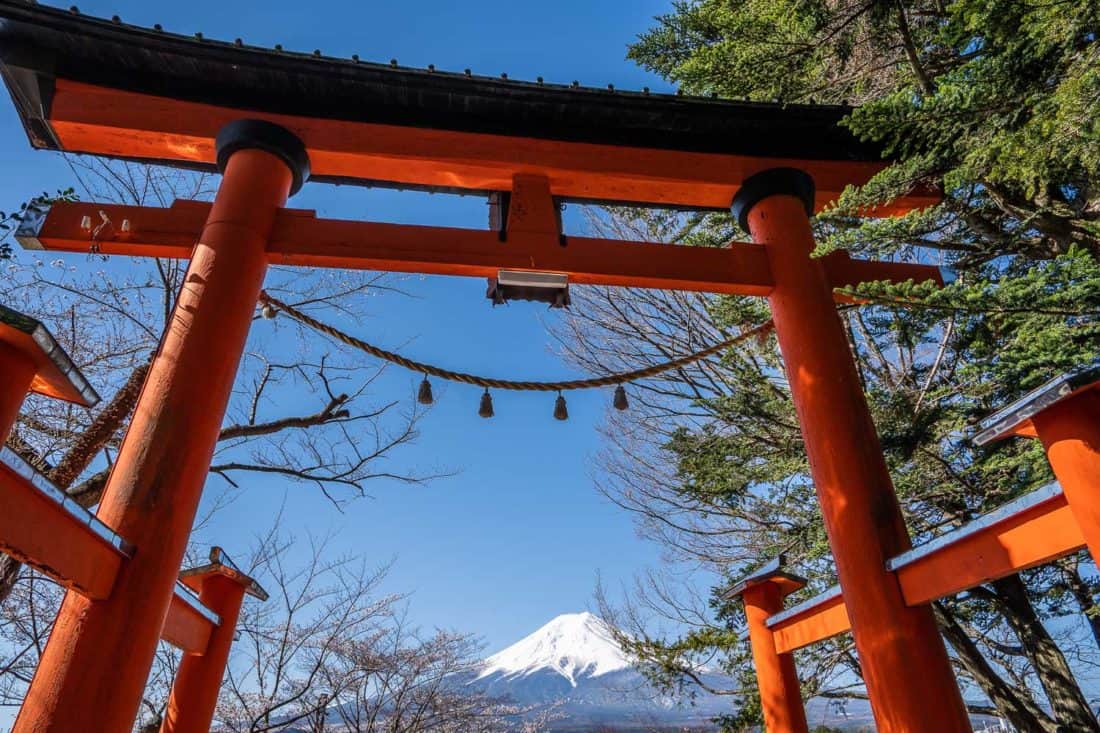
Details: To get here, take the Fujikyuko Line train from Kawaguchiko Station to Shimoyoshida Station , which takes about 20 minutes. Japan Rail Passes aren’t valid—we used our ICOCA transport cards to tap on and off. The trains have fun cartoon designs and you can see Mt Fuji for much of the way. From Shimoyoshida Station follow the signs for the 15-minute walk to the park. Enter through a large torii gate and climb 500-ish steps to the pagoda. It’s easy to find the way.
Back to Contents
We didn’t get around to doing these, but you might also be interested in:
- Ide Sake Brewery – You can do sake tours and tastings at this small brewery near Kawaguchiko station at 9.30am and 3pm. You need to book in advance (ask your hotel to call).
- Fuji-Q Highland – A theme park a two-minute train ride from Kawaguchiko. You can see Mt Fuji from some of the thrilling rollercoasters. It’s best visited on a weekday as it gets busy.
- Oshino Hakkai – Scenic ponds and thatched-roof farmhouses in an open-air museum with Mt Fuji views. It’s a 30-minute bus ride from Kawaguchiko Station on the F bus line.
- Oishi Park – Walk along the beautiful “Flowers Road” to a gorgeous view of both the lake and Mt Fuji in this park on the north shore. The Kawaguchiko Natural Living Center is also based here.
- Fuji Gateway – An full on outdoor activity centre and campsite opened in 2023, ideal for families. Facilities include guided hiking and cycling trails, a forest theme park and large camping field at the foot of Mt Fuji.
- Fruit Picki ng – Depending on the season enjoy picking delicious fruits in Yamanashi Prefecture near Lake Kawaguchiko.
- Kawaguchiko Herb Hall – Indulge your senses here in the Herb Garden, take classes in flower arranging, pick up herb-based souvenirs and more.
There are many other attractions and quieter lakes to explore in the Fuji Five Lakes area. Pick up the Mt Fuji Guide booklet from the tourist office at the station for maps and bus routes.
Kawaguchiko Lakeside Hotel
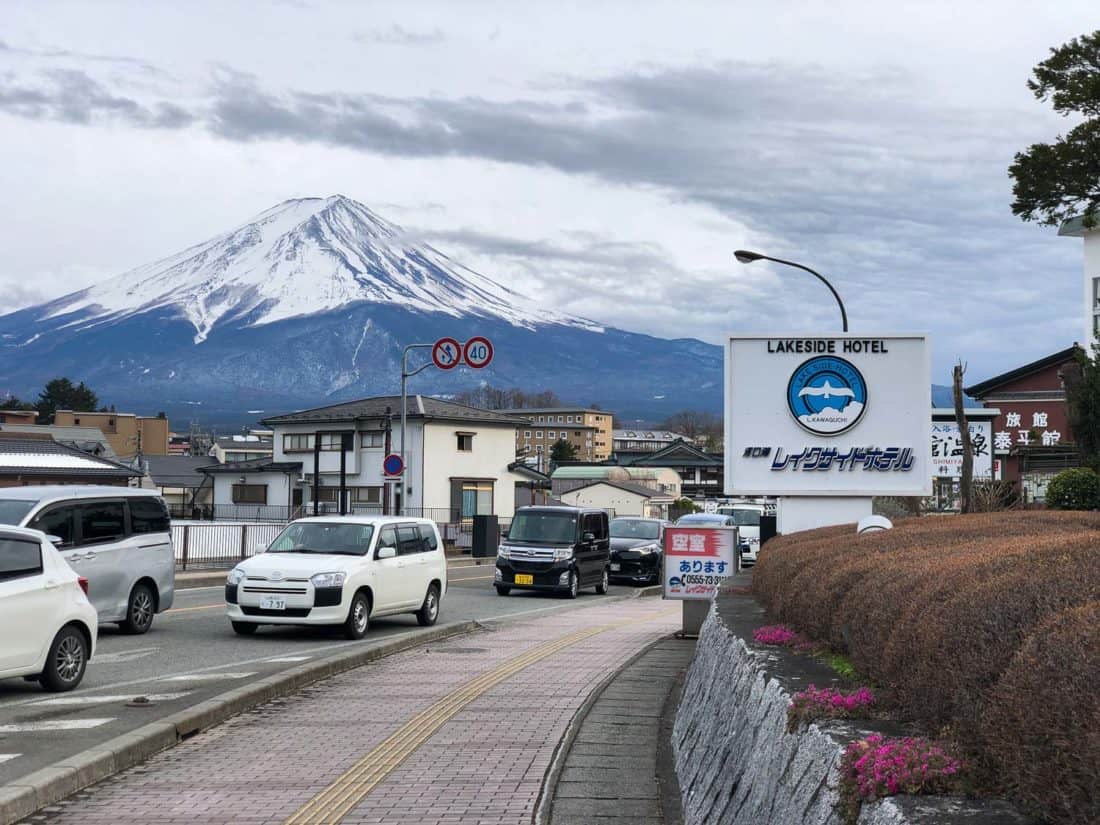
We spent three nights at Kawaguchiko Lakeside Hotel, which has a great location on the south shore near the Kawaguchiko Ohashi Bridge about halfway between the station and the north shore of the lake. There’s a bus stop across the road.
Many of the rooms have Mt Fuji views (and you can see the mountain if you step outside), but we stayed in a budget twin room without a view as that’s all that was available.
It was the largest room we’ve stayed in in Japan with four separate areas—a bedroom with Western-style twin beds, a tatami mat living room with a low table, fridge and TV, a large hallway with a wardrobe, and a small bathroom.
The heating kept us warm when the temperature plummeted.
The staff are very friendly and picked us up from the station (and dropped us back) and let us check in early (unusual in Japan).
There’s a restaurant that we didn’t use (but it gets good reviews from other guests) and a small onsen (hot spring bath). The onsen is nothing special (no view), but it was quiet and relaxing.
It’s a convenient and affordable option in Kawaguchiko.
Unfortunately, they are no longer on Booking.com (our favourite hotel site) and the Lakeside Hotel website is in Japanese only.
Other Options
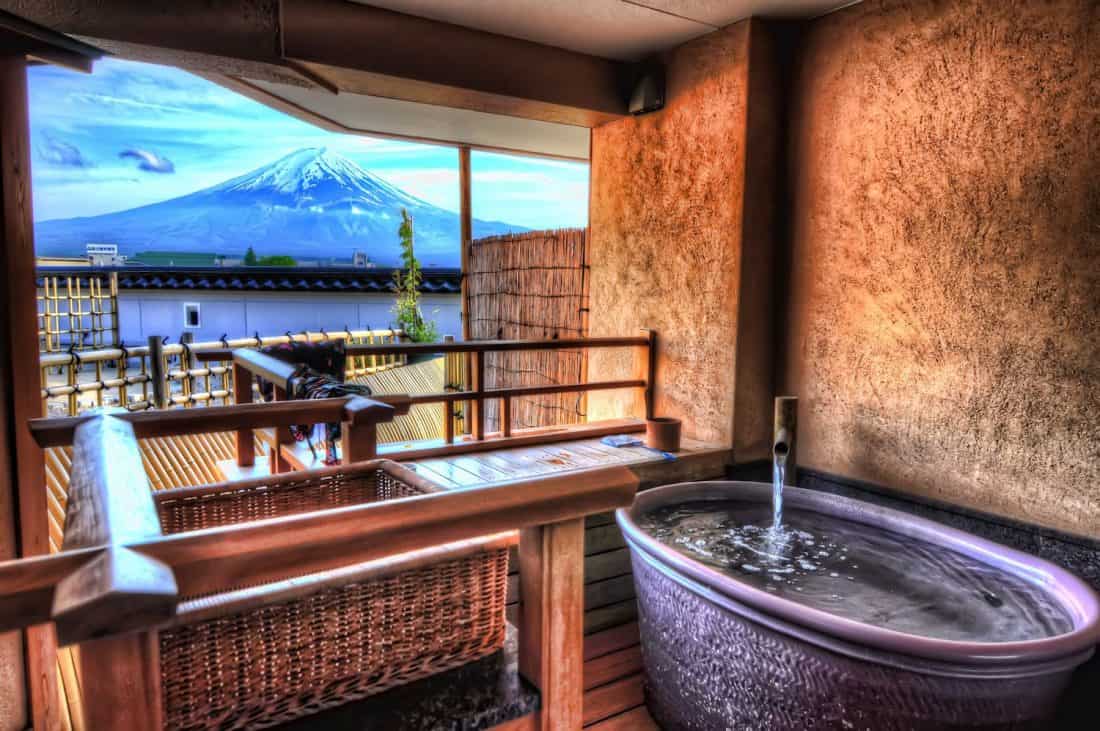
Hotel Konanso photo by Chris Robinson .
There are many Lake Kawaguchi hotels and ryokans with amazing views.
I was very tempted by Fujikawaguchiko Onsen Konanso , but it was already booked up.
It has a fantastic location on the lake near the ropeway, and best of all, some rooms feature private outdoor onsens on their balconies with Mount Fuji views.
This is ideal if you are too shy for the public onsens. There are both Japanese and Western-style rooms.
Hotel Asafuji also has gorgeous views of Fuji-san and the lake from all of their Japanese-style rooms and onsens.
If you are on a budget, K’s House Fuji View Hostel is a great choice. It has dorm beds and private Japanese-style rooms, some with mountain views.
It’s quite far from the lake, but you can rent bikes on-site.
Search for more hotels and ryokans in Kawaguchiko here .
On arrival at Kawaguchiko Station, many hotels offer free transfers. For Kawaguchiko Lakeside Hotel we had to go to the Fuji Kawaguchiko Tourist Information Centre next to the station and they called the hotel for us.
When you arrive, pick up the useful tourist booklet which has maps and bus timetables.
We walked everywhere except for Chureito Pagoda, but you could also rent bikes from Fujisanbike or Soranoshita , both near the train station.
The sightseeing bus is also another option though they do get very crowded at popular times of the year.
There are red, green, and blue bus lines. The red line is the most useful as it’ll take you to the ropeway and north shore (but it’s a lovely walk).
The green line takes you to more distant, quieter spots such as Lake Saiko, but it only runs every 30 minutes. The blue line goes to Lake Motosuko.
You can buy a two-day unlimited pass for all of them for 1700 yen ($11.50) over 12 years old/ 850 yen ($6) children 6-11 years old.
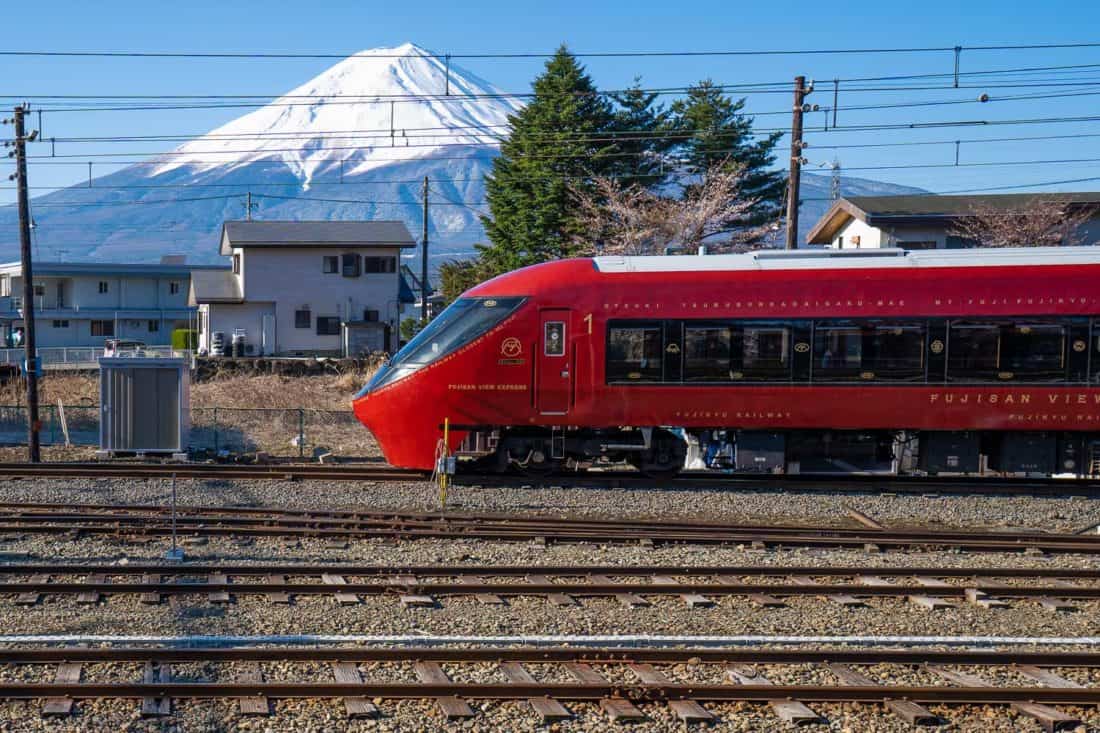
Check train times and prices on the Navitime website or app .
If you will be travelling around Japan by train, read my post on is a JR Rail Pass worth it .
Tokyo to Kawaguchiko
The easiest way to reach Kawaguchiko is from Tokyo and many people do come as a day trip.
If you are coming from Tokyo to Lake Kawaguchiko just for the day, it might be easier to take a tour such as this Mt Fuji Full Day Sightseeing Trip .
To travel independently, you can take the bus or train.
There is a direct bus, but we always prefer the more comfortable train travel in Japan.
The Fuji Excursion train offers direct access from Shinjuku to Kawaguchiko in 1 hr 49 minutes. There are two round trips every day so it works well as a day trip.
If you have a Japan Rail Pass , only part of your fare is covered—you have to pay an additional 1740 yen ($12) fee for the section past Otsuki.
A cheaper option is to take the JR Chuo line from Shinjuku station to Otsuki (covered by the Japan Rail Pass) and change to the Fujisan limited express (1170 yen/$8, not covered by the pass). The whole journey takes at least 2.5 hours.
Hiroshima or Kyoto to Kawaguchiko
If you are coming from the south, it’s more challenging as the nearest shinkansen (bullet train) is at Mishima.
From here you need to take a Fujikyu Bus which takes 1.5 hours and costs 2500 yen ($17), children half price. It’s best to book the bus in advance .
From Kyoto it takes two hours to reach Mishima direct on the Hikari shinkansen. From Hiroshima, it’s at least four hours (with one change).
We were coming from Okayama, which is 3.5 hours to Mishima, and chose to break up the journey with an overnight stay in Mishima.
The Dormy Inn is an affordable option near Mishima station with an onsen and Mt Fuji views (if it’s not pouring with rain as it was for us).
Cafe Bain Marie is a cosy bar with good food and vegetarian options.
There are a few good vegetarian options in Kawaguchiko, although we had to resort to Italian for some variety.
You can also see our vegetarian Japan guide for more tips on avoiding meat and fish while travelling the country.
Fuji Tempura Idaten
This tempura restaurant near the station has a vegetable tempura set which you can order with rice. Vegetarians should skip the miso soup and noodles as they contain dashi (fish stock).
It’s open from 11am – 9pm so it’s a good option when other restaurants are closed (many don’t open until 6pm). It can get very busy.
Pizzeria Onda
Delicious authentic pizza and spaghetti with tomato sauce. Open for lunch 11.30am – 2.30pm and for dinner 6pm – 10pm. Closed Thursdays.
Another Italian restaurant near the station. It’s not as good as Pizzeria Onda, but we enjoyed the pizza and vegetable pasta. Open for lunch 11.30am – 2.30pm and for dinner from 6pm – 9pm. Closed Mondays.
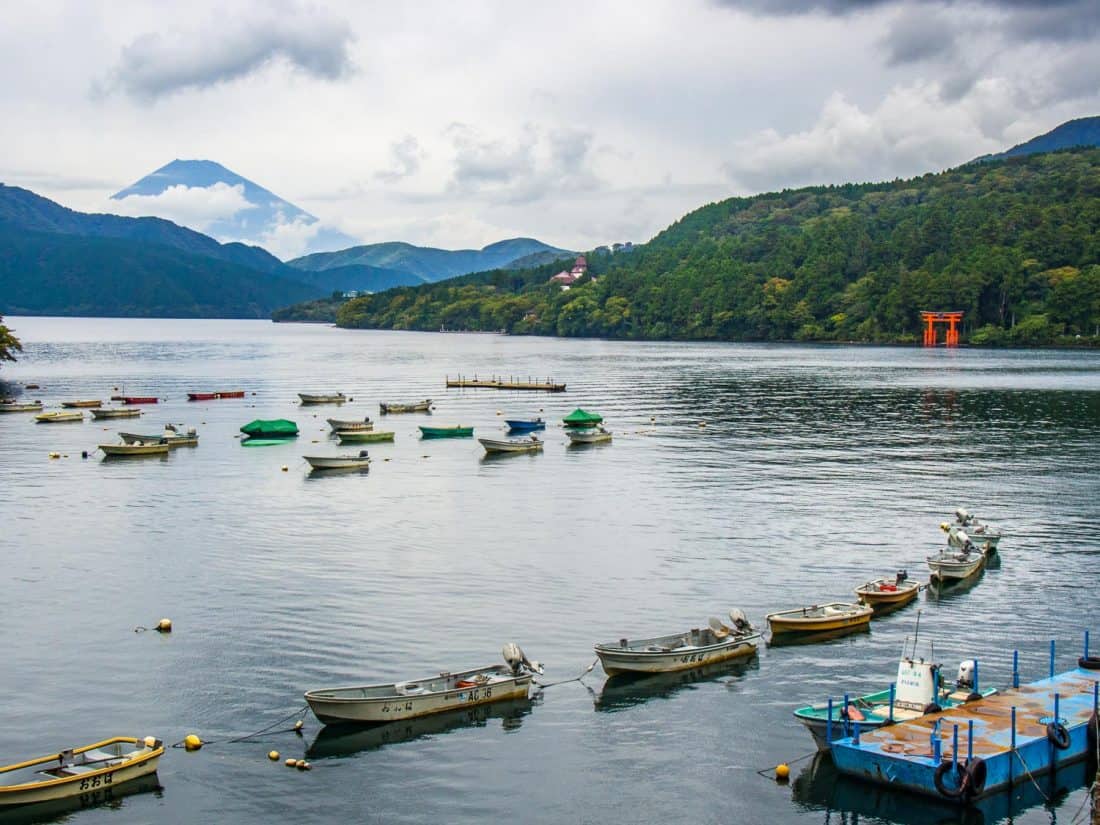
We’ve visited Hakone and Kawaguchiko to see Mount Fuji and enjoyed them both.
Kawaguchiko has the best view of Mount Fuji as it’s closer and you can see it from more viewpoints.
At Hakone the base of Fuji is hidden by other mountains and it feels further away.
We really enjoyed our trip to Hakone, though, and it was still magical seeing the famous mountain.
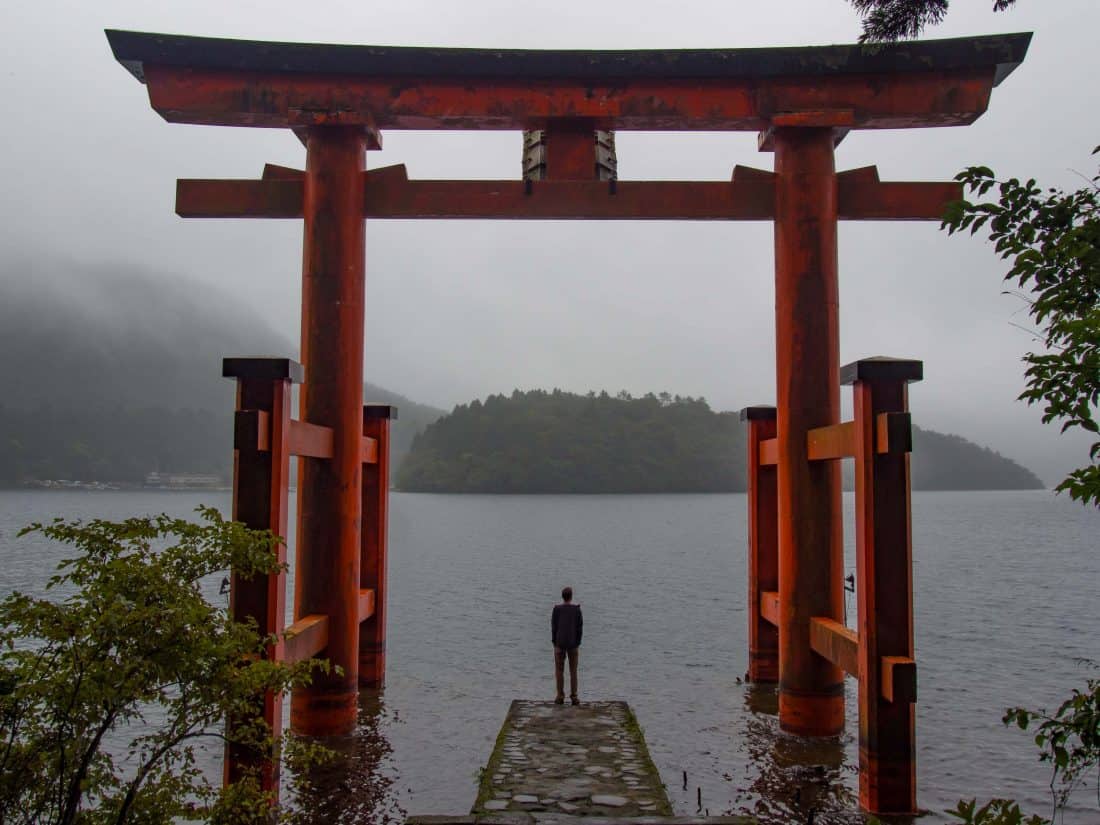
There are many attractions beyond Mt Fuji and the Hakone Free Pass is a great way to get around. You follow a loop that includes trains, a pirate ship, ropeway, and cable car and can hop on and off as you like.
Attractions in Hakone include Owakudani , an active volcanic valley which you reach by ropeway, and the Hakone Open Air Museum featuring outdoor sculptures and unusual art installations.
We felt more in nature at Hakone than we did at Kawaguchiko, which was busier and more developed.
Hakone is known for its many onsen, and there are some beautiful ryokans with hot springs to soak in, such as Yoshiike Ryokan .
But in Kawaguchiko there are more ryokans and hotels (and even hostels) that offer Mount Fuji views from your room. There aren’t many options for this in Hakone.
It’s easier to fit Hakone in between a typical Tokyo – Kyoto itinerary. The nearest station on a bullet train line is Odawara, which can be reached from Tokyo in 30 minutes on the JR Tokaido Shinkansen.
From Odawara you can purchase a transport pass and take the bus for one hour to Moto Hakone (where we stayed).
See our Japan two week itinerary for more details of our Hakone visit.
I would visit whichever fits into your overall itinerary better. If you have to pick just one and your main focus is seeing Mount Fuji, I’d choose Kawaguchiko.
Remember that the view you get of Mount Fuji from either town is highly dependent on the weather.
Kawaguchiko is well worth adding to your Japan itinerary if you want to see Mount Fuji.
It’s the best place in the country to see the iconic mountain. If you get lucky with the weather, the views are superb and it’s a relaxing break from the big cities.
- Planning a Trip to Japan: DOs & DON’Ts
- Unmissable Places to Visit in Japan
- 56 Best Things to Do in Japan for an Unforgettable Trip
- Two Weeks in Japan: A Detailed Itinerary
- Is a Japan Rail Pass Worth It?
- Where to Stay in Japan: The Ultimate Guide to Accommodation
- 20 Fascinating Books to Read Before Visiting Japan
- Vegetarian Survival Guide to Japan
If you enjoyed this post, pin it!
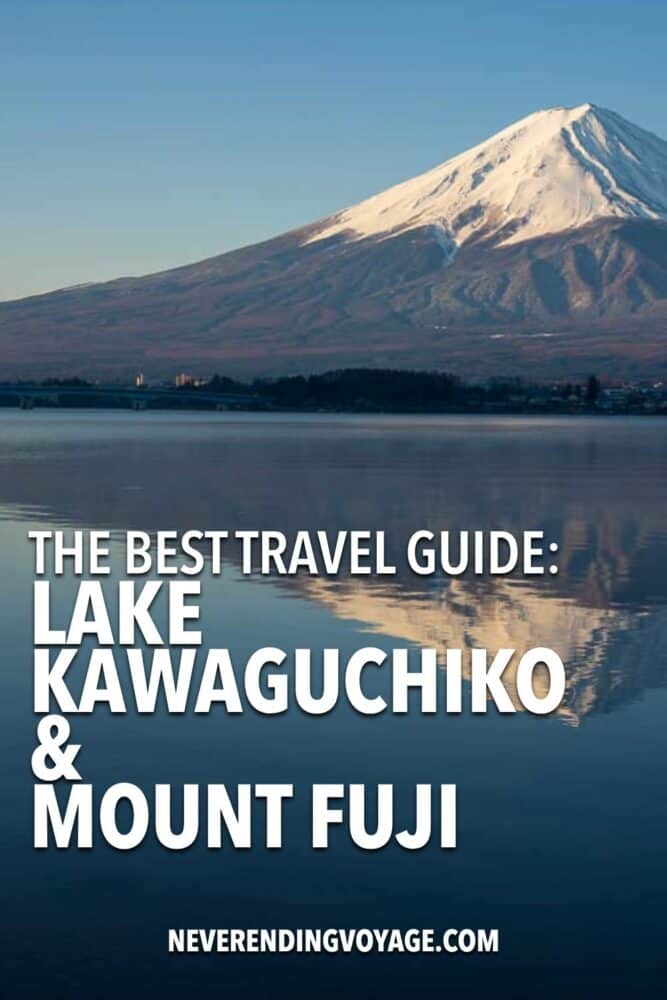
Hi Erin, would like to ask, how long did it take you on the bus ride from Shinjuku to Kawaguchiko station?
Do you think it would be faster by train or bus to Kawaguchiko from Tokyo?
Thank you, Rei
Reply ↓
We travelled by train, which is what I would recommend.
We just booked for next week and will be using your recommendations! Thank you!
Hello Simon & Erin,
How wonderful that the two of you make the world your home! My husband & I are also consumed by wanderlust and have been to many places around the globe. We have been to Tokyo but not to Kyoto so as soon as the pandemic is over & a safe vaccine is available, we are going to Tokyo-Kyoto-Seoul-Mongolia. Since Japan is navigable, I am thinking of taking the Limited Express Train from Shinjuku to Kawaguchiko station for the day. A few questions please:
1) Can we just purchase a live guided tour of Kawaguchiko sites right at the station itself? Do they have a counter to book tours inside the station?
2) Can we purchase bus tickets for the Retro, red, blue & green buses right at the station or do you advice we buy them ahead of time?
3) What is the difference between Kawaguchiko and Kawaguchi?
Any advice or help you can give us will be greatly appreciated. I loved reading your blog on Kawaguchiko. Thank you.
That sounds like an exciting trip!
1) I didn’t see any tours advertised at the station. There’s an information centre next to the station so you could ask there. 2) You can buy bus tickets on the bus or purchase an unlimited 2 day pass. No need to get them in advance. 3) Ko means lake so Kawaguchiko means Lake Kawaguchi. There is another city called Kawaguchi near Tokyo.
Hi! Hubs and I are going to Tokyo-Kyoto in November. Planning to stop by Hakone and Lake kawaguchiko for 3d2n before heading to Kyoto.
How best do you think we should split up our 3d2n time in these 2 areas? Just wanna soak in nature and not interested in the nearby outlet area.
Is it easier to travel to Kyoto from Hakone or from Lake Kawaguchiko? There are so many lines in Japan we are kinda lost doing our research. Thanks a bunch!!!
It’s easier to go from Hakone to Kyoto.
Mishima or Odawara are the nearest shinkansens station to Hakone and Kawaguchiko and you’ll need to get there by bus before continuing by train to Kyoto (2 hours from Mishima).
I would go from Tokyo – Kawaguchiko – Hakone (via Odawara) – Kyoto.
You’d have to get the bus between Kawaguchiko and Hakone with a change. Honestly, it’d be more relaxing/less travel if you just chose one of them to stay at. Hakone is definitely easier to fit into a Tokyo – Kyoto itinerary.
Another option depending on how long you have in Tokyo is to do a (long) day trip from there to Kawaguchiko by train. This will save having to travel with luggage and having to get the bus between Kawaguchiko and Hakone.
Enjoy Japan!
Leave a Reply Cancel reply
Required fields are marked *. Your email address will not be published. By clicking the Submit button, you give consent for us to store your information for the purposes of displaying your comment and you accept the terms of our Privacy Policy .
This site uses Akismet to reduce spam. Learn how your comment data is processed .
How To Travel To Kawaguchiko, Mt. Fuji Area
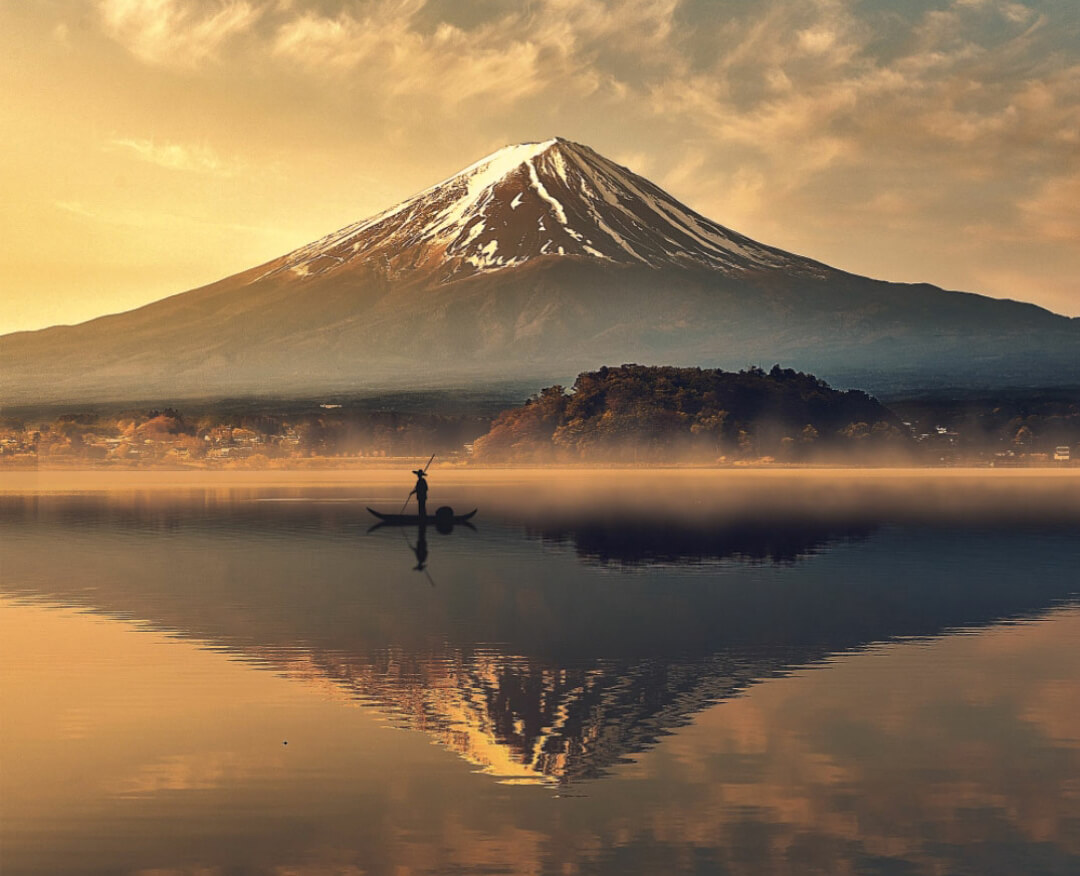
When you think of Japan, Mt. Fuji will undoubtedly quickly pop into your mind. This majestic mountain is one of the main icons with a prominent role in Japanese culture and history. The highest mountain in Japan was elected UNESCO World Heritage in 2013 and is climbed by 300,000 people every year!
Together with Mount Haku and Mount Tateyama, Mount Fuji composes the ‘Three Holy Mountains’. They are considered sacred places and believed to have special powers. For this reason, many people want to visit the mountain, especially, Mt. Fuji being the highest mountain in Japan. The most popular area is the Kawaguchiko area (Lake Kawaguchi), one of the “ Fuji Five Lakes “. With a direct connection to Tokyo, this place is popular for day trips as well as weekend trips.
In this article, we will discuss several options to get to the Kawaguchiko area from Tokyo. If you are interested in activities in the area, other than climbing Mount Fuji , have a look at our blog: Fun Things to Do around Mount Fuji (Kawaguchiko Area)
Disadvantage of the bus
Disadvantage of the train, disadvantage of the car, getting around in kawaguchiko, recommended hotels in fujikawaguchiko:, 1. the easiest way: bus.

The main advantage of taking a bus is that is “easy”. With easy we mean that there is a direct bus from Tokyo, that will take you in about 2 hours to Mount Fuji-san. Another bonus is that it’s also cheap! Depending on your departure station, costs will approximately be ¥2,000 – ¥2,500, depending on the time and day. Below are three different options:
- From Shinjuku station The biggest bus terminal Busta Shinjuku is located at the south gate of Shinjuku station. 30+ busses depart here every day to Kawaguchiko. You can buy a direct ticket from this website . Kawaguchiko is Yamanashi prefecture . Or, we offer a day-trip bus tour from Shinjuku Station where the professional guide will take you to all the must-visit highlights in the Kawaguchiko area. If you are looking for not only the easiest way of transportation but also the best way to explore the area in one day, taking a guided bus tour is the best option for you! ▶ Book Mt. Fuji Day Trip Bus Tour from Tokyo
- From Tokyo station Another option is to depart from Tokyo station. Please check this website . This is less busier than the Shinjuku route.
- Kosokubus.com – several departure points The organization runs from different stations in Tokyo including Ikebukuro and Shibuya.
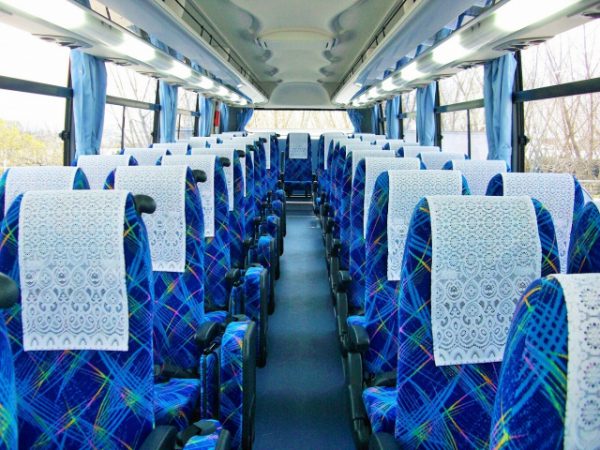
- Sell out very quickly, a timely reservation is recommended!
- The buses are often busy.
- The bus is also affected by traffic jams, especially during the spring and summer seasons, the bus might be late because of traffic jams.
2. The comfortable way: train
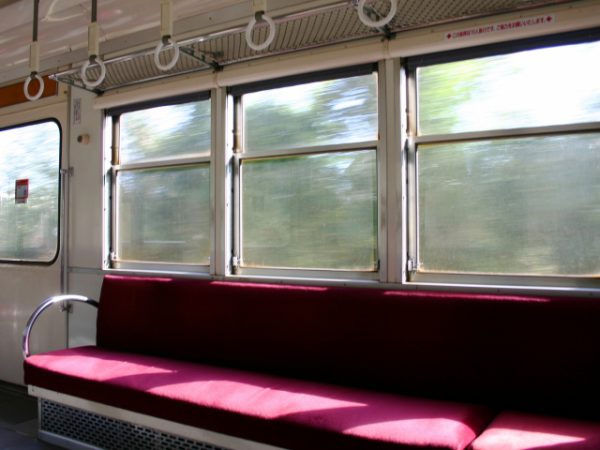
The most comfortable option to go to Kawaguchiko area is travelling by train. Trains are not effected by traffic jams, often aren’t late (in Japan) and not crowded. Plus, if offers more flexibility to your itinerary. Especially with the JR Rail Pass, this option is probably the best and cheapest option.
From Tokyo to Kawaguchiko by train will take you approximately 2 – 3 hours and cost you ¥2.500 – ¥3.500 (Shinjuku station – Kawaguchiko station)
- From Shinjuku station take JR Chuo line Otsuki Station *Being covered by JR rail pass.
- At Otsuki station change train to FujiKyuko *Not being covered by JR rail pass.
Another option is taking the direct train from Shinjuku station to Kawaguchiko station, the Chūō Line will take you there in a little under 3 hrs and is covered by the JR Rail Pass.
Shinjuku station in enormous and you can easily get lost. But with several trains every hour, you will be fine. Just calculate some extra time to find your train. Check your timetable at GoogleMaps or any planner you use.
3. The flexible and luxury way: car
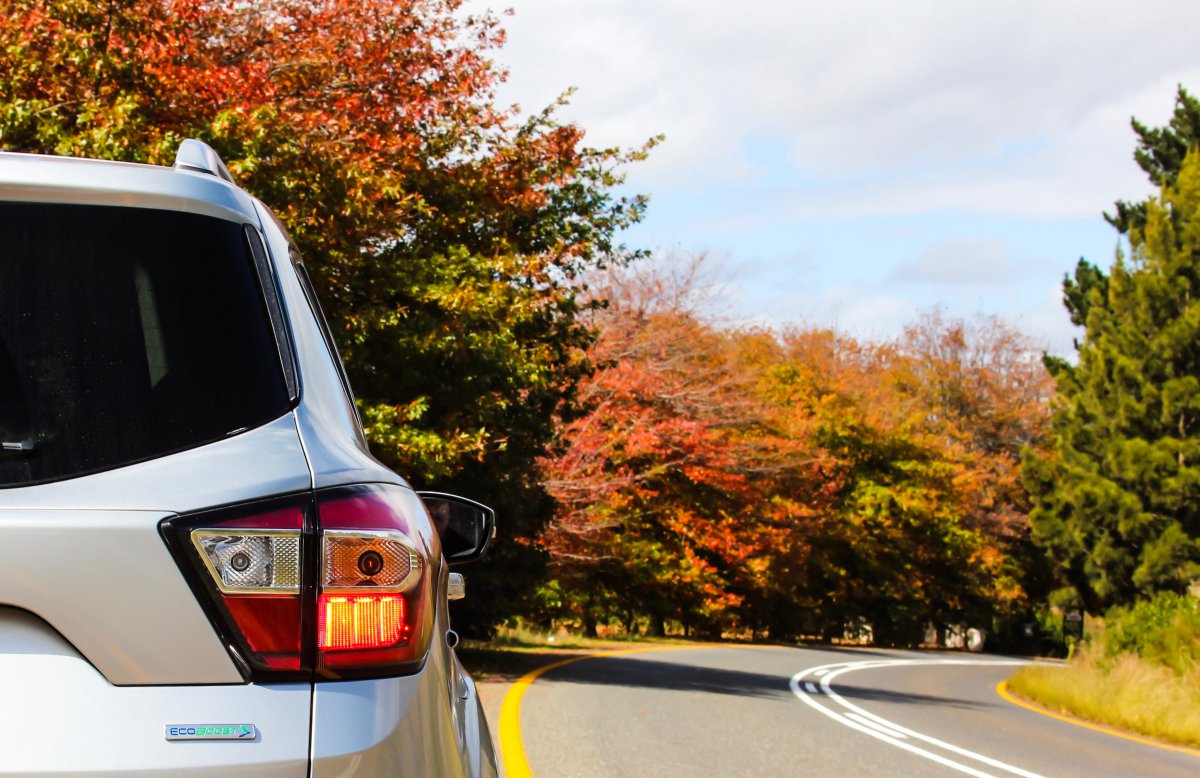
The option that gives you a lot of freedom and is comfortable is renting a mini-van or car. The price for renting a car in Tokyo for a day starts at approximately ¥3,500. That doesn’t include gas and also bear in mind you will you some tollways. But especially when you are travelling with a (small) group, this might be your preferred way. Driving in Japan is very safe, just make sure you know the main road rules. Also Japan has very strict drink-driving laws.
A car will give you a lot of flexibility, as you can easily make a stop whenever en wherever you want. Also, you are not dependent on the time schedule of the public transportation.
You will need a legal International Driving Permit / international driving licence, without one you cannot rent a car in Japan. So make sure to bring the right documents. If you are interested in renting a car or a mini-van, we can make the arrangements for you, please send us a message.
- When travelling solo or as a couple, this can be expensive. Also, when you are not returning the car to the same pick-up point, you will be charged extra.
- You are affected by the traffic, especially during spring and summer season, the road can be busy and you can get stuck in traffic.
- If you do not speak Japanese and get in an accident, you might experience difficulties.
If you decide to travel to the area by car, you can easily make your way around in the area. But if you decide to opt for the bus or the train, you will need additional transportation to get around. In the area, the JR Pass is not of much help as there are no JR trains or buses covering the area. Fortunately there is another option: the Sightseeing Bus. There are three different bus lines that cover the Mount Fuji area departing all from Kawaguchiko station. For ¥1,500 you can buy a two-day unlimited rides pass for the buses. Please find the timetable and details at the official website.
Which of the above mentioned options do you prefer? The lake area around Mount Fuji is exceptionally beautiful and we cannot recommend you highly enough to travel there. Now that you know how to get there, here are some fun thing to do in the Mount Fuji area (Lake Kawaguchi) what to do there .
If you are interested in our guided tour , please let us know. We are happy to customise the tour according to your wishes.
We hope you have a great time and see beautiful Mt.Fuji!

- Dot Hostel&Bar
- Kawaguchiko Urban Resort Villa
- Mizno Hotel
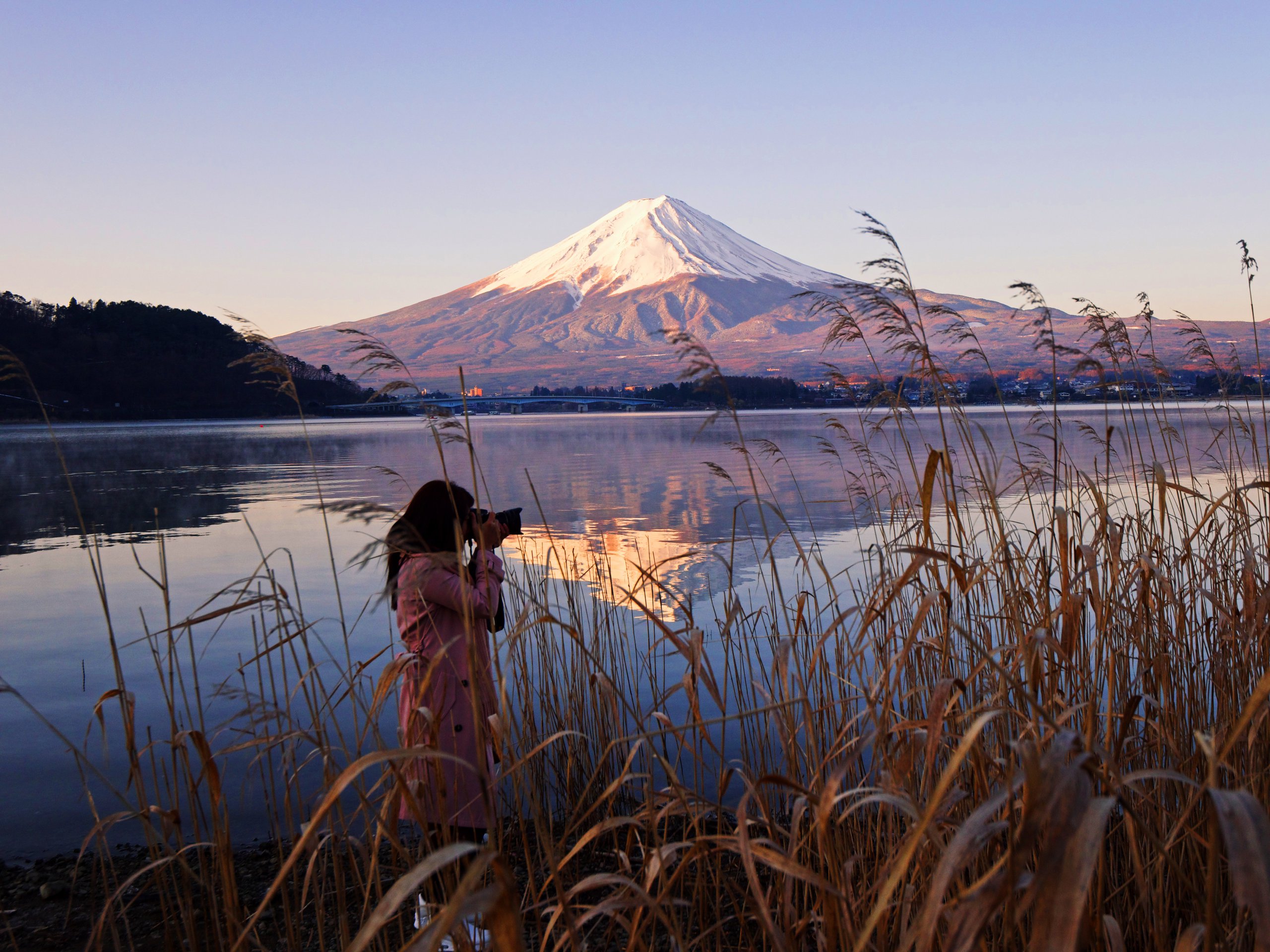
- Popular destinations
- Hidden places in Japan
- Tours and workshop
- Food and drink in Japan
- Itinerary in Japan
- Places to visit in Tokyo
- Food and drink in Tokyo
- Seasonal events
- Tours & workshops
- Tokyo This Week
- Day trip from Tokyo
- Itinerary in Tokyo
- Places to visit in Kyoto
- Food and drink in Kyoto
- Itinerary in Kyoto
- Day trip from Kyoto
- Travel tips
- Accommodation
- Cultural tips
- Transportation
- Tokyo Tours
- Kyoto Tours
- Kimono Rental
- Fukushima Tours
- Mount Fuji Tours
- Tour Package
- Media Kit(English/日本語)
5 Places to Visit in Kawaguchiko and Mt Fuji Lakes + Things To Do

The lakeside town of Kawaguchi-ko offers one of the most beautiful views of Mount Fuji. This resort area is 1.5 hours away from Shinjuku via express train. It’s a popular day tour destination from Tokyo, but with all the cool spots to go and fun things to do in Kawaguchi-ko and the surrounding area, spending a night or two is a good idea too!
1. Chureito Pagoda
Location : 3353-1 Arakura, Fujiyoshida, Yamanashi, Japan . Save on Google Maps .
Perhaps the most photographed spot in all of Japan, Chureito Pagoda offers a majestic view of Mount Fuji with the iconic five-story pagoda. The best time to go is early morning before clouds come rolling in. It is common not to see a view of Mt. Fuji because of heavy cloud cover. There’s a good chance of seeing Mt. Fuji in the late afternoon hours as well. To get the picture-perfect shot you’ll need to walk 400 steps uphill at Arakurayama Sengen Park. The nearest train station is Shimoyoshida Station.
Mt. Fuji and Lake Kawaguchi Scenic Spots Day Tour from Tokyo
See discounts

To make your trip planning easy, I added links to the locations on Google Maps. Feel free to click/tap on the links posted. Then, use the “save” feature on the Google Maps app for easy reference. I’ve also shared photos from my Instagram feed . Feel free to use Instagram’s save feature for quick access later.
Follow me on Instagram
2. Oishi Park
Location : Kawaguchi-ko Lakeside . Save on Google Maps .
Perfect for enjoying a view of Mount Fuji together with peaceful lakeside ambiance and flower garden. There are seats scattered about and coffee, cake & ice-cream from the gift shop. Go early morning or late afternoon to catch the beautiful soft light and a higher chance to see a clear view of Mount Fuji.
Mt Fuji Classic Route Day Tour from Tokyo with Matcha Experience
Mt Fuji Day Tour from Tokyo
3. Fugaku Wind Cave

Location : Aokigahara Forest, | Near Saiko Lake, Narusawa-mura Yamanashi . Save on Google Maps .
Surrounded by towering trees of the Aokigahara forest, the Fugaku Wind Cave is a 201-meters lava-created cave that features chambers filled with naturally-frozen icicles. In the olden times, it was used by the locals as a natural refrigerator, to store silkworm eggs and seeds. If you’re looking for interesting places to visit in the area other than viewpoints of Mt. Fuji, do check out the the Fugaku Wind Cave, and nearby Narusawa Ice Cave.
4. Fuji Tempura Idaten

Location : 3486-4 Funatsu, Fujikawaguchiko . Save on Google Maps .
I enjoyed a meal at this popular restaurant near Kawaguchiko train station. For a gastronomic Mt. Fuji experience, try the Fujisan Tendon, their specialty dish inspired by the iconic volcano. With 6 big shrimps likened to cone-shaped Mount Fuji, green peppers likened to “Jukai” Fuji forest, Salmon roe likened to Mount Fuji’s lava and eggplants likened to Mount Fuji’s crater.
5. Fujikyu “Thomas the Train” ride

I was able to ride the Thomas-themed train on my way to Fuji-Q highland, a theme park which is home to a ‘Thomas Land’ area. This is sure to excite fans of the train-themed kid show, Thomas & Friends.
Where to go near Kawaguchi-ko
Shiraito Falls
Location : Fujinomiya, Shizuoka near Kawaguchiko, Mount Fuji Five Lakes area . Save on Google Maps .
If you’re a big waterfall chaser, don’t miss Shiraito Falls, one of the prettiest in Japan! It’s located in the foothills of Mount Fuji and can be reached as a day trip from Kawaguchi-ko. Shiraito no Taki literally means “the waterfall of white threads”, which aptly describes its appearance, as multiple streaks of water drape over the surface forming what seems like a white curtain. I went here during summer & enjoyed the lush greens. If you want a more colorful view, I recommend going during the autumn season.
Mt. Fuji Pass
Gotemba Premium Outlet Shopping Mall

Location : Shizuoka near Mount Fuji . Save on Google Maps .
With over 200 stores, the Gotemba Premium Outlets is one of Japan’s largest outlet malls. On a clear day, you can enjoy a beautiful view of Mount Fuji. Gotemba Premium Outlets is a popular stopover of organized Fuji day tours from Tokyo. You can also visit while you’re on your way between Kawaguchi-ko and Hakone.
Location : Ashigarashimo District, Kanagawa, Japan . Save on Google Maps .
Hakone is another quiet lakeside town blessed with a view of Mount Fuji. It is farther away compared to Kawaguchi-ko but closer to the Tokyo-Osaka Tokaido Shinkansen bullet train route. On a day trip, I enjoyed the Pirate ship boat ride across Lake Ashi, ropeway to the Owakudani sulfur mine, and got to see the iconic Torii at Hakone Shrine.
Top discounts
JR Pass for Whole Japan
Japan Trail and Shinkansen Tickets
Hakone Freepass (2 or 3 Days)
What places have you added to your bucketlist? Have you been to beautiful places in Kawaguchiko that should be on this list? Feel free to share your thoughts!
Places to visit in Kawaguchiko
Kawaguchi-ko tourist spots, things to do in Kawaguchiko, where to go in Kawaguchiko & more.
Note: Destinations featured above are not listed by rank.
Where to Stay in Kawaguchi-ko
Click below & search recommended Kawaguchi-ko hotels/hostels/home rentals within your budget. Remember to set your min/max price , travel dates, and sort by review ratings . I often book online with these trusted booking sites below for rock-bottom prices & convenient bookings.
Agoda Airbnb Booking.com
Book sooner rather than later if you already have your dates set. Cheaper-priced rooms and hotels with high reviews tend to get fully booked faster, especially during busy days like weekends, holidays & peak tourist seasons.
Kawaguchi-ko Essentials & Top Discounts
Japan mobile data sim card/pocket wifi.
Travel with ease & confidence throughout your trip. Get a data SIM card or pocket WIFI device! Access Google Maps and all your favorite travel apps. Share your travel stories instantly with all your friends. Click below and choose your pick-up location:
Japan SIM card Pocket WIFI See all discounts
Popular discounts and tours booked by other travelers:
Fuji-Q Highland Free Pass Ticket
3 Day JR Mt. Fuji Shizuoka Area Tourist Pass Mini
Asia 4G LTE WIFI Hotspot (Manila Airport Pick Up)
Click below to see more on:
Klook GetYourGuide
Don’t Stop Here
Click below for more travel inspiration:

Don’t leave yet. There’s more!

Discover more blogs and travel tips in:
Leave a Reply Cancel reply
Your email address will not be published. Required fields are marked *
This site uses Akismet to reduce spam. Learn how your comment data is processed .
May 8, 2020 at 5:06 pm
Your Japan travel and photos are really awesome!
- Japan Tourism
- Japan Hotels
- Japan Bed and Breakfast
- Japan Vacation Rentals
- Flights to Japan
- Japan Restaurants
- Things to Do in Japan
- Japan Travel Forum
- Japan Photos
- All Japan Hotels
- Japan Hotel Deals
- Last Minute Hotels in Japan
- Things to Do
- Restaurants
- Vacation Rentals
- Travel Stories
- Rental Cars
- Add a Place
- Travel Forum
- Travelers' Choice
- Help Center
Transporting Tokyo to Kawaguchiko, Direct Train - Japan Forum
- Asia
- Japan
Transporting Tokyo to Kawaguchiko, Direct Train
- United States Forums
- Europe Forums
- Canada Forums
- Asia Forums
- Central America Forums
- Africa Forums
- Caribbean Forums
- Mexico Forums
- South Pacific Forums
- South America Forums
- Middle East Forums
- Honeymoons and Romance
- Business Travel
- Train Travel
- Traveling With Disabilities
- Tripadvisor Support
- Solo Travel
- Bargain Travel
- Timeshares / Vacation Rentals
- Asia forums
- Japan forum

We bought the tickets in advance through the online website. On the website, this train can be navigated through selection of ' chou line '.
Please note, the total train fare has to include ' base ticket fare ' and additional ' express/ special train fare '. We selected to buy both online.
A QR code can be generated online to collect the paper tickets through a vending machine. We took the tickets from a vending machine at Tokyo station . You have to check online as to from which stations you can collect the tickets.
At Kawaguchiko station when you get down, it is checked if the total fare is paid or not. We saw a lot of tourists being guided to pay the ' base fare ' before exiting the gates at the station .

- Split payment Suica Card and cash/credit card JR East 1:25 pm
- Nagano to Tokyo following alpine route. 1:03 pm
- Paxlovid Rx 1:03 pm
- Boarding pass to re-enter security at Haneda 12:59 pm
- Welcome Suica from 2 years ago 12:40 pm
- Where to buy Tsumura medical Chinese herbal preparation ? 12:36 pm
- Short visit to Tokyo / Osaka with kids 12:30 pm
- Nokonoshima Island to Nagasaki 10:49 am
- One day in Kyoto. Please suggest on my itinerary 10:44 am
- Hakone-Fuji Five Lakes- Kyoto Questions: Need help! 10:39 am
- Fushimi Inari worth without hiking? 10:23 am
- Can we see Mt.Fuji while going from Kyoto to Tokyo? 10:18 am
- Tateyama Kurobe Alpine Ticket 8 days 9:45 am
- Tea ceremony and flower arranging 9:25 am
- 'semi double' rooms 5 replies
- Pocket WiFi Rental Experience? 315 replies
- kyoto-takayama JR or Lmtd express??? 6 replies
- Best Japan travel guide book? 29 replies
- Best/cheapest time of year to visit?? 3 replies
- Radiation danger in Tokyo? 37 replies
- Best Skiing in Japan? And When? 3 replies
- Japan in 10 days 3 replies
- How far is Nara from Kyoto 8 replies
- how to get to Hokkaido from Tokyo? confused..pls HELP. 5 replies
- 2024 public holiday chart in East Asian countries
- Where can I find more onsen in Japan?
- Driving Information
- Catholic mass in English and other languages
- How can we access tourist attraction from cruise port?
- Pocket WiFi Rental Experience?
- Halal Information
- Tokyo trip report here
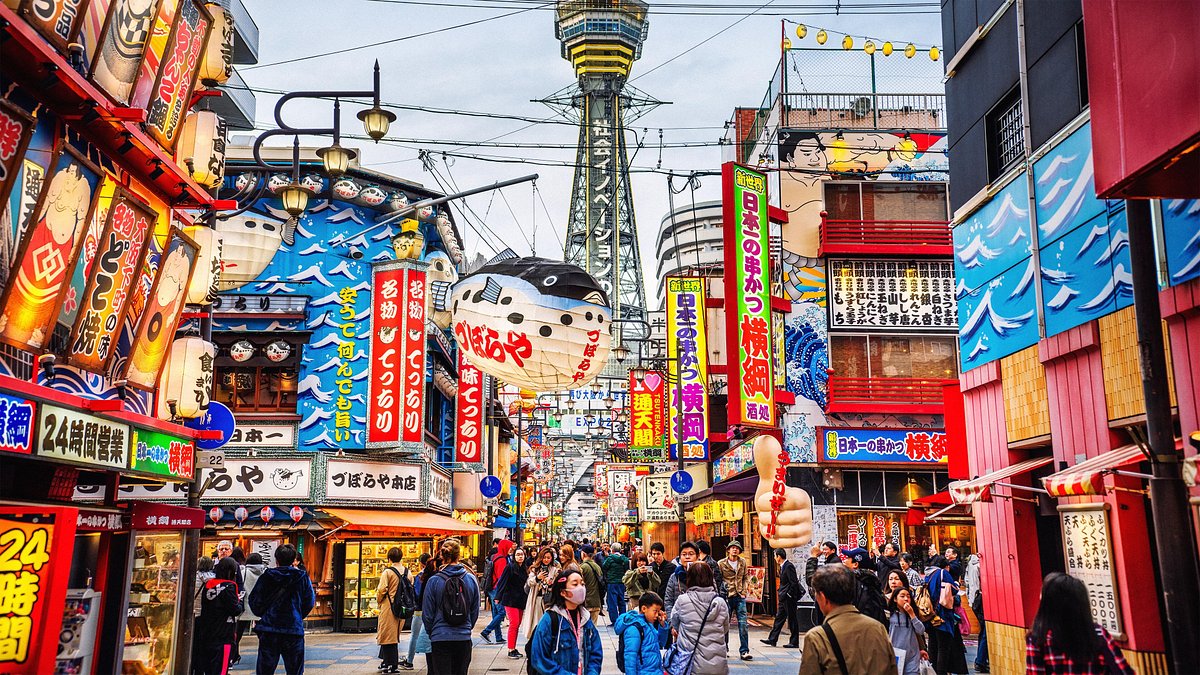
Skip to content
Your browser does not support JavaScript, or it is disabled.Please check the site policy for more information.
- National Report
- Korean Peninsula
- Around Asia
- Manga & Anime
The Asahi Shimbun
Base opens for high tourist spot offering ‘best’ view of Mt. Fuji
By SHIN TOYOHIRA/ Staff Writer
April 25, 2024 at 17:49 JST

FUEFUKI, Yamanashi Prefecture—A tourist base opened here on April 25 to lure foreign visitors to a little-known spot high in the mountains that is touted to offer the most spectacular view of nearby Mount Fuji.
Lily Bell Hutte, equipped with a cafe, shop and tourist information center, serves as the gateway to Fujiyama Twin Terrace, which sits on the 1,600-meter-high Shindo Pass.
The ridge straddles the city of Fuefuki and the town of Fuji-Kawaguchiko, both in Yamanashi Prefecture.
“Mount Fuji seen from Twin Terrace is the best in Japan,” said Masakatsu Okawa, manager of the Kofu branch of JTB Corp., the travel agency that operates Lily Bell Hutte. “But the spot is not yet widely known among foreign tourists.”
Visitors can view the majestic Mount Fuji, down through to its base, Lake Kawaguchiko and, far in the distance, Lake Yamanakako on a clear day.
It was a hidden spot known only to hikers and photographers, but the Fuefuki city government spent 178 million yen ($1.1 million) on constructing viewing decks and walking trails in 2021.
The Twin Terrace observation decks are not accessible by private vehicles because the roads are narrow.
Visitors take a 10-minute bus ride from the Suzuran Gunseichi parking lot, which is located in front of Lily Bell Hutte at an altitude of 1,300 meters, after parking their vehicles there.
Fuefuki Mayor Masaki Yamashita said he hopes that the new facility will help attract foreign tourists from Lake Kawaguchiko, a popular sightseeing resort, to the city and further onto other travel destinations in Yamanashi Prefecture.
“We need to create a place where (foreign visitors) want to come if we want to bring them over to Fuefuki from Kawaguchiko,” Yamashita said at the opening ceremony for Lily Bell Hutte on April 23. “We will be happy if we can establish a new route to travel around Yamanashi Prefecture via Fuefuki.”
The city government spent about 89 million yen on constructing Lily Belle Hutte.
Yamashita said he hopes to attract 100,000 visitors to Twin Terrace over the long term.
About 20,000 people visited the facility during the eight months through November, according to the city.
Jinji Yamada, JTB managing executive officer, said the company wants to increase visitor numbers to 50,000 this year with the opening of Lily Belle Hutte and other measures.
JTB on April 25 started a bus tour from Kawaguchiko Station on the Fujikyuko Line to Twin Terrace and back three times daily.
The tour costs 3,500 yen for an adult. The company expects 13,000 participants this year.
JTB is also considering offering guided tours along hiking trails around Twin Terrace as well as travel plans combining other attractions in Yamanashi Prefecture, such as dips at the Isawa Onsen hot spring resort and fruit picking at orchards.
The shuttle bus between the Suzuran Gunseichi parking lot and Twin Terrace will run until November.
The round-trip ticket costs 1,800 yen for an adult. The fare is 500 yen for Fuefuki residents.
There is a free bus service to the Suzuran Gunseichi parking lot from a location in Fuefuki where vehicles can be parked.
For more information, visit the city government’s website at ( https://www.city.fuefuki.yamanashi.jp/kanko/sports/spot/fujiyamatwinterrace.html ) or Lily Belle Hutte’s website at ( https://fujiyama-twinterrace.com/en/ ).
Related News

Observation deck to view Mt. Fuji opens in Fuefuki mountain pass

Yamanashi pushing railway plan on Mt. Fuji, but city opposes

Surge in visitors, ‘bullet climbing’ raise concerns on Mount Fuji

An old idea gains traction as railway on Mt. Fuji proposed

With prime view of Mt. Fuji, Shizuoka terrace is reeling them in
Trending Now
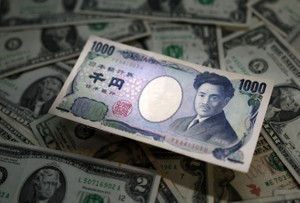
Eiheiji temple scanned to make breathtaking virtual twin
April 26, 2024

A rare Hokkaido scene: Camera captures ito in spawning season

Eight injured after earthquake rocks Shikoku and Kyushu
April 18, 2024
Recommended

Stories about memories of cherry blossoms solicited from readers

Cooking experts, chefs and others involved in the field of food introduce their special recipes intertwined with their paths in life.

A series based on diplomatic documents declassified by Japan’s Foreign Ministry

A series on the death of a Japanese woman that sparked a debate about criminal justice policy in the United States

A series about Japanese-Americans and their memories of World War II

Here is a collection of first-hand accounts by “hibakusha” atomic bomb survivors.
Learning English
- Asahi Weekly
In-house News and Messages
- The New York Times
BACK TO TOP
- Site Policy
- Transmission of user information to external service providers(利用者情報の外部送信)
Copyright © The Asahi Shimbun Company. All rights reserved. No reproduction or republication without written permission.

IMAGES
VIDEO
COMMENTS
Lake Kawaguchiko (河口湖) is the most easily accessible of the Fuji Five Lakes with train and direct bus connections to Tokyo.A hot spring resort town with various tourist attractions and views of Mount Fuji is located around the lake's eastern end, while the northern and western shores are mostly undeveloped.. The best views of Mount Fuji can be enjoyed from the lake's northern shores and ...
From Shinjuku Expressway Bus Terminal to Kawaguchiko Station it costs around ¥2,000 per adult, with a travel time of about 1.5 hours, depending on traffic. I recommend that you take the earliest bus from Shinjuku, at 6:05 a.m., as the chances of seeing Mt. Fuji in the early morning light is highly likely.
The small town of Kawaguchiko is the main home base for travelers looking to summit the majestic Mount Fuji, but there's much more to do than just visit Japan's tallest peak. Kawaguchiko centers around the lake of the same name, with plenty of hiking and biking trails, and beautiful places to visit. My time here felt like one of those ...
If you're looking to travel to Kawaguchiko from Tokyo, the most convenient option is taking a bus. It typically takes around 2 hours and costs between 2,000 to 2,500 yen. ... For more information on traveling to and around Kawaguchiko, we have an article that covers everything you need to know. Things to Do in the Kawaguchiko Area
Total travel time is about three hours from Tokyo Station and costs around 2,700 yen. The FUJI EXCURSION , a service that connects Shinjuku to Lake Kawaguchiko in an hour and 56 minutes, began its daily morning and night departures in 2019.
It is also because one of the key points of the trip to Kawaguchiko is to experience the hot spring hotel next to Kawaguchiko. So at around 16:00 in the afternoon, I left the scenic spot of Kawaguchiko and went to the reserved hot spring hotel room. Get the chance to enjoy hot springs and view Mt. Fuji from your room.
When it comes to getting around Lake Kawaguchiko, you've got a bunch of options to explore this peaceful paradise, and they won't break the bank. Renting regular bikes typically costs around 6,61 to $9,92 per day, while electric bikes might set you back around 9,92 to $16,53 per day. It totally depends on the type and duration of rental.
From Otsuki, take the Fujikyu Railway Line to Kawaguchiko Station (55 minutes, ¥1170 one way). There are also a few direct limited express trains per day between Shinjuku and Kawaguchiko in each direction (about 2 hours, around ¥4000 yen one way, seat reservations are mandatory).
A nice art museum where you can enjoy an excellent collection of Mt Fuji paintings by famous Japanese artists. Where is it: Just outside the entrance to Fuji-Q Highland amusement park, close to Kawaguchiko Station. Opening hours: 09:00 (9 am) - 17:00 (5 pm), until 20:30 (8:30 pm) on Saturdays and Sundays. Ticket price:
Kawaguchiko, or Lake Kawaguchi, is part of the scenic Fuji Five Lakes region, located at the base of Mt. Fuji, Japan's iconic and highest peak. The lake's origin is geological, formed by the lava flow from Mt. Fuji's multiple eruptions over the millennia. The area around Kawaguchiko has been a place of inspiration for centuries.
The area comprises five lakes: Lake Kawaguchiko, Saiko, Yamanakako, Shojiko, and Motosuko. These lakes all offer stunning views of Mount Fuji. Most visitors to the area stay in Kawaguchiko, as it is the most developed and accessible for tourists. Lake Yamanakako is the largest of the five Fuji lakes and has a small number of accommodation lodgings.
One of the most economical ways to travel to and from the Mt Fuji area is by highway bus from Shinjuku Station to Kawaguchiko Station. A single journey is JPY1750 and takes approximately 1 hour 45 minutes from the Shinjuku Bus Terminal. Return or one-way tickets can be booked online on the Highway Buses Japan site.
There are several rental bicycle shops around Kawaguchiko Station and the Lake Kawaguchiko Sightseeing Boat jetty. You can rent a bike for an hour, 3 hours, or a full day at the reasonable price of around 3,000 yen per day. ... Recharge after a busy day of travel with some delicious food and good sake. Visit Lake Kawaguchiko This Cherry Blossom ...
This pass is very useful for a Lake Kawaguchiko trip, since it covers the Fuji Excursion Express and the Fujikyuko Railway Line, the latter of which can be used to move around Lake Kawaguchiko. Klook.com. Another pass that makes it more convenient to travel around Lake Kawaguchiko is the 3-day JR Mt. Fuji Shizuoka Area Tourist Pass Mini. Some ...
SIGHTSEEING BOAT TOUR ON KAWAGUCHIKO LAKE. Last but not least on this list of things to do in Kawaguchiko is a sightseeing boat tour on the lake. It's a short 20-minute boat ride that departs from the shores of Lake Kawaguchi and will take you across the lake for breathtaking views of Mount Fuji and the surrounding landscapes.
Bus. To avoid the inevitable line at Kawaguchiko Station, you could catch a highway bus from stations across Tokyo, including Shinjuku, Shibuya, and Tokyo. Tickets start around US$13.21 *. and the ride takes about two hours, stopping at Fuji Q Highland on the way. You can book the return trip here.
Lake Kawaguchi is in southeastern Yamanashi near the border with Shizuoka. You can take a train or a highway bus from Tokyo. Take a train from JR Shinjuku Station to JR Otsuki Station on the JR Chuo Line (about an hour). Change to the Fuji Kyuko Line for Kawaguchiko Station (JR Rail Pass not accepted). You can also get to Kawaguchiko Station by ...
Lake Kawaguchiko Travel Itineraries. There are many different itineraries for touring around Lake Kawaguchiko area, a one- day trip may sound a bit tight but it is very practical for travellers who are on a short five day vacation and still want to make the most out of their trip. A Two-Day itinerary will allow travellers to visit almost all ...
Lake Kawaguchiko is one of the best places to see the iconic Mount Fuji. Japan's highest mountain (at 3776 metres) is a perfectly shaped volcano and looks especially stunning when snow-capped in winter and spring. Kawaguchiko is a town around the lake of the same name in the Fuji Five Lakes region. It's possible to visit on a day trip from ...
Especially with the JR Rail Pass, this option is probably the best and cheapest option. From Tokyo to Kawaguchiko by train will take you approximately 2 - 3 hours and cost you ¥2.500 - ¥3.500 (Shinjuku station - Kawaguchiko station) From Shinjuku station take JR Chuo line Otsuki Station. *Being covered by JR rail pass.
If you're looking for interesting places to visit in the area other than viewpoints of Mt. Fuji, do check out the the Fugaku Wind Cave, and nearby Narusawa Ice Cave. 4. Fuji Tempura Idaten. Shrimp (Ebi) Tempura at Fuji Tempura Idaten, Kawaguchi. Location: 3486-4 Funatsu, Fujikawaguchiko.
From Tokyo to Kawaguchiko, there is only the Fuji Excursion train which goes directly. No change of trains en route. ... Japan Travel Forum; Search. Browse all 151,132 Japan topics » Transporting Tokyo to Kawaguchiko, Direct Train ... 10 incredible places to visit in May around the world.
JTB on April 25 started a bus tour from Kawaguchiko Station on the Fujikyuko Line to Twin Terrace and back three times daily. The tour costs 3,500 yen for an adult. The company expects 13,000 ...
187 likes, 71 comments - minywander on April 24, 2024: " How to get to Kawaguchiko from Tokyo ⬇️ Lake Kawaguchi is one of the Fuji Five Lakes, and Kawaguchiko, the area ne...". Min Kwak | Luxury Travel Creator | DC VA | 🇯🇵 How to get to Kawaguchiko from Tokyo 🗻 ⬇️ 🗻Lake Kawaguchi is one of the Fuji Five Lakes, and ...